Gigaset Communications SX686 Wimax terminal station User Manual Gigaset SX686 WiMAX Oct 2008
Gigaset Communications GmbH Wimax terminal station Gigaset SX686 WiMAX Oct 2008
Contents
- 1. User Manual Guide
- 2. User Manual Installation
User Manual Guide
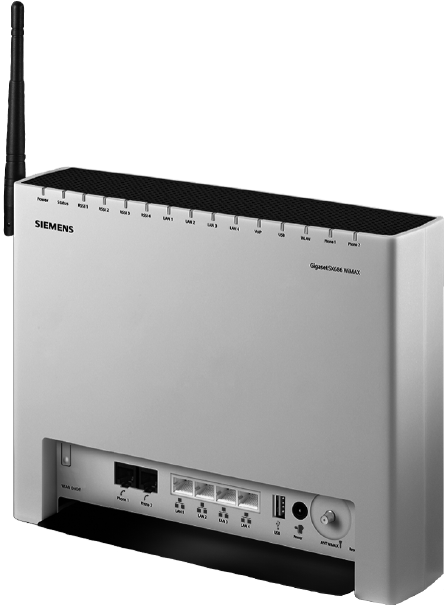
Gigaset SX686 WiMAX / eng / A31008-N919-R101-2x-7619 / cover_front_686.fm / 15.10.2008
Schablone 2007_10_19
s
Gigaset SX686 WiMAX
User Guide
This device works in a frequency band for which a general licence might have to be
obtained. Please contact your service provider or your National Authority for Frequency
Management about licensing before putting this device into service.
3
Contents
Gigaset SX686 WiMAX / en / A31008-N919-R101-2x-7619 / SX68xIVZ.fm / 15.10.2008
Schablone 2005_07_27
Contents
For your safety . . . . . . . . . . . . . . . . . . . . . . . . . . . . . . 7
Safety precautions . . . . . . . . . . . . . . . . . . . . . . . . . . . . . . . . . . . . . . . . . . . . . . . . . . . . . 7
Cleaning and care . . . . . . . . . . . . . . . . . . . . . . . . . . . . . . . . . . . . . . . . . . . . . . . . . . 7
Trademarks . . . . . . . . . . . . . . . . . . . . . . . . . . . . . . . . . . . . . . . . . . . . . . . . . . . . . . . . 7
Information on Specific Absorption Rate (SAR) . . . . . . . . . . . . . . . . . . . . . . . . . . . . . . . 8
Information about the optional outdoor antenna . . . . . . . . . . . . . . . . . . . . . . . . . . . . 8
The Gigaset SX686 WiMAX . . . . . . . . . . . . . . . . . . . 11
Product overview . . . . . . . . . . . . . . . . . . . . . . . . . . . . . . . . . . . . . . . . . . . . . . . . . . . . . 13
The device . . . . . . . . . . . . . . . . . . . . . . . . . . . . . . . . . . . . . . . . . . . . . . . . . . . . . . . 13
Features and applications . . . . . . . . . . . . . . . . . . . . . . . . . . . . . . . . . . . . . . . . . . . 17
Local area networks with Gigaset products . . . . . . . . . . . . . . . . . . . . . . . . . . . . . . . . . 19
Wired local area network (Ethernet) . . . . . . . . . . . . . . . . . . . . . . . . . . . . . . . . . . . 20
Wireless local area network (WLAN) . . . . . . . . . . . . . . . . . . . . . . . . . . . . . . . . . . . 21
Linking a wireless network to an Ethernet . . . . . . . . . . . . . . . . . . . . . . . . . . . . . . 23
Extending the wireless network coverage with a repeater . . . . . . . . . . . . . . . . . . 24
Internet telephony and connecting analogue phones . . . . . . . . . . . . . . . . . . . . . . . . 25
Setting up a wireless network via WPS . . . . . . . . . . . . . . . . . . . . . . . . . . . . . . . . . . . . 26
Installing the Gigaset SX686 WiMAX . . . . . . . . . . . 28
System requirements . . . . . . . . . . . . . . . . . . . . . . . . . . . . . . . . . . . . . . . . . . . . . . . . . . 28
Choosing your location . . . . . . . . . . . . . . . . . . . . . . . . . . . . . . . . . . . . . . . . . . . . . . . . 29
Connecting and activating the Gigaset SX686 WiMAX . . . . . . . . . . . . . . . . . . . . . . . . 32
Installation overview . . . . . . . . . . . . . . . . . . . . . . . . . . . . . . . . . . . . . . . . . . . . . . . 32
Connecting the outdoor antenna . . . . . . . . . . . . . . . . . . . . . . . . . . . . . . . . . . . . . 33
Connecting a PC wired . . . . . . . . . . . . . . . . . . . . . . . . . . . . . . . . . . . . . . . . . . . . . . 34
Connecting a telephone, fax machine or answer machine . . . . . . . . . . . . . . . . . . 35
Connecting to the mains power supply . . . . . . . . . . . . . . . . . . . . . . . . . . . . . . . . . 36
Connecting PCs wirelessly . . . . . . . . . . . . . . . . . . . . . . . . . . . . . . . . . . . . . . . . . . . 37
Checking the operating state . . . . . . . . . . . . . . . . . . . . . . . . . . . . . . . . . . . . . . . . . 39
Network configuration of the PCs . . . . . . . . . . . . . . . . . . . . . . . . . . . . . . . . . . . . . . . . 39
Making the basic settings . . . . . . . . . . . . . . . . . . . . . . . . . . . . . . . . . . . . . . . . . . . . . . 39
Connecting and configuring additional PCs (optional) . . . . . . . . . . . . . . . . . . . . . . . . 40
The user interface . . . . . . . . . . . . . . . . . . . . . . . . . . 41
Starting the user interface . . . . . . . . . . . . . . . . . . . . . . . . . . . . . . . . . . . . . . . . . . . . . . 41
The start screen . . . . . . . . . . . . . . . . . . . . . . . . . . . . . . . . . . . . . . . . . . . . . . . . . . . . . . 42
Selecting a language . . . . . . . . . . . . . . . . . . . . . . . . . . . . . . . . . . . . . . . . . . . . . . . . . . 44
Connecting to the Internet manually . . . . . . . . . . . . . . . . . . . . . . . . . . . . . . . . . . . . . 44
Elements in the user interface . . . . . . . . . . . . . . . . . . . . . . . . . . . . . . . . . . . . . . . . . . . 45
Basic Setup Wizard . . . . . . . . . . . . . . . . . . . . . . . . . . 46
Choosing the antenna . . . . . . . . . . . . . . . . . . . . . . . . . . . . . . . . . . . . . . . . . . . . . . . . . 47
Aligning the antenna . . . . . . . . . . . . . . . . . . . . . . . . . . . . . . . . . . . . . . . . . . . . . . . . . . 48
4
Contents
Gigaset SX686 WiMAX / en / A31008-N919-R101-2x-7619 / SX68xIVZ.fm / 15.10.2008
Schablone 2005_07_27
Searching a WiMAX network . . . . . . . . . . . . . . . . . . . . . . . . . . . . . . . . . . . . . . . . . . . . 49
Antenna fine tuning . . . . . . . . . . . . . . . . . . . . . . . . . . . . . . . . . . . . . . . . . . . . . . . . . . 52
Regional Options . . . . . . . . . . . . . . . . . . . . . . . . . . . . . . . . . . . . . . . . . . . . . . . . . . . . . 53
Configuring Internet connections . . . . . . . . . . . . . . . . . . . . . . . . . . . . . . . . . . . . . . . . 54
Telephony . . . . . . . . . . . . . . . . . . . . . . . . . . . . . . . . . . . . . . . . . . . . . . . . . . . . . . . . . . . 56
WPS Registration . . . . . . . . . . . . . . . . . . . . . . . . . . . . . . . . . . . . . . . . . . . . . . . . . . . . . 57
Summary . . . . . . . . . . . . . . . . . . . . . . . . . . . . . . . . . . . . . . . . . . . . . . . . . . . . . . . . . . . 58
Security Setup Wizard . . . . . . . . . . . . . . . . . . . . . . . 59
Assigning a password . . . . . . . . . . . . . . . . . . . . . . . . . . . . . . . . . . . . . . . . . . . . . . . . . 60
Changing the SSID . . . . . . . . . . . . . . . . . . . . . . . . . . . . . . . . . . . . . . . . . . . . . . . . . . . . 61
Setting up security functions for the wireless network . . . . . . . . . . . . . . . . . . . . . . . . 62
WPA2/WPA with pre-shared key (PSK) . . . . . . . . . . . . . . . . . . . . . . . . . . . . . . . . . . 63
WEP encryption . . . . . . . . . . . . . . . . . . . . . . . . . . . . . . . . . . . . . . . . . . . . . . . . . . . 64
Access control within the wireless network . . . . . . . . . . . . . . . . . . . . . . . . . . . . . . . . 66
Saving settings . . . . . . . . . . . . . . . . . . . . . . . . . . . . . . . . . . . . . . . . . . . . . . . . . . . . . . . 68
Configuring Advanced Settings . . . . . . . . . . . . . . . 69
Internet . . . . . . . . . . . . . . . . . . . . . . . . . . . . . . . . . . . . . . . . . . . . . . . . . . . . . . . . . . . .70
Internet selection . . . . . . . . . . . . . . . . . . . . . . . . . . . . . . . . . . . . . . . . . . . . . . . . . . 71
Internet Connection . . . . . . . . . . . . . . . . . . . . . . . . . . . . . . . . . . . . . . . . . . . . . . . . 72
DNS server . . . . . . . . . . . . . . . . . . . . . . . . . . . . . . . . . . . . . . . . . . . . . . . . . . . . . . . 75
Firewall . . . . . . . . . . . . . . . . . . . . . . . . . . . . . . . . . . . . . . . . . . . . . . . . . . . . . . . . . . . . .76
Attack Detection . . . . . . . . . . . . . . . . . . . . . . . . . . . . . . . . . . . . . . . . . . . . . . . . . . . 77
Setting up access control to the Internet . . . . . . . . . . . . . . . . . . . . . . . . . . . . . . . . 78
Setting up the NAT function . . . . . . . . . . . . . . . . . . . . . . . . . . . . . . . . . . . . . . . . . . . . 80
Port Triggering . . . . . . . . . . . . . . . . . . . . . . . . . . . . . . . . . . . . . . . . . . . . . . . . . . . . 82
Port Forwarding . . . . . . . . . . . . . . . . . . . . . . . . . . . . . . . . . . . . . . . . . . . . . . . . . . . 83
Opening the firewall for a selected PC (Exposed Host) . . . . . . . . . . . . . . . . . . . . . 84
Dynamic DNS . . . . . . . . . . . . . . . . . . . . . . . . . . . . . . . . . . . . . . . . . . . . . . . . . . . . . 85
Routing . . . . . . . . . . . . . . . . . . . . . . . . . . . . . . . . . . . . . . . . . . . . . . . . . . . . . . . . . . 87
LAN configuration . . . . . . . . . . . . . . . . . . . . . . . . . . . . . . . . . . . . . . . . . . . . . . . . . . . . 88
Assigning static IP addresses to individual PCs . . . . . . . . . . . . . . . . . . . . . . . . . . . 90
Configuring wireless connections . . . . . . . . . . . . . . . . . . . . . . . . . . . . . . . . . . . . . . . . 91
Starting WPS registration and configuring WPS . . . . . . . . . . . . . . . . . . . . . . . . . . 93
Setting encryption . . . . . . . . . . . . . . . . . . . . . . . . . . . . . . . . . . . . . . . . . . . . . . . . . 94
WPA2-PSK and WPA2-PSK / WPA-PSK . . . . . . . . . . . . . . . . . . . . . . . . . . . . . . . . . . . 95
WEP encryption . . . . . . . . . . . . . . . . . . . . . . . . . . . . . . . . . . . . . . . . . . . . . . . . . . . 98
Permitted clients . . . . . . . . . . . . . . . . . . . . . . . . . . . . . . . . . . . . . . . . . . . . . . . . . 101
Repeater function (WDS) . . . . . . . . . . . . . . . . . . . . . . . . . . . . . . . . . . . . . . . . . . . 103
Setting up Internet telephony (VoIP) . . . . . . . . . . . . . . . . . . . . . . . . . . . . . . . . . . . . . 105
VoIP settings . . . . . . . . . . . . . . . . . . . . . . . . . . . . . . . . . . . . . . . . . . . . . . . . . . . . . 106
Extensions . . . . . . . . . . . . . . . . . . . . . . . . . . . . . . . . . . . . . . . . . . . . . . . . . . . . . . 109
Dialing Plans . . . . . . . . . . . . . . . . . . . . . . . . . . . . . . . . . . . . . . . . . . . . . . . . . . . . . 113
Quick dial . . . . . . . . . . . . . . . . . . . . . . . . . . . . . . . . . . . . . . . . . . . . . . . . . . . . . . . 115
5
Contents
Gigaset SX686 WiMAX / en / A31008-N919-R101-2x-7619 / SX68xIVZ.fm / 15.10.2008
Schablone 2005_07_27
USB . . . . . . . . . . . . . . . . . . . . . . . . . . . . . . . . . . . . . . . . . . . . . . . . . . . . . . . . . . . . . . .116
File Server . . . . . . . . . . . . . . . . . . . . . . . . . . . . . . . . . . . . . . . . . . . . . . . . . . . . . . 117
Web Server . . . . . . . . . . . . . . . . . . . . . . . . . . . . . . . . . . . . . . . . . . . . . . . . . . . . . . 120
Print Server . . . . . . . . . . . . . . . . . . . . . . . . . . . . . . . . . . . . . . . . . . . . . . . . . . . . . . 123
Call guide . . . . . . . . . . . . . . . . . . . . . . . . . . . . . . . . 124
Making calls . . . . . . . . . . . . . . . . . . . . . . . . . . . . . . . . . . . . . . . . . . . . . . . . . . . . . . . . 124
Advanced options . . . . . . . . . . . . . . . . . . . . . . . . . . . . . . . . . . . . . . . . . . . . . . . . . . . 125
Toggling telephone calls . . . . . . . . . . . . . . . . . . . . . . . . . . . . . . . . . . . . . . . . . . . 125
Conference call between three participants . . . . . . . . . . . . . . . . . . . . . . . . . . . . 126
Call answering and forwarding . . . . . . . . . . . . . . . . . . . . . . . . . . . . . . . . . . . . . . 126
Call waiting and call reject if busy . . . . . . . . . . . . . . . . . . . . . . . . . . . . . . . . . . . . 127
Special functions . . . . . . . . . . . . . . . . . . . . . . . . . . . . . . . . . . . . . . . . . . . . . . . . . . . . 128
Confirmation tones . . . . . . . . . . . . . . . . . . . . . . . . . . . . . . . . . . . . . . . . . . . . . . . . . . 129
Administration . . . . . . . . . . . . . . . . . . . . . . . . . . . . 130
Regional Options . . . . . . . . . . . . . . . . . . . . . . . . . . . . . . . . . . . . . . . . . . . . . . . . . . . . 130
Internet Time . . . . . . . . . . . . . . . . . . . . . . . . . . . . . . . . . . . . . . . . . . . . . . . . . . . . 131
System Password . . . . . . . . . . . . . . . . . . . . . . . . . . . . . . . . . . . . . . . . . . . . . . . . . . . . 131
System management . . . . . . . . . . . . . . . . . . . . . . . . . . . . . . . . . . . . . . . . . . . . . . . . . 132
Backing up and restoring a configuration . . . . . . . . . . . . . . . . . . . . . . . . . . . . . . . . . 133
Backing up configuration data . . . . . . . . . . . . . . . . . . . . . . . . . . . . . . . . . . . . . . . 133
Restoring the saved data . . . . . . . . . . . . . . . . . . . . . . . . . . . . . . . . . . . . . . . . . . . 134
Restoring factory settings . . . . . . . . . . . . . . . . . . . . . . . . . . . . . . . . . . . . . . . . . . 134
Reboot . . . . . . . . . . . . . . . . . . . . . . . . . . . . . . . . . . . . . . . . . . . . . . . . . . . . . . . . . . . . 134
System Log . . . . . . . . . . . . . . . . . . . . . . . . . . . . . . . . . . . . . . . . . . . . . . . . . . . . . . . . . 135
Status information . . . . . . . . . . . . . . . . . . . . . . . . . 136
Overview . . . . . . . . . . . . . . . . . . . . . . . . . . . . . . . . . . . . . . . . . . . . . . . . . . . . . . . . . . 136
Security . . . . . . . . . . . . . . . . . . . . . . . . . . . . . . . . . . . . . . . . . . . . . . . . . . . . . . . . . . . 137
Radio Status . . . . . . . . . . . . . . . . . . . . . . . . . . . . . . . . . . . . . . . . . . . . . . . . . . . . . . . . 138
Internet . . . . . . . . . . . . . . . . . . . . . . . . . . . . . . . . . . . . . . . . . . . . . . . . . . . . . . . . . . . 139
Local Network . . . . . . . . . . . . . . . . . . . . . . . . . . . . . . . . . . . . . . . . . . . . . . . . . . . . . . 140
Wireless Network . . . . . . . . . . . . . . . . . . . . . . . . . . . . . . . . . . . . . . . . . . . . . . . . . . . . 141
Telephony . . . . . . . . . . . . . . . . . . . . . . . . . . . . . . . . . . . . . . . . . . . . . . . . . . . . . . . . . . 142
Device . . . . . . . . . . . . . . . . . . . . . . . . . . . . . . . . . . . . . . . . . . . . . . . . . . . . . . . . . . . . . 142
Alarms . . . . . . . . . . . . . . . . . . . . . . . . . . . . . . . . . . . . . . . . . . . . . . . . . . . . . . . . . . . . 143
Functional Alarms . . . . . . . . . . . . . . . . . . . . . . . . . . . . . . . . . . . . . . . . . . . . . . . . 144
Physical Alarms . . . . . . . . . . . . . . . . . . . . . . . . . . . . . . . . . . . . . . . . . . . . . . . . . . 146
Using the USB port . . . . . . . . . . . . . . . . . . . . . . . . . 147
Installing the printer port for network printers . . . . . . . . . . . . . . . . . . . . . . . . . . . . . 147
Introduction . . . . . . . . . . . . . . . . . . . . . . . . . . . . . . . . . . . . . . . . . . . . . . . . . . . . . 147
Installing a standard TCP/IP printer port under Windows Vista . . . . . . . . . . . . . . 148
Installing a standard TCP/IP printer port under Windows XP/2000 . . . . . . . . . . . 154
Installing a printer on the TCP/IP port retrospectively . . . . . . . . . . . . . . . . . . . . . 160
Instructions for setting up a printer on the PC . . . . . . . . . . . . . . . . . . . . . . . . . . 161
6
Contents
Gigaset SX686 WiMAX / en / A31008-N919-R101-2x-7619 / SX68xIVZ.fm / 15.10.2008
Schablone 2005_07_27
Using the data on a USB mass storage device . . . . . . . . . . . . . . . . . . . . . . . . . . . . . . 162
Checking network services . . . . . . . . . . . . . . . . . . . . . . . . . . . . . . . . . . . . . . . . . 162
Share Inter Process Communication for the network . . . . . . . . . . . . . . . . . . . . . 164
Starting the computer browser . . . . . . . . . . . . . . . . . . . . . . . . . . . . . . . . . . . . . . 164
Enabling file and printer sharing in the Windows firewall . . . . . . . . . . . . . . . . . 165
Appendix . . . . . . . . . . . . . . . . . . . . . . . . . . . . . . . . . 167
Troubleshooting . . . . . . . . . . . . . . . . . . . . . . . . . . . . . . . . . . . . . . . . . . . . . . . . . . . . . 167
Deactivating HTTP proxy and configuring a pop-up blocker . . . . . . . . . . . . . . . . . . . 173
Deactivating the HTTP proxy . . . . . . . . . . . . . . . . . . . . . . . . . . . . . . . . . . . . . . . . 173
Configuring the pop-up blocker . . . . . . . . . . . . . . . . . . . . . . . . . . . . . . . . . . . . . 173
Specifications . . . . . . . . . . . . . . . . . . . . . . . . . . . . . . . . . . . . . . . . . . . . . . . . . . . . . . . 174
Guarantee Certificate United Kingdom . . . . . . . . . . . . . . . . . . . . . . . . . . . . . . . . . . . 177
Guarantee certificate Ireland . . . . . . . . . . . . . . . . . . . . . . . . . . . . . . . . . . . . . . . . . . . 177
Open Source Software used in the product . . . . . . . . . . . . . . . . . . . . . . . . . . . . . . . 179
Glossary . . . . . . . . . . . . . . . . . . . . . . . . . . . . . . . . . 180
Index . . . . . . . . . . . . . . . . . . . . . . . . . . . . . . . . . . . . 195

7
For your safety
Gigaset SX686 WiMAX / eng / A31008-N919-R101-2x-7619 / Safety.fm / 15.10.2008
Schablone 2004_08_26
For your safety
ìPlease read the safety instructions carefully before putting into service.
Safety precautions
General safety instructions
uIf you give the Gigaset SX686 WiMAX to someone else, make sure you also give
them its documentation.
uThe Gigaset SX686 WiMAX must only be used as described in these installation
instructions.
Safety instructions for connection
uOnly use the mains adapter supplied, as indicated on the underside of the Gigaset
SX686 WiMAX.
Safety precautions for the Gigaset SX686 WiMAX
uThe operation of medical appliances may be affected. Be aware of the technical con-
ditions in your particular environment, e.g. doctor's surgery.
uThe Gigaset SX686 WiMAX and the antenna can interfere with the functioning of
medical devices such as pacemakers. Keep at least 20 cm between the devices and
the pacemaker. For more information, consult your doctor.
uThe device may cause an unpleasant humming noise in hearing aids.
uDo not use the devices in environments with a potential explosion hazard, e.g. car
paint shops, or in a humid environment (bathroom etc.).
uThe Ethernet function (LAN socket, LAN) and the FXS function (analogue phone
port, Phone) are designed exclusively for connection inside a building.
Cleaning and care
Wipe the Gigaset SX686 WiMAX with a damp cloth (do not use solvent) or an antistatic
cloth.
Never use a dry cloth. This can cause static.
Trademarks
Gigaset Communications GmbH is a trademark licensee of Siemens AG.
Microsoft, Windows Vista, Windows XP, Windows 2000 and Internet Explorer are
registered trademarks of Microsoft Corporation.
Mozilla Firefox is a registered trademark of the Mozilla Organisation.

8
For your safety
Gigaset SX686 WiMAX / eng / A31008-N919-R101-2x-7619 / Safety.fm / 15.10.2008
Schablone 2004_08_26
Information on Specific Absorption Rate (SAR)
This device meets the limits for protecting the health of the public from the effecs of
exposure to electromagnetic fields when it is operated in connection with the desig-
nated antenna(s) like described in the user manual.
Your device is a radio transmitter and receiver. It is designed and manufactured not to
exceed the limits for exposure to emission from electromagnetic fields recommended
by international guidelines from the International Commission on Non-Ionizing Radia-
tion Protection (ICNIRP). These limits are part of comprehensive guidelines for the pro-
tection of the public and establish permitted levels of exposure to electromagnetic radi-
ation for the population. The guidelines were confirmed by independent scientific
organisations through periodic and thorough evaluation of scientific studies. The limits
include a substantial safety margin designed to assure the safety of all persons, regard-
less of age and health.
The exposure limit employs a unit of measurement known as the Specific Absorption
Rate, or SAR. The SAR limit stated in the international guidelines is 2.0 W/kg. Tests for
SAR are conducted in all frequency bands with the device transmitting at its highest
power level with minimum possible distance to the body. The actual SAR level of the
device during operation with the designated antenna(s) is below the maximum value
and is additionally decreased by a distance to the device. This is because the device is
designed to operate at multiple power levels so as to use only the power required to
enable seamless network connection.
Information about the optional outdoor antenna
Wall duct:
To connect the Gigaset SX686 WiMAX to the outdoor antenna, the antenna cable must
be fed through the wall to the outside of the building. It must be possible to make a suit-
able wall or window duct at or near the location of the Gigaset SX686 WiMAX.
W
Only one of the antennas listed on Seite 28 must be used.
The outdoor antenna must be installed and put into service by a qualified
electrician.
ìOnly commence the outdoor work once you have taken all the neces-
sary steps to make the location safe.
Be sure to observe the safety instructions.
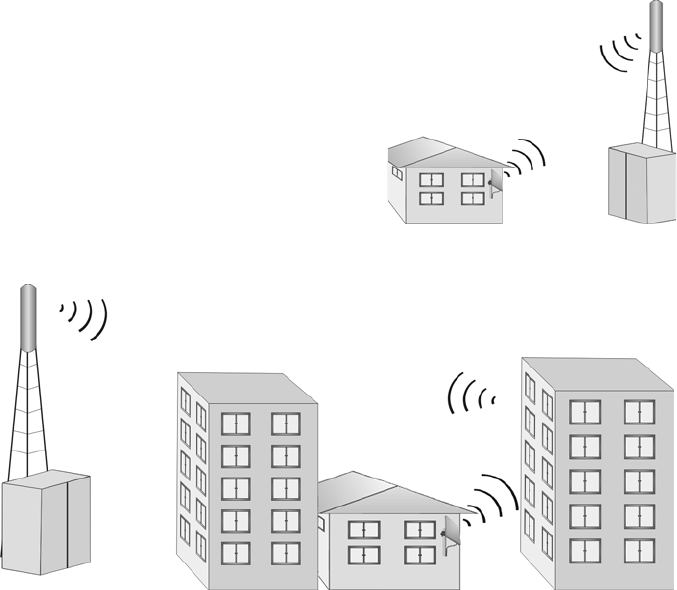
9
For your safety
Gigaset SX686 WiMAX / eng / A31008-N919-R101-2x-7619 / Safety.fm / 15.10.2008
Schablone 2004_08_26
Setting up the antenna mast:
There should not be any obstructions (walls, trees etc.) in front of the antenna.
The antenna mast must be structurally secure. Check how secure the various attach-
ments are.
The antenna mast must be within reach of the cable. Ideally, the antenna cable should
be protected outside (from frost, sun, unauthorised and mechanical influences etc.).
In particular, make sure the antenna mast has sufficient load capacity. If you are mount-
ing the mast on the roof, make sure the roof is fully sealed again afterwards.
The best results will be obtained if the out-
door antenna is in sight of the WiMAX base
station (cf. Fig. 1).
If a line of sight is not possible, you can
reflect the radio waves off neighbouring
buildings. To do this, direct the antenna at
the building it is to reflect off and not at the
base station (cf. Fig. 2).
Fig. 1
Fig. 2

10
For your safety
Gigaset SX686 WiMAX / eng / A31008-N919-R101-2x-7619 / Safety.fm / 15.10.2008
Schablone 2004_08_26
Lightning protection
The antenna mast should be positioned near a lightning conductor. A suitable lightning
conductor must be installed where necessary.
The outdoor antenna is not designed to be struck directly by lightning and must be pro-
tected accordingly. The antenna must therefore be mounted in areas that are protected
against lightning (Lightning Protection Zone 0B). The corresponding separation dis-
tance (IEC 62305) must be complied with.
Earthing and lightning protection work may only be carried out by electricians specifi-
cally qualified for such work.
The appropriate earthing clamps must be used to create an equipotential bonding
between a cable shield and an equipotential bonding bar that complies with regula-
tions.
Please observe the standard DIN VDE 0855-300 and find out more on the Internet at
http://www.dehn.de/www_DE/PAGES_D/service/down/blitzplaner.html (German)
Or
http://www.dehn-usa.com/dehn-Application-Guides-pubcid1.html (English)
Antenna cable and antenna connection:
It must be possible to connect the outdoor antenna to the Gigaset SX686 WiMAX by
means of an antenna cable.
Please note that the antenna connection must be protected from the impact of rain and
other weather effects.
Use cable clamps to attach the cable to the mast. Please note that the cable must be
long enough to turn the antenna at a later stage.
Antenna alignment:
When aligning the antenna, we recommend asking a second person to run the basic
setup wizard on the PC and to check the reception quality on the screen; see Chapter
„Basic Setup Wizard” auf Seite 46.
After installation:
Tighten all screw connections to the torques listed in the installation instructions.
Secure the antenna cable with cable clamps and cable ties. The cable must be protected
from exposure to pressure and tension.
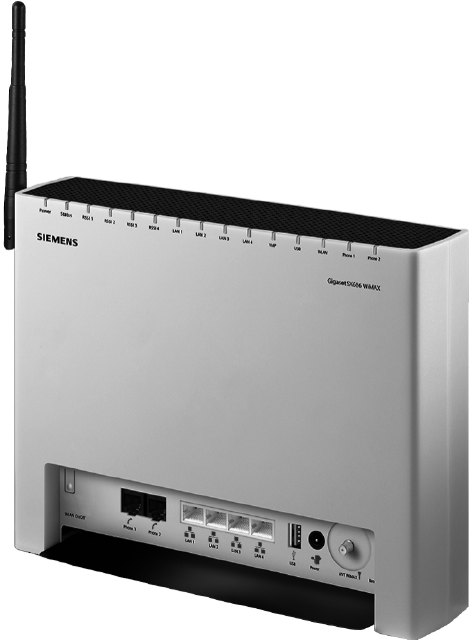
11
The Gigaset SX686 WiMAX
Gigaset SX686 WiMAX / en / A31008-N919-R101-2x-7619 / introduction.fm / 15.10.2008
Schablone 2005_07_27
The Gigaset SX686 WiMAX
The Gigaset SX686 WiMAX gateway is a powerful but simple communications device for
connecting your PC or local area network (LAN) to the Internet via WiMAX.
WiMAX stands for "Worldwide Interoperability for Microwave Access", a modern wire-
less network technology that enables fast Internet connection even in remote areas.
With WiMAX technology you are no longer dependent on a DSL infrastructure in your
home or place of work. Instead, you connect your PC or network wirelessly to radio
stations operated in your region by your provider. As a result, WiMAX gives you fast,
economical broadband Internet access, even in places that are not connected to the DSL
cable network.
The WiMAX standard IEEE 802.16 generally defines WiMAX technology. Your Gigaset
SX686 WiMAX already meets the latest IEEE 802.16e-2005 standard, a mobile WiMAX
standard that offers many extra possibilities.

12
The Gigaset SX686 WiMAX
Gigaset SX686 WiMAX / en / A31008-N919-R101-2x-7619 / introduction.fm / 15.10.2008
Schablone 2005_07_27
The Gigaset SX686 WiMAX allows several users to access the Internet simultaneously. A
single user account can be shared if your Internet service provider permits this. If you
want to surf the Internet and make calls using the Internet at the lowest possible cost,
the Gigaset SX686 WiMAX is a convenient and simple solution.
You can build a local network (LAN) by connecting up to four PCs to your Gigaset SX686
WiMAX via cable. Additionally you can connect PCs wirelessly and create a wireless local
area network (WLAN). For network security, wireless transmission can be encrypted
using the WPA/WPA2 standard or 64/128-bit WEP.
There are two variants for operating the Gigaset SX686 WiMAX in a wireless network:
– With integrated WLAN antenna, if you operate WiMAX within the 3.5 GHz fre-
quency band.
– With a connector for an external WLAN antenna, if you operate WiMAX within the
2.6 GHz frequency band. In this case the frequencies of the WiMAX and the WLAN
adjoin. You can therefore use the supplied external WLAN antenna which should
be positioned as far as possible from your device.
The Gigaset SX686 WiMAX also offers the functions of a PABX for Internet telephony
(VoIP) and fixed network telephony. You can connect up to two traditional analogue ter-
minals and then use these analogue phones both to make calls via the Internet or also
via an existing analogue telephone line. In addition, you can operate SIP clients (wire-
less SIP telephones and PCs with appropriate software) as PABX extensions and there-
fore also make calls via the Internet or fixed network.
The Gigaset SX686 WiMAX provides the new WPS function for wireless connection of
PCs or notebooks. You can activate this function via the user interface. If the other cli-
ents in your wireless network such as the Gigaset PC Card 300 also support WPS, you
can connect with a simple click.
The Gigaset SX686 WiMAX has an extensive range of functions but remains simple to
use. It can be configured and operational within a few minutes.
Do your part for the environment (ECO)
Thanks to a switch-mode power supply unit, all of our broadband prod-
ucts offer significantly reduced power consumption - for more energy-
efficient use. Each device also lets you variably reduce WLAN transmis-
sion power based on the size of your home or office network via the
user interface, which helps make a cleaner environment for everyone. You can even
turn the WLAN off completely when you're not using it. Some of our broadband prod-
ucts also offer you the convenience of switching the WLAN on or off with a handy but-
ton directly on the device itself - or have a timer do it for you. It's our goal to ensure a
sustainable economic process by using an environmentally friendly production and
management system - which makes it easy for us to meet the strict ISO 14001 standards
for international environmental management.
Note:
This user guide is based on software release 7.0.
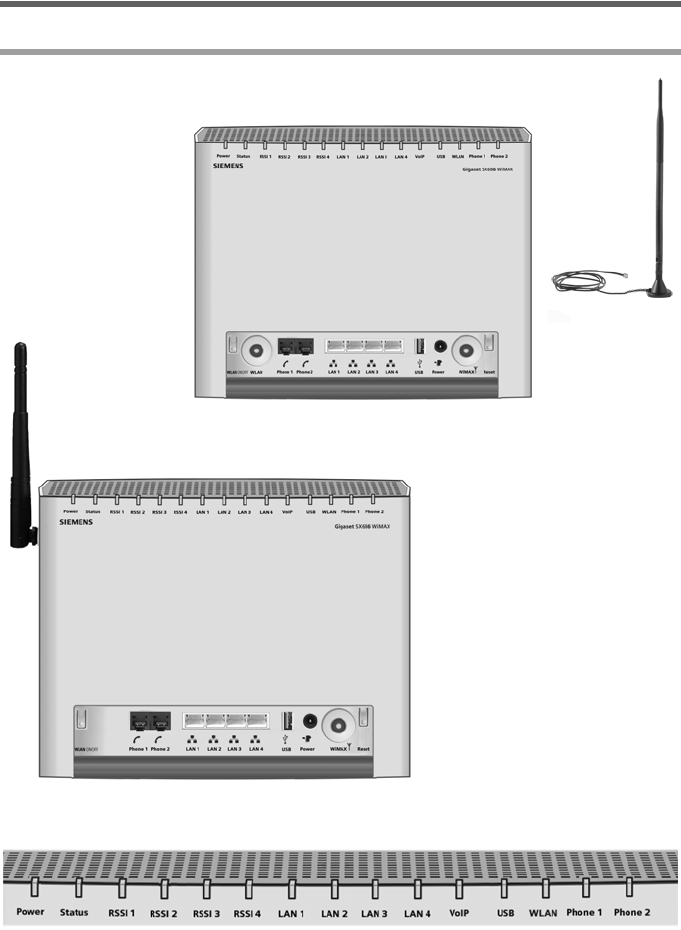
13
The Gigaset SX686 WiMAX
Gigaset SX686 WiMAX / en / A31008-N919-R101-2x-7619 / introduction.fm / 15.10.2008
Schablone 2005_07_27
Product overview
The device
LEDs
Gigaset SX686
WiMAX with an
external WLAN
antenna
connector
Gigaset SX686 WiMAX with
an internal WLAN antenna

14
The Gigaset SX686 WiMAX
Gigaset SX686 WiMAX / en / A31008-N919-R101-2x-7619 / introduction.fm / 15.10.2008
Schablone 2005_07_27
The LEDs (from left to right) have the following functions:
LED State Status
Power
On (green) The Gigaset SX686 WiMAX is connected to the mains.
Off The Gigaset SX686 WiMAX is disconnected from the mains
or the power supply has failed.
Status
On (green)
The Gigaset SX686 WiMAX is registered with a WiMAX net-
work and ready for use. A connection to the Internet has
been established.
Off
The Gigaset SX686 WiMAX is not registered with a WiMAX
network; it is not possible to establish an Internet connec-
tion.
Flashes
(green)
The Gigaset SX686 WiMAX is establishing a connection with
a WiMAX network.
Lights up red Alarm: The Gigaset SX686 WiMAX is not ready. Possible
cause: device is overheating or faulty (see page 143).
RSSI1 –
RSSI 4
0 to 4 LEDs
light up
green
The LEDs on the Gigaset SX686 WiMAX help you to position
the antenna more easily. The LEDs indicate the signal
strength; the more LEDs that light up, the better the signal
reception.
All 4 LEDs
flash green
The Gigaset SX686 WiMAX is being reset to the factory set-
tings; see "Restoring factory settings" on page 134.
Line
On One of the connected phones' receivers has been lifted for a
call (fixed network telephony).
Off There is currently no fixed network connection.
LAN1 –
LAN4
On A device is connected to the relevant LAN port.
Flashing The relevant LAN port is sending or receiving data (traffic).
Off There is no device connected.
WLAN
On The radio interface is activated, no data transmission at
present.
Flashing The Gigaset SX686 WiMAX is sending or receiving data on
the radio interface.
Off The radio interface is deactivated.
WLAN
During WPS registration
On (300 sec) WPS registration was successful.
Flashing
slowly WPS registration is in progress.
Flashing
quickly WPS registration was not successful.
Flashing
quickly with
interruption
More than one client tried to register.

15
The Gigaset SX686 WiMAX
Gigaset SX686 WiMAX / en / A31008-N919-R101-2x-7619 / introduction.fm / 15.10.2008
Schablone 2005_07_27
VoIP
On At least one VoIP account is set up, registered with the pro-
vider and assigned to one of the phone ports.
Flashing A call is currently being made via the Internet.
Off There is currently no connection for Internet telephony or no
VoIP port has been configured.
USB
On A device is connected to the Gigaset SX686 WiMAX via the
USB port.
Flashing The device connected to the USB port is active.
Off There is no device connected.
Phone 1/
Phone 2
On The receiver of the phone connected to the port has been
lifted.
Flashing The phone is ringing and a call is being received or a call is
being conducted.
Off The port is successfully configured. The attached phone is in
on hook condition.
LED State Status

16
The Gigaset SX686 WiMAX
Gigaset SX686 WiMAX / en / A31008-N919-R101-2x-7619 / introduction.fm / 15.10.2008
Schablone 2005_07_27
Ports and operating elements
The Gigaset SX686 WiMAX has the following ports and operating elements.
Element Description
WLAN On/
Off
WLAN on/off switch for activating and deactivating the wireless LAN.
All the WLAN settings remain when switched off and become active
if WLAN is switched on again.
WLAN Port for an external WLAN desktop antenna (depending on the device
variant).
Phone1/2 Sockets for connecting two phones, fax or answering machine
LAN1 – LAN4
(yellow)
Four 10/100 Mbps switch ports with automatic recognition (RJ-45).
You can connect up to four devices with Ethernet ports (such as PCs,
a Hub or Switch).
USB (blue) USB port for printer or USB memory.
Power Socket for the mains adapter supplied
Warning: Using the wrong power supply unit may damage the
Gigaset SX686 WiMAX.
Line
(green)
Socket for connecting the phone line to the telephone port on the
splitter
WiMAX Port for an external WiMAX antenna (optional)
Reset Reboot function: Press and hold the button for more than 1 second
but less than 5 seconds to reboot the device. This does not affect the
configuration settings.
Reset function: Press and hold the button for at least 5 seconds to
return all settings to factory settings.
Warning: This will clear all the configuration settings you have made
since the initial startup.
Updated firmware will not be affected.
G
igaset SX686 WiMAX with an external WLAN antenna connector
Gigaset SX686 WiMAX with its own WLAN antenna

17
The Gigaset SX686 WiMAX
Gigaset SX686 WiMAX / en / A31008-N919-R101-2x-7619 / introduction.fm / 15.10.2008
Schablone 2005_07_27
Features and applications
The Gigaset SX686 WiMAX's wide range of features makes it ideal for a large number of
applications.
Depending on your device, some of the features may differ from the description in this
instruction manual.
uInternet access
The Gigaset SX686 WiMAX supports shared Internet access for up to 252 users via
the integrated WiMAX modem. This means several users in your network can surf
the Internet at the same time, all using the same Internet account. With your Gigaset
SX686 WiMAX, you can make use of everything the Internet has to offer:
–Downloads
Even large files download quickly to your PC.
Complex Website designs are no longer characterised by the time they take to
download – you can enjoy flash animation and high-resolution graphics immedi-
ately after clicking on a link.
–Audio
Play back audio files straight from the Internet.
Listen to the radio via the Internet in superb digital quality.
–Video
View short or longer films you find on the Internet without tedious waiting times.
Watch television via the Internet (IPTV).
Use "Video on Demand" and order films that are transmitted to you via the
Internet.
–Real time
Take part in video conferences and feel as if you are sitting in the same room as
the people you are talking to.
Speak to and see your chat partners.
–VoIP
Benefit from the economical telephone rates for Internet telephony (Voice over
IP, VoIP). Your PC does not even need to be switched on.
uSetting up a local area network
The Gigaset SX686 WiMAX offers the following possibilities:
– Four devices connected via Ethernet ports with a transmission speed of 10 or
100 Mbps (with automatic recognition).
– Up to 252 mobile terminals connected via a radio interface with a transmission
speed of up to 54 Mbps. The Gigaset SX686 WiMAX complies with IEEE 802.11g
standard and can work with all products that satisfy Standard IEEE 802.11b or
802.11g.
18
The Gigaset SX686 WiMAX
Gigaset SX686 WiMAX / en / A31008-N919-R101-2x-7619 / introduction.fm / 15.10.2008
Schablone 2005_07_27
– Using the Gigaset SX686 WiMAX makes it easy to set up a network at home or in
small offices. For example, users can exchange data or share resources in the net-
work, such as a file server or printer. You can connect a USB hard disk or a printer
to the USB interface of the Gigaset SX686 WiMAX and make them available to all
users in your network.
The Gigaset SX686 WiMAX supports DHCP for dynamic IP configuration of the local
area network, and DNS for domain name mapping.
uConnecting phones and Internet telephony
The Gigaset SX686 WiMAX permits
– Internet telephony via the WiMAX port.
– Fixed network telephony via the analogue port.
– Connection of two analogue phones for Internet telephony and for fixed network
calls as well as connection of wireless SIP phones and PCs with SIP clients for
Internet telephony.
– Connection of an answering machine or fax.
Data transfer for VoIP is handled by the SIP protocol with high connection and voice
quality. If the Internet connection has been interrupted or you do not want to make
a call via VoIP, you can simply make a call via the fixed network (if a fixed network
phone is connected).
uSecurity functions
The Gigaset SX686 WiMAX offers comprehensive security measures:
–Firewall protection against unauthorised access from the Internet
All PCs in the local area network use the Public IP address of the Gigaset SX686
WiMAX for their Internet connections, which makes them 'invisible' on the Inter-
net. The Gigaset SX686 WiMAX only allows access from the Internet if this has
been requested from within the local area network.
With the firewall, the Gigaset SX686 WiMAX also offers comprehensive protec-
tion against hacker attacks.
– Service filtering
The Gigaset SX686 WiMAX can filter Internet access. Here you determine which
PCs may access which Internet services.
– Access control and encryption for the local wireless network
You can use various encryption methods and authentication methods (WEP, WPA/
WPA2-PSK,WPA/WPA2, MAC access control) to prevent unauthorised access to
your wireless LAN or to make data illegible to unauthorised parties.
uOffering your own services on the Internet
– If you want to offer your own services on the Internet, you can set up the Gigaset
SX686 WiMAX as a virtual server without permitting further access to the local
area network.
–DMZ (Exposed Host)
This allows you to release a PC in your local area network for unlimited access
from the Internet. Note that in this case your local area network will no longer be
adequately protected against Internet attacks.
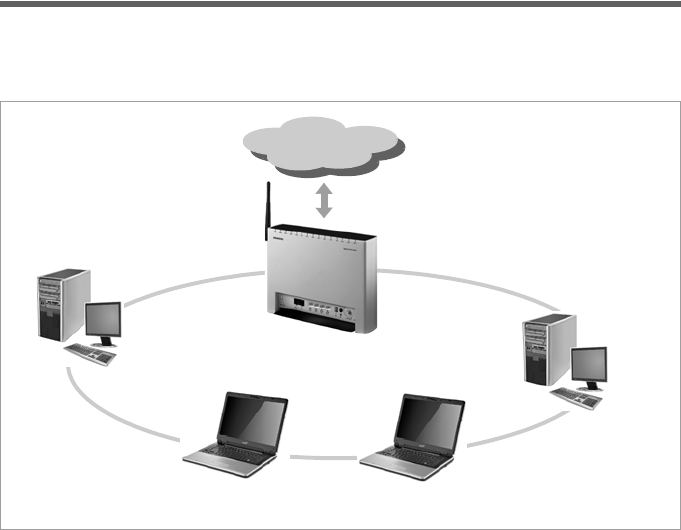
19
The Gigaset SX686 WiMAX
Gigaset SX686 WiMAX / en / A31008-N919-R101-2x-7619 / introduction.fm / 15.10.2008
Schablone 2005_07_27
uProviding an HTTP or FTP server via USB interface
– You can easily establish an FTP or an HTTP server for Internet access with the
Gigaset SX686 WiMAX.
– You can connect a USB hub to the USB port on your Gigaset SX686 WiMAX and
thereby at the same time provide a printer and a storage medium for all clients in
your local area network.
Local area networks with Gigaset products
You can use the Gigaset SX686 WiMAX to set up a local area network, for example a
home network. All PCs in this network can communicate with each other and have
access to the Internet.
There are various ways in which you can set up the network using a Gigaset SX686
WiMAX.
uSet up a wired local area network (Ethernet) and allow the connected PCs access to
the Internet (page 20).
uSet up a wireless local area network (WLAN) and allow the connected PCs access to
the Internet (page 21).
uSet up a local area network comprising wireless and wired network components
(page 23).
Local Network
Windows ME
Windows XP Windows Vista
Windows 2000
Internet
Gigaset SX686 WiMAX
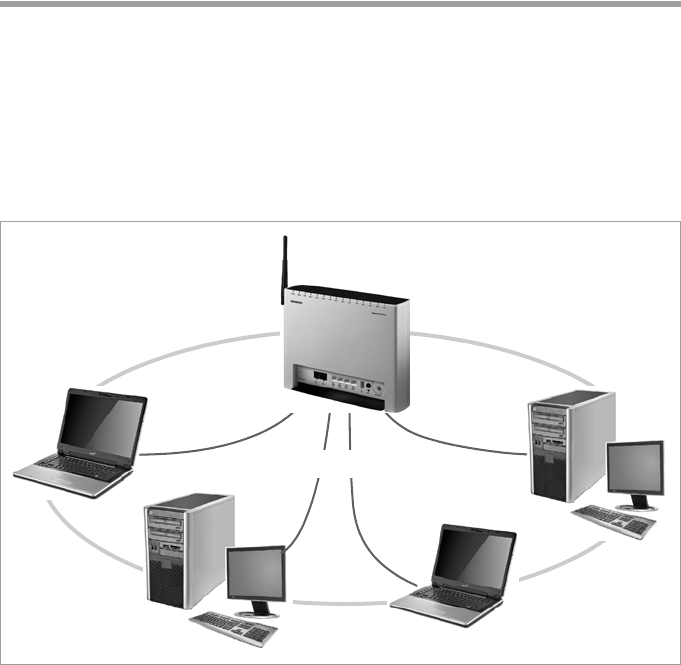
20
The Gigaset SX686 WiMAX
Gigaset SX686 WiMAX / en / A31008-N919-R101-2x-7619 / introduction.fm / 15.10.2008
Schablone 2005_07_27
Wired local area network (Ethernet)
In a wired local area network, PCs communicate with one another via an Ethernet cable.
When the Gigaset SX686 WiMAX is used, it establishes the connection between the PCs.
For this it has four Ethernet LAN ports for connecting four PCs. The PCs have to be
equipped with a network port (Ethernet). New PCs frequently already have this port. For
older PCs you need to install an Ethernet network card. The PC and the Ethernet LAN
port on the Gigaset SX686 WiMAX are connected using an Ethernet cable (CAT5). There
is one supplied. You can obtain additional Ethernet cables from your retailer.
The Gigaset SX686 WiMAX allows all PCs to access the Internet simultaneously.
Ethernet

21
The Gigaset SX686 WiMAX
Gigaset SX686 WiMAX / en / A31008-N919-R101-2x-7619 / introduction.fm / 15.10.2008
Schablone 2005_07_27
Wireless local area network (WLAN)
In a wireless local area network (WLAN), PCs are linked without wires or cables. The PCs
have to be equipped with a wireless local area network adapter (WLAN adapter), for
example a Gigaset USB Adapter 108.
We generally differentiate between two types of wireless network:
uInfrastructure mode
uAd-hoc mode
Infrastructure mode
Infrastructure mode connects wireless and wired networks with one another. In addi-
tion to the mobile stations, infrastructure mode needs an access point such as the
Gigaset SX686 WiMAX. In infrastructure mode, the stations in the network always com-
municate via this access point. The access point sets up the wireless network on a per-
manent basis. Each station that wants to be part of the wireless network must first reg-
ister with the access point before it can exchange data.
The access point establishes the connection between the mobile stations of a wireless
network and a wired LAN (Ethernet) or the Internet. In this case this is described as the
device's router functionality. The router sends data packets that are not addressed to sta-
tions within the network "outside" and forwards data packets originating from "outside"
to the appropriate station within the network.
You can use the Gigaset SX686 WiMAX to connect
uwirelessly networked PCs to the Internet and
uwirelessly networked PCs to an Ethernet network.
Infrastructure mode is the default configuration for the Gigaset SX686 WiMAX.
Ad-hoc mode
An ad-hoc network is a wireless network that has been configured without an access
point or a router. The mobile network components that communicate with each other
directly and wirelessly form the network on an "ad-hoc" basis, i.e. as and when required.
All the stations in the network have the same rights. Ad-hoc networks are used wher-
ever communications networks have to be set up quickly and there is no existing net-
work infrastructure, and where the participants are on the move.
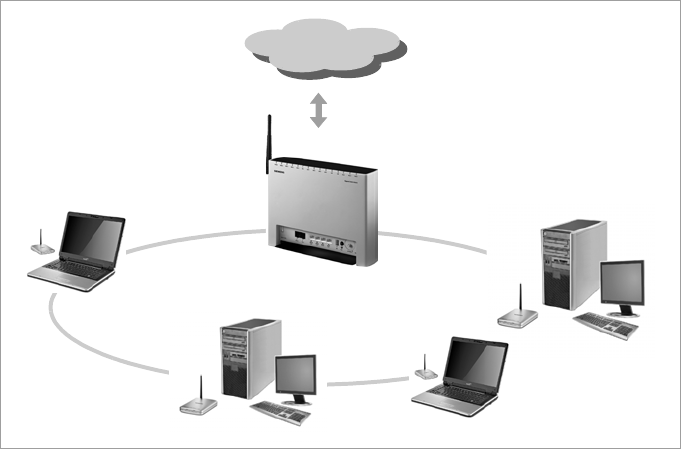
22
The Gigaset SX686 WiMAX
Gigaset SX686 WiMAX / en / A31008-N919-R101-2x-7619 / introduction.fm / 15.10.2008
Schablone 2005_07_27
Linking wireless networks with the Internet
The Gigaset SX686 WiMAX has an WiMAX interface that permits all stations within its
local area network to access the Internet simultaneously. To be able to use this function-
ality, you need a WiMAX connection obtainable from an Internet service provider. Find
out whether your service provider supports parallel access by several PCs.
(((
(((
(((
WLAN
(((
Internet
((( )))
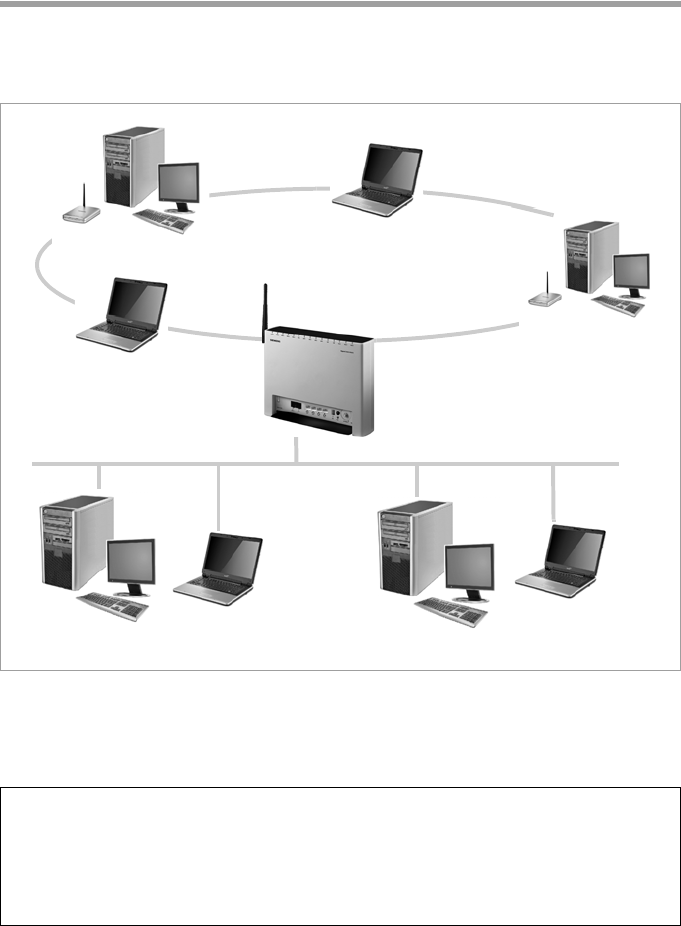
23
The Gigaset SX686 WiMAX
Gigaset SX686 WiMAX / en / A31008-N919-R101-2x-7619 / introduction.fm / 15.10.2008
Schablone 2005_07_27
Linking a wireless network to an Ethernet
Wireless local area networks can work easily together with existing Ethernet networks.
If you wish to connect mobile stations to an existing wired network, you must group
together all mobile stations into a wireless local area network in infrastructure mode.
The Gigaset SX686 WiMAX has four Ethernet interfaces (LAN ports). Up to four PCs can
be connected directly to these LAN ports.
All PCs can access the Internet via the Gigaset SX686 WiMAX.
Please remember:
You can also connect an Ethernet router or switch to a LAN port to access a larger Eth-
ernet. If you want to link the Gigaset WLAN network to an existing network, a large
number of settings have to be applied. Therefore we cannot provide a general exam-
ple for this use; the configuration depends greatly on the networks in question. We
advise having the configuration of such a network carried out by a specialist.
Access Point
Ethernet
(wired)
(((
(((
)))
)))
WLAN (wireless)
)))(((
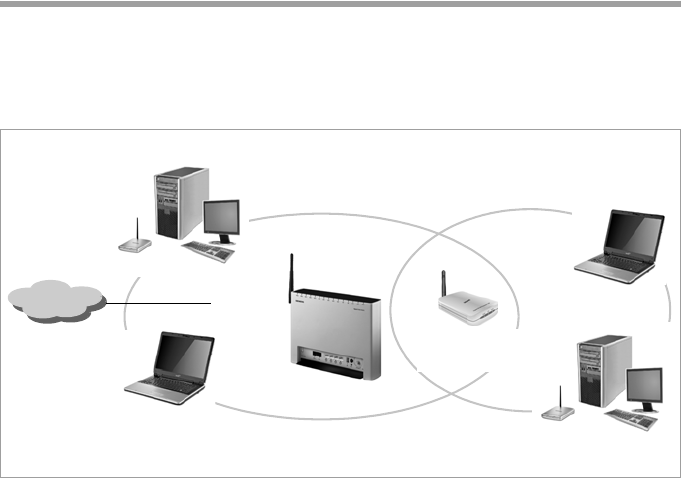
24
The Gigaset SX686 WiMAX
Gigaset SX686 WiMAX / en / A31008-N919-R101-2x-7619 / introduction.fm / 15.10.2008
Schablone 2005_07_27
Extending the wireless network coverage with a repeater
Using the Gigaset WLAN Repeater, you can extend your wireless network's coverage. Set
it up within the range of your network. The repeater will now transmit data traffic into
its own wireless area. This technology allows you to set up wireless networks that cover
a much larger area than is possible with a single Gigaset SX686 WiMAX.
PCs to be connected in a wireless local area network via a repeater must be equipped
with an integrated wireless network adapter or you have to connect an external wireless
network adapter (e.g. a USB adapter).
Internet
)))
(((
)))
)))
WLAN
(((
Gigaset WLAN
Repeater (((
)))
)))
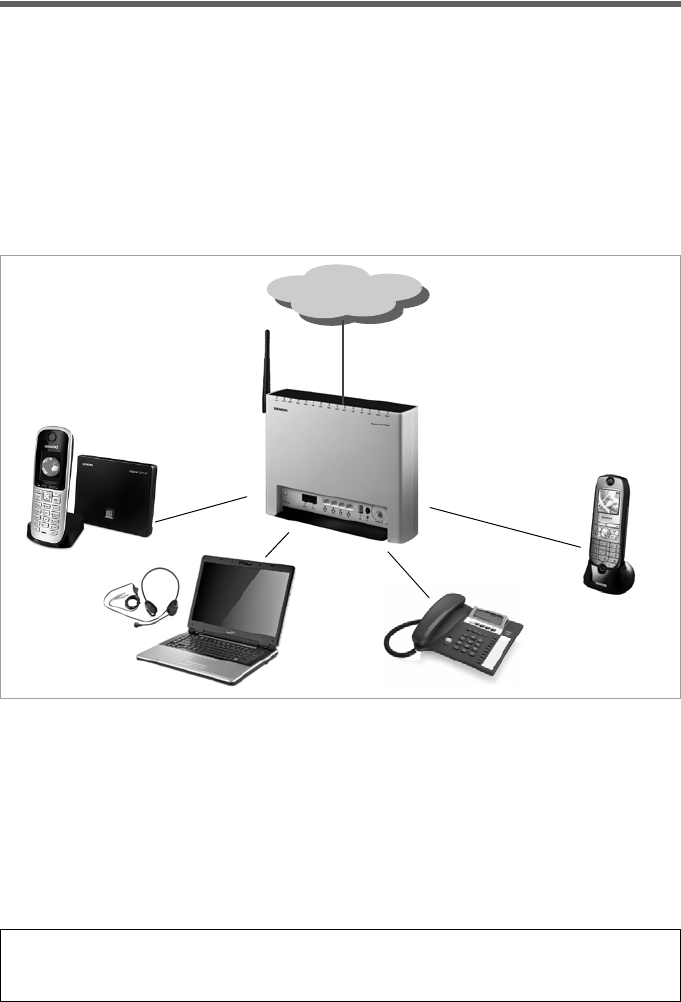
25
The Gigaset SX686 WiMAX
Gigaset SX686 WiMAX / en / A31008-N919-R101-2x-7619 / introduction.fm / 15.10.2008
Schablone 2005_07_27
Internet telephony and connecting analogue phones
The Gigaset SX686 WiMAX allows a combination of analogue fixed network telephony
and Internet telephony (VoIP) over WiMAX for two analogue telephones and four other
wired or wireless VoIP telephones or SIP clients.
This provides you with the full benefits of both technologies. You can make use of the
low-cost call rates of Internet telephony without any additional equipment. In addition,
you have the option of using your analogue fixed network connection. The type of calls
that are cheaper for you will depend on what calls you make and when you make them,
and the rates offered by your service provider. The Gigaset SX686 WiMAX gives you
complete freedom of choice at any time.
You can choose whether to connect any two analogue phones, a fax machine or an
answering machine to the phone ports. You can configure these ports using the Gigaset
SX686 WiMAX.
The PABX of the Gigaset SX686 WiMAX allows you to connect SIP phones and PCs with
SIP clients (software for Internet telephony) as well as wireless SIP phones (WLAN hand-
sets) as extensions. You can use all functions of your PABX for Internet telephony also.
You will need the relevant access data for your VoIP provider to configure Internet
telephony.
Please remember:
You can only be reached via the Internet (VoIP) when an active Internet connection
is established. You can still be called any time via the fixed network, however.
Internet
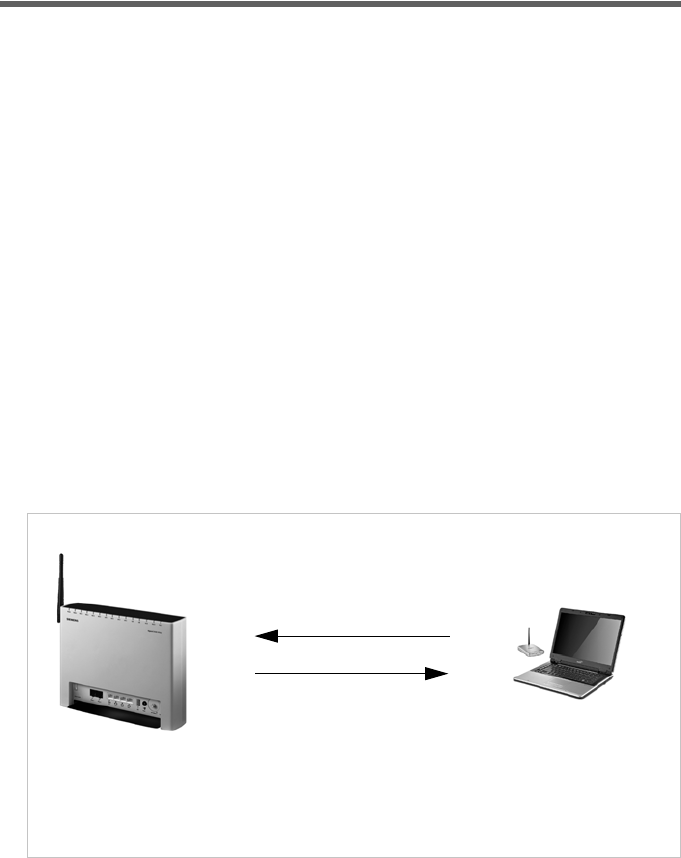
26
The Gigaset SX686 WiMAX
Gigaset SX686 WiMAX / en / A31008-N919-R101-2x-7619 / introduction.fm / 15.10.2008
Schablone 2005_07_27
Setting up a wireless network via WPS
Wi-Fi Protected Setup (WPS) makes it easier to establish and encrypt a wireless network.
You no longer need to configure and synchronise the individual components of your
wireless network manually.
A wireless network is assigned a name (SSID) and requires the encryption of data traffic
to protect against the risk of unauthorised access. The access point requires authentica-
tion with an SSID and - if encryption is activated - a key to allow a WLAN adapter to
access services.
WPS uses the encryption methods WPA-PSK or WPA2-PSK. Devices with WPS automati-
cally synchronise their SSID and WPA encryption key (pre-shared key).
WPS is not possible in networks that use WEP encryption or WPA2/WPA authentication.
WPS may be used without encryption.
Clients without WPS can be connected manually.
WPS provides two possibilities for registration:
uVia registration button
The Gigaset SX686 WiMAX provides the registration button function via the user
interface (see page 93).
Once the registration button has been activated, the device allows the registration
of a WLAN client (repeater or wireless network adapter) during a two-minute inter-
val.
If a client activates WPS registration within the two-minute interval, the security
data is exchanged and a connection is established. Only one client may synchronise
during the two-minute interval. After the successful synchronization the registration
is closed.
If the SSID and the pre-shared key have been already set on delivery or have been
configured before manually, these security data are used for registration. If this is
Access Point
Activating WPS registration via
software
WLAN network adapter
Pushing the registra-
tion button or activat-
ing WPS registration
via software
SSID and pre-shared key
Registering
Registering a PC
(((
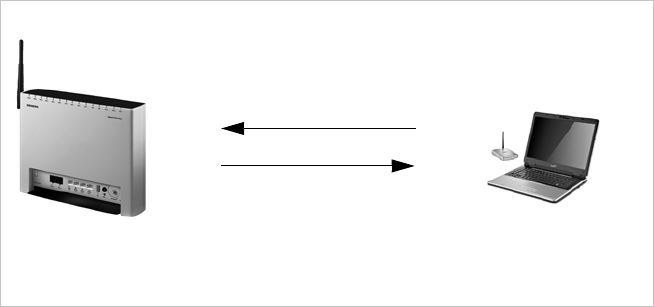
27
The Gigaset SX686 WiMAX
Gigaset SX686 WiMAX / en / A31008-N919-R101-2x-7619 / introduction.fm / 15.10.2008
Schablone 2005_07_27
not the case, the first time the WPS registration is started, the device automatically
creates a SSID and a pre-shared key.
The automatically or manually created security data is valid for all further WPS reg-
istration processes. If you change this security data again manually or after a factory
reset the clients have to be registered again.
uVia Personal Identification Number (PIN)
The PIN offers improved security for registration. No other device (e.g. in an adjacent
room) can log in unnoticed. A PIN is used for registration which must be identical on
both devices. If a client logs in with this PIN, the security data is synchronised. Usu-
ally the PIN of the access point is used. For security reasons a new PIN can be cre-
ated.
It is also possible to create the PIN on one of the clients.
Further information you will find in chapter "Starting WPS registration and configur-
ing WPS" on page 93.
WLAN adapters without WPS can also be set up manually, i.e. the SSID and key must be
entered manually. How you can find out which SSID and which pre-shared key is set, you
can read in chapter "Configuring wireless connections" on page 91.
Access Point
Generating the PIN via con-
figuration user interface
Repeater or
Entering and activating the PIN
via configuration user interface
SSID and pre-shared key
Registering
WLAN network adapter
(((

28
Installing the Gigaset SX686 WiMAX
Gigaset SX686 WiMAX / en / A31008-N919-R101-2x-7619 / device.fm / 15.10.2008
Schablone 2005_07_27
Installing the Gigaset SX686 WiMAX
System requirements
You require the following components to operate your Gigaset SX686 WiMAX:
uA PC with
– an 802.11g or 802.11b compatible wireless Network adapter
or
–an Ethernet port (10Base-T or 100Base-TX)
uA Web browser such as Microsoft Internet Explorer V 6.0 or higher or Mozilla Firefox
V 1.0 or higher for configuring your Gigaset SX686 WiMAX.
uTo access the Internet you require
– the access data for your WiMAX Internet service provider.
uFor Internet telephony you also require
– the access data for your VoIP service provider and
– a phone for connecting to the Gigaset SX686 WiMAX or a PC with a SIP client or
a VoIP telephone.
If you use the separate WiMAX outdoor antenna (optional, not included in the
scope of delivery):
The Gigaset SX686 WiMAX can only be used with the device's integrated antenna or
with one of the following outdoor antennas.
Note:
An 802.11b-compatible network adapter has a maximum transmission speed
of 11 Mbps. An 802.11g-compatible network adapter has a maximum trans-
mission speed of 54 Mbps.
Note:
We recommend you use the Windows Vista or Windows XP operating system on
the PCs you want to connect to the Gigaset SX686 WiMAX as only then are all sys-
tem requirements for using the device fulfilled.
3,5 GHz 18 dBi WiMAX Antenna Outdoor C39453-Z5-C504 A5B00076092365
3,5 GHz 9 dBi WiMAX Antenna Outdoor C39453-Z5-C505 A5B00076093200
2,6 GHz 9 dBi WiMAX Antenna Outdoor C39453-Z5-C506 A5B00076093231
2,6 GHz 15 dBi WiMAX Antenna Outdoor C39453-Z5-C507 A5B00076093596

29
Installing the Gigaset SX686 WiMAX
Gigaset SX686 WiMAX / en / A31008-N919-R101-2x-7619 / device.fm / 15.10.2008
Schablone 2005_07_27
This user guide assumes that installation of the outdoor antenna has been completed.
Choosing your location
The Gigaset SX686 WiMAX can be set up in any suitable location in the home or office.
You do not need any special wiring. However, you should comply with the following
guidelines:
uChoose a location that enables you to simply set up the following connections with-
out any further work.
– Connect the Ethernet cable for connection to a PC or network.
– Connect the power lead to the mains socket.
uStand the Gigaset SX686 WiMAX upright on an even, non-slip surface.
uLay the cables in such a way that nobody can tread on or trip over them.
uPosition the Gigaset SX686 WiMAX so that you can see the LEDs.
uDo not cover the openings in the Gigaset SX686 WiMAX housing to ensure the heat
can circulate; otherwise, the duty cycle of the device will be reduced or the Gigaset
SX686 WiMAX switched off to avoid overheating.
uDo not operate the Gigaset SX686 WiMAX under the influence of direct heat sources
(e.g. directly in the sun).
uDo not position the device in the immediate vicinity of stereo equipment, TV sets,
microwave ovens or the like. This may cause interference.
uPosition the Gigaset SX686 WiMAX respective the external desktop antenna so that
it is as near to the centre of your wireless network as possible. The general rule is:
The higher you place the WLAN antenna, the better the performance. Make sure
that the place where you position the antenna offers optimum reception through-
out the house, apartment or office.
W
3.5 GHz versions should be used for the European Economic Area.
The following requirements apply:
All the external antennas used for this product must undergo a confor-
mity assessment procedure.
The 3.5 GHz antennas listed here meet the European requirements and
guarantee the functionality of the complete system.
During the conformity assessment procedure it was ensured that the SAR
limits set down in directive 99/519/EC are observed. Verification was per-
formed using EN 50385.
The outdoor antenna must be installed and put into service by a qualified
electrician.
The notes in the enclosed installation instructions must be followed
Please remember:
Network connections (LAN) via cables and telephone lines may only be set up with
the Gigaset SX686 WiMAX within enclosed rooms.
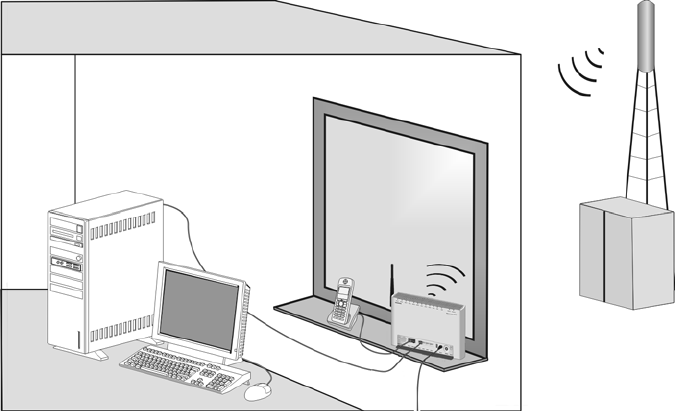
30
Installing the Gigaset SX686 WiMAX
Gigaset SX686 WiMAX / en / A31008-N919-R101-2x-7619 / device.fm / 15.10.2008
Schablone 2005_07_27
If you use the WiMAX antenna integrated into the Gigaset SX686 WiMAX:
uPosition the Gigaset SX686 WiMAX directly in a window, so that the side with the
LEDs and connectors is pointing into the room, towards you. Wherever possible,
position the Gigaset SX686 WiMAX on one of the upper storeys. Note that obstruc-
tions, particularly doors and wall coverings containing metal can affect data trans-
mission.
uPosition the Gigaset SX686 WiMAX as far away as possible from metallic objects and
coated foils.
Gigaset SX686 WiMAX with integrated antenna
PC with Gigaset
SX686 WiMAX
WiMAX network
base station
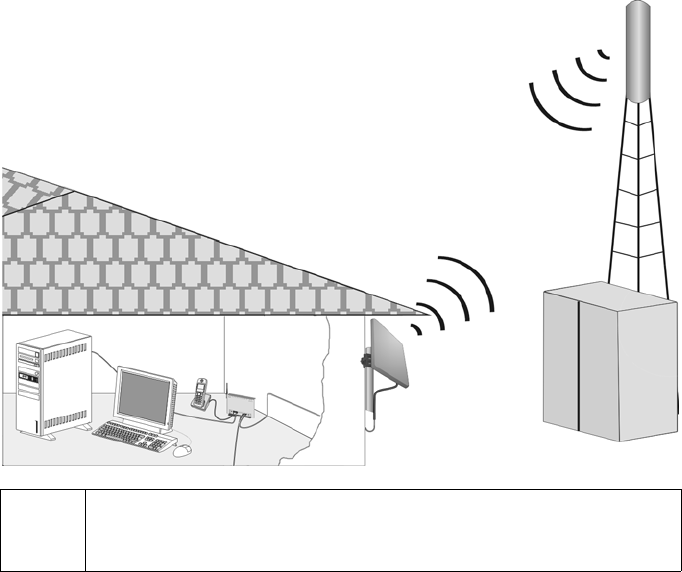
31
Installing the Gigaset SX686 WiMAX
Gigaset SX686 WiMAX / en / A31008-N919-R101-2x-7619 / device.fm / 15.10.2008
Schablone 2005_07_27
Gigaset SX686 WiMAX with outdoor antenna
iWhen used with the antenna integrated into the device or the outdoor
antenna, the Gigaset SX686 WiMAX complies with the regulations on lim-
iting the effect of electromagnetic fields on the general population.
PC with Gigaset SX686 WiMAX
WiMAX network
base station

32
Installing the Gigaset SX686 WiMAX
Gigaset SX686 WiMAX / en / A31008-N919-R101-2x-7619 / device.fm / 15.10.2008
Schablone 2005_07_27
Connecting and activating the Gigaset SX686 WiMAX
Installation overview
1. If you use the outdoor antenna, have it installed by a radio and television technician.
Connect the antenna cable from outside to the Gigaset SX686 WiMAX.
2. Make sure that an Ethernet network card or a wireless Network adapter is installed
in the PCs you want to connect to the Gigaset SX686 WiMAX. The installation is de-
scribed in the user guides for these products.
3. Then make the necessary connections (PCs, phones) on the Gigaset SX686 WiMAX
and activate the device.
4. Before the PCs can communicate with the Gigaset SX686 WiMAX and with each oth-
er in a local network, you may have to adapt your network settings (page 39). Con-
figure these network settings on one PC first so that it can establish a connection to
the Gigaset SX686 WiMAX. You can then use this PC to configure the device. To find
out how to do this, refer to the section entitled "Configuring the local area network"
on the CD-ROM.
5. With a wireless connection, you establish the link from the PC's wireless network
adapter to the Gigaset SX686 WiMAX. This is described in the user guide for the net-
work adapter. If the wireless network adapter provides WPS, you can establish the
connection with a simple click (see page 37).
6. Then configure the Gigaset SX686 WiMAX to activate the device's Internet access
(refer to the section entitled "Basic Setup Wizard" on page 46). To do this you will
need the access data for your Internet service provider.
uIf you want to connect more PCs to the Gigaset SX686 WiMAX, configure their net-
work settings and set up the local area network accordingly (refer to the section enti-
tled "Configuring the local area network" on the CD-ROM).
For experienced users
The default settings of the Gigaset SX686 WiMAX for LAN and WLAN configuration
are:
– IP address: 192.168.2.1
– Subnet mask: 255.255.255.0
– SSID: The SSID is shown on the device label.
Default SSID, e.g. ConnectionPoint,
or individual preset: SX686-XXXXXX, where XXXXXX stands for a string con-
sisting of 0-9 and A-F.
– WLAN encryption: WPA-PSK SX686-XXXXXX
– Radio channel: 6
Caution: The Gigaset SX686 WiMAX is delivered with a preset individual encryption
(WPA2-PSK/ WPA-PSK with pre-shared key). You will find this data at the label on the
bottom of the device.
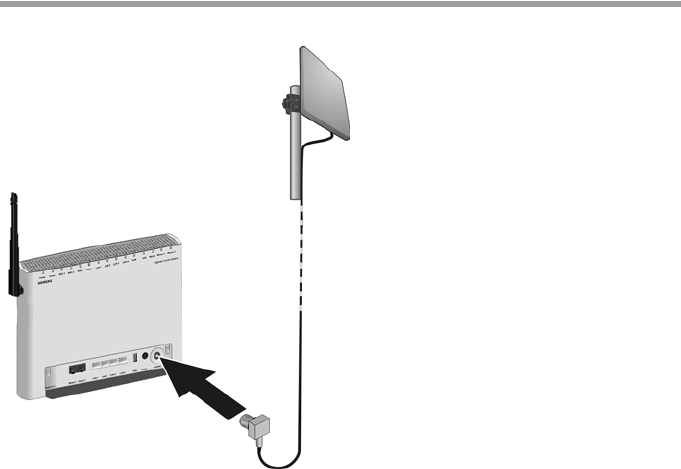
33
Installing the Gigaset SX686 WiMAX
Gigaset SX686 WiMAX / en / A31008-N919-R101-2x-7619 / device.fm / 15.10.2008
Schablone 2005_07_27
uIf you want to use the Gigaset SX686 WiMAX for Internet telephony, you must con-
figure your VoIP provider's registration data (refer to the section entitled "Setting up
Internet telephony (VoIP)" on page 105).
uIf you wish to use other functions of the Gigaset SX686 WiMAX, for example the
comprehensive security features, use the Security Setup (page 59) or the Advanced
Setup (page 69).
Connecting the outdoor antenna
ìPlug the connector of the antenna
cable into the WiMAX connector on
your Gigaset SX686 WiMAX and
screw tightly.
To remove the antenna cable plug,
unscrew it from the antenna connec-
tor and pull the plug out.
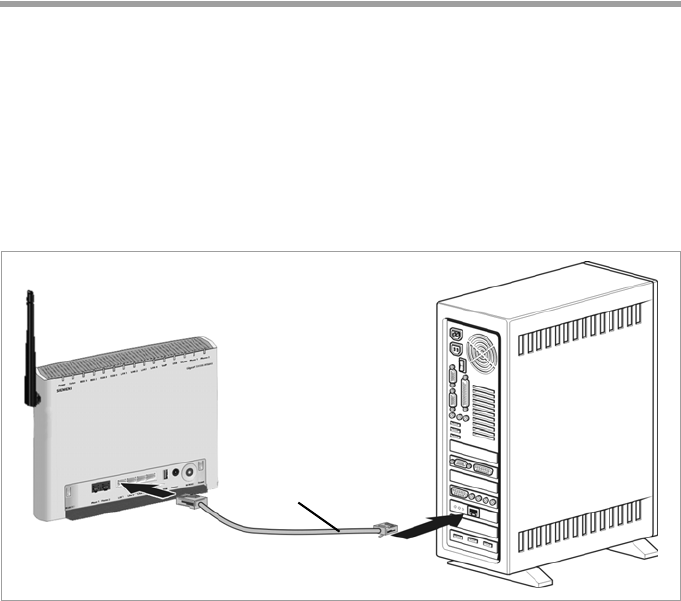
34
Installing the Gigaset SX686 WiMAX
Gigaset SX686 WiMAX / en / A31008-N919-R101-2x-7619 / device.fm / 15.10.2008
Schablone 2005_07_27
Connecting a PC wired
You can connect wired or wireless PCs to your Gigaset SX686 WiMAX to create a local
area network (LAN). Wireless connection is possible after connecting the Gigaset SX686
WiMAX to the power supply (see page 36).
First connect just one PC to the Gigaset SX686 WiMAX, wired connection is recom-
mended. You can then carry out the general configuration. (If you wish to connect more
PCs, please turn to page 40.)
ìConnect one of the LAN ports (LAN1 – LAN4, yellow) on the Gigaset SX686 WiMAX
to the Ethernet network card in your PC. To do this, use the LAN cable supplied
(CAT5, yellow).
LAN cable (yellow)
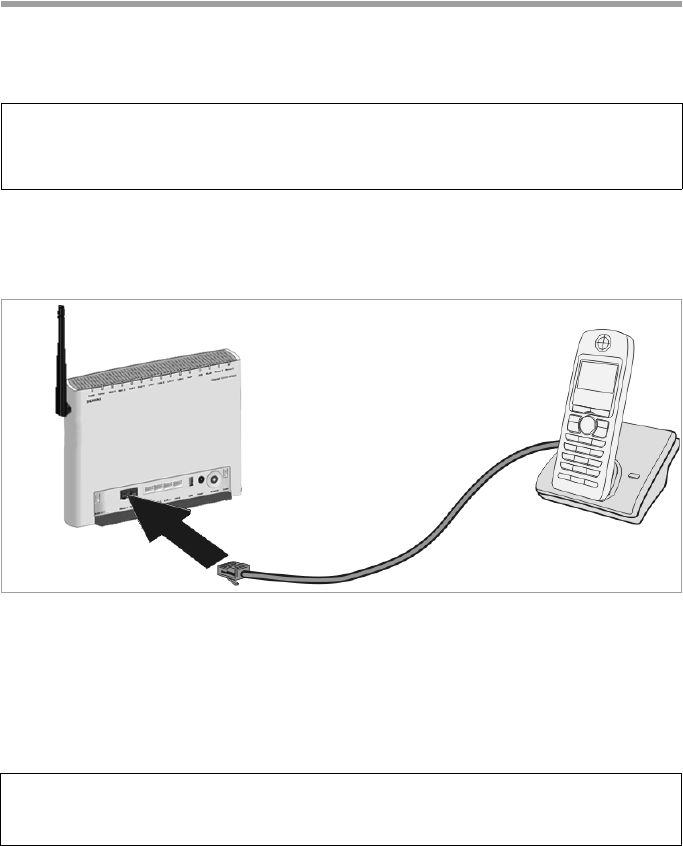
35
Installing the Gigaset SX686 WiMAX
Gigaset SX686 WiMAX / en / A31008-N919-R101-2x-7619 / device.fm / 15.10.2008
Schablone 2005_07_27
Connecting a telephone, fax machine or answer machine
You can connect an analogue terminal, such as a telephone with cord, cordless tele-
phone, fax machine or answer machine, and operate them via the Internet in future
(Internet telephony/VoIP).
Connect the Gigaset SX686 WiMAX with the analogue phone as follows:
ìInsert the plug of the telephone into the Phone 1 or Phone 2 port on the Gigaset
SX686 WiMAX.
If your analogue terminal has a TAE plug, first connect this to the adapter (connect a
telephone to the F-coded socket, a fax machine or answer machine to the N-coded
socket). Then connect the adapter plug to one of the Phone connections on the Gigaset
SX686 WiMAX.
ìIf necessary connect the telephone, fax machine or answer machine to the mains
power supply.
Note
Depending on the connection plug on your analogue terminal, you may require an
additional adapter (TAE socket on the RJ11 plug).
Note:
You cannot make VoIP calls in the event of a power failure. Emergency numbers are
also not accessible in this case.
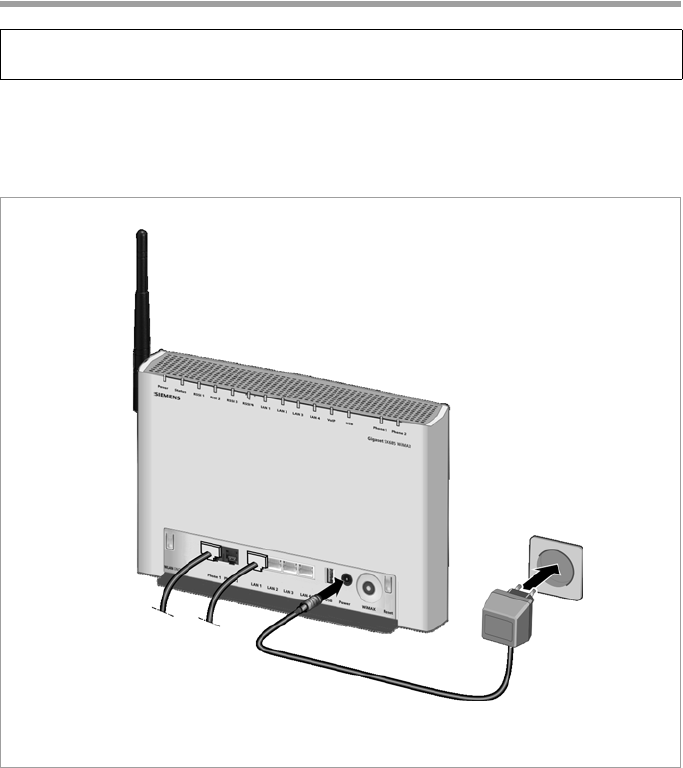
36
Installing the Gigaset SX686 WiMAX
Gigaset SX686 WiMAX / en / A31008-N919-R101-2x-7619 / device.fm / 15.10.2008
Schablone 2005_07_27
Connecting to the mains power supply
ìConnect the mains adapter cable to the Power socket on the Gigaset SX686 WiMAX.
ìPlug the mains adapter into a mains socket.
The Gigaset SX686 WiMAX is now switched on and ready for operation.
The system starts up and performs a self-test. After the self-test, the Gigaset SX686
WiMAX continually attempts to register with a WiMAX network. Registration may be
successful immediately. If not, registration will take place when the Gigaset SX686
WiMAX is being configured. You can check whether your device is already registered
with a WiMAX network via the Status LED (see page 14).
Please remember:
Only use the mains adapter supplied with the device (12V DC 2A).

37
Installing the Gigaset SX686 WiMAX
Gigaset SX686 WiMAX / en / A31008-N919-R101-2x-7619 / device.fm / 15.10.2008
Schablone 2005_07_27
Connecting PCs wirelessly
Wireless via WPS
If you are using WPS (see page 26), you can easily make a wireless connection to other
WLAN devices.
ìActivate the WPS registration via the corresponding function in the user interface to
start WPS registration (see page 57).
ìDuring the two-minute interval, activate WPS registration of the wireless network
adapter on the PC. The client receives the security data for the Gigaset SX686
WiMAX (SSID and pre-shared key) and is thereby registered.
Only one client may register during an individual registration phase. If the device indi-
cates by means of the WLAN LED that more than one client has tried to register, there is
no client registered. You can start WPS registration again after a short time.
If the LED indicates a successful WPS registration, the desired client, however, has no
connection the Gigaset SX686 WiMAX and has not been registered successfully, an
external device may have connected to your WLAN. In this case, you should modify the
WPA-PSK key as quickly as possible (see page 63) or perform a factory reset (see
page 16) and perform WPS registration for the clients using a PIN (see page 57).
For additional WPS registration options see chapter "WPS Registration" on page 57.
For the wireless connection of additional PCs without WPS function see page 40.
Wireless without WPS
A wireless connection is made using a wireless network adapter that must be installed
in your PC. This can be an 802.11g or 802.11b-compatible wireless network adapter.
Owing to the superior range and the high data throughput, we recommend that you use
the Gigaset PC Card 54 or the Gigaset USB Adapter 54.
A wireless network is defined by assigning an identical SSID to all the devices.
ìYou should therefore enter the SSID for the Gigaset SX686 WiMAX in your network
adapter configuration. You will find the default SSID for the Gigaset SX686 WiMAX
at the label on the bottom of the device (e.g. ConnectionPoint or SX686-XXXXXX,
where XXXXXX is an individual string consisting of 0-9 and A-F).
If you use a wireless network adapter from the Gigaset range, enter the SSID using
the Gigaset WLAN Adapter Monitor.
WLAN LED display during WPS registration:
On (300 sec) WPS registration was successful.
Flashing slowly WPS registration is in progress.
Flashing quickly WPS registration was not successful.
Flashing quickly
with interruption
More than one client tried to register.
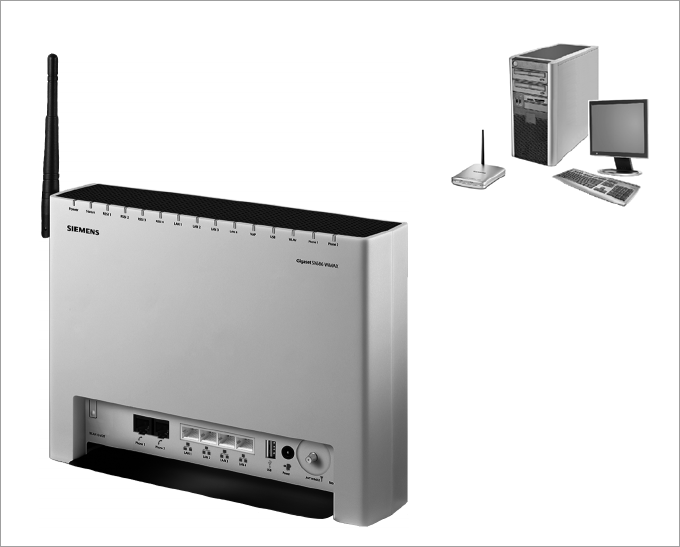
38
Installing the Gigaset SX686 WiMAX
Gigaset SX686 WiMAX / en / A31008-N919-R101-2x-7619 / device.fm / 15.10.2008
Schablone 2005_07_27
The Gigaset SX686 WiMAX is delivered with preset individual encryption (WPA2-PSK/
WPA-PSK with pre-shared Key). You will find this key at the label on the bottom of the
device.
ìChoose the encryption method WPA2-PSK/ WPA-PSK in the configuration settings of
your network adapter and enter the pre-shared key of you Gigaset SX686 WiMAX.
If one of your network adapters do not provide this encryption method, you must
change the encryption method at the Gigaset SX686 WiMAX (see page 94) and then
configure the encryption appropriately for all network adapters. The settings at the
Gigaset SX686 WiMAX should be performed only with a wired connected PC)
If the correct SSID and encryption has been entered in your PC's wireless network
adapter, the wireless link will be established automatically.
WLAN adapter
(((
)))

39
Installing the Gigaset SX686 WiMAX
Gigaset SX686 WiMAX / en / A31008-N919-R101-2x-7619 / device.fm / 15.10.2008
Schablone 2005_07_27
Checking the operating state
Your Gigaset SX686 WiMAX is now ready for use. The LED displays on the front panel of
the Gigaset SX686 WiMAX provide information about the operating state (see page 13).
When the device is ready for use, the LEDs light up as follows:
uThe Power LED on the front lights up green.
uIf registration with a WiMAX network has already been successful, the Status LED
lights up green. The RSSI 1 - RSSI 4 LEDs indicate the signal strength.
If the Status LED does not light up, register your Gigaset SX686 WiMAX during con-
figuration.
uThe WLAN LED lights up to indicate that the Gigaset SX686 WiMAX is ready to estab-
lish wireless connections.
The radio link to a PC that is connected by means of a wireless network adapter is
opened automatically provided the network adapter has been configured with the
same SSID as the Gigaset SX686 WiMAX. It can take a few seconds for the wireless
connection to be established. The WLAN LED flashes when data is sent or received
via this connection.
uThe LAN LEDs light up if a device is connected to the corresponding LAN port.
If this is not the case, refer to the section entitled Troubleshooting on (page 167).
Network configuration of the PCs
In order to communicate via the Gigaset SX686 WiMAX, the network configuration
may have to be set up on the connected PCs.
With
uWindows Vista or
uWindows XP or
uWindows 2000 and
uMac OS X
operating systems, this usually takes place automatically provided you have not made
any changes to the standard settings for the network configuration.
With Windows 98/SE, you have to carry out the network configuration.
The description of the network configuration can be found on the CD-ROM.
Making the basic settings
You can now make the basic settings for Internet access using the user interface of the
Gigaset SX686 WiMAX (page 41).
If you want to connect additional PCs to the Gigaset SX686 WiMAX, please read the next
section.

40
Installing the Gigaset SX686 WiMAX
Gigaset SX686 WiMAX / en / A31008-N919-R101-2x-7619 / device.fm / 15.10.2008
Schablone 2005_07_27
Connecting and configuring additional PCs (optional)
Once you have configured one PC as described above you can connect additional PCs to
the Gigaset SX686 WiMAX. You will need an additional cable for each PC you want to
connect via cable. For the wireless connection of additional PCs, you will need a wireless
network adapter.
Wireless
ìInstall wireless network adapters in each other PC as described in the corresponding
user guide, making sure that the SSID and encryption of all wireless network com-
ponents (Gigaset SX686 WiMAX and network adapters) is identical.
You will find the default SSID at the label on the bottom of the device.
If you have connected a PC via WPS, you will find the created SSID in the Advanced
Settings of the user interface (see page 91). You can see the preset pre-shared key
at the label on the bottom of the device or also via the user interface in the
Advanced Settings menu (see page 91). You use this information to manually con-
figure PCs without WPS.
PCs with WPS can be connected wirelessly via WPS (see page 37 and page 93).
ìIf necessary, set up the network for each newly connected PC (page 39).
ìReboot the additional PCs.
Wired
ìConnect the network cards of each additional PC to a free LAN port (LAN1 – LAN4)
on the Gigaset SX686 WiMAX using an Ethernet cable.
ìMake sure that the corresponding LAN LED on the front of your Gigaset SX686
WiMAX flashes.
ìIf necessary, set up the network for each newly connected PC (page 39).
ìReboot the additional PCs.
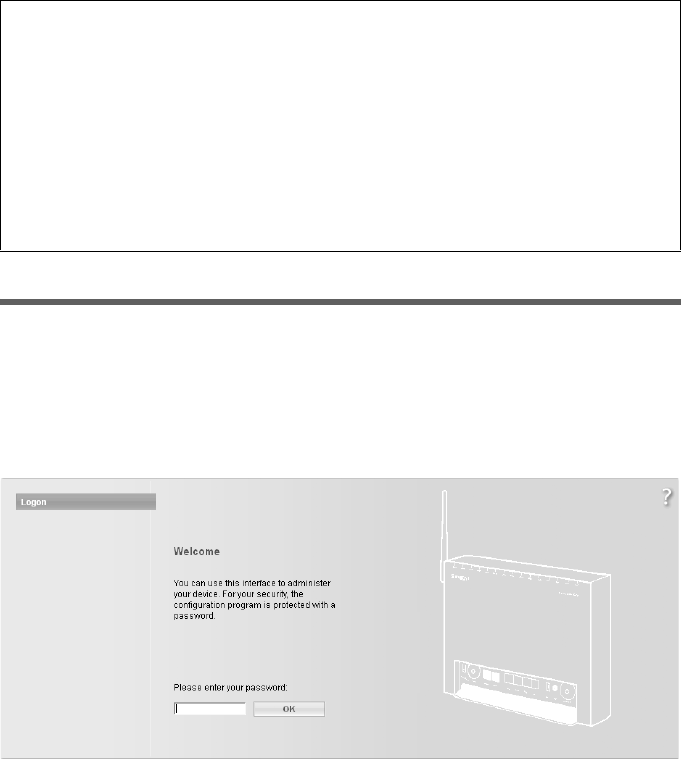
41
The user interface
Gigaset SX686 WiMAX / eng / A31008-N919-R101-2x-7619 / configure_router.fm / 15.10.2008
Schablone 2005_07_27
The user interface
You have connected a PC to the Gigaset SX686 WiMAX and possibly made the settings
in the local area network. You can now configure the Gigaset SX686 WiMAX using this
PC via the user interface. We recommend for initial configuration that you connect the
PC in wired mode. As Internet browser we recommend Microsoft Internet Explorer V 6.0
or higher, or Mozilla Firefox V 1.0 or higher.
Starting the user interface
To access the user interface of the Gigaset SX686 WiMAX:
ìStart your Internet browser.
ìEnter the IP address of the Gigaset SX686 WiMAX in the browser's address field:
http://sx686 or http://192.168.2.1
The login screen appears:
For your security, the configuration program is protected with a password. The default
password generally required is admin.
ìEnter the password.
Note:
To start the configuration environment, you may need to deactivate the HTTP proxy
for your browser.
If you use Window Vista or Windows XP Service Pack 2, you will need to configure the
popup blocker.
You will find additional information on these two points on "Deactivating HTTP proxy
and configuring a pop-up blocker" on page 173.
If you use a firewall, it must allow connection to the Gigaset SX686 WiMAX. For
details, refer to the user guide for your firewall. If necessary, deactivate the firewall
while you configure your Gigaset SX686 WiMAX.
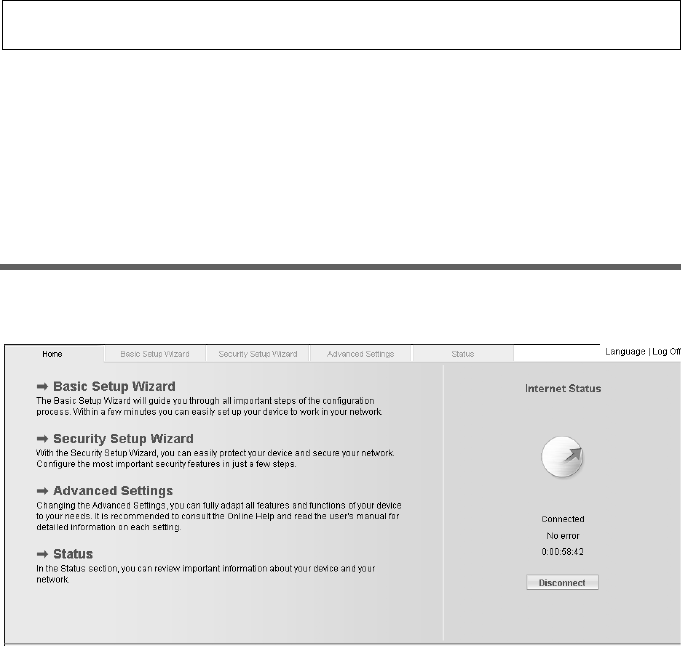
42
The user interface
Gigaset SX686 WiMAX / eng / A31008-N919-R101-2x-7619 / configure_router.fm / 15.10.2008
Schablone 2005_07_27
ìClick OK.
A screen with security information will appear. You can skip this when configuring the
device for the first time. If you carry out all the general and security settings using the
wizard as described below, your device and network will be fully protected. If not, the
next time you log on you will be informed of security gaps in the configuration program.
ìClick OK.
The start screen is displayed.
The start screen
The start screen is the starting point for all configuration and administration proce-
dures.
Start screen functions
You can start the following actions on the start screen:
uSelect the language for the user interface (page 44).
uWhen you have established a connection to the WiMAX network and configured an
Internet connection for the first time, you can view the selected connection service
and the status of the Internet connection, choose a different connection service and
set up or close an Internet connection (page 44). The start screen shows the status
and also the button Connect or Disconnect.
uOpen the Status menu to obtain status information about the Gigaset SX686
WiMAX (page 136).
uCall up the wizard for the basic configuration (Basic Setup Wizard see page 46),
uCall up the Security Setup Wizard (page 59).
uOpen the Advanced Settings menu for additional configuration options (page 69).
Note:
For security reasons you should change this password at a later stage (page 60).
43
The user interface
Gigaset SX686 WiMAX / eng / A31008-N919-R101-2x-7619 / configure_router.fm / 15.10.2008
Schablone 2005_07_27
You can call up the wizards, the Advanced Settings menu and status information at any
time and on any user interface screen using the tabs at the upper margin of the user
interface.
The configuration program comprises the following functions:
Basic Setup Wizard Use this wizard to make the settings required for connecting to
the Internet. You align your WiMAX antenna to obtain opti-
mum reception and establish the connection to the WiMAX
network, configure your Internet account, select your region
and configure Internet telephony. Additionally, you can per-
form a WPS registration. This is described from page 46.
Security Setup Wizard This wizard allows you to take security precautions against
unauthorised access to the Gigaset SX686 WiMAX and the
local network. You can assign a password and set up encryp-
tion for wireless traffic. This is described from page 59. To pro-
tect your network, we strongly recommend that you carry out
this setup.
Advanced Settings Additional functions are offered in the Advanced Settings
menu. You can configure your PABX for Internet telephony,
back up and restore the configuration data, set up the Gigaset
SX686 WiMAX as a virtual server for the network, configure a
Web server, a file server or a print server and perform other
functions as required. These configuration steps are optional
and can be carried out at a later stage. This is described from
page 69.
Status You can view information about the configuration and status
of the Gigaset SX686 WiMAX in the Status menu. This is
described from page 136.
Language You also have the opportunity to specify the language for the
user interface (page 44).
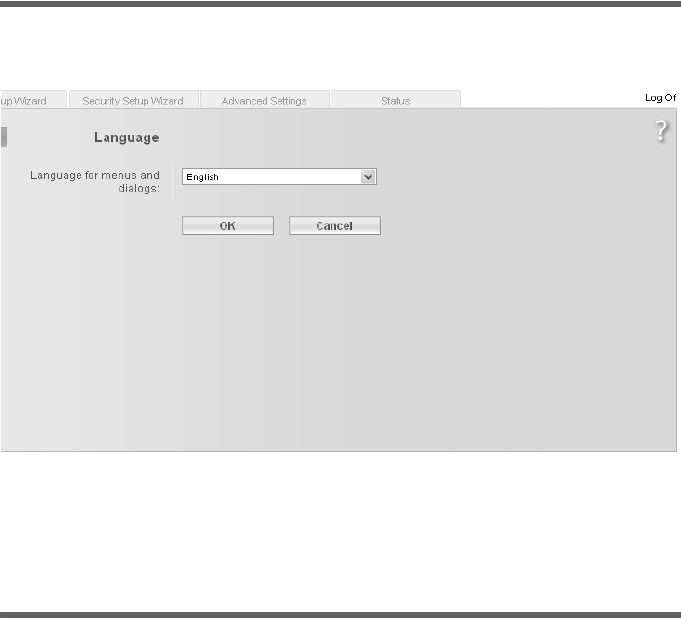
44
The user interface
Gigaset SX686 WiMAX / eng / A31008-N919-R101-2x-7619 / configure_router.fm / 15.10.2008
Schablone 2005_07_27
Selecting a language
The user interface can be presented in various languages.
ìClick Language at the top right of the start screen.
ìIf you wish to change the preset language, select the new language you require from
the list.
ìClick OK to apply the setting.
Once the procedure has been concluded, the start screen will be displayed again.
Connecting to the Internet manually
Once you have configured your Internet access (see page 54 and page 72), you can
establish a manual connection to the Internet on the start screen if you have selected
Connect on demand or Connect manually as the Connection mode.
To establish or end an Internet connection manually:
ìOpen the start screen of the Gigaset SX686 WiMAX as described on page 41.
If you have already started the user interface, click the start screen tab at the top left
of the window.
If you have not yet started the user interface, do so now and log on.
ìClick Connect to establish a connection to the Internet.
ìClick Disconnect if you no longer require the connection.

45
The user interface
Gigaset SX686 WiMAX / eng / A31008-N919-R101-2x-7619 / configure_router.fm / 15.10.2008
Schablone 2005_07_27
Elements in the user interface
The user interface screens contain the following elements:
Button Log Off
The Log Off button is always displayed on the right of the user interface. If you click Log
Off, the session is ended and the login screen appears again.
Help
Click the question mark to display explanations about the current
user interface screen.
Buttons and icons used by the wizards
The wizards use graphic icons to show which steps you have already
carried out.
uAs soon as you have changed the configuration on a screen you can activate the new
setting by clicking Next >.
uThe < Back button returns you to the previous configuration step.
uCancel returns you to the start screen. This button is not available for the initial con-
figuration of the device.
Buttons in the Advanced Settings menu
Other buttons may be displayed depending on the function in question. These are
explained in the relevant sections.
OK Transfers the settings you have made to the
Gigaset SX686 WiMAX configuration.
Cancel Deletes all the entries on a screen since the last time you clicked OK.
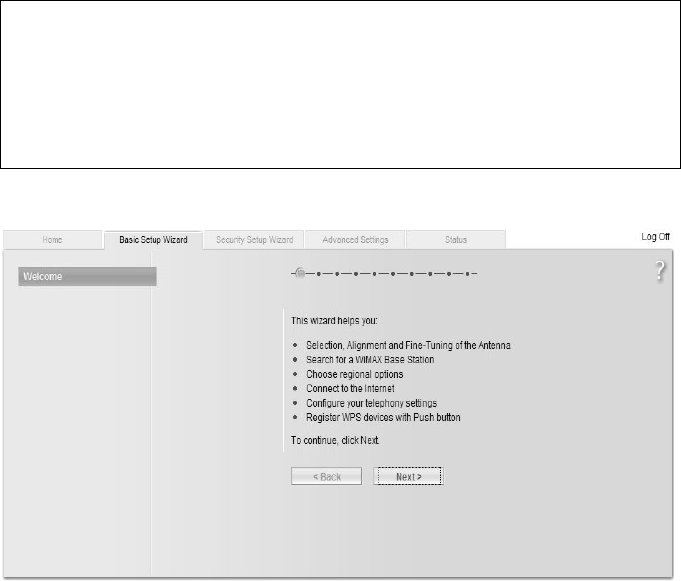
46
Basic Setup Wizard
Gigaset SX686 WiMAX / eng / A31008-N919-R101-2x-7619 / configure_router.fm / 15.10.2008
Schablone 2005_07_27
Basic Setup Wizard
The Basic Setup Wizard guides you step by step through the general configuration of the
Gigaset SX686 WiMAX. This includes
uchoosing and aligning the WiMAX antenna as well as connection establishment and
fine tuning to obtain optimum reception,
uthe settings for your region,
usetting up your Internet access,
usetting up your VoIP account and
uregistering a WLAN client via WPS.
Connection to the Internet is established via the Gigaset SX686 WiMAX for all PCs con-
nected to it. You need your Internet service provider's access data for the configuration.
Please have this data to hand.
ìSelect the Basic Setup Wizard option on the start screen to start the configuration.
ìClick Next >.
Note:
The Basic Setup Wizard will reconfigure your Internet settings if you have already set
these. This does not affect the WLAN and LAN settings.
The access data is saved in the Gigaset SX686 WiMAX during configuration. Before
passing the device on to somebody else or having your dealer replace it, you should
always reset the configuration of your device to its factory settings (page 134). Oth-
erwise, unauthorised persons may use your Internet access at your expense.
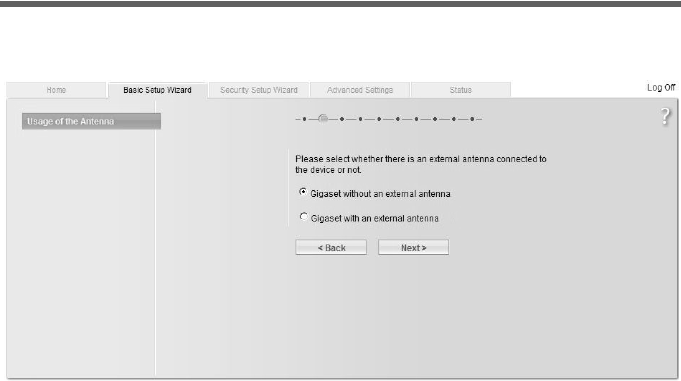
47
Basic Setup Wizard
Gigaset SX686 WiMAX / eng / A31008-N919-R101-2x-7619 / configure_router.fm / 15.10.2008
Schablone 2005_07_27
Choosing the antenna
On this screen you choose if you want to operate your Gigaset SX686 WiMAX with an
internal or external antenna.
ìChoose Gigaset without an external antenna if you are using the antenna inte-
grated in the Gigaset SX686 WiMAX.
ìChoose Gigaset with an external antenna if you received the outdoor antenna
together with your Gigaset SX686 WiMAX. The outdoor antenna must already have
been installed and connected by a qualified electrician.
ìClick Next >.
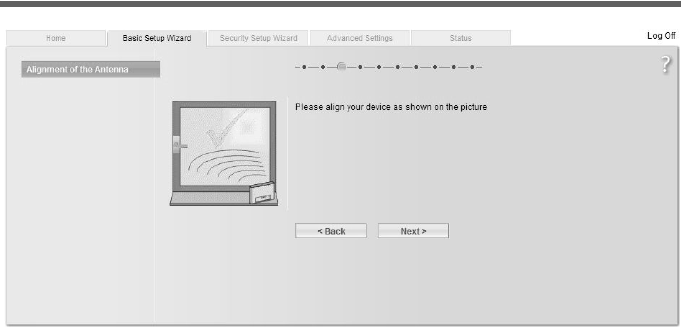
48
Basic Setup Wizard
Gigaset SX686 WiMAX / eng / A31008-N919-R101-2x-7619 / configure_router.fm / 15.10.2008
Schablone 2005_07_27
Aligning the antenna
ìIf you are using the antenna integrated in the Gigaset SX686 WiMAX, align it
towards the window. Your Gigaset SX686 WiMAX is already standing by the window
with the cable connections turned inwards and is connected.
ìIf you are using the outdoor antenna, align the antenna later.
ìClick Next >.
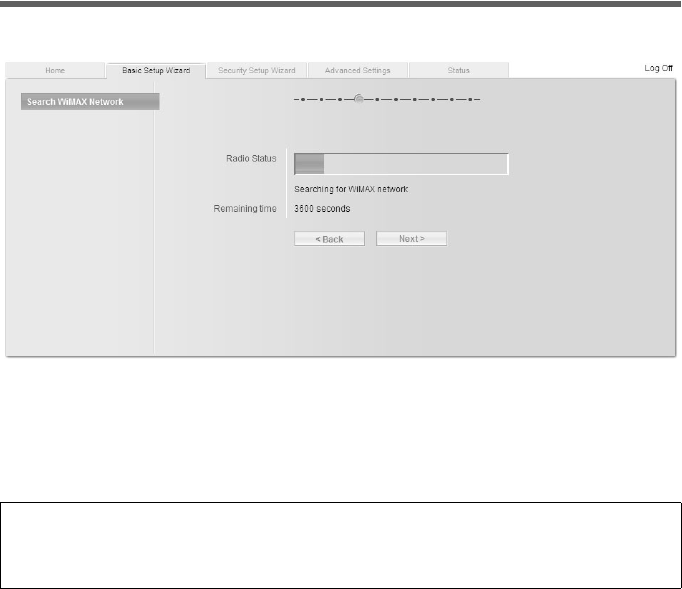
49
Basic Setup Wizard
Gigaset SX686 WiMAX / eng / A31008-N919-R101-2x-7619 / configure_router.fm / 15.10.2008
Schablone 2005_07_27
Searching a WiMAX network
The frequency scan begins automatically.
The frequency scan begins automatically. A progress bar indicates how far the scan has
progressed. In addition, you will see in the Remaining time area roughly how much
time is still needed for the complete scan. Depending on how your Gigaset SX686
WiMAX has been preconfigured by your provider, the scan can last several minutes
before the first radio connection is established.
As soon as a radio connection has been established with a WiMAX network, the scan will
end. The progress bar is fully filled in and the display in the Remaining time area jumps
to 0 seconds.
ìWhen a connection to a WiMAX network has been established, click on Next > to
make fine adjustments to the antenna.
ìRead on in Chapter "Antenna fine tuning" on page 52.
If the scan has not been successful:
The following screen is displayed.
Note
During the scan, the Gigaset SX686 WiMAX or antenna must not be moved; this is
the only way to guarantee a complete scan with the current antenna alignment.
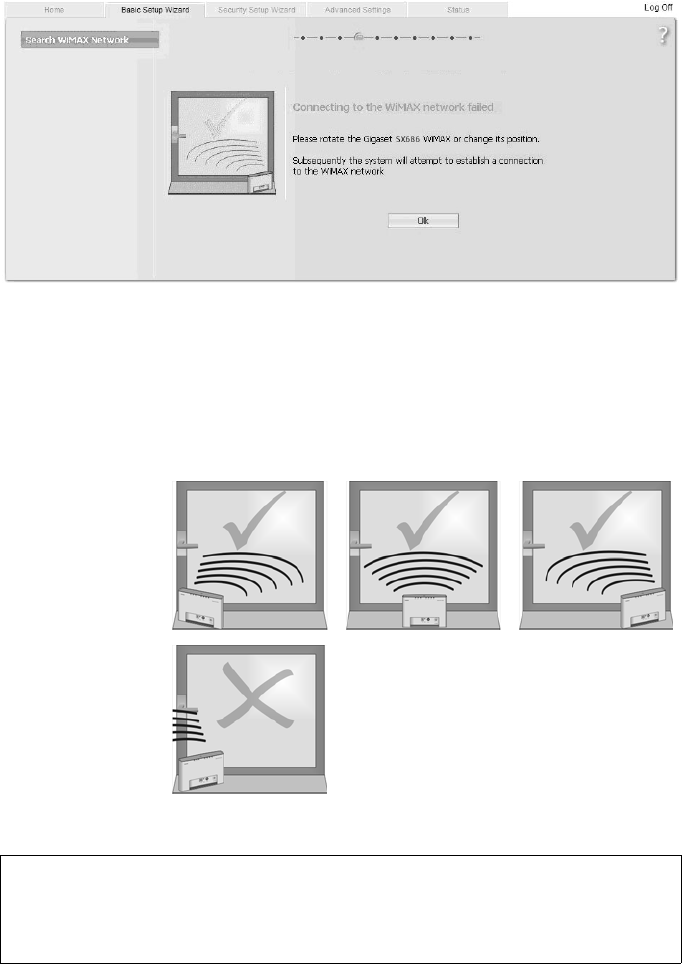
50
Basic Setup Wizard
Gigaset SX686 WiMAX / eng / A31008-N919-R101-2x-7619 / configure_router.fm / 15.10.2008
Schablone 2005_07_27
Both the integrated antenna and the outdoor antenna are directional antennae; this
means that they must at least be pointing roughly in the direction of a WiMAX network
base station in order to establish a radio connection.
If the scan was unsuccessful, align the antenna differently:
If you are using the antenna integrated in the Gigaset SX686 WiMAX:
ìTurn your Gigaset SX686 WiMAX by approx. 60°.
ìClick on OK to restart the scan.
If the scan has still not been successful with the alignment changed:
ìPlace the Gigaset SX686 WiMAX by a window that faces a different direction.
Correct:
Incorrect:
Note
You must not move the Gigaset SX686 WiMAX during the scan. You should therefore
always place the Gigaset SX686 WiMAX upright and on a level surface directly by the
window.
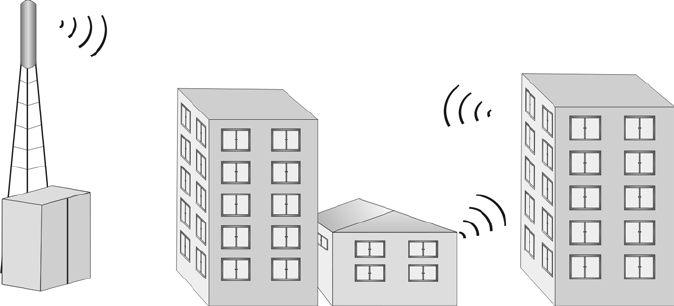
51
Basic Setup Wizard
Gigaset SX686 WiMAX / eng / A31008-N919-R101-2x-7619 / configure_router.fm / 15.10.2008
Schablone 2005_07_27
ìIf necessary, repeat the scan with all possible locations and alignments.
ìIf necessary, ask your provider for the location of the nearest WiMAX network base
station and select a location for your Gigaset SX686 WiMAX that points towards this
base station.
The best results will be obtained if the Gigaset SX686 WiMAX is in sight of a WiMAX net-
work base station.
If a line of sight is not possible, you can reflect the radio waves off neighbouring build-
ings. To do this, direct the Gigaset SX686 WiMAX at the building it is to reflecting off and
not at the WiMAX network base station.
If you are using the outdoor antenna:
ìThe qualified electrician turns the antenna through 20° in the vertical axis. Then the
scan is repeated by clicking on the OK button.
ìIf necessary, the scan should be repeated with all possible antenna alignments.
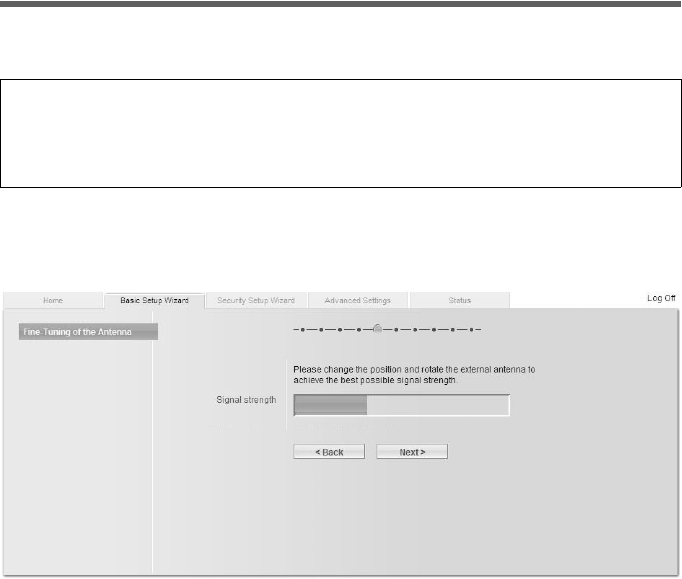
52
Basic Setup Wizard
Gigaset SX686 WiMAX / eng / A31008-N919-R101-2x-7619 / configure_router.fm / 15.10.2008
Schablone 2005_07_27
Antenna fine tuning
Once you have established a wireless connection to a WiMAX network, align your
Gigaset SX686 WiMAX or antenna precisely using the connection wizard.
To obtain precise alignment of the Gigaset SX686 WiMAX or antenna, turn it a little at a
time. If you use the antenna integrated in the Gigaset SX686 WiMAX, you can also move
the device a little at a time to optimise the reception quality.
The quality of the radio connection is represented graphically by a signal strength bar.
The longer the bar is, the better the radio connection. Try to obtain the best possible
radio connection setting.
ìIf you are using the antenna integrated in the Gigaset SX686 WiMAX:
Memorise the current location and alignment of your Gigaset SX686 WiMAX, so that
you can restore it if the connection is broken.
ìTurn or move the Gigaset SX686 WiMAX or turn the antenna a little at a time and
note the signal strength display. Use this to move the antenna to the position with
the best signal strength.
You can also determine the quality of the connection by how many of the 4 LEDs indi-
cating signal strength light up on the device (RSSI 1– RSSI 4). The more LEDs that light
up, the better the connection quality.
If you have turned your Gigaset SX686 WiMAX or the antenna too far, the connection
might break. You should then return to the alignment that provided a connection and
repeat the procedure for establishing a connection to the WiMAX network. Then make
any fine adjustments step by step.
Note
Take extra care to align the Gigaset SX686 WiMAX or outdoor antenna precisely. The
better the connection quality, the faster your Internet connection will be in the
future.
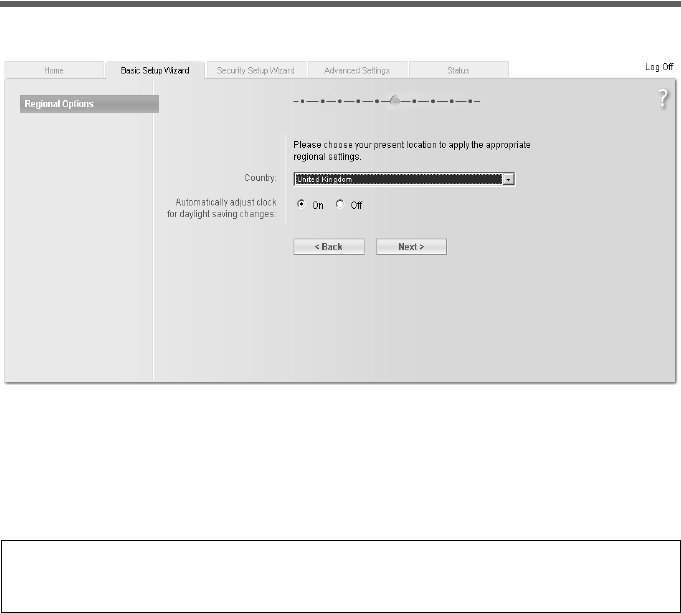
53
Basic Setup Wizard
Gigaset SX686 WiMAX / eng / A31008-N919-R101-2x-7619 / configure_router.fm / 15.10.2008
Schablone 2005_07_27
When your Gigaset SX686 WiMAX or outdoor antenna is optimally aligned:
ìClick Next >.
ìMake sure that in future your Gigaset SX686 WiMAX or outdoor antenna is always
in the set position.
Regional Options
You can select your present location for the regional settings on this screen.
ìSelect the country in which you are currently located from the list. You can set the
time so that it automatically switches to summer time and/or another time zone of
your choice.
ìSelect the required option and/or the time zone for your location.
ìClick Next >.
Note:
The selection of Internet service providers will be set automatically on the following
screens according to the country you choose.
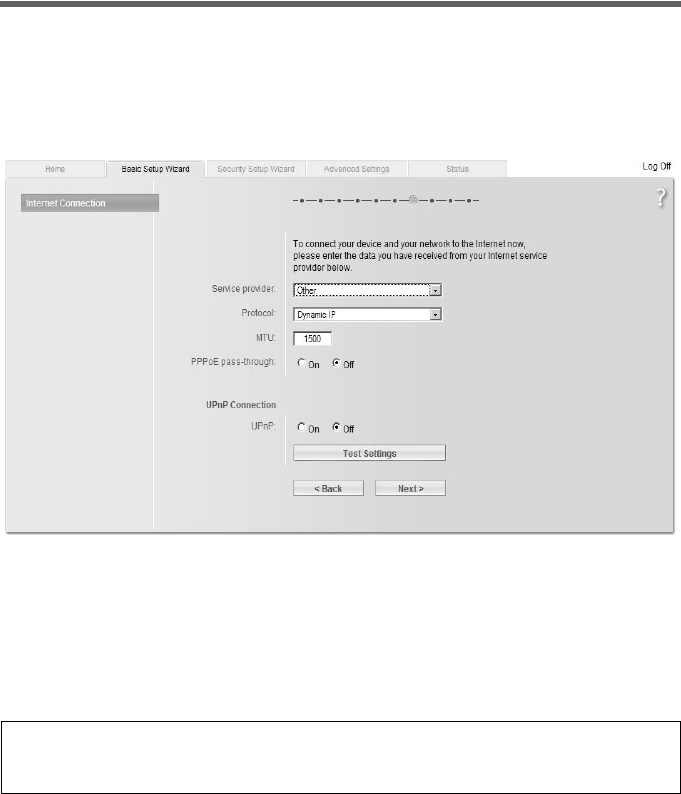
54
Basic Setup Wizard
Gigaset SX686 WiMAX / eng / A31008-N919-R101-2x-7619 / configure_router.fm / 15.10.2008
Schablone 2005_07_27
Configuring Internet connections
You will find the access data you require for configuring the Internet connection in the
documentation you received from your Internet service provider (ISP).
You can perform the initial configuration of your Internet connection on this screen. If
you want to change the data later on, you can do this in the Advanced Settings
(page 70) menu.
ìSelect your Service provider. The selection menu will contain various possible pro-
viders depending on which country you have chosen. If your provider is not listed,
please use the Other option.
ìChoose the Protocol which is used for your Internet connection.
ìLeave the default settings for further parameters unless your service provider has
provided you with other data.
Note:
Connection to the Internet is only possible if you have entered all the data for your
Internet service provider correctly.
55
Basic Setup Wizard
Gigaset SX686 WiMAX / eng / A31008-N919-R101-2x-7619 / configure_router.fm / 15.10.2008
Schablone 2005_07_27
PPPoE pass-through
PPPoE pass-through allows you to use an additional Internet connection (through
another service provider) on one PC.
ìDeactivate PPPoE pass-through if you do not wish to use this function.
Using UPnP (Universal Plug and Play)
PCs with UPnP (Universal Plug & Play) can offer their own network services and automat-
ically use services offered in the network. Further information about this can be found
on page 74.
ìActivate UPnP if you wish to use this function.
Test settings
ìClick Test Settings to check the Internet connection.
An attempt is made to set up an Internet connection. The result is shown in a window.
If the connection could be set up successfully, the Close button appears.
ìClick the Close button to return to the Basic Setup Wizard.
ìTo go to the next step, click Next >.
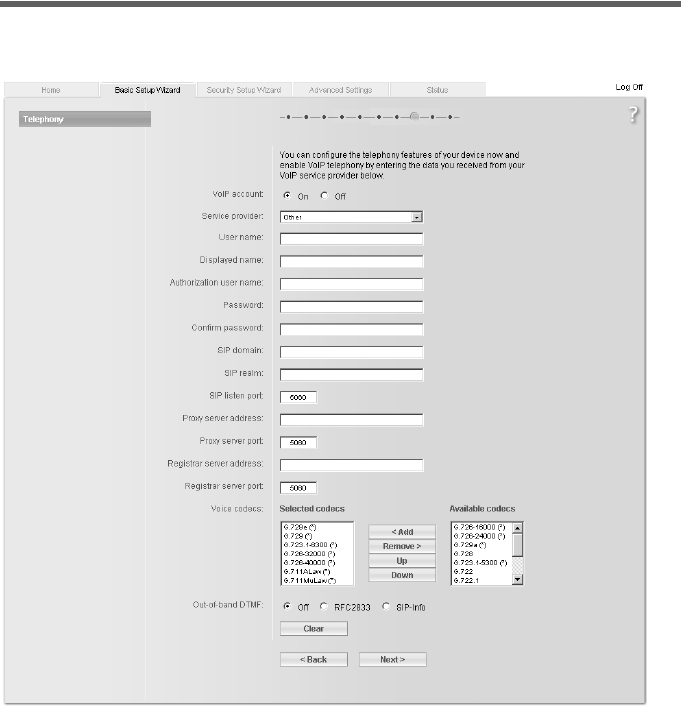
56
Basic Setup Wizard
Gigaset SX686 WiMAX / eng / A31008-N919-R101-2x-7619 / configure_router.fm / 15.10.2008
Schablone 2005_07_27
Telephony
You will find the access data you require for configuring Internet telephony (VoIP) in the
documentation you received from your service provider.
ìSelect the option On for VoIP account if you wish to use Internet telephony (default
setting).
ìSelect Other from the Service provider selection menu (default setting) or, if
required, use one of the suggested providers from the list. Enter the data you have
received from your service provider:
User name, Displayed name, Authorization user name, Password, SIP domain,
SIP realm, Proxy server address and Registrar server address.
ìLeave the default settings for the parameters SIP listen port, Proxy server port,
Registrar server port, Voice codecs and Out-of-band DTMF, unless your service
provider has provided you with other data.
ìIf you wish to delete the entered data, click the Clear button.
ìConfirm your selection with Next >.
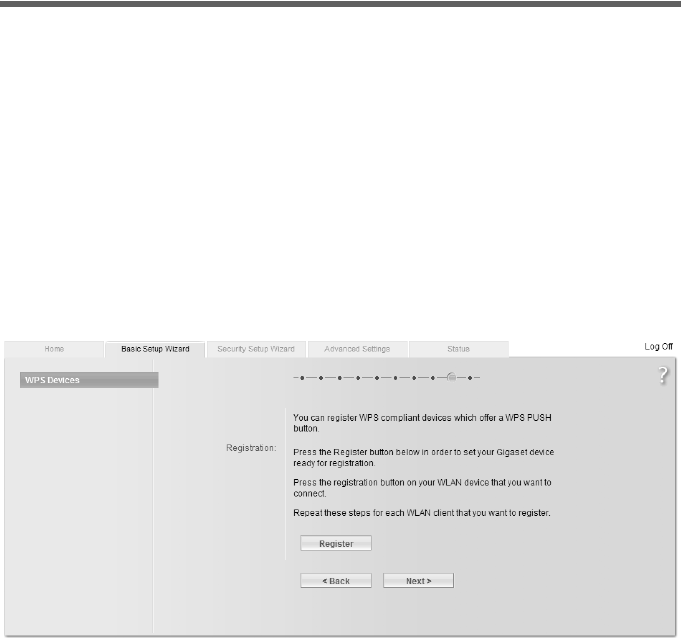
57
Basic Setup Wizard
Gigaset SX686 WiMAX / eng / A31008-N919-R101-2x-7619 / configure_router.fm / 15.10.2008
Schablone 2005_07_27
WPS Registration
Wi-Fi Protected Setup (WPS) makes it easier to establish a wireless network. Devices
equipped with WPS can create and synchronise an SSID and a WPA key (pre-shared key)
automatically. These security data can be created in different ways:
– They are generated automatically on initial WPS registration.
– They have been previously configured manually.
– The device has been delivered with preset security data.
All you need to do to establish a secure wireless connection is
ufor devices with hardware button – to press the registration (or Scan) button on the
access point and on the client or
ufor devices without hardware button – to activate the WPS registration in the user
interface of the access point and the client.
For further information, see "Setting up a wireless network via WPS" on page 26.
ìClick Register to start WPS registration.
Once WPS registration is activated, the device searches for a WPS client within range.
Any WPS client within range that activates the WPS function during the two-minute
interval receives the Gigaset SX686 WiMAX security data (SSID and pre-shared key) and
is thereby registered.
The registration progress is shown in the window.
You can repeat these steps for each WLAN client to be registered.
Only one client may register during the two-minute interval. If two clients try to reg-
sister at the same time, the registration will be broken down and an error message
appears.
ìTo go to the next step, click Next >
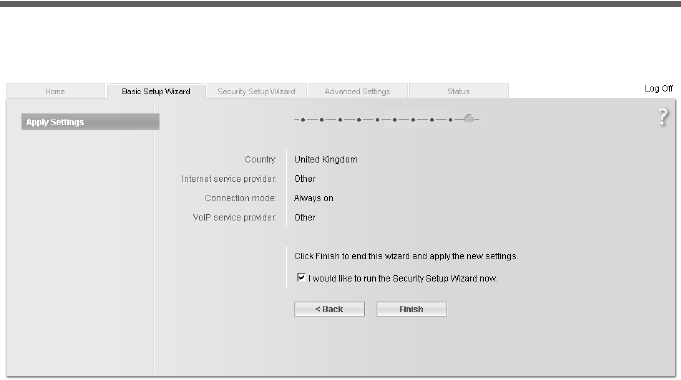
58
Basic Setup Wizard
Gigaset SX686 WiMAX / eng / A31008-N919-R101-2x-7619 / configure_router.fm / 15.10.2008
Schablone 2005_07_27
Summary
The basic settings you have made through the wizard are shown in the next step for you
to check.
ìIf you want to change the settings, click < Back.
ìIf you want to confirm the settings, click Finish to close the Basic Setup Wizard.
The Gigaset SX686 WiMAX is now configured and ready to connect to the Internet. The
Security Setup Wizard then opens automatically. We strongly recommend using the
Security Setup Wizard to protect your Gigaset SX686 WiMAX against attacks. If you want
to carry this out at a later stage, deactivate I would like to run the Security Setup Wiz-
ard now.
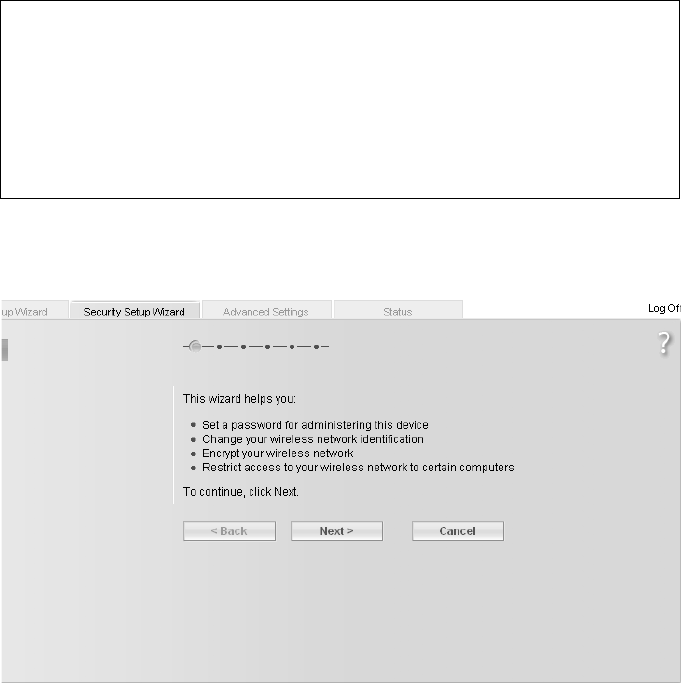
59
Security Setup Wizard
Gigaset SX686 WiMAX / eng / A31008-N919-R101-2x-7619 / configure_router.fm / 15.10.2008
Schablone 2005_07_27
Security Setup Wizard
The Security Setup Wizard offers you additional options for improving your network
security. You can:
uAssign a password for configuring the Gigaset SX686 WiMAX (page 60),
uChange the SSID for your wireless network (page 61),
uSet up the Encryption for the wireless network (page 62),
uLimit access to the wireless network to certain PCs (page 66).
The user interface of the Gigaset SX686 WiMAX guides you step by step through the
security configuration. Once you have completed a screen, click Next >. If you want to
make any changes or check your entries again, click < Back.
ìSelect the Security Setup Wizard option on the start screen or on the tab to start
the security configuration if you did not make the security settings immediately after
setting up the basic settings.
ìClick Next >.
When using WPS please note the following:
Your Gigaset SX686 WiMAX is equipped with WPS (Wi-Fi Protected Setup). You can use
it to set the security of your wireless network easily with one click only (see page 26).
If no manual configuration of security data has been performed before, with the WPS
registration the SSID and pre-shared key (WPA2-PSK/WPA-PSK) are used which are
shown on the device label.
You can also inspect the SSID and the pre-shared key used in the Security Setup Wiz-
ard or in the Advanced Settings, see page 61 and page 91 or page 62 and page 95.
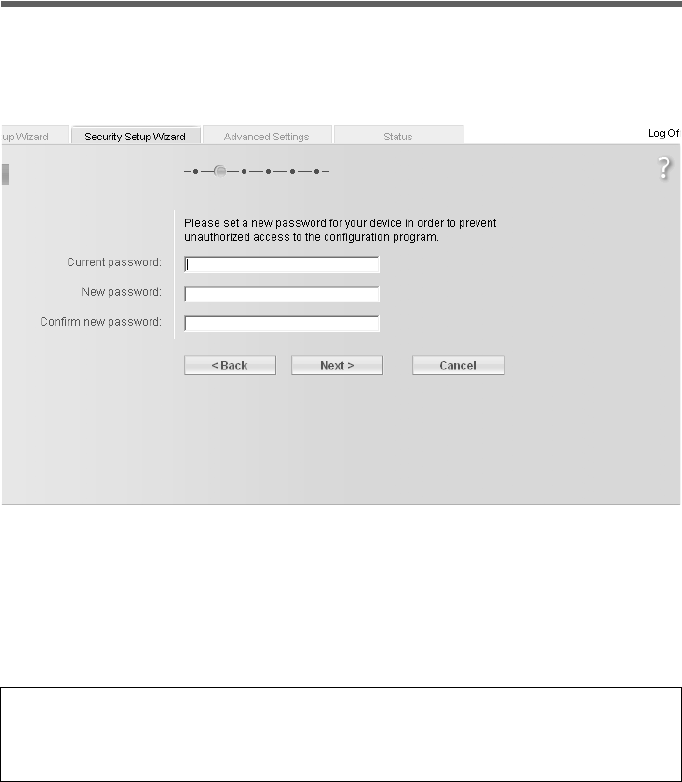
60
Security Setup Wizard
Gigaset SX686 WiMAX / eng / A31008-N919-R101-2x-7619 / configure_router.fm / 15.10.2008
Schablone 2005_07_27
Assigning a password
In the first step of the configuration you can change the password for the user interface.
When the device is supplied, the configuration of your Gigaset SX686 WiMAX is pro-
tected with the admin password. To prevent unauthorised changes to the configura-
tion, you should change the password at regular intervals.
ìEnter the old password in the Current password field.
ìEnter the new password in the New password field and repeat the entry in the
Confirm new password field.
The password may contain up to 20 characters. Note case sensitivity. Avoid proper
names and all too obvious words. Use a combination of letters, digits and special
characters.
ìTo go to the next step, click Next >
Note:
If you ever forget your password you will have to return the Gigaset SX686 WiMAX to
its factory settings (page 134). Please bear in mind that this will restore all settings to
the factory configuration. The password will again be admin.
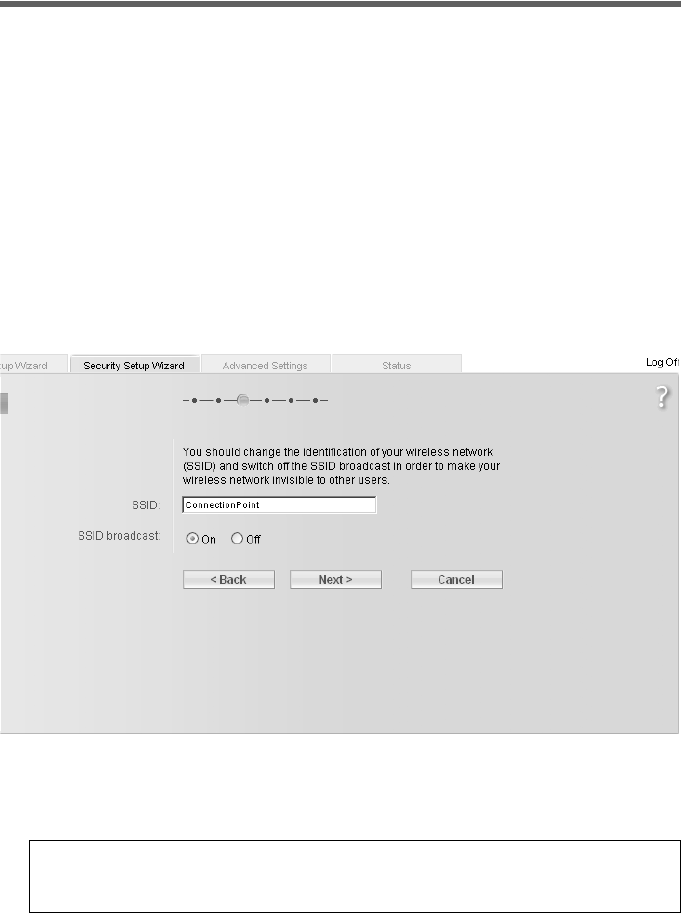
61
Security Setup Wizard
Gigaset SX686 WiMAX / eng / A31008-N919-R101-2x-7619 / configure_router.fm / 15.10.2008
Schablone 2005_07_27
Changing the SSID
For the wireless network components to be able to communicate with one another, you
must use the same SSID (Service Set Identifier).
The Gigaset SX686 WiMAX is delivered with a preset SSID. You will find it at the label on
the bottom of the device. This can be a default SSID, e.g. ConnectionPoint, or a SSID
which is individually set for each device in the format SX686-XXXXXX, where XXXXXX
is a string consisting of 0-9 and A-F, e.g. SX686-EB691A.
For security reasons you can change this SSID and deactivate SSID broadcast. If this
option is enabled, your wireless network will be visible for other wireless network users.
In this case, unauthorised persons could use the SSID to gain access to your network.
If you have performed a successful WPS registration before a manual configuration of
security data, this screen shows the generated SSID. Make a note of this SSID. You will
need it to manually configure the wireless network adapters that do not support WPS.
ìIf you are using WPS registration, click on Next >.
ìEnter a character string of your choice in the SSID field. The SSID is case-sensitive. It
can contain up to 32 characters. Use a combination of letters, digits and special char-
acters.
ìDeactivate SSID broadcast and make a note of the SSID. You will need for further
wireless connections to the Gigaset SX686 WiMAX.
ìClick Next >.
Note:
The connection to the wireless network adapters will be interrupted until the new
SSID has also been entered.
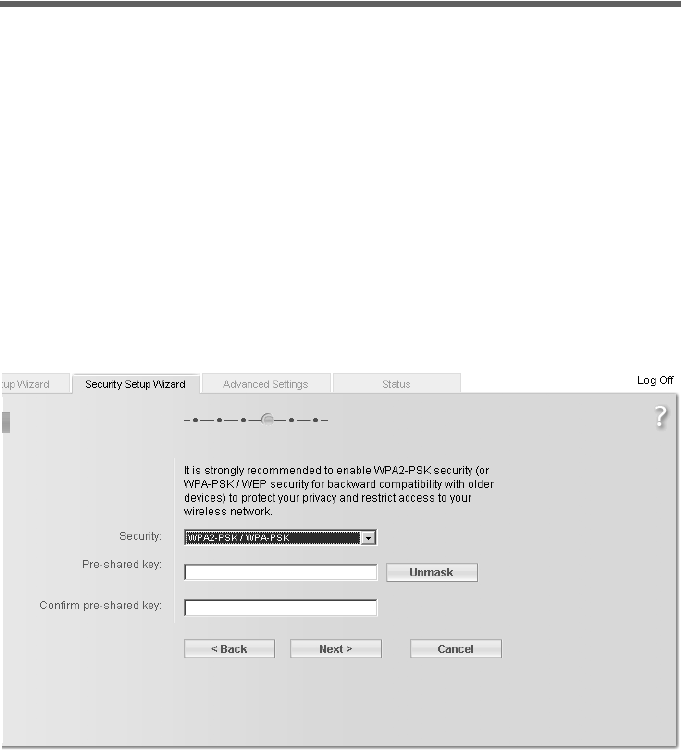
62
Security Setup Wizard
Gigaset SX686 WiMAX / eng / A31008-N919-R101-2x-7619 / configure_router.fm / 15.10.2008
Schablone 2005_07_27
Setting up security functions for the wireless network
Wireless networks are even more susceptible to eavesdropping than wired networks.
With conventional network adapters, an intruder only needs a device with a WLAN
adapter (e.g. a notebook or a PDA [Personal Digital Assistant]) with an appropriately
configured network card in order to eavesdrop on every communication made via a
nearby wireless LAN.
The Gigaset SX686 WiMAX makes use of effective encryption methods to prevent unau-
thorised eavesdropping as far as possible.
The Gigaset SX686 WiMAX is delivered with preset individual encryption (WPA2-PSK/
WPA-PSK with pre-shared key). You will find this key at the label on the bottom of the
device.
If all components of your wireless network provide this encryption method there is no
need of any settings in this screen. If not, or if you want to change the preset key (e. g.
if unauthorised persons may have access to your device), you can configure the encryp-
tion for your wireless network in the next step.
You can use the following security mechanisms:
uWPA2-PSK, WPA-PSK or WPA2-PSK/WPA-PSK (page 63)
uWEP encryption (Wired Equivalent Privacy, see page 64)
You will find further options for setting up data encryption and authentication in the
Advanced Settings menu (page 94).
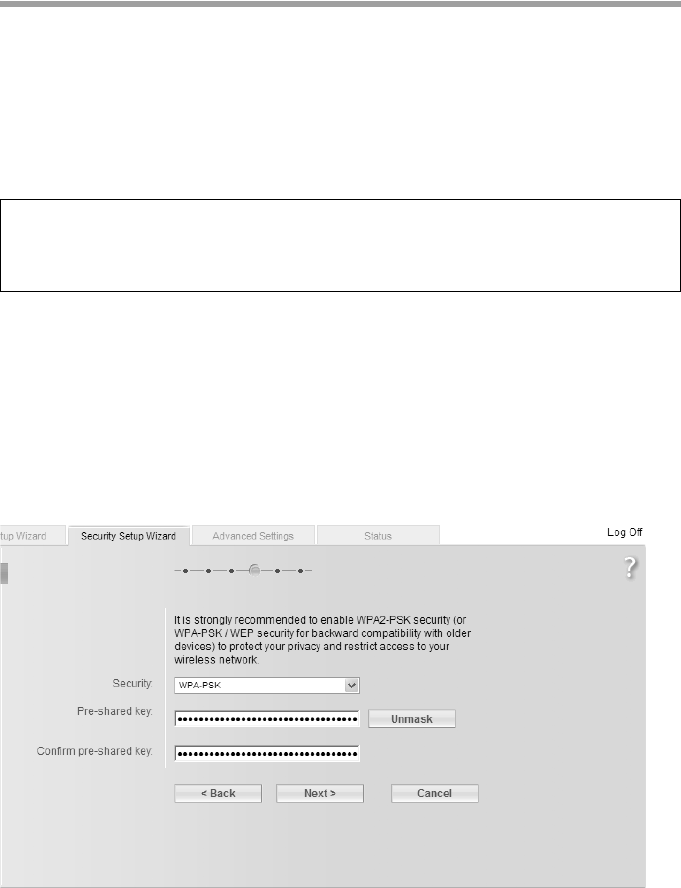
63
Security Setup Wizard
Gigaset SX686 WiMAX / eng / A31008-N919-R101-2x-7619 / configure_router.fm / 15.10.2008
Schablone 2005_07_27
WPA2/WPA with pre-shared key (PSK)
WPA is a more advanced procedure than WEP for protecting wireless networks. Dynamic
keys, based on TKIP (Temporal Key Integrity Protocol), offer increased security. The new
standard WPA2 uses AES (Advanced Encryption Standard) for encryption.
WPA-PSK is a special WPA mode for private users and users in small companies without
their own authentication server. After a certain period of time (Rekey interval), encryp-
tion keys are automatically generated with the pre-shared key, automatically changed
("rekeying") and authenticated between the devices.
This screen shows the preset encryption settings.
ìIf you do not want to change the encryption settings, click on Next >.
If you want to change the pre-shared key:
ìSelect WPA2-PSK if WPA2 is supported by all components in the wireless network.
ìSelect WPA-PSK only if WPA is supported by all components in the wireless network.
ìSelect WPA2-PSK / WPA-PSK if only some components in the wireless network sup-
port WPA.
ìEnter a key of your choice in the Pre-shared key field (min. 8 to max. 63 characters
or hexadecimal characters [0-9, A-F]) and confirm it by repeating the entry. You
must set up the same pre-shared key for all wirelessly connected PCs. Use a combi-
nation of letters, digits and special characters.
Note:
Every PC (network adapter) that requires access to a WPA-protected wireless network
must also support WPA. Information about this can be found in the operating manual
for your network adapter.
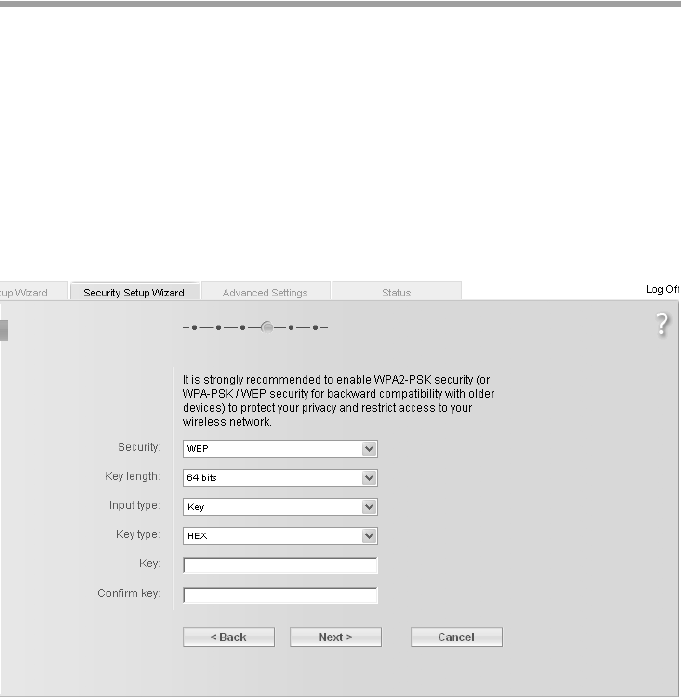
64
Security Setup Wizard
Gigaset SX686 WiMAX / eng / A31008-N919-R101-2x-7619 / configure_router.fm / 15.10.2008
Schablone 2005_07_27
ìBy clicking the Unmask button, a message showing the pre-shared key is output in
readable characters.
ìTo go to the next step, click Next >
WEP encryption
WEP (Wired Equivalent Privacy) is an encryption for radio signals in wireless networks
and meets the IEEE 802.11 standard.
If you transmit data wirelessly and not all components in your wireless network support
the higher security standard WPA (page 63), we recommend that you activate WEP
Encryption.
WEP encryption and WPS registration cannot be used together in a wireless network.
You can choose either the standard 64-bit key or the more robust 128-bit key. The keys
are generated in hexadecimal or in ASCII format. You must use the same keys for encryp-
tion and decryption for the Gigaset SX686 WiMAX and all your wireless network
adapters.
ìSelect the Key length: 64 bits or 128 bits.
ìSelect the Input type, i.e. whether the key is to be entered manually or generated
automatically by means of a Passphrase.
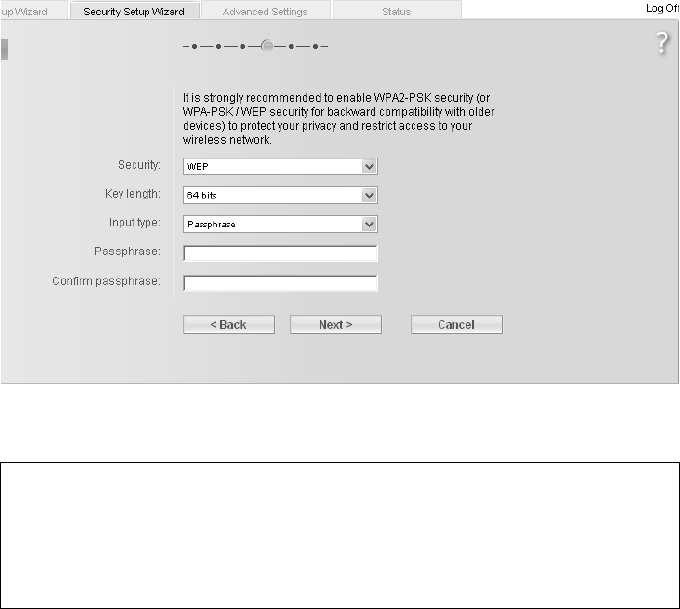
65
Security Setup Wizard
Gigaset SX686 WiMAX / eng / A31008-N919-R101-2x-7619 / configure_router.fm / 15.10.2008
Schablone 2005_07_27
Manual key entry
ìSelect the Key type, Hex or ASCII.
If you select Hex as the key type you can use the characters 0 to 9 and A to F.
– With a 64-bit encryption depth, the key is 10 characters long.
– With a 128-bit encryption depth, the key is 26 characters long.
If you select ASCII as the key type, you can use the characters 0 to 9, A to Z, a to z
plus the special characters in the ASCII character set.
– With a 64-bit encryption depth, the key is 5 characters long.
– With a 128-bit encryption depth, the key is 13 characters long.
ìConfirm the key by entering it again in the Confirm key field.
Generating a key by means of a Passphrase
ìEnter a Passphrase (up to 32 characters) and confirm it by entering it again. The key
is generated automatically.
ìTo go to the next step, click Next >
Note:
uIt is very important that you make a note of the key or passphrase. You will need
this information to configure the wireless network adapters properly.
uYou have to change the WEP encryption in the wireless network adapters for the
connected PCs in the same way, otherwise they will not be given access to the
Gigaset SX686 WiMAX wireless network.
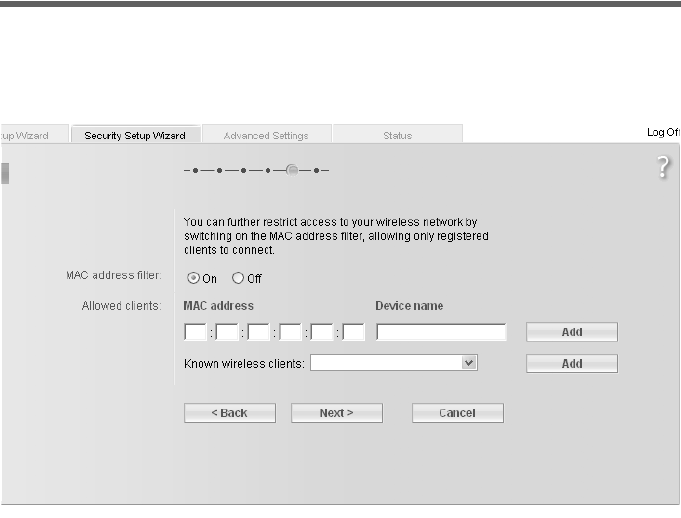
66
Security Setup Wizard
Gigaset SX686 WiMAX / eng / A31008-N919-R101-2x-7619 / configure_router.fm / 15.10.2008
Schablone 2005_07_27
Access control within the wireless network
In this step you can specify which PCs will have wireless access to the Gigaset SX686
WiMAX and hence to the LAN. Access control is based on the MAC address of the PC net-
work adapters. You can enter the MAC addresses for the PCs manually or select these
from the list of PCs that are currently logged in.
Access control is disabled by default. This means that all PCs that use the correct SSID
can be logged in.
ìNext to the MAC address filter, select On to activate the MAC filter.
Entering MAC addresses manually
ìEnter the MAC address of the network adapter. You will find this address on the
underside of the device.
ìEnter the name of the PC.
ìClick the Add button to add the entry to the list.
Selecting from the list of logged-in PCs
ìSelect the required PC from the Known wireless clients list. All PCs that were
already entered manually on the router with the MAC address are displayed.
ìClick the Add button to add the selected PC to the list.

67
Security Setup Wizard
Gigaset SX686 WiMAX / eng / A31008-N919-R101-2x-7619 / configure_router.fm / 15.10.2008
Schablone 2005_07_27
ìTo go to the next step, click Next >
Note:
If you activate MAC access control, you must at least add the PC on which you are con-
figuring the Gigaset SX686 WiMAX to the list. Otherwise, you will have no access to
the user interface and will receive an appropriate error message.
WPS registration is only possible for PCs in the list if you have activated MAC access
control.
If you have inadvertently denied all PCs access to the Gigaset SX686 WiMAX, you have
two options:
uYou can completely reset the Gigaset SX686 WiMAX (page 16).
uYou can connect a PC to the Gigaset SX686 WiMAX using one of the LAN connec-
tions (by cable). As MAC access control only affects PCs that are connected wire-
lessly, you can use this PC to change the configuration.
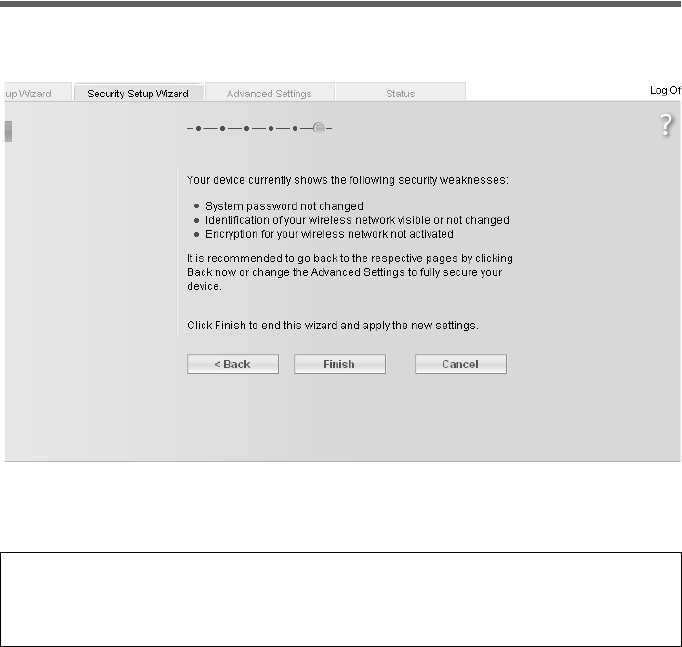
68
Security Setup Wizard
Gigaset SX686 WiMAX / eng / A31008-N919-R101-2x-7619 / configure_router.fm / 15.10.2008
Schablone 2005_07_27
Saving settings
On the next screen you end the wizard and save the settings. You will be informed of
any security risks that still exist.
ìClick Finish to end the wizard.
The settings will now be activated on the Gigaset SX686 WiMAX.
Note:
If you have changed the encryption setting, you must now configure the WEP or WPA
key for the wireless network adapter of the PC that has been configured with other
values. After this you can again wirelessly log on to the Gigaset SX686 WiMAX.

69
Configuring Advanced Settings
Gigaset SX686 WiMAX / eng / A31008-N919-R101-2x-7619 / configure_router.fm / 15.10.2008
Schablone 2005_07_27
Configuring Advanced Settings
In the Advanced Settings menu, you can configure all the options for the Gigaset
SX686 WiMAX. If required, you can also change the settings you made using the wizard.
The following table contains the options available in this menu.
Menu Description
Internet This menu comprises all the setting options relating to the
Internet. In particular, you can do the following:
uCheck and change the configuration for Internet access
(page 72) or specify a preferred DNS server (page 75),
uConfigure the firewall, i.e. a number of security and special
functions (page 76),
uMake the NAT settings required to provide your own serv-
ices on the Internet (page 80),
uSet up dynamic DNS for a fixed Internet address on the
device (page 85),
uSet up routing for your Internet connection services
(page 87).
Local Network You can change the Private IP address of the Gigaset SX686
WiMAX here and make settings on the DHCP server (page 88).
Wireless Network You can configure the options for wireless communication
(SSID and encryption) here and restrict access to the Gigaset
SX686 WiMAX (page 91).
Telephony You can make the settings for Internet telephony (VoIP) here
and configure your extensions (page 105).
USB You can make the settings here for operating an external data
carrier, a Web server, a file server or a print server on the USB
port (page 116).
Administration You can make or change various system settings here, for
example change the password (page 131) or set the time
(page 130). In addition, you can also back up the data on the
Gigaset SX686 WiMAX (page 133).

70
Configuring Advanced Settings
Gigaset SX686 WiMAX / eng / A31008-N919-R101-2x-7619 / configure_router.fm / 15.10.2008
Schablone 2005_07_27
Internet
If you have configured the Gigaset SX686 WiMAX using the two wizards, you have also
configured the WAN connection (Internet access). You can check or change these set-
tings in the Internet menu.
This menu also offers you a wide range of possibilities for setting up security settings
and limiting access to the Internet as well as for providing your own services on the
Internet.
You can carry out the following via the Internet menu:
Internet Activate/deactivate the Internet connection and edit the
virtual connection parameters (for further information see
below),
Internet Connection Check and edit the Internet connection of the Gigaset SX686
WiMAX (for further information see below),
DNS Servers Make DNS server settings (page 75),
Firewall Protect the network against unauthorised external access
(see page 76),
Address Translation
(NAT)
Provide your own services on the Internet (NAT, see
page 80),
Dynamic DNS Set up dynamic DNS (page 85),
Routing Set up routing for your Internet connection services
(page 87).
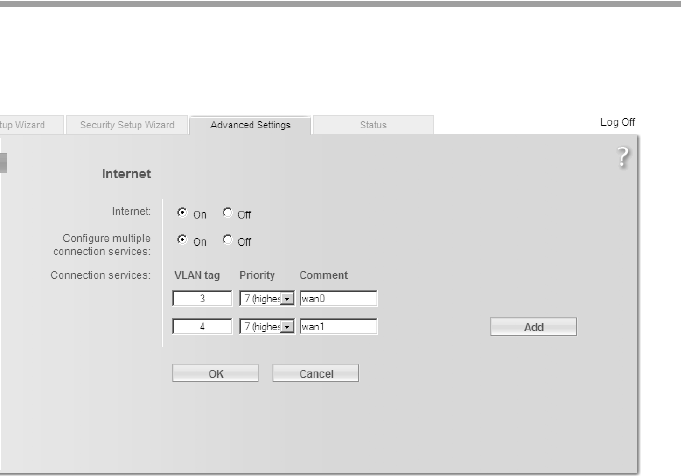
71
Configuring Advanced Settings
Gigaset SX686 WiMAX / eng / A31008-N919-R101-2x-7619 / configure_router.fm / 15.10.2008
Schablone 2005_07_27
Internet selection
On this screen you can activate or deactivate the Internet connection for the Gigaset
SX686 WiMAX and you can set up a number of connection services.
ìIn the Advanced Settings menu, select: Internet
ìSelect the appropriate option to activate or deactivate the Internet function of the
Gigaset SX686 WiMAX.
Configure multiple connection services
Your Internet service provider can permit you to set up a number of Connection serv-
ices. You can set up these services here. You can configure rules for using these services
under the Routing option (page 87).
ìSelect the appropriate option to activate or deactivate Configure multiple connec-
tion services.
ìIn the VLAN tag field enter a number to be used as VLAN tag for the connection
service. Your Gigaset SX686 WiMAX supports VLANs (Virtual Local Area Network)
according to the IEEE 802.1 Q standard. The VLAN tag thereby indicates in all incom-
ing and outgoing data packets the VLAN (connection service) to which the data
packet belongs. Value range: 0 - 4096.
ìFrom the Priority option menu, select a priority level (0-7) for the connection serv-
ice. You can, for example, assign a higher priority to a connection service which is
used for voice transmission (VoIP) than to a connection service which is used for
Internet surfing. You thus increase the voice quality of your Internet telephony.
ìEnter a description of the connection service in the text field
ìClick on Add to set up the connection service.
ìTo remove a connection service from the list, click on Delete.
ìClick OK to save and apply the changes.
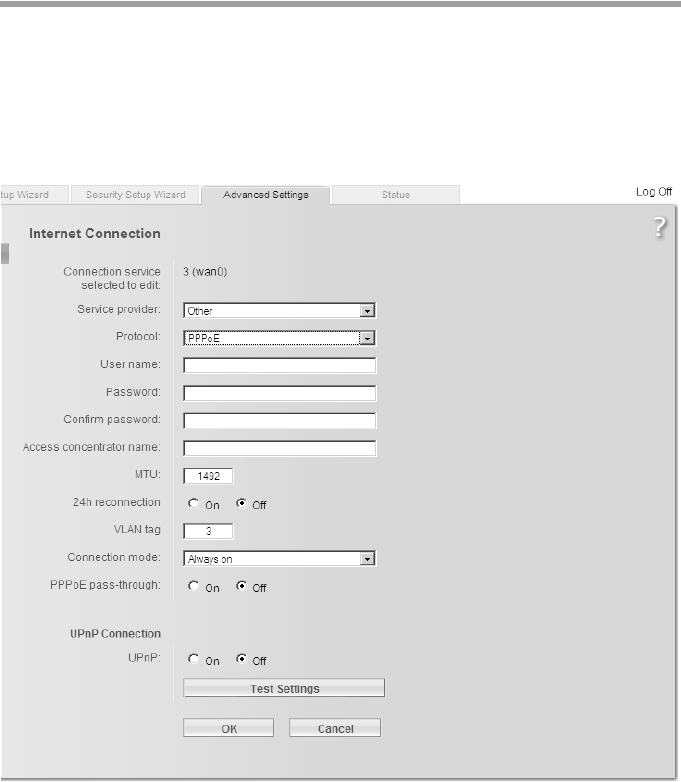
72
Configuring Advanced Settings
Gigaset SX686 WiMAX / eng / A31008-N919-R101-2x-7619 / configure_router.fm / 15.10.2008
Schablone 2005_07_27
Internet Connection
You can set up or change the configuration of your Internet connection on this screen.
All the settings you make here must coincide with the features your Internet service pro-
vider makes available to you. False information can lead to problems with your Internet
connection.
ìIf you want to configure or modify settings for the Internet connection, select from
the Advanced Settings menu: Internet – Internet Connection
All settings apply for the displayed connection service that you selected for editing on
the Advanced Settings – Internet (page 71) screen.
ìSelect your Service provider. Depending on the country you selected when making
the basic settings (page 53), the selection menu contains various possible providers.
If your provider is not listed, please use the Other option.
ìEnter the data you have been given by your service provider: Protocol, User name,
Password.
Only if you have selected PPPoE as the protocol and if you want to set up a number of
connection services with this protocol:

73
Configuring Advanced Settings
Gigaset SX686 WiMAX / eng / A31008-N919-R101-2x-7619 / configure_router.fm / 15.10.2008
Schablone 2005_07_27
ìEnter the name of the connection given to you by your service provider in the
Access concentrator name field.
ìApply the default settings for the other parameters unless your service provider has
provided you with other data. The default settings also depend on your choice of
country.
ìYour Internet service provider may disconnect and reconnect your Internet connec-
tion daily. In this case enable 24h reconnection and choose the period of time in
which the reconnection should be performed from the Reconnection time option
menu.
ìIn the VLAN tag field, enter a number to be used as VLAN tag for the connection
service. Your Gigaset SX686 WiMAX supports VLANs (Virtual Local Area Network)
according to the IEEE 802.1 Q standard. The VLAN tag thereby indicates in all incom-
ing and outgoing data packets the VLAN (connection service) to which the data
packet belongs. Value range: 0 - 4096.
ìSpecify how Internet sessions are to be established via Connection mode:
–Select Always on if the connection is to exist at all times when the Gigaset SX686
WiMAX is turned on.
–Select Connect on demand if applications such as an Internet browser or an e-
mail program are to connect to the Internet automatically.
–In the Idle time before disconnect field, enter a period after which the Internet
connection is to end automatically if no data is transmitted (the default setting is
3minutes).
This time setting only applies to the Connect on demand and Connect manu-
ally options.
–Select Connect manually if you always want to establish and end the Internet
connection manually. If you are on a time-based tariff this will save you high con-
nection charges.
PPPoE pass-through
If you activate the PPPoE pass-through function, a PC in the network can connect to the
Internet via its own connection ID. The router puts this connection through.
ìIn the Advanced Settings menu, select: Internet – Internet Connection
Note:
To configure the Internet connection successfully, you must enter the details
given by your provider in all fields.
Notes:
uYou must set up the Always on option if you wish to use Internet telephony.
Otherwise you can only use fixed network telephony via the Gigaset SX686
WiMAX.
uIf you are on a time-based tariff, this option can result in high connection
charges.

74
Configuring Advanced Settings
Gigaset SX686 WiMAX / eng / A31008-N919-R101-2x-7619 / configure_router.fm / 15.10.2008
Schablone 2005_07_27
ìSelect On to activate PPPoE pass-through and click OK to apply the settings.
Using UPnP (Universal Plug and Play)
PCs with UPnP (Universal Plug & Play) can offer their own network services and automat-
ically use services offered in the network.
As soon as you have installed UPnP on a PC operating system and activated it on the
router, applications on this PC (e.g. Microsoft Messenger) can communicate via the
Internet without you needing to expressly authorise it. In this case, the router automat-
ically implements port forwarding (Port forwarding, see page 83), thereby facilitating
communication via the Internet.
The task bar on the PC on which UPnP is installed contains an icon for the Gigaset SX686
WiMAX. Click this icon to open the user interface. On Windows XP system, this icon is
also shown under network connections.
ìIn the Advanced Settings menu, select: Internet – Internet Connection
ìClick UPnP.
Test settings
ìClick Test Settings to check the settings.
An attempt is made to set up an Internet connection. The result is shown in a separate
window.
ìClick the Close button, which is shown if the test was successful.
ìClick OK to apply the settings.
Note:
The operating system Windows ME, Windows XP or Windows Vista must run on the
PC. Check, if the UPnP function has been installed on the PCs operating system. Maybe
you have to install the UPnP components retroactively. Please consult the operating
instructions of your PC.
Note:
When the UPnP function is active, system applications can assign and use Ports on a
PC. This poses a security risk.
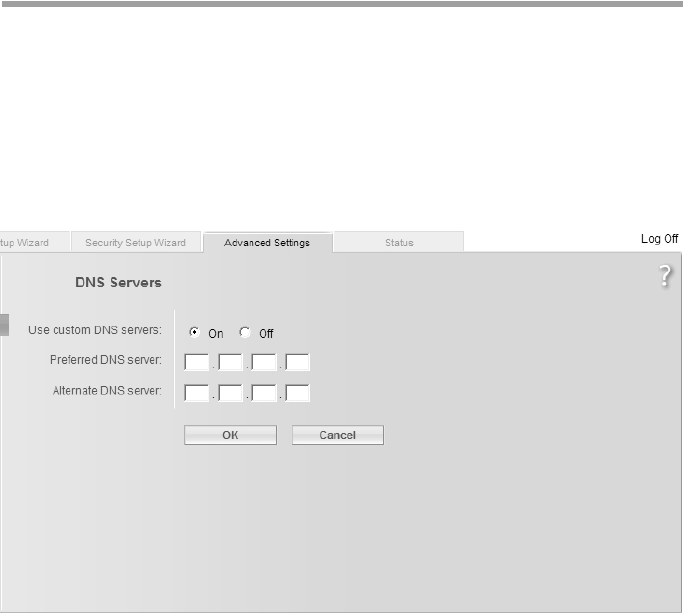
75
Configuring Advanced Settings
Gigaset SX686 WiMAX / eng / A31008-N919-R101-2x-7619 / configure_router.fm / 15.10.2008
Schablone 2005_07_27
DNS server
DNS is a decentralised service that assigns PC names or Internet addresses (Domain
names) and IP addresses to one another. A DNS server has to administer this information
for each server or each LAN with an Internet connection.
Your Internet service provider will usually provide you with a DNS server that makes this
assignment when an Internet connection is set up. If necessary, you can define the DNS
server such that it is used manually for the Internet connections.
ìIn the Advanced Settings menu, select: Internet – Internet Connection –
DNS Servers
All settings apply for the displayed connection service that you selected for editing on
the Advanced Settings – Internet (page 71) screen.
ìActivate the Use custom DNS servers function by selecting On.
ìEnter the IP addresses for your preferred DNS servers (Preferred DNS server and
Alternate DNS server).
ìClick OK to apply the settings.
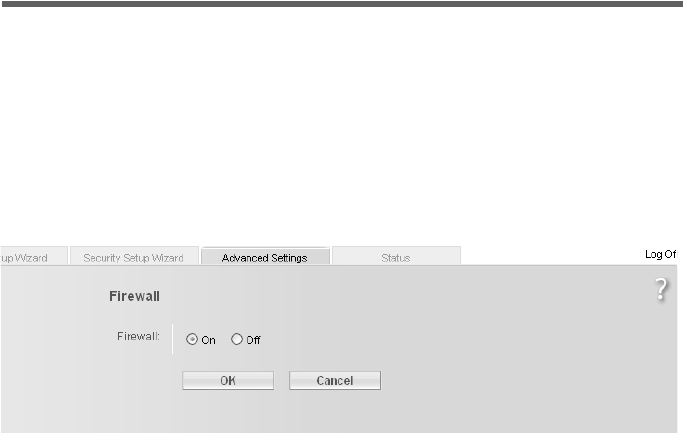
76
Configuring Advanced Settings
Gigaset SX686 WiMAX / eng / A31008-N919-R101-2x-7619 / configure_router.fm / 15.10.2008
Schablone 2005_07_27
Firewall
The firewall functions of the Gigaset SX686 WiMAX include various security functions
for the local network.
You can carry out the following:
uProtect the network against hacker attacks (for information see below),
uBlock access by individual PCs to selected services (page 78).
The firewall functions for the Gigaset SX686 WiMAX are activated and configured in the
factory. If you want to deactivate the firewall, carry out the following steps:
ìIn the Advanced Settings menu, select: Internet – Firewall
ìClick the required option.
ìClick OK to apply the settings.
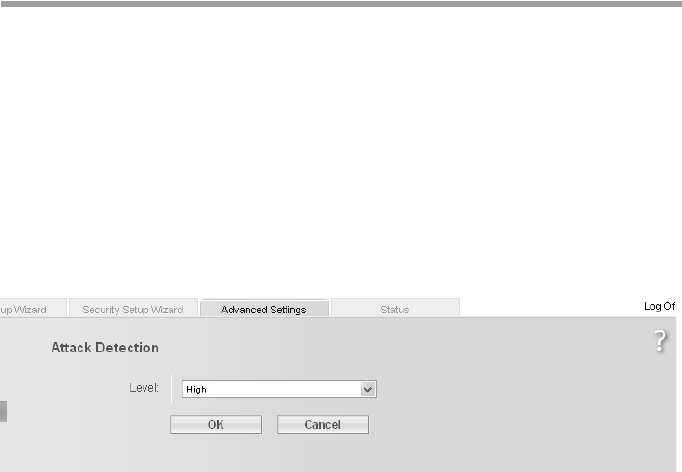
77
Configuring Advanced Settings
Gigaset SX686 WiMAX / eng / A31008-N919-R101-2x-7619 / configure_router.fm / 15.10.2008
Schablone 2005_07_27
Attack Detection
If the firewall functions of the Gigaset SX686 WiMAX are activated, the device monitors
and limits access to incoming data traffic via the WiMAX connection with a function
called "Stateful Packet Inspection" (SPI). This allows the Gigaset SX686 WiMAX to detect
and prevent certain types of attack from the Internet, such as Denial-of-Service (DoS).
DoS attacks are aimed at devices and networks with Internet connections. The aim is not
so much to steal data as to paralyse the computer or network to such an extent that the
network resources are no longer available. A typical hacker attack involves, for example,
a remote computer acting in place of the paralysed device and receiving the data
intended for the device.
You can use the Attack Detection function to change the standard firewall settings.
ìIn the Advanced Settings menu, select: Internet – Firewall – Attack Detection
ìSelect the security level for the firewall:
–The Medium default level offers high security and hardly limits functionality of
certain applications.
–The High level offers maximum security and may limit functionality for certain
applications.
–The Low level offers maximum functionality but may provide low security.
ìClick OK to apply the settings.
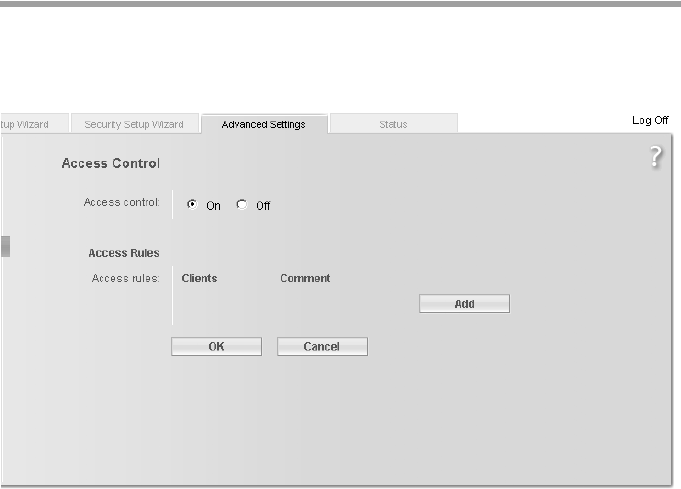
78
Configuring Advanced Settings
Gigaset SX686 WiMAX / eng / A31008-N919-R101-2x-7619 / configure_router.fm / 15.10.2008
Schablone 2005_07_27
Setting up access control to the Internet
The Access Control function allows you to block access to various services for one or
more PCs. You can permit or block access to services at certain times.
ìIn the Advanced Settings menu, select: Internet – Firewall – Access Control
ìActivate the Access Control function by selecting On.
You have the following setting options for Access Control:
Access Rules
You can limit access to the Internet for all clients, or only for certain clients in the net-
work, thereby allowing or blocking access to services.
ìClick Add to create an access rule.
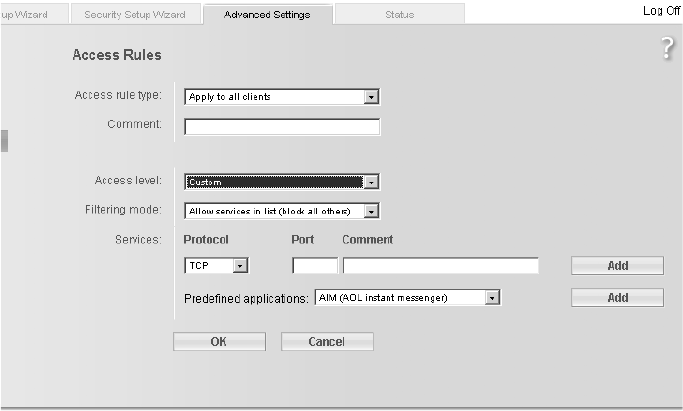
79
Configuring Advanced Settings
Gigaset SX686 WiMAX / eng / A31008-N919-R101-2x-7619 / configure_router.fm / 15.10.2008
Schablone 2005_07_27
ìSelect the Access rule type from the list:
–Apply to all clients: The rule applies to all PCs in the network.
–Specify IP address range: Sie wählen die PCs aus, auf die die Regel angewendet
werden soll, indem Sie einen IP-Adressbereich eingeben.
–Specify IP address or Specify MAC address: The rule applies to a PC you have
selected via the IP address or MAC address.
ìEnter a name for the Comment for the access rule.
ìDefine the Access level.
You can choose Deny access to the Internet or Allow web browsing. If you select
Custom, you can make the following settings:
ìIf you wish to create a Service filter, choose one of the following options.
–In Filtering mode, specify whether the selected services are to be allowed or
blocked.
– Select the Services that are to be allowed or blocked.
Select the Protocol and enter the appropriate Port (a single port number,
several port numbers separated by commas, port blocks consisting of two port
numbers separated by a dash, or any combination of these, for example 80,90-
140,180. The Description that is displayed helps you to identify different serv-
ices.
– You can also select services from the Predefined applications list.
– Click Add to create a new entry with the entered data or for the selected, prede-
fined application.
– Click Delete to delete an entry.
ìClick OK to apply the settings.

80
Configuring Advanced Settings
Gigaset SX686 WiMAX / eng / A31008-N919-R101-2x-7619 / configure_router.fm / 15.10.2008
Schablone 2005_07_27
Setting up the NAT function
The Gigaset SX686 WiMAX comes equipped with the NAT (Network Address Translation)
function. With address mapping, several users in the local network can access the Inter-
net via one or more public IP addresses. All the local IP addresses are assigned to the
router's public IP address by default.
One of the characteristics of NAT is that data from the Internet is not allowed into the
local network unless it has been explicitly requested by one of the PCs in the network.
Most Internet applications can run behind the NAT firewall without any problems. For
example, if you request Internet pages or send and receive e-mails, the request for data
from the Internet comes from a PC in the local network, and so the router allows the
data through. The router opens precisely one port for the application. A port in this con-
text is an internal PC address, via which the data is exchanged between the Internet and
a client on a PC in the local network. Communicating via a port is subject to the rules of
a particular protocol (TCP or UDP).
If an external application tries to send a call to a PC in the local network, the router will
block it. There is no open port via which the data could enter the local network.
Some applications, such as games on the Internet, require several ports so that the play-
ers can communicate with each other. In addition, these applications must also be per-
mitted to send requests from other users on the Internet to users in the local network.
These applications cannot work if Network Address Translation (NAT) has been acti-
vated.
Using port forwarding (the forwarding of requests to particular ports) the router is
forced to send requests from the Internet for a certain service, for example a game, to
the appropriate port(s) on the PC on which the game is running.
Port triggering is a special variant of port forwarding. Unlike port forwarding, the
Gigaset SX686 WiMAX forwards the data from the port block to the PC which has previ-
ously sent data to the Internet via a certain port (trigger port). This means that approval
for the data transfer is not tied to one specific PC in the network, rather to the port num-
bers of the required Internet service.
Where configuration is concerned, this means:
uYou have to define a so-called trigger port for the application and also the protocol
(TCP or UDP) that this port uses. You then assign the public ports that are to be
opened for the application to this trigger port.
uThe router checks all outgoing data for the port number and protocol. If it identifies
a match of port and protocol for a defined trigger port, then it will open the assigned
public ports and notes the IP address of the PC that sent the data. If data comes back
from the Internet via one of these public ports, the router allows it through and
directs it to the appropriate PC. A trigger event always comes from a PC within the
local network. If a trigger port is addressed from outside, the router simply ignores it.
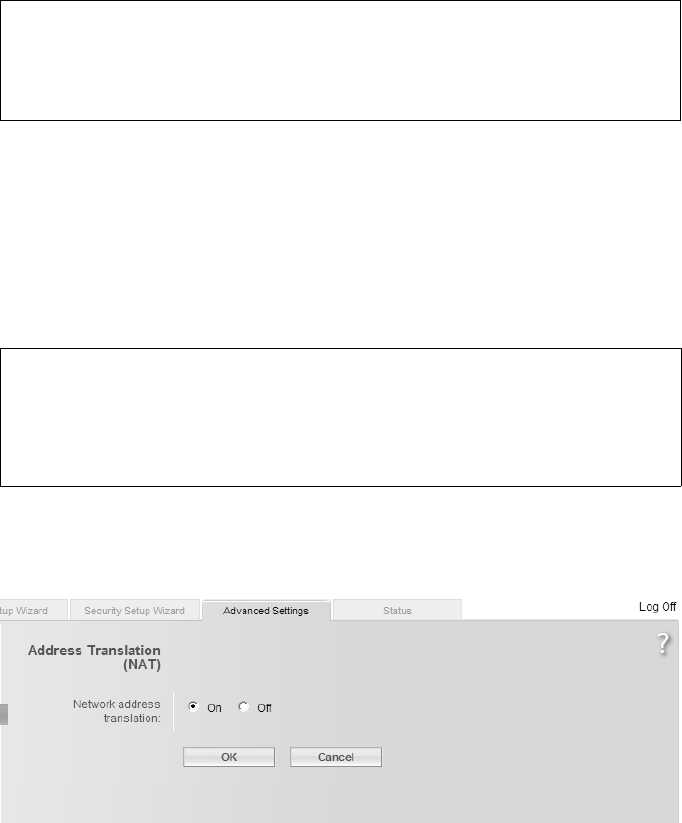
81
Configuring Advanced Settings
Gigaset SX686 WiMAX / eng / A31008-N919-R101-2x-7619 / configure_router.fm / 15.10.2008
Schablone 2005_07_27
When the Gigaset SX686 WiMAX is supplied, the NAT function (Network Address Trans-
lation) is activated, i.e. all IP addresses of PCs in the local network are converted to the
router's public IP address when accessing the Internet.
You can use the NAT settings to configure the Gigaset SX686 WiMAX to carry out the
following tasks:
uSet up the Gigaset SX686 WiMAX as a virtual server by configuring Port Forwarding
(page 83),
uOpen the firewall for a selected PC (page 84).
By default the NAT function is activated. You should only deactivate the NAT function if
you want to configure you own firewall in you local network.
ìIn the Advanced Settings menu, select: Internet – Address Translation (NAT)
ìSelect the required option.
ìClick OK to apply the settings.
Note:
uAn application that is configured for port triggering can only be run by one user in
the local network at a time.
uAs long as the public ports are open, they can be used by unauthorised persons to
gain access to a PC in the local network.
Note:
For the functions described below, the IP addresses of the PCs must remain
unchanged. If the IP addresses of the PCs are assigned via the DHCP server of the
Gigaset SX686 WiMAX, you must select Never expires (page 89) as the setting in the
Local Network menu entry for the Lease time or assign static IP addresses for the
PCs.
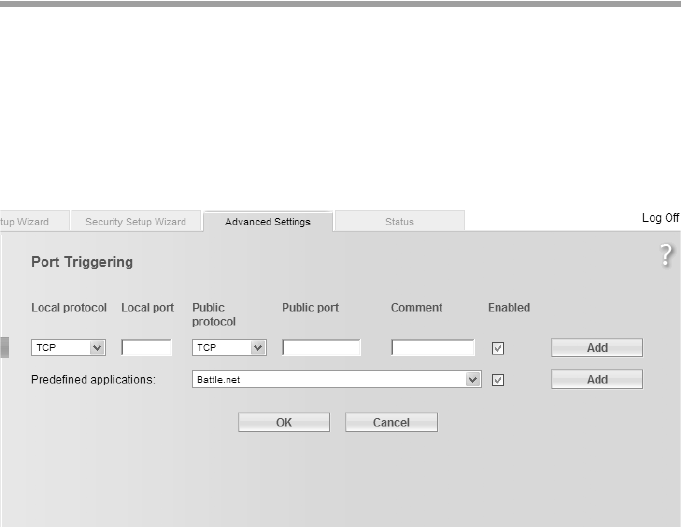
82
Configuring Advanced Settings
Gigaset SX686 WiMAX / eng / A31008-N919-R101-2x-7619 / configure_router.fm / 15.10.2008
Schablone 2005_07_27
Port Triggering
If you configure port triggering for a certain application, you must identify a trigger port
and the protocol (TCP or UDP) this port uses. You can then assign the public ports that
must be opened for the application and this trigger port.
You can select known Internet services for this purpose or assign ports or blocks of ports
manually.
ìIn the Advanced Settings menu, select: Internet – Address Translation (NAT) –
Port Triggering
ìSelect the required application from the Predefined applications list.
ìClick the Add button. The data for the required service is entered on the screen.
ìSelect the check box in the Enabled column.
If the application you require is not in the list, you must enter the relevant data on the
screen manually:
ìLocal protocol: Select the protocol that is to be monitored for outgoing traffic.
ìLocal port: Enter the port that is to be monitored for outgoing traffic.
ìPublic protocol: Select the protocol that is to be allowed for incoming data traffic.
ìPublic port: Enter the port that is to be opened for incoming traffic.
You can enter a single port number, several individual port numbers separated by
commas, port blocks consisting of two port numbers separated by a dash, or any
combination of these, for example 80,90-140,180.
ìComment: Enter a description to help you identify different entries.
ìSelect the check box in the Enabled column.
ìClick the Delete button to delete an entry. Click the Add button to add a new entry.
ìApply the settings by clicking OK.
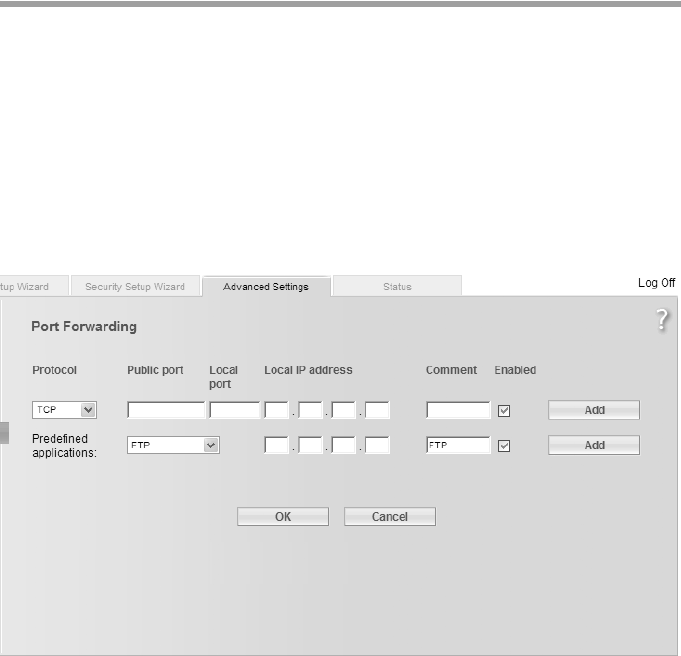
83
Configuring Advanced Settings
Gigaset SX686 WiMAX / eng / A31008-N919-R101-2x-7619 / configure_router.fm / 15.10.2008
Schablone 2005_07_27
Port Forwarding
If you configure Port Forwarding, the Gigaset SX686 WiMAX outwardly assumes the role
of the server. It receives requests from remote users under its public IP address and auto-
matically redirects them to local PCs. The private IP addresses of the servers on the local
network remain protected.
Internet services are addressed via defined port numbers. The Gigaset SX686 WiMAX
needs a mapping table of the port numbers to redirect the service requests to the serv-
ers that actually provide the service.
Port Forwarding has been configured for this purpose.
ìIn the Advanced Settings menu, select: Internet – Address Translation (NAT) –
Port Forwarding
ìSelect the required application from the Predefined applications list.
ìEnter the IP address of the PC that provides the service in the Local IP address field.
ìComment: Enter a description that makes it easy to identify different entries.
ìActivate Enabled by ticking the check box.
ìClick the Add button. The data for the required service is entered on the screen.
ìClick the Delete button to delete an entry.
If the application you require is not in the list, you must manually enter the relevant data
on the screen:
ìSelect the protocol for the service you are providing from the Protocol list.
ìUnder Public port, enter the port number(s) of the service you are providing.

84
Configuring Advanced Settings
Gigaset SX686 WiMAX / eng / A31008-N919-R101-2x-7619 / configure_router.fm / 15.10.2008
Schablone 2005_07_27
You can use
– a single port number,
– several port numbers separated by commas,
– port blocks consisting of two port numbers separated by a dash, or
– any combination of these (for example 80,90-140,180).
ìIn the Local port field, enter the internal port number(s) to which service requests
are to be forwarded.
Example: The Web server has been configured to react to requests on port 8080.
However, the requests from web sites enter the Web server via port 80 (standard
value). If you add the PC to the forwarding table and define port 80 as the public
port and port 8080 as an internal port, all requests from the Internet are diverted to
the service with the port number 80 on the Web server of the PC you have defined
with port 8080.
ìEnter the IP address of the PC that provides the service in the Local IP address field.
ìComment: Enter a description that makes it easy to identify different entries.
ìActivate Enabled by ticking the check box.
ìClick the Add button to add a new entry.
ìClick the Delete button to delete an entry.
ìClick OK to apply the settings.
Opening the firewall for a selected PC (Exposed Host)
You can set up a client in your local network to be a so-called "exposed host" (DMZ). Your
device will then forward all incoming data traffic from the Internet to this client. You can
then, for example, operate your own Web server on one of the clients in your local net-
work and make it accessible to Internet users.
As the exposed host, the local client is directly visible to the Internet and therefore par-
ticularly vulnerable to attacks (e.g. hacker attacks). Only activate this function if it is
absolutely necessary (e.g. to operate a Web server) and other functions (e.g. port for-
warding) are not adequate. In this case you should take appropriate measures for the
clients concerned.
Note:
Only one PC per public IP address can be set up as an Exposed Host (see also Port For-
warding on page 83).
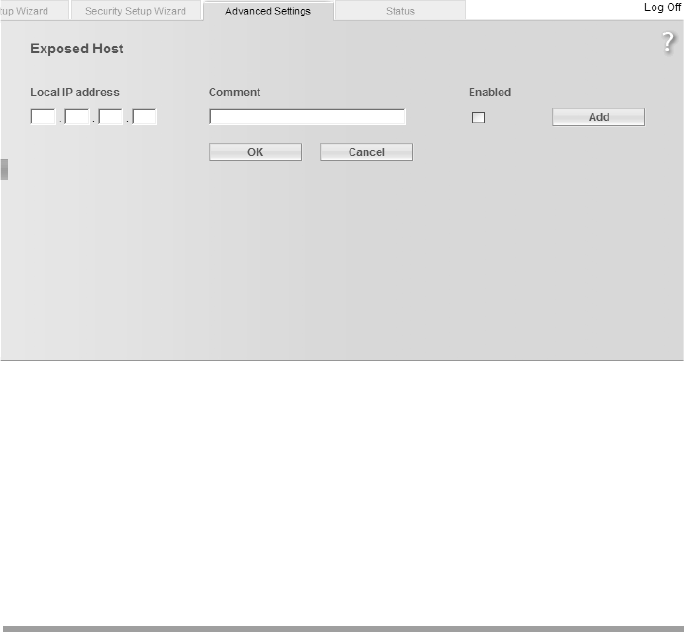
85
Configuring Advanced Settings
Gigaset SX686 WiMAX / eng / A31008-N919-R101-2x-7619 / configure_router.fm / 15.10.2008
Schablone 2005_07_27
ìIn the Advanced Settings menu, select: Internet – Address Translation (NAT) –
Exposed Host
ìEnter the Local IP address of the PC that is to be enabled as an Exposed Host.
ìEnter a name for the PC in the Comment field.
ìActivate Enabled by ticking the check box.
ìClick the Add button to add the entry to the list.
You can add more than one PC to the list, but you can only activate one of them.
ìClick the Delete button to delete the entry from the list.
ìApply the settings by clicking OK.
Dynamic DNS
Any service you provide on the Internet can be accessed via a Domain name. Your
router's Public IP address is assigned to this domain name. If your Internet service pro-
vider assigns the IP address for your local network's WAN connection dynamically, the IP
address of the router can change. The assignment to the domain name will no longer
be valid and your service will no longer be available.
In this case you must ensure that the assignment of the IP address to the domain name
is updated regularly. This task is performed by the dynamic DNS service (DynDNS). You
can use the DynDNS service to assign the Gigaset SX686 WiMAX an individual fixed
domain name on the Internet even if it does not have a static IP address.
Various Internet service providers offer a free DynDNS service.
If you use the service of a DynDNS provider, your service can be reached on the Internet
as a subdomain of one of the DynDNS service domains.
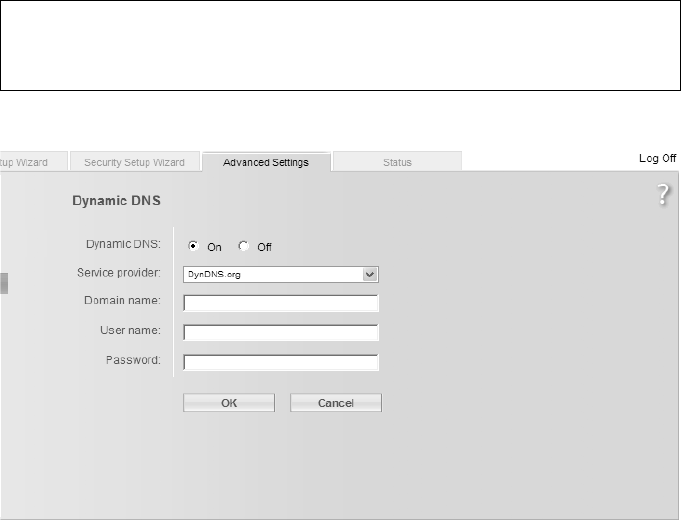
86
Configuring Advanced Settings
Gigaset SX686 WiMAX / eng / A31008-N919-R101-2x-7619 / configure_router.fm / 15.10.2008
Schablone 2005_07_27
One possible service is DynDNS.org (http://www.DynDNS.org). If you have activated
the device's DynDNS function, it will monitor its public IP address. When this changes,
the device will open a connection to DynDNS.org and update its IP address there.
ìIn the Advanced Settings menu, select: Internet – Dynamic DNS
ìActivate the Dynamic DNS function.
ìSelect a service from the Service provider list.
ìEnter Domain name, User name and Password. You will have received all the nec-
essary information when you registered with your Service provider.
ìClick OK to apply the settings.
Note:
You must have an account with the service you have chosen (e.g. DynDNS.org) before
you can use the DynDNS function. Follow the instructions on the provider's web site.
Then enter the user data when configuring the router.
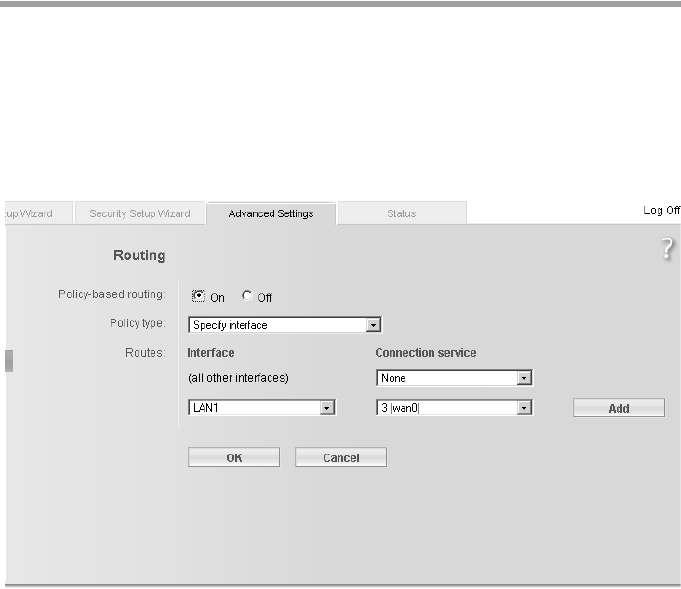
87
Configuring Advanced Settings
Gigaset SX686 WiMAX / eng / A31008-N919-R101-2x-7619 / configure_router.fm / 15.10.2008
Schablone 2005_07_27
Routing
Your Internet service provider can permit you to set up a number of connection services.
The entire data traffic between your local network and the Internet uses the first con-
nection service (route) by default. After setting up various connection services
(page 71), you can change this default route and set up additional routes by assigning
data traffic to other connection services. Rules are provided to assist you, these define
criteria for determining which data traffic is assigned to which connection service.
ìIn the Advanced Settings menu, select: Internet – Routing
ìActivate or deactivate Policy-based routing for your Internet connection.
ìChoose the Policy type, i.e. how you would like to define the various routes for data
traffic between your local network and the Internet:
–Choose Specify interface to specify routes for clients in your local network
depending on the port used for connecting to your device (e.g. LAN port or wire-
less network connection).
–Choose Specify IP address, Specify IP address range or Specify MAC address
to specify routes for clients depending on your IP address or MAC address.
If you choose Specify MAC address, you can select PCs from the list of known
clients.
ìClick Delete to delete an entry.
ìClick Add to create a new entry with the entered data or for the selected client.
ìClick OK to save and apply the changes.
ìClick Cancel to reject the changes.
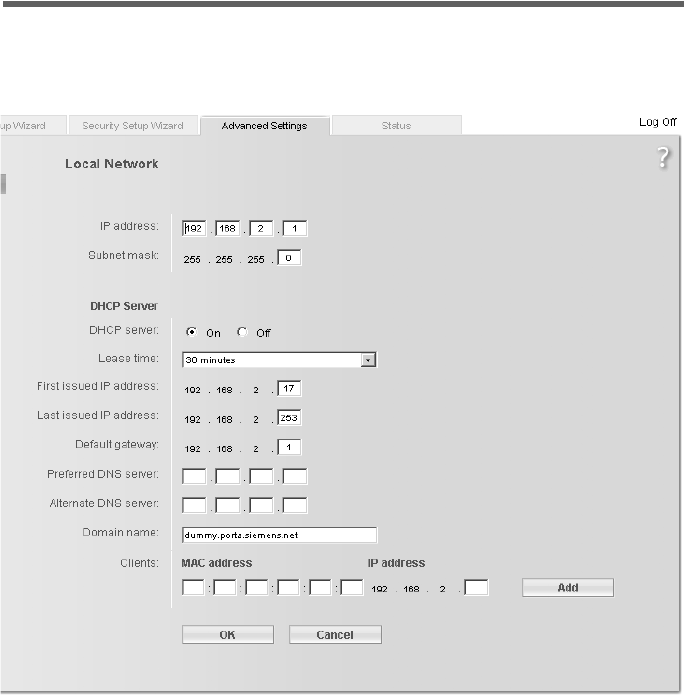
88
Configuring Advanced Settings
Gigaset SX686 WiMAX / eng / A31008-N919-R101-2x-7619 / configure_router.fm / 15.10.2008
Schablone 2005_07_27
LAN configuration
You can use the LAN configuration to define an IP address for the Gigaset SX686 WiMAX
and configure the DHCP server.
ìIn the Advanced Settings menu, select: Local Network
Defining the private IP address for the Gigaset SX686 WiMAX
On this screen you can change the device's IP address. The preset IP address is
192.168.2.1. This is the Private IP address of the Gigaset SX686 WiMAX. This is the
address under which the device can be reached in the local network. It can be freely
assigned from the block of available addresses. The IP address under which the Gigaset
SX686 WiMAX can be reached from outside is assigned by the Internet service provider.
The Subnet mask for the local network administered by the Gigaset SX686 WiMAX is
255.255.255.0.
ìIf you want to assign a different IP address to the Gigaset SX686 WiMAX, enter your
chosen IP address in the boxes next to IP address.

89
Configuring Advanced Settings
Gigaset SX686 WiMAX / eng / A31008-N919-R101-2x-7619 / configure_router.fm / 15.10.2008
Schablone 2005_07_27
Please note which subnet mask is set when assigning the IP address. The preset sub-
net mask defines the first three parts of the IP address which must be identical for
all network components (including routers).
We recommend that you use an address from a block that is reserved for private use.
This address block is 192.168.1.1 to 192.168.255.254.
ìAdjust the Subnet mask if necessary.
The Subnet mask specifies how many address parts of the IP address must be iden-
tical for all network components (including routers).
Configuring the DHCP server
The Gigaset SX686 WiMAX has a DHCP server for which the factory setting is active.
Consequently, the IP addresses of the PCs are automatically assigned by the Gigaset
SX686 WiMAX.
ìTo activate the DHCP server, select On.
ìIf the DHCP server is active, you can define a Lease time. The least time indicates
how long the client may use the allocated IP configuration.
ìDefine the range of IP addresses the Gigaset SX686 WiMAX should use to automat-
ically assign IP addresses to the PCs. Define the First issued IP address and the Last
issued IP address.
ìIf you want to define a different Default gateway in your local area network instead
of the Gigaset SX686 WiMAX, enter the IP address of this default gateways in the rel-
evant boxes.
Notes:
New settings can only be made after the Gigaset SX686 WiMAX has been rebooted.
If necessary, reconfigure the IP address on your PC (including one that is statically
assigned) so that it matches the new configuration.
Note:
uIf the DHCP server for the Gigaset SX686 WiMAX is activated, you can configure
the network setting on the PC so that the option Obtain an IP address automat-
ically is set up. For further information, refer to the section entitled "Configuring
the local area network" on the CD-ROM.
uIf you deactivate the DHCP server, you will have to assign a static IP address for the
PCs that use the network settings.
Note:
If you select Never expires, the IP addresses are never changed. Activate this
option if you want to make NAT or firewall settings using the IP addresses of the
PCs; otherwise you have to assign static IP addresses to these PCs.

90
Configuring Advanced Settings
Gigaset SX686 WiMAX / eng / A31008-N919-R101-2x-7619 / configure_router.fm / 15.10.2008
Schablone 2005_07_27
Entering the DNS server
DNS is a decentralised service that assigns PC names or Internet addresses (Domain
names) and IP addresses to one another. A DNS server must administer this information
for each server or for each LAN with an Internet connection.
Your Internet service provider will usually provide you with a DNS server that makes this
assignment when an Internet connection is set up. If necessary, you can manually
define the DNS server to be used for the Internet connections.
ìEnter the IP addresses for your preferred DNS servers (Preferred DNS server and
Alternate DNS server).
ìYou can define the name of a domain (Windows workgroup) in the Domain name
field.
Assigning static IP addresses to individual PCs
Even if you have activated the DHCP server, you can still assign a static IP address to indi-
vidual PCs (e.g. when setting up these PCs for NAT functions).
ìEnter the MAC address of the PC to which you want to assign a static IP address.
ìEnter the IP address you wish to assign to the PC.
ìClick the Add button to add the entry to the list.
ìClick the Delete button to delete the entry from the list.
ìApply the settings by clicking OK.
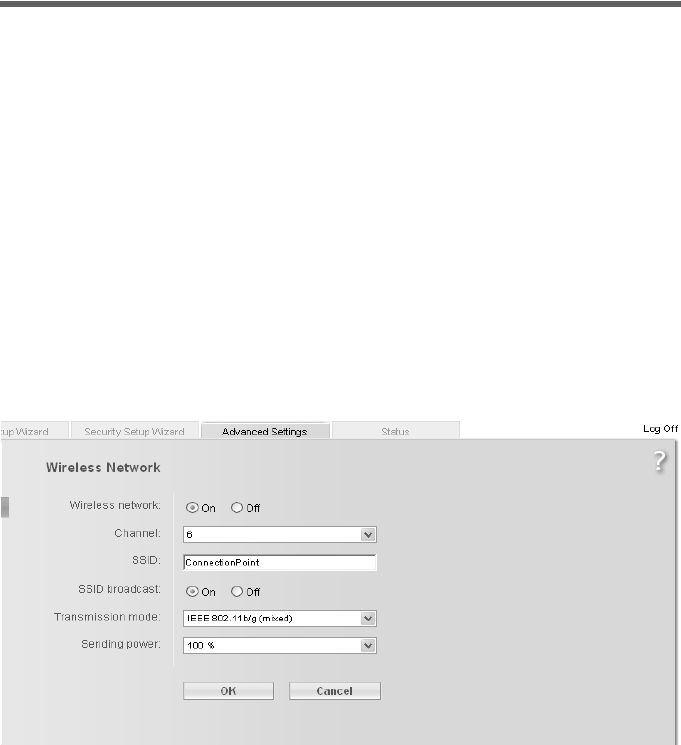
91
Configuring Advanced Settings
Gigaset SX686 WiMAX / eng / A31008-N919-R101-2x-7619 / configure_router.fm / 15.10.2008
Schablone 2005_07_27
Configuring wireless connections
If you have implemented wireless PC communication via the Gigaset SX686 WiMAX, you
should improve the security of your wireless network via the Advanced Settings –
Wireless Network menu. You can carry out the following functions:
ìIn the Advanced Settings menu, select: Wireless Network
ìSelect On for the Wireless Network (default setting).
Devices can only log in wirelessly if the WLAN module of the Gigaset SX686 WiMAX is
activated.
You can now make the settings for the wireless network.
Wireless Network Activate the wireless module of the Gigaset SX686 WiMAX
and specify basic settings for your wireless network, for
example SSID, Transmission mode or Sending power.
WPS Registration Start WPS registration and configure WPS (see page 93).
Encryption &
Authentication
Set up Encryption for wireless transmissions (page 94).
Allowed Clients Restrict access to the LAN of the Gigaset SX686 WiMAX
(page 101).
Repeater (WDS) Activate the repeater function (Wireless Distribution
System, WDS) and define repeaters to increase the range of
your WLAN (see page 103).

92
Configuring Advanced Settings
Gigaset SX686 WiMAX / eng / A31008-N919-R101-2x-7619 / configure_router.fm / 15.10.2008
Schablone 2005_07_27
Channel
All clients in the network use the set radio channel for wireless data transfer. You can
choose between various channels, depending on your current location.
ìSelect Automatic so that the best channel for transmitting the data is used automat-
ically.
SSID
For the wireless network components to be able to communicate with one another, you
must use the same SSID (Service Set Identifier).
The Gigaset SX686 WiMAX is delivered with a preset SSID. You will find it at the label on
the bottom of the device. This can be a default SSID, e.g. ConnectionPoint, or a SSID
which is individually set for each device in the format SX686-XXXXXX, where XXXXXX
is a string consisting of 0-9 and A-F, e.g. SX686-EB691A.
For security reasons you can change this SSID and deactivate SSID broadcast (for infor-
mation see below).
Enter a character string of your choice. The SSID is case-sensitive. It can contain up to
32 characters. Use a combination of letters, digits and special characters.
SSID broadcast
If this option is enabled (default setting), the Gigaset SX686 WiMAX will send the SSID
in all data transfers and the SSID of the Gigaset SX686 WiMAX will be displayed on PCs
that have a wireless network adapter. In this case, hackers could use the SSID to detect
your network.
If you deactivate SSID broadcast, the SSID of the Gigaset SX686 WiMAX will not be dis-
played. This increases protection against unauthorised access to your wireless network.
Make a note of the SSID. You will need it to log on to the PC.
To protect your wireless network, you should also enable encryption of data transmis-
sions (page 94).
ìSelect Off to deactivate SSID broadcast.
Transmission mode
The IEEE 802.11g standard permits data transfer up to 54 Mbit/s, and the IEEE 802.11b
standard up to 11 Mbit/s. Choose IEEE 802.11g only to ensure the best possible data
Note:
If a WPS registration (see page 57) was performed before manual configuration, the
generated SSID is displayed in this screen. You should not change this SSID here
manually. Otherwise, the registered clients will no longer have access to your wireless
network.
Note:
The connection to the wireless network adapters will be interrupted until you have
entered the new SSID in them as well.
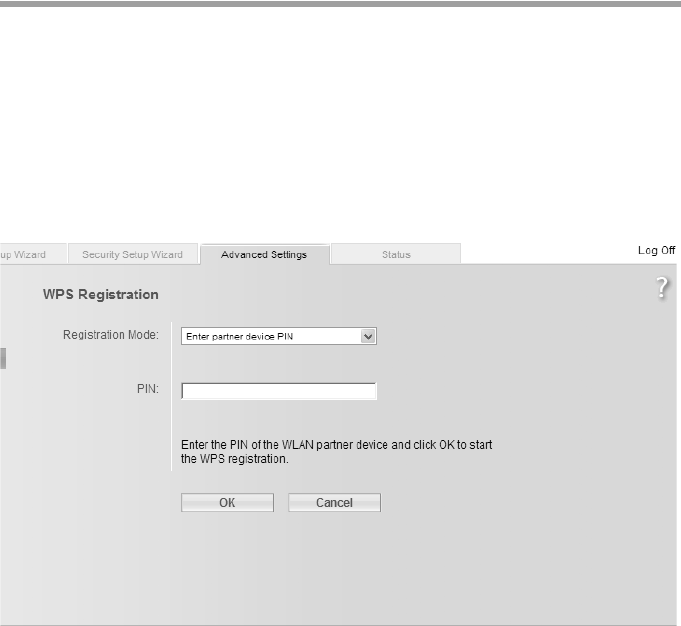
93
Configuring Advanced Settings
Gigaset SX686 WiMAX / eng / A31008-N919-R101-2x-7619 / configure_router.fm / 15.10.2008
Schablone 2005_07_27
transfer rates in your network. To operate clients with older wireless network adapters
in your network, select IEEE 802.11b/g (mixed).
ìSelect the required transmission mode for your wireless network.
Sending power
ìSelect the required sending power for your device.
It is recommended that you select a sending power with a range to suit the spatial
environment of your local network. A much greater range makes it easier to eaves-
drop on your wireless data transfer.
ìClick OK to apply the settings.
Starting WPS registration and configuring WPS
Wi-Fi Protected Setup (WPS) makes it easier to establish a wireless network. Devices
equipped with WPS can synchronise the SSID and the WPA key (pre-shared key).
The most simple method to establish a secure wireless connection is click once in the
user interface of the Gigaset SX686 WiMAX and do the same with the client. For further
information, see "Setting up a wireless network via WPS" on page 26.
The configuration program of the Gigaset SX686 WiMAX provides beside the Push But-
ton method for WPS registration for more security the registrations mode via PIN.
ìIn the Advanced Settings menu select: Wireless Network – WPS Registration
ìChoose the desired Registration Mode:
–Push Button
Click OK to start the WPS registration.

94
Configuring Advanced Settings
Gigaset SX686 WiMAX / eng / A31008-N919-R101-2x-7619 / configure_router.fm / 15.10.2008
Schablone 2005_07_27
Once WPS registration is activated, the device searches for a WPS client within
range. Any WPS client within range that activates the WPS function during the
two-minute interval receives the Gigaset SX686 WiMAX security data (SSID and
pre-shared key) and is thereby registered.
The registration progress is shown in the window.
You can also follow the registration process via the LED display (see page 37).
If more than one client tries to register within the two minutes, an error message
is displayed. You may retry the WPS registration after a short time.
If an external client succeeds in registering, the LED (see page 37) displays a suc-
cessful WPS registration. The desired client in you network, however, has no con-
nection to the Gigaset SX686 WiMAX und displays a registration failure. In this
case you should change the pre-shared key (WPA2-PSK/WPA-PSK) as soon as pos-
sible and then perform WPS registration via PIN (see below).
–Send own PIN
An automatically generated PIN is shown.
If you want to create a new PIN, click Generate PIN.
Click OK to activate your settings.
Enter the generated PIN on all WLAN partner devices that are to establish a
connection.
– Enter partner device PIN
You would use this option if you have created a PIN at the desired client. Enter the
PIN of the WLAN partner device and click OK to activate your settings.
Setting encryption
If you are sending data over radio channels, we recommend that you activate encryp-
tion (WEP or WPA) on the components in the wireless network. WPA offers greater secu-
rity than WEP. You should therefore select WPA encryption if it is supported by all com-
ponents in your wireless network.
WPA also supports the use of an authentication server.
Note:
If you have activated access control via the MAC address filter, you have to include the
clients in the MAC address list before registering via WPS (see page 101).
Note:
The Gigaset SX686 WiMAX is delivered with preset individual encryption (WPA2-PSK/
WPA-PSK with pre-shared key). You should change this settings only, if not all com-
ponents of your wireless network provide this encryption method or if you want to
change the preset key for security reasons, or if you want to use the WDS repeater
function.
If you change the preset key after having registered PCs at the Gigaset SX686 WiMAX
via WPS or manually, you must register all PCs again manually or via WPS.
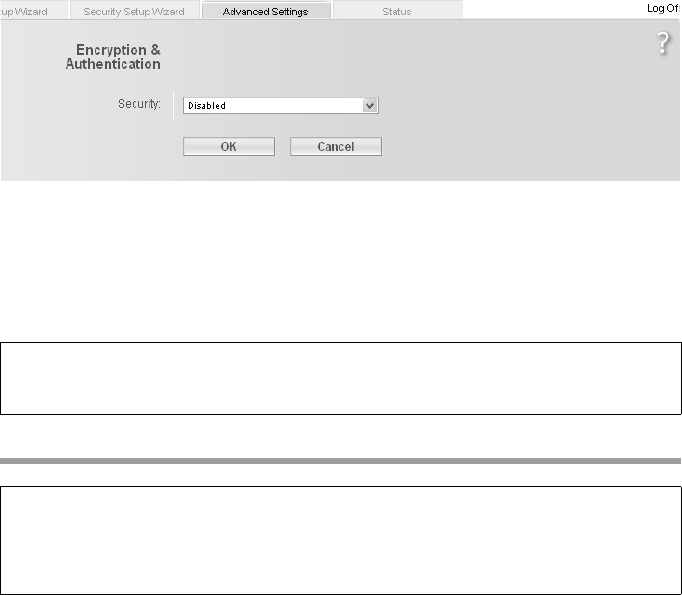
95
Configuring Advanced Settings
Gigaset SX686 WiMAX / eng / A31008-N919-R101-2x-7619 / configure_router.fm / 15.10.2008
Schablone 2005_07_27
ìIn the Advanced Settings menu select: Wireless Network –
Encryption & Authentication
The following security mechanisms are currently available:
uWPA2-PSK, WPA-PSK and WPA2-PSK/WPA-PSK (page 95)
uWPA2 and WPA2/WPA with authentication server (page 96)
uWEP encryption (Wired Equivalent Privacy, see page 98)
WPA2-PSK and WPA2-PSK / WPA-PSK
WPA with a pre-shared key (WPA-PSK)
WPA-PSK is a special WPA mode for private users and users in small companies without
their own authentication server. After a certain period of time (Rekey interval), encryp-
tion keys are automatically generated with the pre-shared key, automatically changed
("rekeying") and authenticated between the devices.
The standard of encryption available to you depends on the components in the wireless
network. Every PC (network adapter) that requires access to a WPA-protected wireless
network must also support WPA. To find out whether and how you can use WPA on your
PC, read your network adapter's user guide. If all components support WPA2, select
WPA2-PSK. If you are using network adapters that only support WPA, select WPA-PSK.
Select WPA2-PSK / WPA-PSK if both methods are used in your network. Your device
then automatically defines the best possible way to protect your data for each client.
The entries described below are identical for both options.
ìSelect the required option in the Security field.
Note:
If you want to use the repeater function of your Gigaset SX686 WiMAX (page 103) you
can only use WEP encryption.
Note:
This screen allows you to display the pre-shared key. You can change the encryption
here. In this case, you also have to configure all wireless network adapters manually
or perform WPS registration once again.
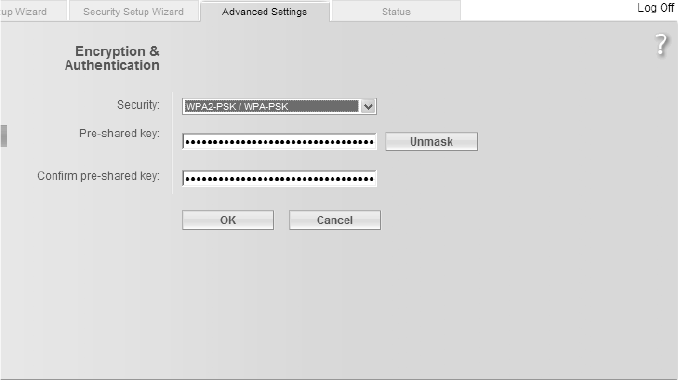
96
Configuring Advanced Settings
Gigaset SX686 WiMAX / eng / A31008-N919-R101-2x-7619 / configure_router.fm / 15.10.2008
Schablone 2005_07_27
ìEnter a key in the Pre-shared key field (up to 32 characters) and confirm it by enter-
ing it again. Use a combination of letters, digits and special characters.
ìBy clicking the Unmask button, a message showing the pre-shared key is output in
readable characters.
ìApply the settings by clicking OK.
WPA and WPA2 with authentication server
In large networks (e.g. in companies) WPA enables the use of an additional authentica-
tion service. In this case, user access is controlled by user accounts and passwords, in
addition to WPA encryption. A RADIUS server acts as an authentication server. You can
select the new WPA2 standard if it is supported by all components in your wireless net-
work. Select WPA2 / WPA if you are using devices that only support WPA.
ìSelect the required option in the Security field.
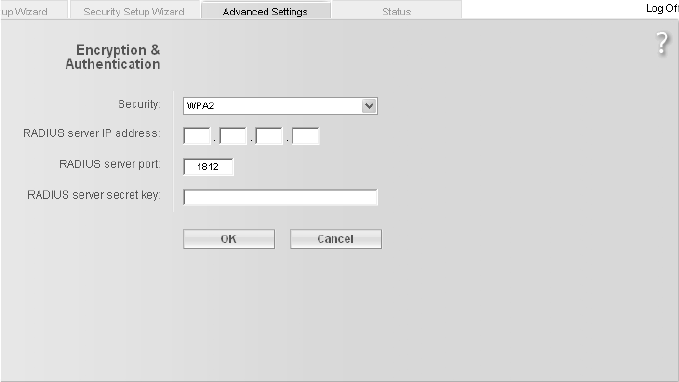
97
Configuring Advanced Settings
Gigaset SX686 WiMAX / eng / A31008-N919-R101-2x-7619 / configure_router.fm / 15.10.2008
Schablone 2005_07_27
ìEnter the IP address of the RADIUS server in the RADIUS server IP address field.
ìEnter the port of the RADIUS server in the RADIUS server port field.
ìIn the RADIUS server secret key field, enter a keyword that conforms to the con-
ventions of the RADIUS servers that the server is to use for authentication.
ìClick OK to apply the settings.
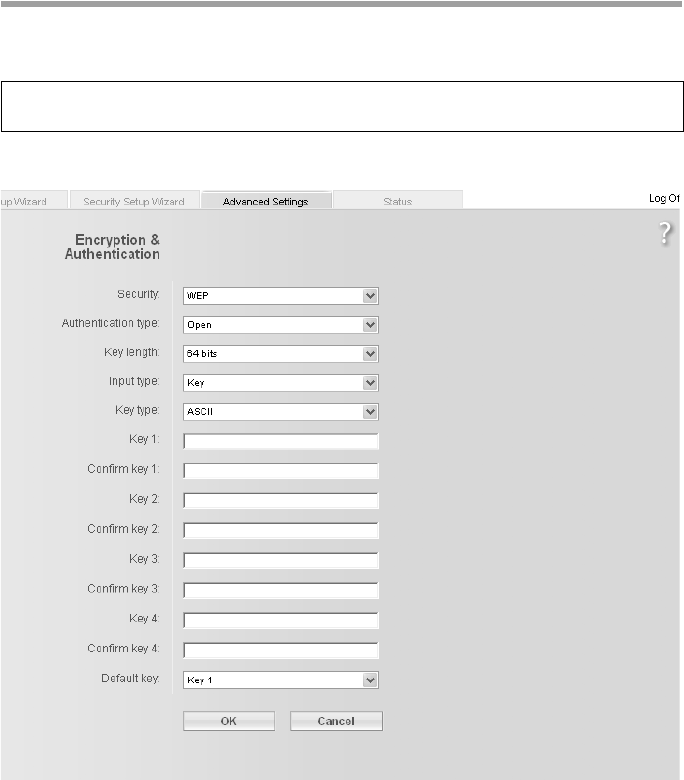
98
Configuring Advanced Settings
Gigaset SX686 WiMAX / eng / A31008-N919-R101-2x-7619 / configure_router.fm / 15.10.2008
Schablone 2005_07_27
WEP encryption
If WPA is not supported by all components in your wireless network, we recommend
that you activate WEP Encryption on the components.
ìChoose the WEP option in the Security field.
ìSelect the Authentication type:
–Select Shared to require that each client log in to the network with a specified
key.
–Select Open to permit data transfer within the wireless network without the need
to enter a key.
You can choose either the standard 64-bit key or the more robust 128-bit key. The keys
are generated in hexadecimal or in ASCII format. You must use the same keys for encryp-
tion and decryption for the Gigaset SX686 WiMAX and all your wireless network
adapters.
Note:
You cannot use WEP together with WPS.

99
Configuring Advanced Settings
Gigaset SX686 WiMAX / eng / A31008-N919-R101-2x-7619 / configure_router.fm / 15.10.2008
Schablone 2005_07_27
ìSelect the Key length: 64 bits or 128 bits.
ìSelect the Input type, i.e. whether the key is to be entered manually or generated
automatically by means of a Passphrase.
Manual key entry
ìSelect the Key type, Hex or ASCII.
If you select Hex as the key type you can use the characters 0 to 9 and A to F.
– With a 64-bit encryption depth, the key is 10 characters long.
An example of a valid key: 1234567ABC
– With a 128-bit encryption depth, the key is 26 characters long.
An example of a valid key: 234567ABC8912345DEF1234567
If you select ASCII as the key type, you can use the characters 0 to 9, A to Z, a to z
plus the special characters in the ASCII character set.
– With a 64-bit encryption depth, the key is 5 characters long.
An example of a valid key: GIGA1
– With a 128-bit encryption depth, the key is 13 characters long.
An example of a valid key: GIGASET_SX76x
ìEnter up to four keys in fields Key 1 to Key 4 and confirm them by entering them
again in fields Confirm key 1 to Confirm key 4.
ìSelect one of the four keys as the Default key.
ìClick OK to apply the settings.
Note:
uIt is very important that you make a note of the key(s) that have been entered.
You will need this information to configure the wireless network adapters prop-
erly.
uWhen you have concluded the configuration, you must change the WEP encryp-
tion in the wireless network adapters for the connected PCs in the same way as
they will not otherwise be given access to the wireless network of the Gigaset
SX686 WiMAX.
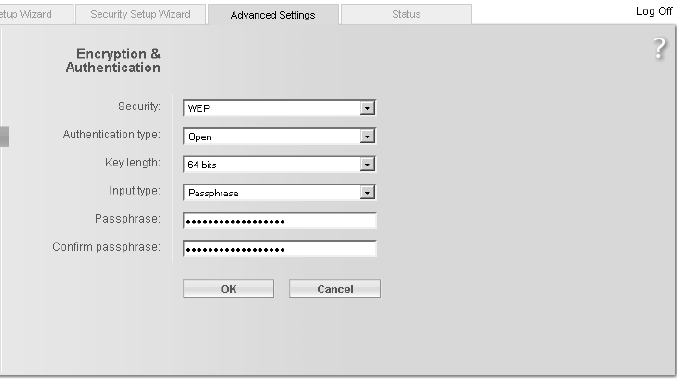
100
Configuring Advanced Settings
Gigaset SX686 WiMAX / eng / A31008-N919-R101-2x-7619 / configure_router.fm / 15.10.2008
Schablone 2005_07_27
Generating a key by means of a Passphrase
ìEnter a Passphrase (up to 32 characters) and confirm it by entering it again. The key
is generated automatically.
ìClick OK to apply the settings.
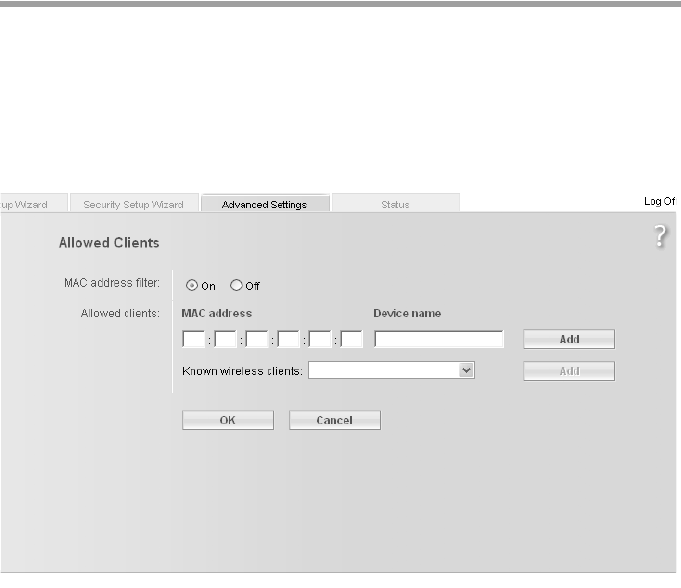
101
Configuring Advanced Settings
Gigaset SX686 WiMAX / eng / A31008-N919-R101-2x-7619 / configure_router.fm / 15.10.2008
Schablone 2005_07_27
Permitted clients
On this screen you can specify the PCs that are to have wireless access to the
Gigaset SX686 WiMAX and hence to your LAN and WLAN.
The default setting for access control is deactivated. This means that all PCs that use
the correct SSID can be logged in.
Access control is based on the MAC addresss of the PC network adapters.
ìIn the Advanced Settings menu, select: Wireless Network – Allowed Clients
ìActivate access control by selecting On in the MAC address filter field.
Entering PCs manually:
ìEnter the MAC address and Device name of the required PCs in the appropriate
fields.
ìClick the Add button to add the entry to the list.
ìClick the Delete button to delete the entry from the list.
Note: Only following deletion is the entry transferred to the list of known MAC
addresses.
ìApply the settings by clicking OK.
Selecting from the list of logged-in PCs
ìSelect the required PC from the Known wireless clients list. All PCs that were
already entered manually on the router with the MAC address are displayed.
ìClick the Add button to add the selected PC to the list.
ìApply the settings by clicking OK.

102
Configuring Advanced Settings
Gigaset SX686 WiMAX / eng / A31008-N919-R101-2x-7619 / configure_router.fm / 15.10.2008
Schablone 2005_07_27
Note:
If you activate MAC access control, you must at least add the PC on which you are con-
figuring the Gigaset SX686 WiMAX to the list. Otherwise, you will have no access to
the user interface and will receive an appropriate error message.
If you have inadvertently denied all PCs access to the Gigaset SX686 WiMAX, you have
two options:
uYou can completely reset the Gigaset SX686 WiMAX (page 16).
uYou can connect a PC to the Gigaset SX686 WiMAX using one of the LAN connec-
tions. As MAC access control only affects PCs that are connected wirelessly, you
can use this PC to change the configuration.
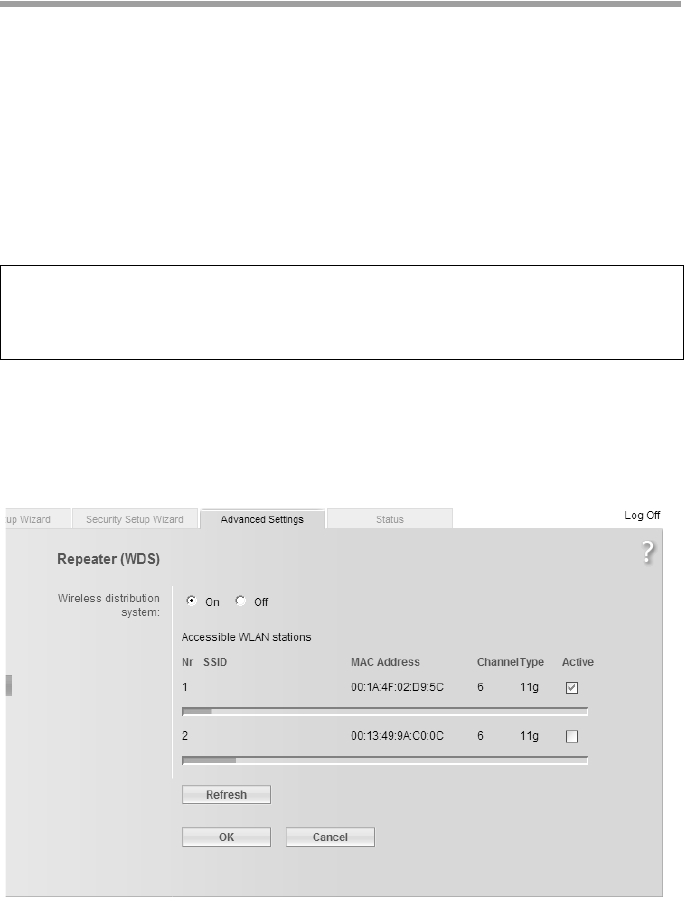
103
Configuring Advanced Settings
Gigaset SX686 WiMAX / eng / A31008-N919-R101-2x-7619 / configure_router.fm / 15.10.2008
Schablone 2005_07_27
Repeater function (WDS)
WDS (Wireless Distribution System) allows you to extend the range of your wireless net-
work using a repeater. A repeater located at the outer range of a wireless network
ensures that data is forwarded between WLAN clients in this wireless network and cli-
ents within its own wireless range. Repeaters and access points thereby form a common
wireless network within which all clients can be moved about freely. Clients automati-
cally set up a connection to the next access point / repeater (roaming). For security pur-
poses you must determine which access points / repeaters are to form a common wire-
less network.
If you want to use a repeater in your wireless network you must activate the Wireless
Distribution System (WDS) function.
ìIn the Advanced Settings menu, select: Wireless Network – Repeater (WDS)
ìTo activate WDS select the On option next to Wireless distribution system.
The environment is scanned for wireless networks in rage. If the search has been com-
pleted successfully the networks are displayed.
All repeaters/access points in range are displayed with the following information:
–SSID
–MAC address
–Channel
Note:
WDS can only be used with WEP encryption or without encryption. If you use WPA-PSK
encryption (default) you have to change the encryption of your wireless network. For
information refer to the section "Setting encryption" on page 94.

104
Configuring Advanced Settings
Gigaset SX686 WiMAX / eng / A31008-N919-R101-2x-7619 / configure_router.fm / 15.10.2008
Schablone 2005_07_27
–Type (11b or 11g)
The Signal strength of the connection to the repeater, if one exists, is shown as a per-
centage. You can use this data to determine the best possible location for your repeater.
You can register a maximum of three repeaters to extend your WLAN.
ìSelect the Active check box to register a repeater to your wireless network.
ìClick Refresh to update the display.
ìClick OK to apply the settings.
Note:
The registered but currently unavailable repeaters are presented only by their MAC
addresses.
Note:
uWDS can only be used with WEP encryption or without encryption. You may have
to change the encryption of your wireless network, if applicable.
uThe encryption settings on the repeater have to correspond to the settings on your
Gigaset SX686 WiMAX.
uThe Gigaset SX686 WiMAX and the repeaters must use the same channel.
Further information can be found in the user manual for the repeater.

105
Configuring Advanced Settings
Gigaset SX686 WiMAX / eng / A31008-N919-R101-2x-7619 / configure_router.fm / 15.10.2008
Schablone 2005_07_27
Setting up Internet telephony (VoIP)
The Gigaset SX686 WiMAX allows you to make telephone calls via the Internet using an
analogue telephone and also via the fixed network as usual. For Internet telephony
(VoIP), you require access authorisation from your service provider and the relevant
access data. To make calls, you have to enter this data along with other configuration
settings under Advanced Settings in the Telephony – VoIP menu.
You can connect a base station for handsets or fax machines to the two telephone ports
of the Gigaset SX686 WiMAX analogue phone. In addition, you can set up additional
extensions for Internet and fixed network calls using SIP clients (as VoIP phones, WLAN
handsets or in wired or wireless mode on PCs).
The menu comprises the following functions:
Important information:
uYou cannot make calls if there is a power failure, even the emergency numbers are
not accessible then.
uIf VoIP is not set up, you will always make calls via the fixed network. The dialling
plans will not apply in this case (page 113).
uCheck these dialling plans (page 113) and change them if you have agreed special
phone tariffs with another provider.
uDo not change the default setting for the Internet connection mode (= "permanent
connection") if you are using VoIP (page 54). You can only be called via VoIP if this
setting is used. Remember, though, that this setting can result in high connection
costs if you have agreed a time-based tariff with your Internet service provider.
VoIP Enter the basic data from your service provider here (page 106).
Extensions Set up the functions for internal extensions here (page 109).
Dialing Plans Specify numbers here that are to be dialled only via the fixed network
or only via the Internet. You can also enter a call-by-call provider for the
fixed network (page 113).
Define an area code (page 113).
Quick Dial Specify speed dial numbers or names here for phone numbers you use
frequently (see page 115)
Note:
If you do not specify any of your own dialling plans, then the default settings will be
used as entered in the Telephony menu under Dialing Plans. Emergency numbers
are directed via the fixed network, while all other calls are made via the Internet.
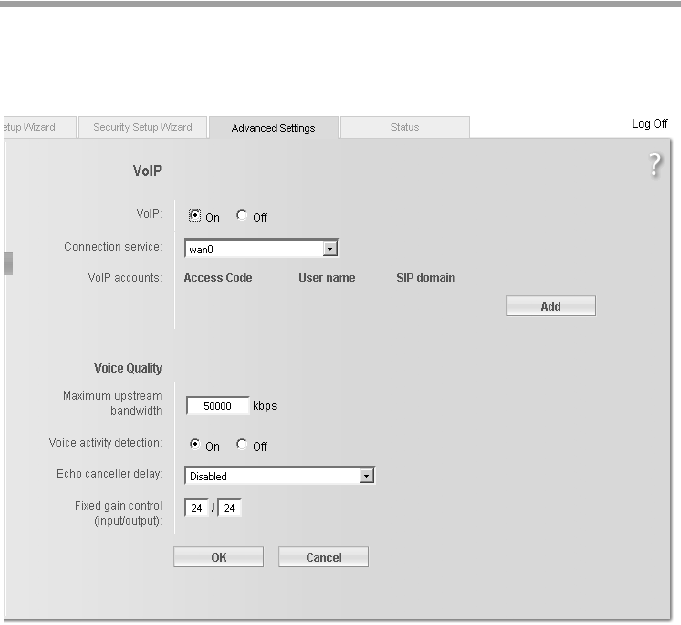
106
Configuring Advanced Settings
Gigaset SX686 WiMAX / eng / A31008-N919-R101-2x-7619 / configure_router.fm / 15.10.2008
Schablone 2005_07_27
VoIP settings
You will receive the access and configuration data for Internet telephony from your serv-
ice provider.
ìIn the Advanced Settings menu, select: Telephony – VoIP
ìSelect On if you wish to use Internet telephony (default setting).
ìIf you have defined more than one Connection service (see page 71), choose from
the list the Connection service, for which you want configure a VoiP account.
ìIf you have already configured Internet telephony in the Basic Setup Wizard, your
VoIP account will be shown with User name and SIP domain in addition to VoIP
accounts. If you want to change a previously configured VoIP account, click Edit
(page 108).
ìTo delete a VoIP account click the Delete button.
The account is deleted immediately and irrevocably when you confirm the action.
ìIf you want to configure additional VoIP accounts, click Add (page 108).
ìYou can generally accept the default settings for Voice Quality:
–Maximum upstream bandwidth: The upstream transmission rate (bandwidth)
varies depending on the provider and WiMAX tariff and is normally much lower
than the transmission rate for downstream data traffic. If there is upstream data
107
Configuring Advanced Settings
Gigaset SX686 WiMAX / eng / A31008-N919-R101-2x-7619 / configure_router.fm / 15.10.2008
Schablone 2005_07_27
traffic at the same time over the WiMAX line, the voice quality may not be opti-
mum.
To ensure optimum voice quality, you can use the Maximum upstream band-
width option to define the bandwidth, which is to be used as a maximum for your
VoIP connection. The bandwidth is set automatically by default.
You can change these values if necessary, but you have to find out first how high
your upstream transmission rate is. Most providers supply tools for administering
your WiMAX connection, which should tell you this information. Otherwise, you
will find plenty of Web sites on the Internet that provide such tools.
Enter a value for Maximum upstream bandwidth, which is 90 percent of your
available bandwidth.
–Voice activity detection: If this function is activated, no data will be transmitted
during breaks in speech during a telephone call.
–Echo canceller delay: If you hear your own voice as an echo during VoIP tele-
phone calls, you should choose a different value from the list.
–Fixed gain control (input/output): To adjust the volume for call input (hear) or
output (speak), simply enter a different value.
The value range is -24 to +24.
The higher the value, the higher the volume.
The value range which can be used depends on your device. If you enter a wrong
value, a message with the valid value range will be displayed.
-24
0
24
quiet
normal
loud
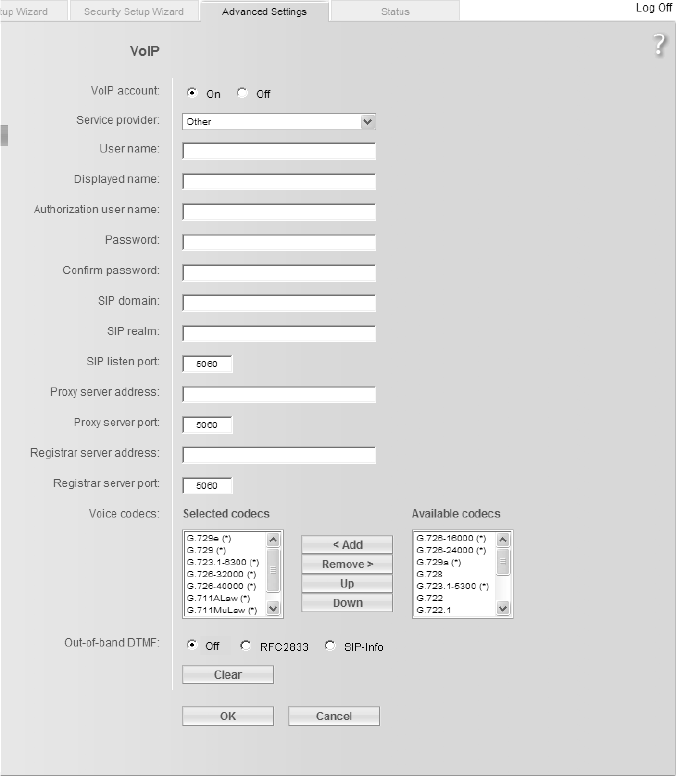
108
Configuring Advanced Settings
Gigaset SX686 WiMAX / eng / A31008-N919-R101-2x-7619 / configure_router.fm / 15.10.2008
Schablone 2005_07_27
Setting up or modifying a VoIP account
ìTo set up a new account, select On.
ìIn the Service provider menu, select the Other option or otherwise select one of
the preconfigured providers.
ìEnter the data you have received from your service provider:
If you choose a preconfigured service provider, the only options are generally User
name and Password.
If you wish to add or modify data, click the Show Additional Settings button.

109
Configuring Advanced Settings
Gigaset SX686 WiMAX / eng / A31008-N919-R101-2x-7619 / configure_router.fm / 15.10.2008
Schablone 2005_07_27
If you have selected the Other option, enter the data for Displayed name, Author-
ization user name, SIP domain, SIP realm, Proxy server address and Registrar
server address.
ìLeave the default settings for the parameters SIP listen port, Proxy server port,
Registrar server port, Voice codecs and Out-of-band DTMF unless your service
provider has provided you with other data.
ìClick the OK button to apply the settings.
Extensions
Your Gigaset SX686 WiMAX allows you to configure up to six internal extensions that
you can use for making calls via the fixed network or via VoIP. Two of these extensions
are connected to your Gigaset SX686 WiMAX via the Phone 1 and Phone 2 ports, while
the remaining extensions are connections for SIP clients. You can assign each extension
the relevant line (fixed network or VoIP account) for incoming and outgoing calls and
make other settings for each extension (e.g. call waiting, call forwarding, caller display).
The process for configuring extensions, which use the two telephone ports of the
Gigaset SX686 WiMAX, is somewhat different to that for the SIP extensions. The latter
must be VoIP telephones, which are connected in wired or wireless mode to the Gigaset
SX686 WiMAX, or PCs with a SIP client, which are connected to the Gigaset SX686
WiMAX.
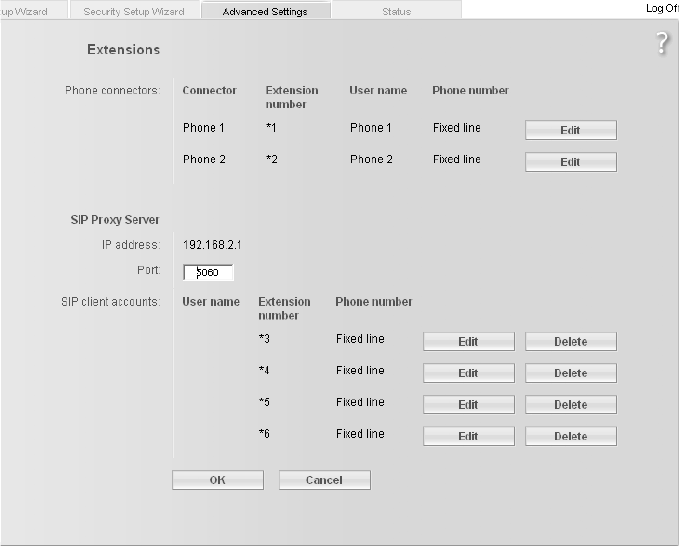
110
Configuring Advanced Settings
Gigaset SX686 WiMAX / eng / A31008-N919-R101-2x-7619 / configure_router.fm / 15.10.2008
Schablone 2005_07_27
ìIn the Advanced Settings menu, select: Telephony – Extensions
Phone connectors
The two telephone ports Phone 1 and Phone 2 of the Gigaset SX686 WiMAX have the
internal phone number *1 or *2.
ìClick Edit to adapt the settings for an entry (page 111).
SIP Proxy Server
In addition to the telephones connected to your Gigaset SX686 WiMAX, you can config-
ure wireless VoIP phones (WLAN handsets) or PCs with SIP clients in your local network
with the assistance of the SIP proxy servers integrated as internal extensions in your
device and then use these to make calls via the fixed network or via VoIP.
Use the IP address displayed in your local network for registering your wireless VoIP
phones or your other SIP clients with your SIP proxy server.
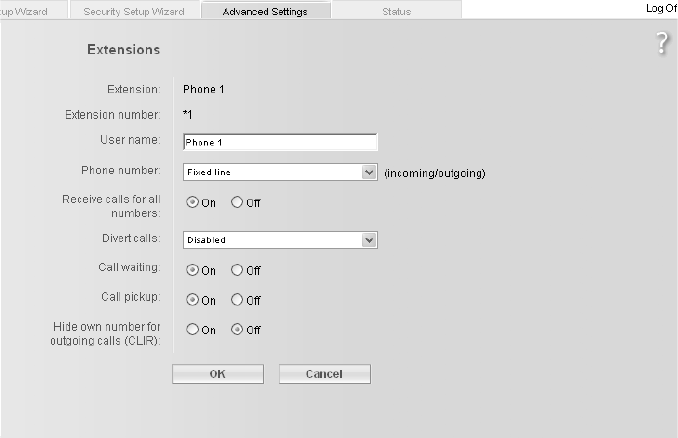
111
Configuring Advanced Settings
Gigaset SX686 WiMAX / eng / A31008-N919-R101-2x-7619 / configure_router.fm / 15.10.2008
Schablone 2005_07_27
Port
The default port via which wireless VoIP phones or other SIP clients register with the SIP
proxy server is entered here.
SIP client accounts
ìMake the extension settings for each SIP user account, which is used for registering
wireless VoIP phones and other SIP clients with the SIP proxy server of your device.
The User name and Extension number are displayed for identifying the individual
telephone ports. These extensions have the internal phone numbers *3 to *6.
ìClick Edit to adjust the settings for an entry (see below).
ìClick Delete to delete an entry.
Configuring extensions
The Extension shows either the selected port of the Gigaset SX686 WiMAX (Phone 1 or
Phone 2) or the SIP client. The Extension number for the extension is preset and is dis-
played as a call number.
ìEnter a name for identifying the port in the User name field. You can also leave the
default setting for Phone 1 and Phone 2.
ìSelect the Phone number from the list (your VoIP service provider or one of your
VoIP service providers) for this extension or choose the entry Fixed line.
The list of numbers for Internet telephony is the one you set up in the VoIP menu
(page 106). All outgoing calls are directed by default via this phone number. Incom-
ing calls for the selected phone number are signalled.

112
Configuring Advanced Settings
Gigaset SX686 WiMAX / eng / A31008-N919-R101-2x-7619 / configure_router.fm / 15.10.2008
Schablone 2005_07_27
ìSelect Receive calls for all numbers if you wish to receive all incoming calls on all
extensions.
ìYou can configure Divert calls with the following options for the Phone 1 and
Phone 2 ports:
–Divert always: Each call for the extension is forwarded to the extension selected
in the Divert calls to field.
–When busy: A call for the extension is forwarded to the selected extension if the
extension is busy.
–No reply: A call for the extension is forwarded to the selected extension if the call
is not answered.
ìSelect the Call waiting option if you want to permit a signal for an incoming call
while you are on a call. (Only for Phone 1 and Phone 2 ports).
ìSelect the Call pickup option to have the option to accept all incoming calls on this
extension.
ìSelect Hide own number for outgoing calls (CLIR) if you want to prevent the
number of this extension being displayed for outgoing calls. (Only for Phone 1 and
Phone 2 ports).
ìClick OK to apply the settings.
Note:
Many service providers either do not support this function at all or only unrelia-
bly. Contact your service provider if you want to be certain that CLIR, for example,
is actually supported.
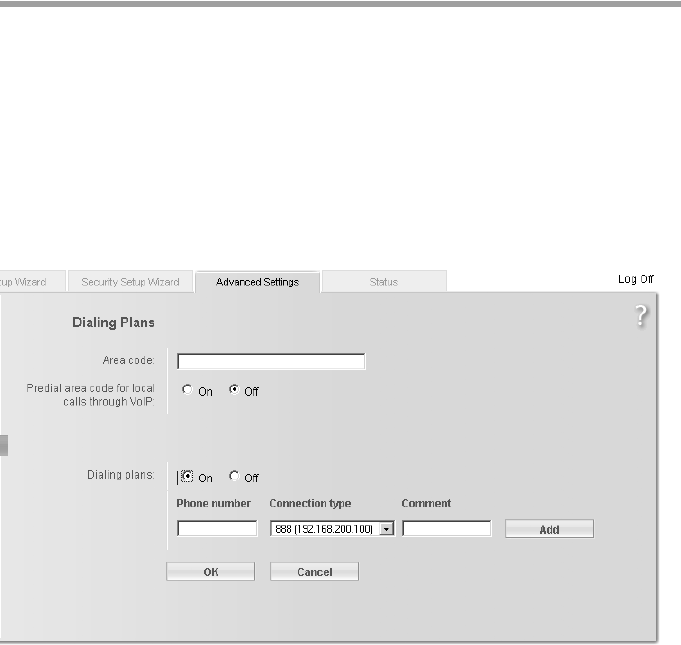
113
Configuring Advanced Settings
Gigaset SX686 WiMAX / eng / A31008-N919-R101-2x-7619 / configure_router.fm / 15.10.2008
Schablone 2005_07_27
Dialing Plans
On this screen you can:
uEnter your area code,
uDefine for Internet telephony whether the area code should be automatically
dialled,
uSpecify whether certain phone numbers or prefixes are to be dialled via the Internet
or the fixed network,
uEnter a call-by-call provider for the fixed network,
uDefine dialling plans.
ìIn the Advanced Settings menu, select: Telephony – Dialing Plans
ìArea code
Enter the Area code for your current location.
ìPredial area code for local calls through VoIP
If you activate this function, the area code will be dialled automatically when you
make a local call via a VoIP provider. This will save you having to enter the area code
which was previously always necessary with VoIP.
ìWait for dial tone on fixed line
Only activate this function if it is necessary for the smooth functioning of your
Gigaset SX686 WiMAX within the telephone network.
ìIf you wish to make all fixed network calls via a call-by-call provider, activate the
Preselection function.
ìEnter the provider's number in the Preselection number field.
ìChoose whether you want to use dialling plans.

114
Configuring Advanced Settings
Gigaset SX686 WiMAX / eng / A31008-N919-R101-2x-7619 / configure_router.fm / 15.10.2008
Schablone 2005_07_27
ìIn the Phone number field, enter an individual number or also the first digits of
phone numbers (e. g. 0800 or a specific area code) for which the dialling plan is to
apply.
ìIn the Connection type selection field, you can specify the VoIP account to be used
to dial the entered number.
ìYou can enter a description for the dialling plan in the Comment field.
ìClick Delete to delete the dialling plan. You can add a new dialling plan by clicking
the Add button.
You can define up to a maximum of 20 dialling plans.
ìClick OK to apply the settings.
Notes:
uDialling plans may already be predefined for certain emergency phone numbers
depending on the country. These can be changed as required.
uIf you do not specify any dialling plans, the default settings will be used.
uIf VoIP (Internet telephony) is not set up, you will always make calls via the fixed
network. The dialling plans will not apply in this case.
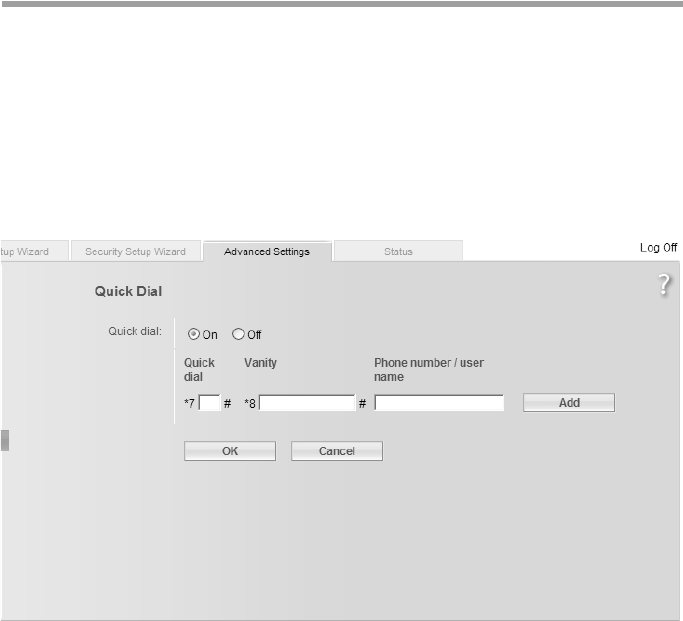
115
Configuring Advanced Settings
Gigaset SX686 WiMAX / eng / A31008-N919-R101-2x-7619 / configure_router.fm / 15.10.2008
Schablone 2005_07_27
Quick dial
Quick dial numbers or Vanity (phonewords) enable you to dial frequently used phone
numbers quickly and easily.
The quick dial number is a two-digit number (01 to 20). A vanity number is a combina-
tion of letters you can enter instead of a phone number. You can specify a quick dial
number and/or a vanity number for a phone number.
Activate quick dial numbers with the keys *7 quick dial number #, and vanity numbers
with the key combination *8 Vanity #.
ìIn the Advanced Settings menu, select: Telephony – Quick Dial
ìClick On to activate the Quick Dial option.
ìEnter the quick dial number in the Quick Dial field and/or a name or combination of
letters in the Vanity field.
ìEnter the phone number in the Phone number / user name field.
ìClick Add to save the entry.
More empty lines will then be added.
ìClick OK to confirm the settings.
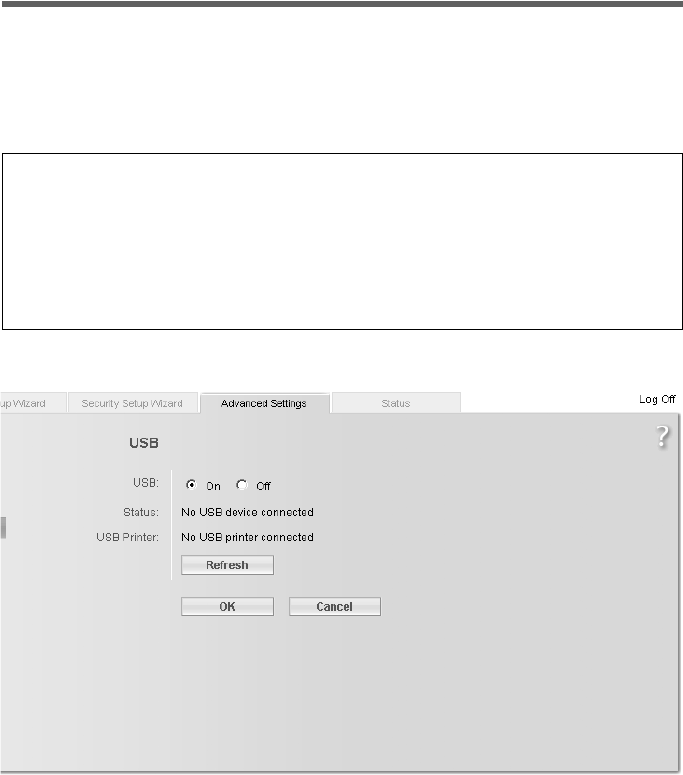
116
Configuring Advanced Settings
Gigaset SX686 WiMAX / eng / A31008-N919-R101-2x-7619 / configure_router.fm / 15.10.2008
Schablone 2005_07_27
USB
The USB port of your Gigaset SX686 WiMAX can be used to set up a
ìGo to the Advanced Settings menu and select: USB
ìSelect the On option for USB.
ìClick OK to activate the USB port.
If a USB device is connected, its Status is displayed. If a USB mass storage device is con-
nected, the partitions are displayed.
ìClick Refresh to display the current status.
File Server to share a USB mass storage device (page 117)
Print Server to share a printer (page 123)
Web Server to provide a Web server (page 123)
Notes:
uIf you connect a USB hub to the USB port of the Gigaset SX686 WiMAX, you can
connect and use a USB memory and a USB printer at the same time.
uIf connecting a device without its own power supply directly to the USB port,
please note that the power consumption must not exceed 500 mA.
uThe Gigaset SX686 WiMAX supports USB V 2.0. Devices that support USB V 1.1
may also be connected.
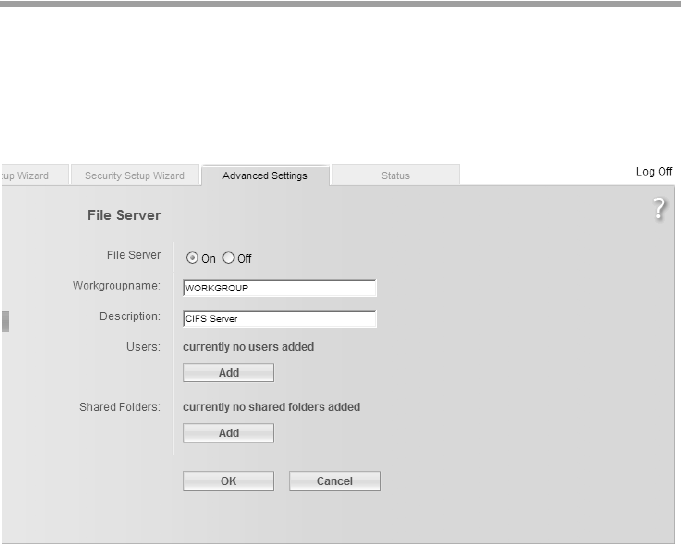
117
Configuring Advanced Settings
Gigaset SX686 WiMAX / eng / A31008-N919-R101-2x-7619 / configure_router.fm / 15.10.2008
Schablone 2005_07_27
Safely Remove Hardware
ìClick this button and wait until any connected USB storage device are fully deacti-
vated before disconnecting them from your device.
ìClick OK to save the changes.
File Server
The devices integrated file server allows you to manage folders and files on a connected
USB mass storage device (for example a USB flash drive or external USB drive) and make
them available to all users in the local network and on the Internet.
Connect a USB data carrier to the Gigaset SX686 WiMAX via the USB port.
ìIn the Advanced Settings menu, select: USB – File Server
I
ìSelect the On option for the File Server.
ìEnter the Workgroup name (WORKGROUP is the standard name for Windows) in
which the file server is located. If you now search your network you will find the file
server in the specified domain / workgroup in the network environment.
ìYou can enter a Description of the file server in the next field.
ìClick Add to define Users who should have access to the File Server.
You have to define at least one use to define shares on the File Server.
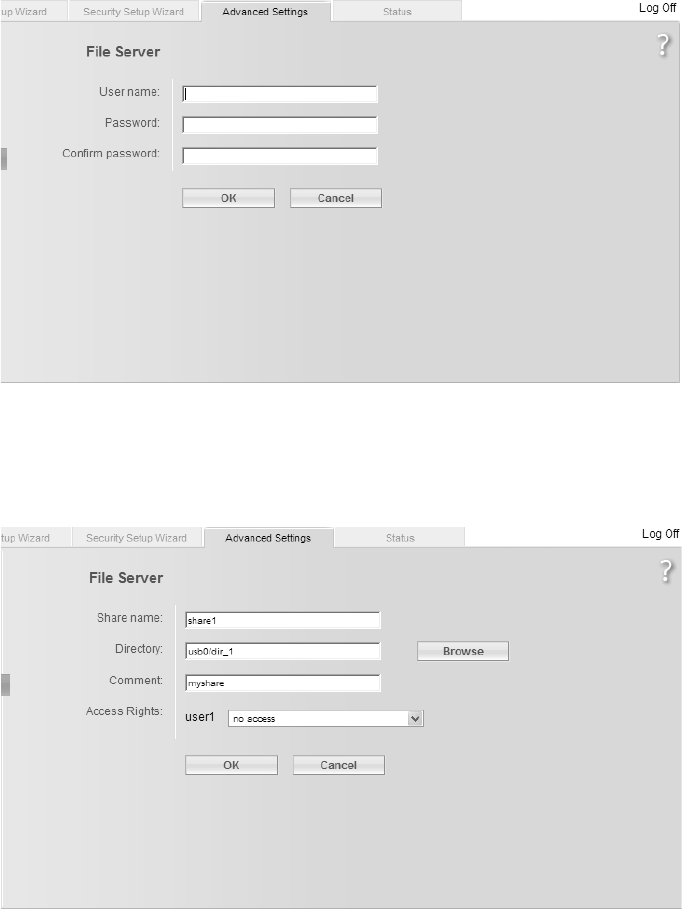
118
Configuring Advanced Settings
Gigaset SX686 WiMAX / eng / A31008-N919-R101-2x-7619 / configure_router.fm / 15.10.2008
Schablone 2005_07_27
ìEnter a User name, a Password, and confirm it in the next line.
ìClick OK.
The File Server start screen is shown again.
ìClick Add to define Shared Folders for the Users defined above.
ìEnter a name for the new file share.
ìChoose the directory for the share via the Browse button.
ìEnter a comment in the next line.
ìClick OK.
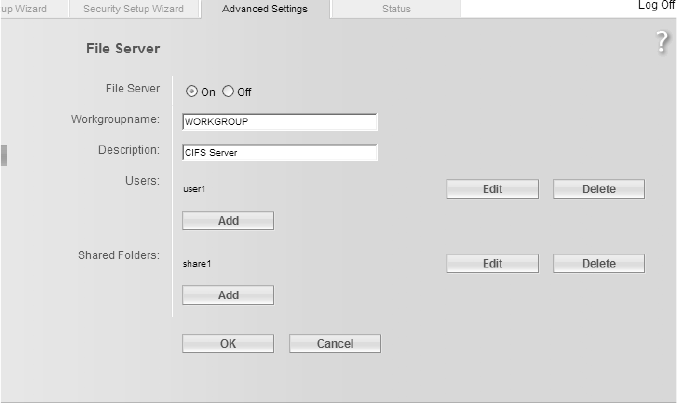
119
Configuring Advanced Settings
Gigaset SX686 WiMAX / eng / A31008-N919-R101-2x-7619 / configure_router.fm / 15.10.2008
Schablone 2005_07_27
Now the users you have defined are displayed.
ìChoose the Access Rights for each user: no access, read-write access, or read-
only access.
ìClick OK.
The File Server start screen is shown again.
ìYou can edit or delete a user by clicking the Edit or Delete button.
ìYou can edit or delete a file share by clicking the Edit or Delete button.
ìClick OK to save your settings.
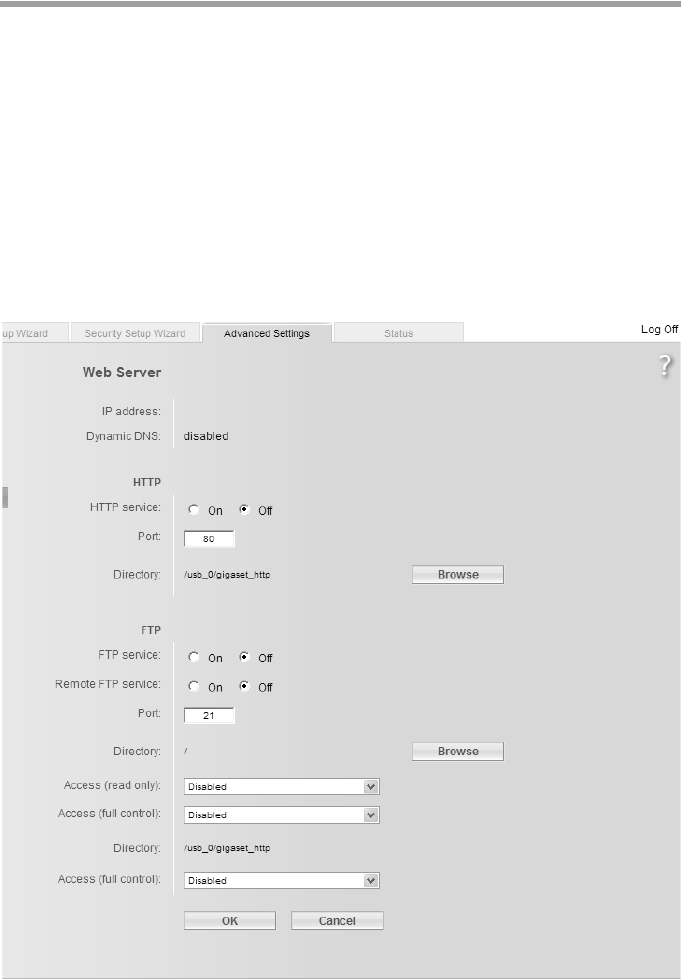
120
Configuring Advanced Settings
Gigaset SX686 WiMAX / eng / A31008-N919-R101-2x-7619 / configure_router.fm / 15.10.2008
Schablone 2005_07_27
Web Server
Your devices integrated Web server allows you to publish data stored on a connected
USB mass storage device (for example a USB flash drive or external USB drive) on the
Internet.
Internet users can access your Web server by entering the public IP address in their Inter-
net browser. As Internet providers often change this each time someone dials in, it is
also worth using dynamic DNS (see page 85).
ìConnect the USB mass storage device containing the data to be published to the USB
port.
You can check the status of the connection to the USB device on the Advanced Settings
– USB screen.
ìIn the Advanced Settings menu, select: USB – Web Server
121
Configuring Advanced Settings
Gigaset SX686 WiMAX / eng / A31008-N919-R101-2x-7619 / configure_router.fm / 15.10.2008
Schablone 2005_07_27
The IP address (see page 88) of the Gigaset SX686 WiMAX is displayed, as well as infor-
mation as to whether Dynamic DNS (see page 85) is activated.
HTTP
HTTP (Hypertext Transfer Protocol) is the standard protocol for transferring data on the
Internet. You can use this to publish your own homepage on the Internet, for example.
ìActivate the HTTP service for your Web server.
ìYou can change the Port via which Internet users can access your data, to mask your
data and protect it from unauthorised users, for example.
ìChoose the Directory in which the data is stored on the USB mass storage device
and which should be shared for Internet access using the Browse button. Please
note that this will share the selected directory and all its subdirectories for Internet
access.
The /usb0/gigaset_http path is shown by default. usb_0 is the partition
number on the USB device. After you have chosen a directory on the USB device, this
will be shown.
Internet users can access the HTTP server as follows:
ìOpen the Internet browser and enter the full address:
http://public_IP_address:[port]/gigaset_http/directory/
start_file
public_IP_address
IP address of the Gigaset SX686 WiMAX assigned by the Internet service provider.
This address is shown on the Status page (see page 136).
If you use a dynamic DNS service (see page 75) enter the domain name given by
your service provider instead of the IP address.
Port
The port 80 is used for the HTTP service by default. Port must only be specified
if another port is used for the HTTP server.
gigaset_http
This is a fixed part of the path and has to be entered always.
directory
Enter the directory in which the HTTP server start file is located on the USB mass
storage device. You have to enter the full directory path of the shared directory.
Example: If the Web server is located in the /usb0/web-server/my_webpage
directory and the / directory is shared, you have to enter this full path. If the
/usb0/web-server/my_webpage is shared, you can start the Web server
without entering the path.
start_file
Enter the name of the HTTP server start file.
122
Configuring Advanced Settings
Gigaset SX686 WiMAX / eng / A31008-N919-R101-2x-7619 / configure_router.fm / 15.10.2008
Schablone 2005_07_27
Example:
The public IP address of your Gigaset SX686 WiMAX is 159.134.4.16. The data is
stored in the /usb_0/WebServer/my_webpage directory and you have shared
the /usb_0/WebServer directory. The start file is index.htm. You use the port
number 51000.
A remote user has to enter the following:
http://159.134.4.16:51000/gigaset_http/my_webpage/index.htm
Or, when using a dynamic DNS service:
http://my.dyndns.com:51000/gigaset_http/my_webpage/index.htm
FTP
FTP (File Transfer Protocol) is a protocol for exchanging files on the Internet. You can use
this to offer files for downloading or to receive files from other users, for example.
ìChoose On for FTP service if you want to make data available in the local network.
PCs in the network access the USB mass storage device via FTP.
To do this, open the Internet browser and enter the following address:
ftp://192.168.2.1
If you have changed the IP address of the Gigaset SX686 WiMAX (see page 88), enter
the new address instead of 192.168.2.1.
ìChoose On for Remote FTP service if you also want to make data available on the
Internet.
Internet users can access your USB mass storage device by entering the public IP
address in the Internet browser. As Internet service providers often change this each
time someone dials in, it is also worth using dynamic DNS (page 85).
ìThe Port field contains the port number via which local PCs and Internet users can
access your data. You should not change the default port number without very good
reason.
If you use a different port number, active FTP mode is no longer possible. FTP clients
must then be converted to passive FTP mode.
ìChoose the Directory in which the data is stored on the USB mass storage device
using the Browse button.
You can allow general access for both FTP services, or only for selected users with a user
name and password.
ìFor Access (read only), select whether all users should be able to read your data in
Anonymous mode or whether only one Specified user should be supported.
ìSpecify whether Access (full control) to your data should be disabled or whether a
Specified user may read, edit and delete your data.
ìEnter the name in the Specified user field. Define different user names for the dif-
ferent access type and directory.
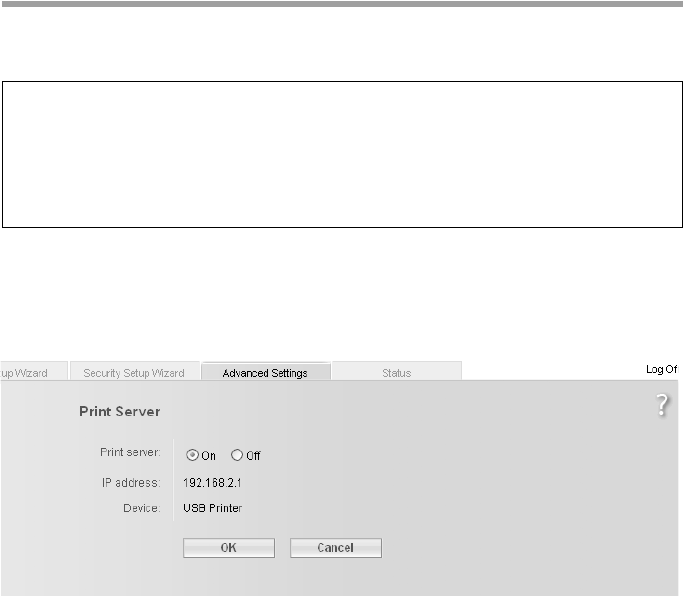
123
Configuring Advanced Settings
Gigaset SX686 WiMAX / eng / A31008-N919-R101-2x-7619 / configure_router.fm / 15.10.2008
Schablone 2005_07_27
ìEnter the password for the user and confirm it by entering it again in the field below.
The password is case-sensitive. Avoid using proper names and obvious terms.
Instead, use upper case and lower case letters, numbers and special characters.
ìClick OK to apply the changes.
Print Server
Your device's integrated print server allows you to provide a USB printer for all users in
the local network.
If you wish to use this function, you must first connect a USB printer to your device's USB
port. The device must be shown in the screen. You can check the status of the connec-
tion to the USB device on the Advanced Settings – USB screen.
ìIn the Advanced Settings menu, select: USB – Print Server
ìActivate your devices integrated print server.
You can set up the connected printer on your PC by using the IP address of the Gigaset
SX686 WiMAX shown here when configuring the printer.
ìClick OK to accept the changes.
You will find information on setting up the printer connected to the Gigaset SX686
WiMAX in the section entitled "Using the USB port" on page 147.
Notes:
uThe Windows Vista, Windows XP or Windows 2000 operating system is a prereq-
uisite for using the print server.
uOnly printer functionality is supported in the case of multifunction devices (com-
bination of printer, scanner or fax). You can obtain additional information by con-
tacting the hotline or else on the Internet (address see Quick Start Guide).

124
Call guide
Gigaset SX686 WiMAX / en / A31008-N919-R101-2x-7619 / telefone.fm / 15.10.2008
Schablone 2005_07_27
Call guide
Your Gigaset SX686 WiMAX allows you to make calls via the Internet (VoIP) and your
fixed line. A description of how to configure your Gigaset SX686 WiMAX for using the
telephone functions is provided under "Telephony" on page 56 and "Setting up Internet
telephony (VoIP)" on page 105.
This chapter describes the function keys on your phone and the Internet telephony set-
tings with which you can use the various telephony options. Please note that the func-
tions described are only fully available if you have configured Internet telephony and
have registered with your service provider.
External connections are calls via your fixed line or via the Internet (VoIP).
Internal connections are calls between the phones connected to the router or calls on
PCs or cordless phones which are registered as software SIP clients on the device.
Making calls
Please note:
With the exception of the first five key combinations, the key combinations specified
in this chapter only apply for telephones on the Phone1 and Phone2 ports. The key
combinations *1 ...*6, **, *99*, *00 and *01 to *06 phone number can also be
entered on a SIP client. Please refer to the operating manual for your SIP client for the
other functions.
Key combination Effect Description
*1 ...*6 Call for an internal
extension
Choose the phone number of the
desired extension (analogue phone or
SIP extension, *1 ...*6) to make an
internal call.
** Call all internal num-
bers
Choose ** to call all internal exten-
sions.
*99* Answer a call from a
different phone
If a call arrives at a different telephone
set or on a port configured as an
answering machine, you can accept
this call on your phone by pressing the
key combination *99*.
*00 Phone number
Switching from VoIP
to fixed network for
a call
To make a call on a VoIP extension via
the fixed network, simply enter *00.
*01 to *06
Phone number
Switching to a VoIP
extension for a call
If you want to make a call on a VoIP or
fixed network extension via a (differ-
ent) VoIP extension, you can use this
VoIP connection by entering *0 and
the number of the desired extension
(1 ... 6) (e.g. *04 for the fourth
extension).

125
Call guide
Gigaset SX686 WiMAX / en / A31008-N919-R101-2x-7619 / telefone.fm / 15.10.2008
Schablone 2005_07_27
Advanced options
The functions described in this section, which are available to you when making calls via
your Gigaset SX686 WiMAX, apply both for external calls and for internal calls. The func-
tions described below are dependent on the connected terminal in the case of VoIP
extensions.
Toggling telephone calls
*31# number Calling line identifi-
cation restriction
Dial *31# before the number if you
want to prevent your number being
displayed to the other party for the
current call.
*51#
Calling line identifi-
cation restriction as
default
Dial *51# to prevent your number
being displayed to the other party per-
manently.
#51#
Cancel calling line
identification restric-
tion as default
You have opted to suppress the display
of your number by default (see
above): Dial #51# to cancel this
default.
Please remember:
When using the signal button R, always wait until you hear a dialling tone before you
enter the phone number for a consultation call or complete the key combination for
the respective function.
Key combination Effect Description
R
Phone number
Consultation
Press R to initiate a consultation with
another phone number during a call.
Dial the desired (internal or external)
number for the consultation.
R2
Accept call waiting/
toggle between two
calls
Press R2 to accept an incoming call
during a call. The connection to the
first call is put on hold.
If you terminate the first call before-
hand, your phone rings and you can
take the second call as usual.
By pressing R2 again, you can toggle
to the waiting caller.
R0 Reject call waiting
Press R0 to reject an incoming call
during a call.
The second call is rejected automati-
cally after 120 seconds have elapsed.
Key combination Effect Description

126
Call guide
Gigaset SX686 WiMAX / en / A31008-N919-R101-2x-7619 / telefone.fm / 15.10.2008
Schablone 2005_07_27
Conference call between three participants
Call answering and forwarding
R1
Terminate one call
and return to the
waiting call
Press R1 to end the current call. You
then switch to the waiting call. The
second call is ended automatically
when you replace the receiver.
Key combination Effect Description
R3 Conference call
When you are making a call and a sec-
ond call is waiting (see above), press
R3 to enable a conference call
between you and the two call parties.
R2
End the conference
call and continue
calls separately
Press R2 to end the conference call.
You are then connected to the previ-
ously active call again and the previ-
ous waiting call is now in the wait
state again.
R4
End conference call
and set up the con-
nection between call
parties
If you press R4 during a conference
call, you end your call and set up a
connection between the other two
external call parties. You can then
replace the receiver. In the case of an
internal conference call, you simply
need to hang up.
End conference call Replace the receiver to terminate all
calls.
Key combination Effect Description
*21*[number]# Forward to internal
phone number
Dial *21*, the desired internal phone
number to which all calls are to be
forwarded that are received on this
extension, and then press the # key.
Example: You want to set up call for-
warding from your phone to a second
internal phone number.
Dial *21**2#.
#21# Delete call forward-
ing
Use the key combination #21# to
delete internal call forwarding, which
you set up as described above.
Key combination Effect Description

127
Call guide
Gigaset SX686 WiMAX / en / A31008-N919-R101-2x-7619 / telefone.fm / 15.10.2008
Schablone 2005_07_27
Call waiting and call reject if busy
*61*[number]#
Call forwarding to
internal number if
absent
Dial *61*, the desired internal phone
number to which all calls are to be
forwarded that are received on this
extension, and then press the #key.
The call is forwarded after 20 seconds
with this key combination.
#61# Delete call forward-
ing if absent
Use the key combination #61# to
delete internal call forwarding (if
absent), which you set up as
described above.
*67*[number]#
Call forwarding to
internal number if
line busy
Dial *67*, the desired internal phone
number to which all calls are to be
forwarded that are received on this
extension, and then press the #key.
The call is forwarded with this key
combination if the line is busy.
#67# Delete call forward-
ing if line busy
Use the key combination #67# to
delete internal and external call for-
warding (if line busy), which you set
up as described above.
#77# Delete all call for-
warding settings
Use the key combination #77# to
delete all call forwarding settings
described above.
*43# Allow call waiting
Use the key combination *43# to
allow call waiting when the line is
busy.
#43# Delete call waiting Dial #43# to disable call waiting if
busy again.
*26# Reject all calls
Use the key combination *26# to
specify that all calls are to be rejected.
This is only possible if call waiting is
disabled.
#26# Delete the reject calls
setting
Use the key combination #26# to
delete the reject all calls setting.
Key combination Effect Description

128
Call guide
Gigaset SX686 WiMAX / en / A31008-N919-R101-2x-7619 / telefone.fm / 15.10.2008
Schablone 2005_07_27
Special functions
Notes:
uIf you additionally enter *# in each case before the key combination shown in the
table, the settings will be forwarded directly to the exchange and will be activated
there.
uThe phone numbers of waiting calls are not displayed even if the caller permits
this.
Key combination Effect Description
*52# Enable
WLAN function
This shortcut key allows the WLAN
function of your Gigaset SX686
WiMAX to be enabled without you
having to open the configuration pro-
gram.
#52# Disable
WLAN function
This shortcut key allows the WLAN
function of your Gigaset SX686
WiMAX to be disabled again.
Note:
This function is only available if Phone-based Management is enabled. For that
purpose open the user interface Advanced Settings – Administration – System
Management screen.

129
Call guide
Gigaset SX686 WiMAX / en / A31008-N919-R101-2x-7619 / telefone.fm / 15.10.2008
Schablone 2005_07_27
Confirmation tones
If you activate a service attribute, for example set up call forwarding, you will hear a pos-
itive confirmation tone if successful and a negative confirmation tone if unsuccessful.
Positive confirmation tone: Ascending tone sequence at 6-second intervals
Negative confirmation tone: Regular sequence of short low-frequency tones
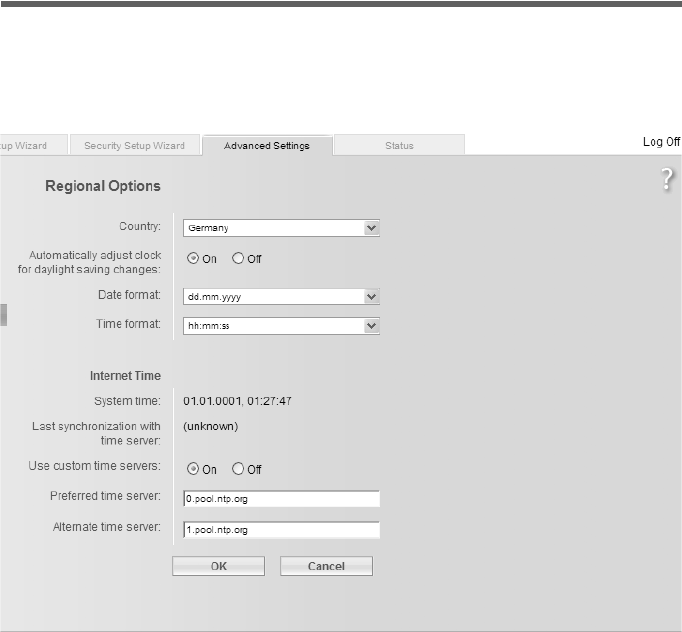
130
Administration
Gigaset SX686 WiMAX / eng / A31008-N919-R101-2x-7619 / admin_router.fm / 15.10.2008
Schablone 2005_07_27
Administration
The Gigaset SX686 WiMAX user interface includes several helpful functions for admin-
istration.
Regional Options
For operating your Gigaset SX686 WiMAX, you can select the location, time zone and
format for entering the time and date, and you can also configure a time server for the
Internet time (system time).
ìIn the Advanced Settings menu, select: Administration – Regional Options
Regional Options Enables regional settings (page 130)
System Password Changes the system password (page 131)
System Management Configures system management (page 132)
Save & Restore Backs up and, if necessary, restores configuration data
(page 133) or reset the Gigaset SX686 WiMAX to the factory
settings (page 134)
Reboot Reboots the device (page 134)
System Log Configures settings for the system log (page 135)
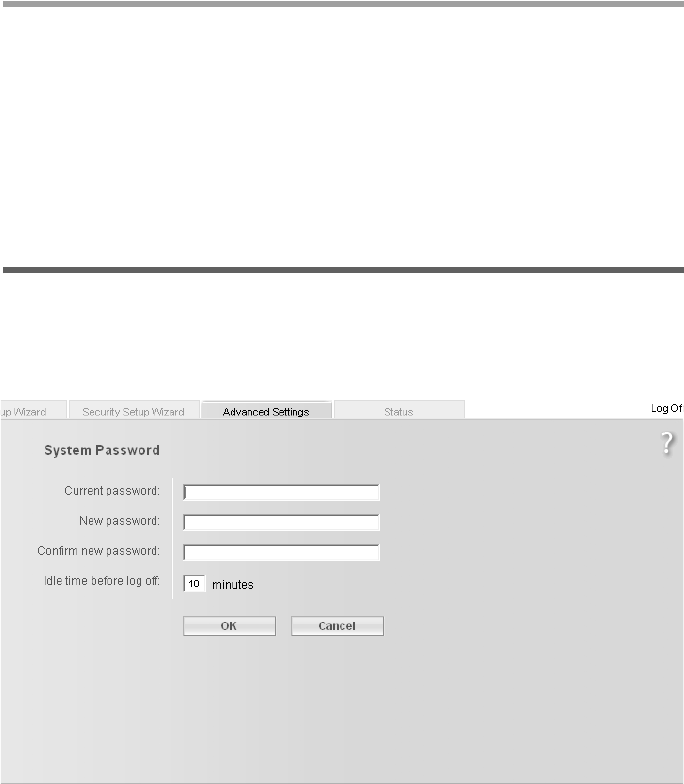
131
Administration
Gigaset SX686 WiMAX / eng / A31008-N919-R101-2x-7619 / admin_router.fm / 15.10.2008
Schablone 2005_07_27
ìSelect the country you are currently in from the list. You can set the time so that it
automatically switches to summer time or the Time zone, as required.
If you have already configured the basic settings, you can change these here.
ìSelect the required option or choose the Time zone for your location.
ìSelect the required format for entering the date and time from the Date format and
Time format lists.
Internet Time
The System time of the device is automatically synchronised with the time server on
the Internet. The time of the Last synchronization with time server is displayed for
your information.
ìIf you would like to use your own time server, activate the On option next to the Use
custom time servers field.
ìEnter the Internet address of the time server in the Preferred time server or Alter-
nate time server fields.
ìClick OK to apply the settings.
System Password
You can assign a System Password to the Gigaset SX686 WiMAX user interface and spec-
ify the period after which a session is to be automatically ended if no further entry is
made.
ìIn the Advanced Settings menu, select: Administration – System Password
After installation, the Gigaset SX686 WiMAX user interface is protected by the
System Password admin. To prevent unauthorised changes being made to the configu-
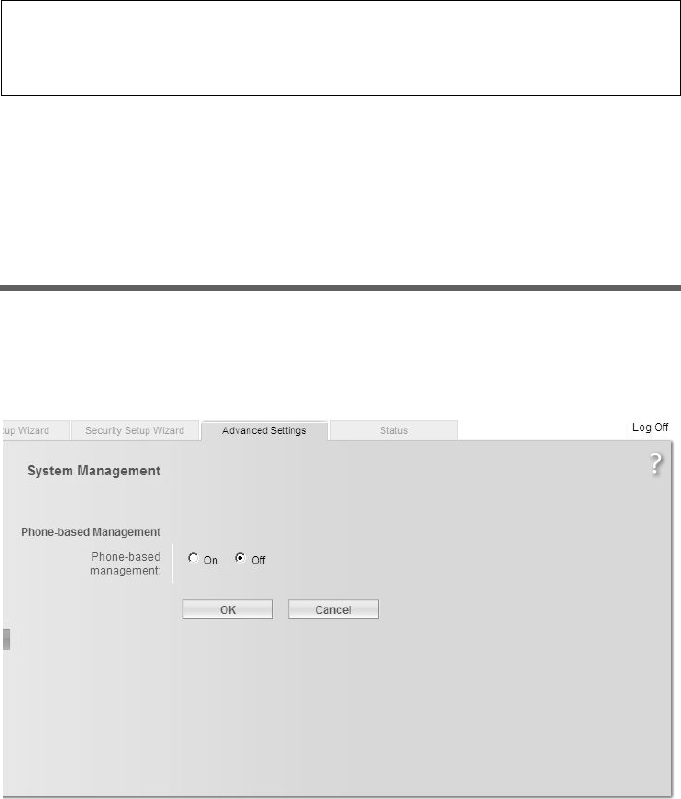
132
Administration
Gigaset SX686 WiMAX / eng / A31008-N919-R101-2x-7619 / admin_router.fm / 15.10.2008
Schablone 2005_07_27
ration, you should set a new System Password from time to time. You may already have
set a System Password when you set up the Security Setup Wizard. If so, you can
change it here.
ìEnter the old System Password in the Current password field.
ìEnter a new System Password in the New password field and repeat it in the
Confirm new password field.
The System Password may contain up to 20 characters. The System Password is case
sensitive. Avoid proper names and all too obvious words. Use a combination of letters,
digits and special characters.
Idle time before log off:
ìEnter the number of minutes after which the configuration program is to be ended
if no further entry is made. The default is 10 minutes. If you enter 0, the program
will never be ended automatically.
ìClick OK to apply the settings.
System management
Your Gigaset SX686 WiMAX provides you with the option of switching the WLAN func-
tion of the device on and off via one of the connected phones. On this screen you can
activate or deactivate this feature.
ìIn the Advanced Settings menu, select: Administration – System Management
Note
If you forget your System Password, you have to reset the Gigaset SX686 WiMAX
(page 16). This returns all your settings to the factory configuration. This means the
system password is changed back to admin.
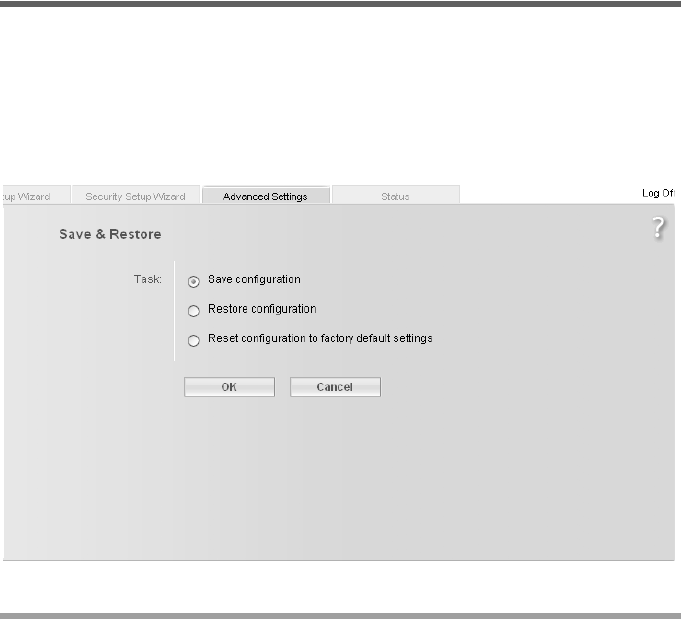
133
Administration
Gigaset SX686 WiMAX / eng / A31008-N919-R101-2x-7619 / admin_router.fm / 15.10.2008
Schablone 2005_07_27
Phone-based Management
ìClick On to activate Phone-based Management.
You can activate or deactivate the WLAN function (page 128) via phone.
ìClick OK to accept the settings.
Backing up and restoring a configuration
When the Gigaset SX686 WiMAX has been configured, it is recommended that you back
up the settings. This means you can restore the settings at any time if they are acciden-
tally deleted or overwritten.
You can also reset the configuration to the factory settings. You should always do this
before handing the device to an external person.
ìIn the Advanced Settings menu, select: Administration – Save & Restore
Backing up configuration data
ìFor Task, activate the Save configuration option.
ìClick OK.
You can then set the location in which the backup file is to be saved in a file selection
window.
ìSelect a local directory on your PC where you want to save the configuration file and
enter a file name.
ìClick Save.
The current configuration data is now saved in the specified file.
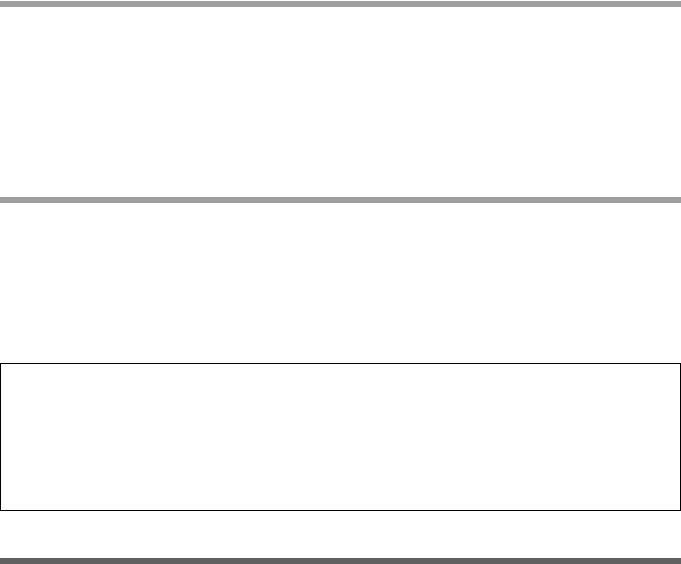
134
Administration
Gigaset SX686 WiMAX / eng / A31008-N919-R101-2x-7619 / admin_router.fm / 15.10.2008
Schablone 2005_07_27
Restoring the saved data
ìFor Task, activate the Restore configuration option.
ìEnter the path of the backup file that you want to use to restore the configuration
or choose the file in the file system via the Browse button.
A window will appear prompting you to confirm the procedure.
ìClick OK. The configuration will now be updated.
Restoring factory settings
You can reset the Gigaset SX686 WiMAX to the factory settings. You should do this
before making the device available to others or exchanging it through the dealer. Oth-
erwise unauthorised persons may use the Internet access data at your expense.
ìSelect Reset configuration to factory default settings and click OK.
A window will appear prompting you to confirm the procedure.
Reboot
If the Gigaset SX686 WiMAX is not operating properly, you can reboot it. It should then
be ready for use again.
ìIn the Advanced Settings menu, select: Administration – Reboot
ìClick OK to reboot the device.
A window will appear prompting you to confirm the procedure.
Note:
If the Gigaset SX686 WiMAX is not operating properly, you can reboot it. It should then
be ready for use again (page 16).
Please remember that when the device is fully reset, all the configuration settings are
returned to the factory settings. This means that you will have to completely reconfig-
ure the Gigaset SX686 WiMAX.
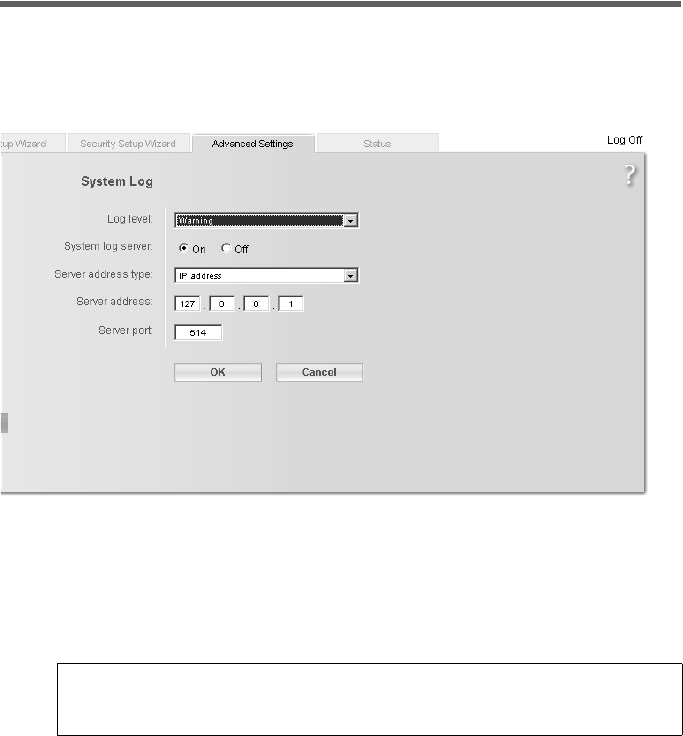
135
Administration
Gigaset SX686 WiMAX / eng / A31008-N919-R101-2x-7619 / admin_router.fm / 15.10.2008
Schablone 2005_07_27
System Log
The System Log is displayed in the Status – Device menu. It contains important infor-
mation about how the device functions and possible problems. This information can
also be automatically transferred to a system log server.
ìIn the Advanced Settings menu, select: Administration – System Log
ìLog level: Specify how much information is to be contained in the system log. You
can choose between four levels:
–Critical: Log file of the most important information for possible device function-
ality problems.
–Warning and Informational are intermediate levels.
–Debugging: Complete and detailed information on all device functions
ìSystem log server
– Activate this function if the device system log is to be automatically transferred
to a system log server in the local network.
–Server address type
Choose if you want to enter the server address as IP address or domain name.
–Server address
Enter the IP address or the domain name for the system log server.
–Server port:
Enter the port of the system log server that is to be used to transfer the system
log.
ìClick OK to save and apply the changes.
Please remember:
Setting the log level Debugging can generate enormous load on the system
and thus impair the data throughput of the device.

136
Status information
Gigaset SX686 WiMAX / eng / A31008-N919-R101-2x-7619 / admin_router.fm / 15.10.2008
Schablone 2005_07_27
Status information
Information about configuration and the status of the Gigaset SX686 WiMAX is dis-
played in the Status menu of the Gigaset SX686 WiMAX. On the first screen you will find
an overview of the status of the WiMAX connection, the Internet connection, the local
and wireless network, the telephony, the USB interface and the device.
Detailed information is available on the following status screens:
uSecurity
uRadio Status
uInternet
uLocal Network
uWireless Network
uTelephony
uDevice
uAlarms
To display a status screen:
ìSelect Status in the start screen.
ìSelect the entry with the information you require.
Overview
On the first screen you will find an overview of the current operating status and the
most important device data.
WiMAX
uConnection status
The status of the connection to the WiMAX network (Connected with base station
or Disconnected)
Internet
uConnection status
The status of the Internet connection and, if connected, the duration of the connec-
tion.
uIP address
The public IP address of the device.
Local network
uIP address
The local IP address of the device.
uDHCP Server
The status of the DHCP server of the device and, if activated, the number of clients
in the network that have been assigned an IP address.

137
Status information
Gigaset SX686 WiMAX / eng / A31008-N919-R101-2x-7619 / admin_router.fm / 15.10.2008
Schablone 2005_07_27
Wireless network
uStatus
The status of the wireless network connection of the device and, if activated, the
number of clients in the wireless network connected to the device.
uSSID
The wireless network ID.
uRegistration Button
Shows if the registration button (Scan button) on the device’s back panel is enabled
or disabled.
Telephony
uVoIP accounts
Shows the number of VoIP accounts and the connection status.
USB
uStatus
Status of the USB connection of the device. It can be enabled (On) or disabled (Off).
Additionally, the occurrence of the following problems is displayed:
USB device not supported or not recognized.
USB device not supported (the device exceeds the power consumption limit).
Device
uSystem time
The system time of the device.
uFirmware version
The firmware version currently installed on the device.
ìClick Refresh to refresh this screen and update the displayed data.
Security
You will find information about possible security risks for the device and the network on
the Security screen in the Status menu.
ìIn the Status menu, select Security:
uSystem password not changed
The configuration program of the device is not sufficiently protected against unau-
thorised access because you have not changed the system password since setting up
the device. Information on how to avoid this security risk is given in the section "Sys-
tem Password" on page 131.

138
Status information
Gigaset SX686 WiMAX / eng / A31008-N919-R101-2x-7619 / admin_router.fm / 15.10.2008
Schablone 2005_07_27
uIdentification of your wireless network visible or not changed
Unauthorised users can also find the wireless network easily as you have not
changed the ID of the wireless network (SSID) since setup and have not deactivated
SSID broadcasting. Information on how to avoid this security risk is given in the sec-
tion "Configuring wireless connections" on page 91.
uEncryption for your wireless network not activated
None of the data in the wireless network is encrypted during transfer and can there-
fore easily be intercepted. Unauthorised users will also have easy access to your net-
work, your PCs and your Internet connection. Information on how to avoid this secu-
rity risk is given in the section "Setting encryption" on page 94.
uAccess to your wireless network not restricted to allowed clients
Users can access the wireless network from any PC. Information on how to avoid this
security risk is given in the section "Permitted clients" on page 101.
uFirewall for your Internet connection turned off
The network is not protected against hackers who gain unauthorised access via the
Internet. Information on how to avoid this security risk is given in the section "Fire-
wall" on page 76.
uAddress translation for your Internet connection turned off
The clients in the network are not protected against unauthorised access via the
Internet. Information on how to avoid this security risk is given in the section "Set-
ting up the NAT function" on page 80.
uOne or more of your local clients directly exposed to the Internet
At least one client in the network is directly visible on the Internet as an exposed host
and is therefore particularly exposed to the risk (e.g. through hacker attacks). Only
activate this function if it is absolutely necessary (e.g. to operate a Web server) and
other functions (e.g. Port forwarding) are not suitable. In this case, you should take
the appropriate measures on the clients concerned. Information on how to avoid
this security risk is given in the section "Opening the firewall for a selected PC
(Exposed Host)" on page 84.
ìClick Refresh to refresh the screen and the displayed data.
Radio Status
Information about received and sent data as well as possible data transmission errors is
displayed in the Radio Status submenu.
uReceived power level
Range: from –30 dBm to –90 dBm
Readings above –30 dBm indicate possible traffic on the RF interface, and in this
case all other measured values are invalid. Averaging is carried out according to the
standard.
uTransmitted power level
Current transmission power.

139
Status information
Gigaset SX686 WiMAX / eng / A31008-N919-R101-2x-7619 / admin_router.fm / 15.10.2008
Schablone 2005_07_27
uCarrier to interference and noise ratio
CINR = Carrier to Interference plus Noise Ratio. The CINR calculation is based on the
value of the downlink measurement. Averaging is carried out according to the
standard.
uCurrent uplink channel center frequency
Currently used uplink frequency. The reading changes frequently during the meas-
urement.
uCurrent downlink channel center frequency
Currently used downlink frequency. The reading changes frequently during the
measurement.
uCurrent channel size
Currently used bandwidth.
uRadio port uplink current average throughput
Average approximate uplink throughput in 1 second, moving average (5 samples).
uRadio port downlink current average throughput
Average approximate downlink throughput in 1 second, moving average
(5 samples).
uCurrent uplink modulation scheme
Currently used uplink modulation type.
uCurrent downlink modulation scheme
Currently used downlink modulation type.
ìClick Refresh to refresh the screen and the displayed data.
Internet
You will find information about the status of the Internet connection of the device on
the Internet screen in the Status menu.
ìIn the Status menu, select Internet:
uConnection services
You can select the Connection service, for which the following information is to be
displayed.
This information is not displayed if you only set up one connection service.
uConnection status
Shows the status of the Internet connection and, if connected, the duration of the
connection. If you have set Connect on demand or Connect manually as the con-
nection mode (page 72), you can Connect or Disconnect the connection to the
Internet manually here.
uConnection mode
Shows the connection mode set for connecting to the Internet.

140
Status information
Gigaset SX686 WiMAX / eng / A31008-N919-R101-2x-7619 / admin_router.fm / 15.10.2008
Schablone 2005_07_27
uIP address
Shows the current public IP address of the device.
uMAC address
Shows the public MAC address of the device.
uDefault gateway
Shows the IP address of the assigned default gateway.
uPreferred DNS server
Shows the IP address of the assigned DNS server.
uAlternate DNS server
Shows the IP address of the alternate DNS server, if available.
uDownstream rate
Shows the current transmission rate for incoming traffic.
uUpstream rate
Shows the current transmission rate for outgoing traffic.
uPPPoE pass-through
Shows the status of PPPoE pass-through for the WiMAX connection for establishing
an Internet connection directly between a PC and the network.
uAddress Translation (NAT)
Shows the status of the NAT (Network Address Translation) for the Internet connec-
tion.
uDynamic DNS
Shows the status of the configuration for dynamic DNS. If dynamic DNS is set up, the
name of the provider is shown.
ìClick Refresh to refresh this screen and update the displayed data.
Local Network
You will find information about the local network settings on the Local Network screen
in the Status menu.
ìIn the Status menu, select Local Network:
uIP address
Shows the local IP address of the device.
uSubnet mask
Shows the subnet mask used in the local network.
uMAC address
Shows the local MAC address of the device for wired data transfer.

141
Status information
Gigaset SX686 WiMAX / eng / A31008-N919-R101-2x-7619 / admin_router.fm / 15.10.2008
Schablone 2005_07_27
uDHCP Server
–Status
Shows the status of the DHCP server of the device for automatic assignment of IP
addresses to clients in the local network.
–DHCP clients
Shows all the clients in the network that have been assigned an IP address. The
Host name and the MAC address are listed to identify each client. Information
is also provided about the IP address assigned to each client and about the Lease
time for the IP address, i.e. the length of time before the current IP address
becomes invalid and the client is assigned a new address by the DHCP server.
ìClick Refresh to refresh this screen and update the displayed data.
Wireless Network
You will find information about the wireless network settings on the Wireless Network
screen in the Status menu.
ìIn the Status menu, select Wireless Network:
uStatus
Shows the status of the connection between the device and the wireless network.
uSSID
Shows the wireless network ID.
uChannel
Shows the radio channel that is currently being used for data transfer in the wireless
network.
uMAC address
Shows the local MAC address of the device for wireless data transfer.
uWireless clients
Shows all clients in the wireless network that are currently connected to the device.
The Host name, MAC address and IP address are specified for identifying each cli-
ent. You will also see information about the Uptime to date of the current connec-
tion for each client in the wireless network.
uRepeater (WDS)
–Status
Shows the status of the WDS (Wireless Distribution System) in the wireless net-
work for increasing the range.
ìClick Refresh to refresh this screen and update the displayed data.

142
Status information
Gigaset SX686 WiMAX / eng / A31008-N919-R101-2x-7619 / admin_router.fm / 15.10.2008
Schablone 2005_07_27
Telephony
You will find information about the VoIP accounts and phone call statistics on the
Telephony screen in the Status menu.
ìIn the Status menu select Telephony:
uVoIP accounts
Shows the number of VoIP accounts and the connection status.
uSIP client accounts
All WLAN handsets or other SIP clients currently set up as extensions in your local
network are displayed. The user name and internal phone number of each SIP user
account are displayed for identification purposes. In addition, you are shown infor-
mation about the status of the respective account.
ìClick Refresh to refresh this screen and update the displayed data.
Device
You will find the most important device data on the Device screen in the Status menu.
ìIn the Status menu, select Device:
uSystem uptime
Show's your device's operating time since the last time the system was started.
uSystem time
Shows the system time for your device.
uFirmware version
Shows the firmware version currently installed on your device.
uMAC version
Indicates the internal version of the installed MAC layer. The MAC layer is part of the
system software. During a software upgrade of the modem a new MAC layer might
also be installed.
uBootcode version
Shows the version of the bootcode currently installed on your device.
uConfiguration file version
Shows which configuration file is loaded.
uCalibration date
Shows the date when the device was manufactured and calibrated.
uWireless driver version
Shows the version of the WLAN driver currently installed on the device.
Note:
All data will be lost if there is a power failure.

143
Status information
Gigaset SX686 WiMAX / eng / A31008-N919-R101-2x-7619 / admin_router.fm / 15.10.2008
Schablone 2005_07_27
uUser interface version
Shows the version of the user interface currently installed on the device.
uHardware version
Shows your device's hardware version.
uSerial number
Shows your device's serial number.
uDevice Temperature
Shows the current temperature inside the device in degrees Celsius (°C). This tem-
perature should be below 75°C. In the event of overheating, the Gigaset SX686
WiMAX switches off.
uSystem Log
The system log contains important information about how the device functions and
possible problems. You can adapt the scope of the system log to suit your require-
ments (see "System Log" on page 135).
ìClick Refresh to refresh this screen and update the displayed data.
Alarms
The Gigaset SX686 WiMAX provides two kinds of alarm information for the WiMAX net-
work:
uFunctional Alarms
Conditions such as insufficient link quality that is affecting throughput, failure to
obtain network access or servers unavailable in the backbone are indicated in this
group. These alarms together with their detailed description in the error log will pin-
point the fault. These conditions may result in "bad" Internet connections, lag or
complete failure to access the Internet.
Transient Alarms, such as the Overtemperature condition, are a special kind of
functional alarm indicating a non-durable condition.
uPhysical Alarms
Physical alarms always indicate a failure that cannot be repaired at the end-user or
admin site. The device has to be returned to the supplier service for repair or replace-
ment.
A physical alarm is always indicated by a permanently lit red Status LED (see
page 14).
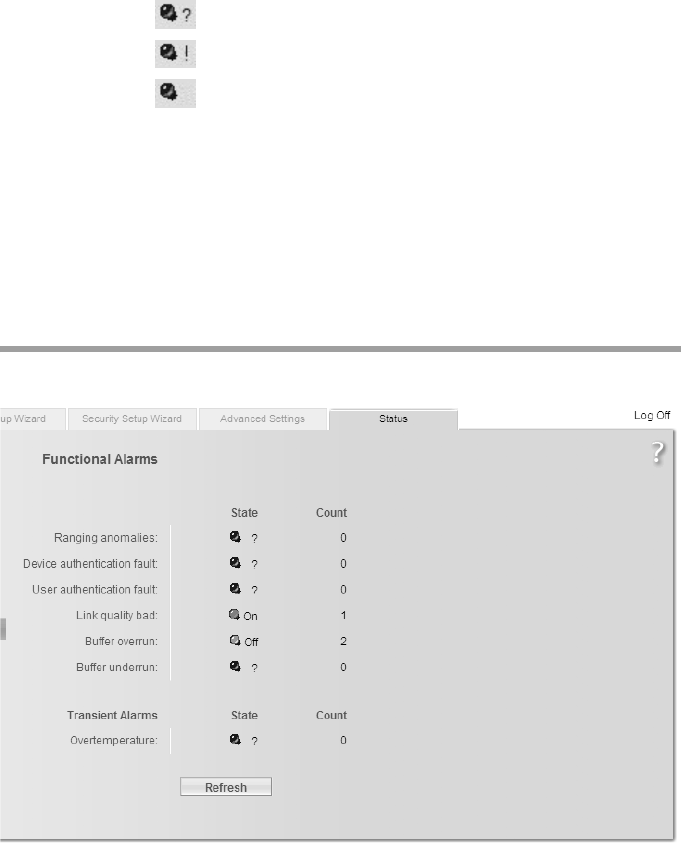
144
Status information
Gigaset SX686 WiMAX / eng / A31008-N919-R101-2x-7619 / admin_router.fm / 15.10.2008
Schablone 2005_07_27
Alarm display in the user interface
The alarm screens show the following information for each alarm:
Functional Alarms
ìIn the Status menu, select Alarms – Functional Alarms:
Alarm indication describes the alarm.
State shows the current state of the alarm by means of a coloured symbol.
Grey Unknown
Red Active
Green Inactive
The symbols always show a snapshot of the situation at query time.
Count indicates how often the alarm has occurred since the last alarm
reset.
Functional alarms: You can reset the value by powering off the
device and restarting it.
Physical alarms: The alarm counters can only be set to zero by the
service technician.
145
Status information
Gigaset SX686 WiMAX / eng / A31008-N919-R101-2x-7619 / admin_router.fm / 15.10.2008
Schablone 2005_07_27
uRanging anomalies
Communication to the base station is impaired as it is either too far away or the link
quality is bad.
uDevice authentication fault
The device authentication failed. No operation is possible.
uUser authentication fault
The user authentication failed. No operation is possible.
uLink quality bad
The Received Signal Strength Indication (RSSI) or Carrier to Noise Ratio (CNR) is
below the configured threshold or the Packet Error Rate (PER) is above the specified
threshold. This indicates that the link quality is below the expected quality.
uBuffer overrun
Packets have been lost since all buffers were in use.
uBuffer underrun
Packets have been lost since no ready buffer was available.
uOvertemperature
An overtemperature condition was detected. During overtemperature traffic is
reduced in order to reduce power dissipation and heat.
ìClick Refresh to refresh this screen and update the displayed data.
ìImprove link. For helpful information please consult the sections "Aligning the
antenna", "Searching a WiMAX network" and "Antenna fine tuning" from
page 48.
ìCheck the configuration and the service level agreement with your provider.
ìCheck the configuration and the service level agreement with your provider.
ìImprove link. For helpful information please consult the sections "Aligning the
antenna", "Searching a WiMAX network" and "Antenna fine tuning" from
page 48.
ìCheck your provider’s service level agreement.
ìCheck the service level agreement with your provider.
ìWait until the device has cooled down and normal operation continues. Check
if venting holes are blocked. Find better/cooler position for your device.

146
Status information
Gigaset SX686 WiMAX / eng / A31008-N919-R101-2x-7619 / admin_router.fm / 15.10.2008
Schablone 2005_07_27
Physical Alarms
ìIn the Status menu, select Alarms – Physical Alarms:
uRF PHY broken
The RF chip for proper WiMAX communication is failing.
uAuxiliary data broken
Vital data for proper operation is missing. This information can only be stored by the
supplier.
ìClick Refresh to refresh this screen and update the displayed data.
The alarm counters can be set to zero only by the service technician activating a service
reset.
ìReplace the device.
ìRecalibrate the device.

147
Using the USB port
Gigaset SX686 WiMAX / en / A31008-N919-R101-2x-7619 / printer.fm / 15.10.2008
Schablone 2005_07_27
Using the USB port
Your Gigaset SX686 WiMAX is equipped with a USB port that can be used, for example,
to connect a printer for use as a network printer or a USB mass storage device for use as
a file server. This chapter describes which settings you have to define on your computer
to use these functions.
Installing the printer port for network printers
The Windows Vista, Windows XP or Windows 2000 operating system is a prerequisite
for connecting a printer under Windows.
Introduction
A network printer is a printer on which you can print your documents without it being
connected to your PC, for example to LPT1, the parallel interface. The advantage of this
is that you only need this printer once in your network. All PCs for which it is released
can access it and work with it.
In most cases, a printer of this type is connected to another PC in the network. While this
offers the advantage referred to above, it has serious disadvantages:
uThe printer can only be used by others if the PC to which it is connected is switched
on.
uThe print job you send to the PC to which the printer is connected reduces the per-
formance (resources) of this PC.
If you use the USB port on the Gigaset SX686 WiMAX for your printer, you have all the
advantages of a network printer without the disadvantages referred to above:
uThe network, and consequently also the printer, is always ready (the Gigaset SX686
WiMAX and the printer itself must be switched on, of course).
uAs it is connected to the USB printer port on your Gigaset SX686 WiMAX, it does not
detract from the performance of any other PC in the network.
To facilitate this option you must first set up a printer port on each PC that is to use the
network printer. A printer port is an interface on the PC that forwards the print job to an
IP address within the network.
Once you have set up this port you must install the printer driver.
Note:
Depending on operating system variants and individual settings the procedures
described may differ from your given facts. Follow the instructions of your operating
system, if applicable.
Note:
For multi-function devices (combination of printer, copier or fax) only the printer
functionality is supported.
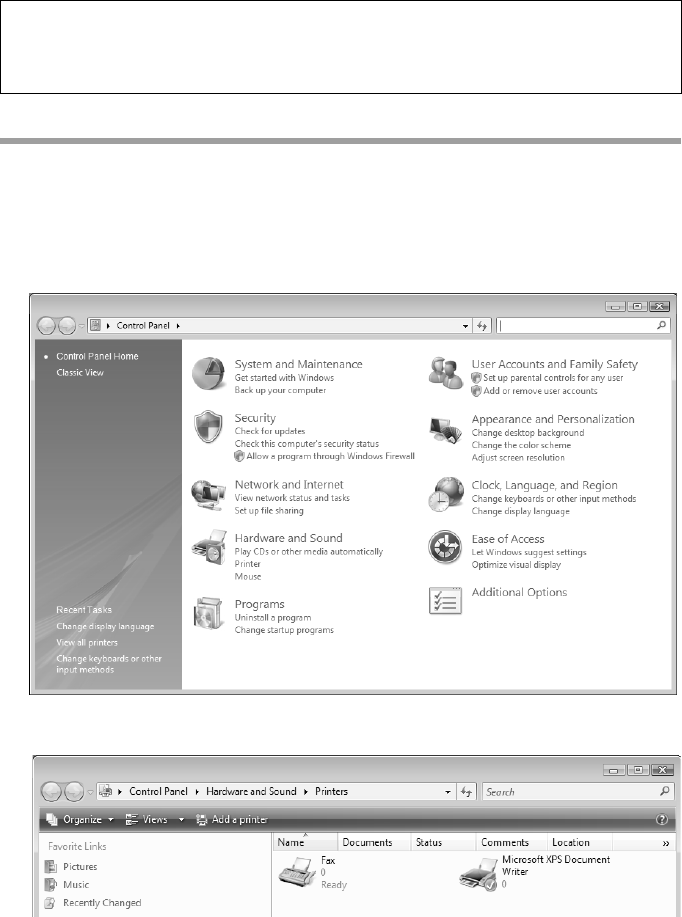
148
Using the USB port
Gigaset SX686 WiMAX / en / A31008-N919-R101-2x-7619 / printer.fm / 15.10.2008
Schablone 2005_07_27
Installing a standard TCP/IP printer port under Windows Vista
You can use the standard TCP/IP port driver available with this operating system. Make
sure that the Gigaset SX686 WiMAX is connected and is available in the network. A
printer does not have to be connected to the USB port on your Gigaset SX686 WiMAX at
this point.
ìClick Start – Control Panel.
ìIn the window that opens, click Hardware and Sound followed by Printer.
ìClick Add a printer.
Note:
Before starting to set up the printer please make sure that a printer is connected to the
USB port of the Gigaset SX686 WiMAX and that the printer has been identified. You
can check this in the user interface via Advanced Settings – USB – Print Server.
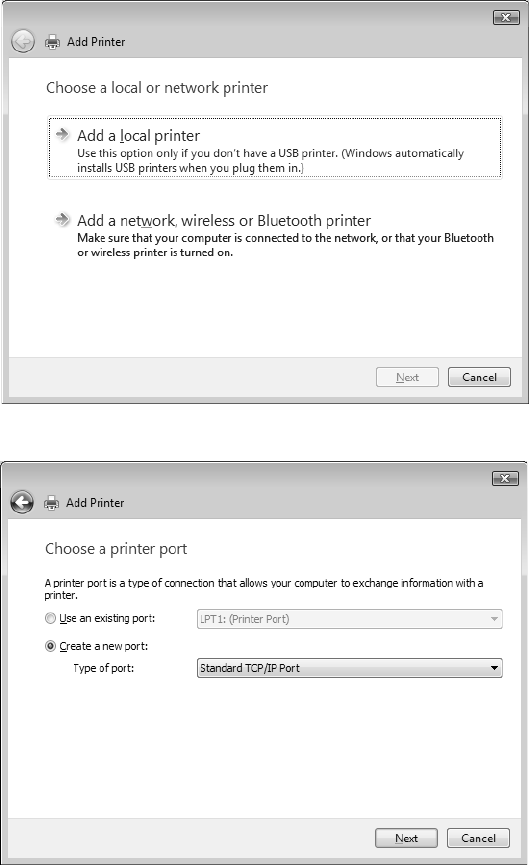
149
Using the USB port
Gigaset SX686 WiMAX / en / A31008-N919-R101-2x-7619 / printer.fm / 15.10.2008
Schablone 2005_07_27
ìIn the Add Printer Wizard, click the option Add a local printer.
ìSelect the Create a new port option button.
ìThen select Standard TCP/IP Port from the selection menu in the field Type of Port.
ìClick Next.
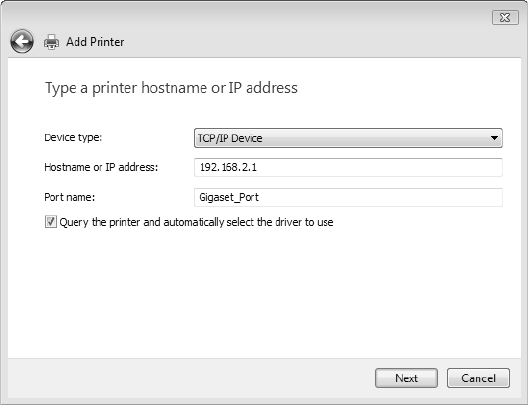
150
Using the USB port
Gigaset SX686 WiMAX / en / A31008-N919-R101-2x-7619 / printer.fm / 15.10.2008
Schablone 2005_07_27
ìChoose TCPI/IP as Device type.
ìIn the Host Name or IP Address input field, enter the IP address of the printer server
(Gigaset SX686 WiMAX): e.g. 192.168.2.1.
This entry is transferred into the Port Name field. This name will later appear in the list
of printer ports.
ìTo change the name, click in the Port Name field and enter a name. Name this port,
for example, Gigaset_Port.
ìClick Next.
As Windows Vista usually first looks for a network card when a printer port is installed,
the Additional Port Information Required window is displayed.
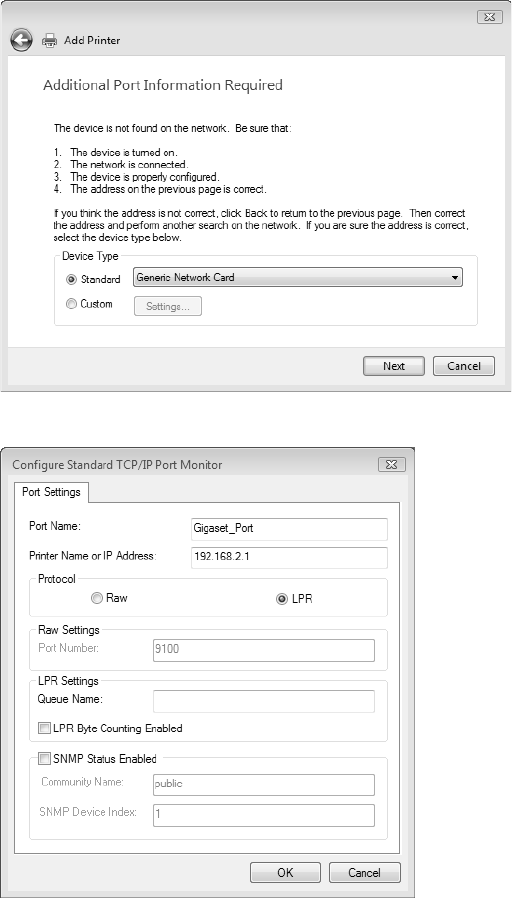
151
Using the USB port
Gigaset SX686 WiMAX / en / A31008-N919-R101-2x-7619 / printer.fm / 15.10.2008
Schablone 2005_07_27
ìSelect the Custom option and click on Settings.
ìSelect the LPR option box.
ìFor Queue name enter lp0 (lower case: lima, papa, number 0).
ìLPR Byte Counting Enabled should not be selected.
ìClick on OK and then on Next.
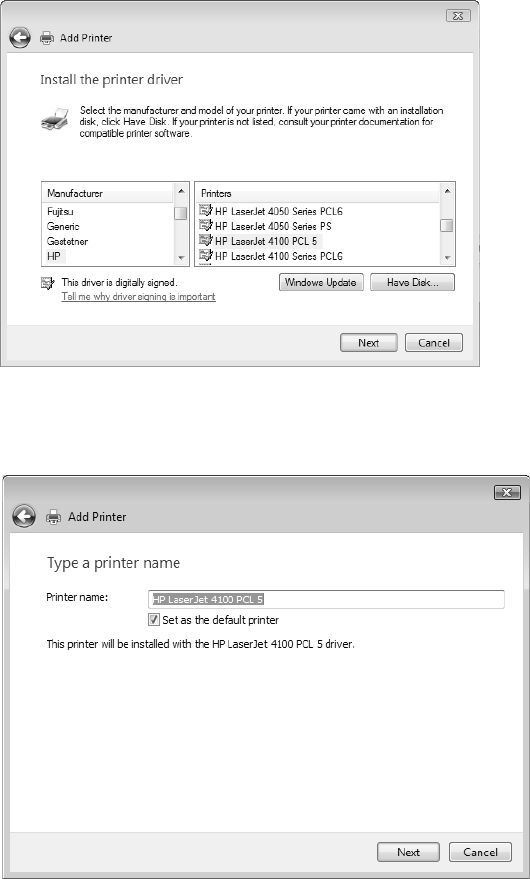
152
Using the USB port
Gigaset SX686 WiMAX / en / A31008-N919-R101-2x-7619 / printer.fm / 15.10.2008
Schablone 2005_07_27
Windows is searching for the appropriate driver model.
ìChoose the appropriate driver for your printer and click on Next.
After successfully installing the driver you can now define a name for your printer. This
is the name which is used to display the printer in the printer list.
ìEnter a printer name and select the option Set as the default printer.
ìClick Next.
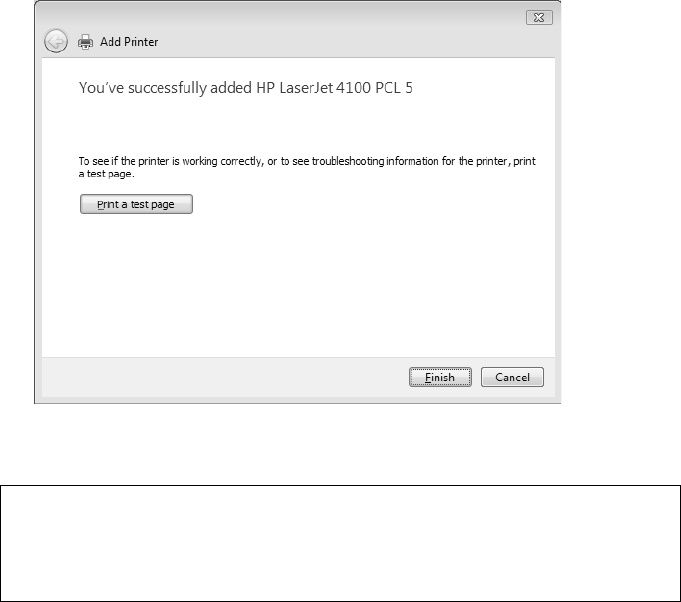
153
Using the USB port
Gigaset SX686 WiMAX / en / A31008-N919-R101-2x-7619 / printer.fm / 15.10.2008
Schablone 2005_07_27
ìClick the button to print a test page.
ìClick Finish.
Note:
The printer server of the Gigaset SX686 WiMAX does not work bi-directionally. It does
not evaluate any of the printer's response messages. For this reason please make sure
that your printer is also only configured uni-directionally. You can configure the rele-
vant settings for your printer by choosing Start – Settings – Printers.
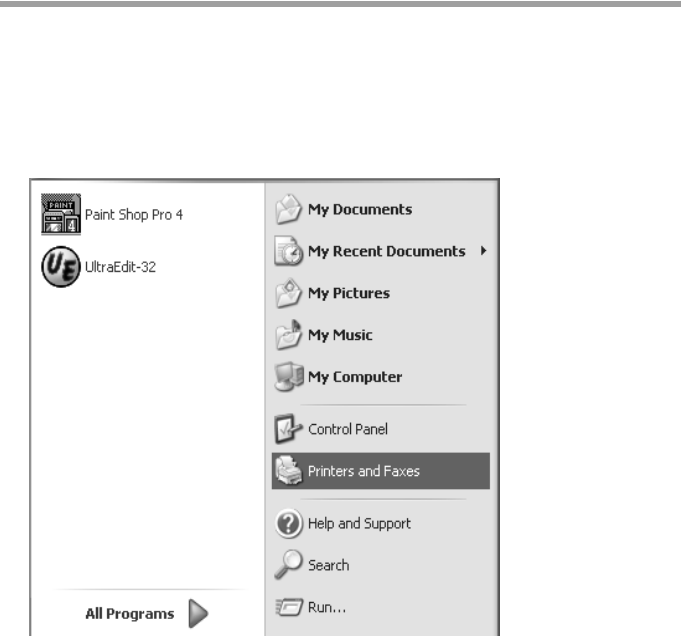
154
Using the USB port
Gigaset SX686 WiMAX / en / A31008-N919-R101-2x-7619 / printer.fm / 15.10.2008
Schablone 2005_07_27
Installing a standard TCP/IP printer port under Windows XP/2000
You can use the standard TCP/IP port driver available in this operating system. Make sure
that the Gigaset SX686 WiMAX is connected and can be reached in the network. A
printer need not be connected to the USB port on your Gigaset SX686 WiMAX at this
point. The following illustrations show installation on Windows XP. Installation on Win-
dows 2000 is essentially the same.
ìClick Start and in the window that opens click Printers and Faxes.
ìIn the window that opens, double-click Add a printer.
The wizard for installing a printer is opened.
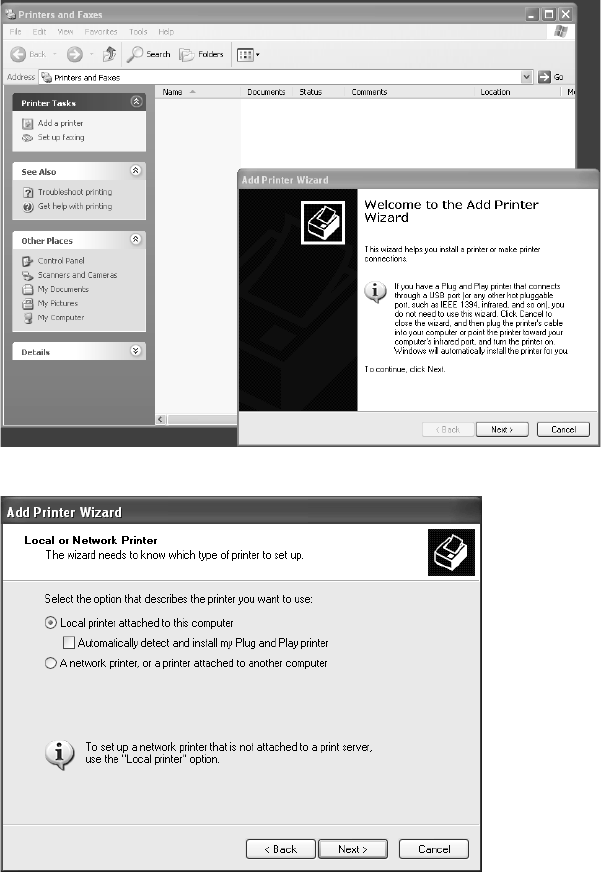
155
Using the USB port
Gigaset SX686 WiMAX / en / A31008-N919-R101-2x-7619 / printer.fm / 15.10.2008
Schablone 2005_07_27
ìIn the Add Printer Wizard, click Next.
The printer port you are installing will behave like an additional parallel port on the
PC. For this reason you must click the option button next to Local printer in this win-
dow.
The Automatically detect and install my Plug and Play printer check box must
not be selected.
ìClick Next.
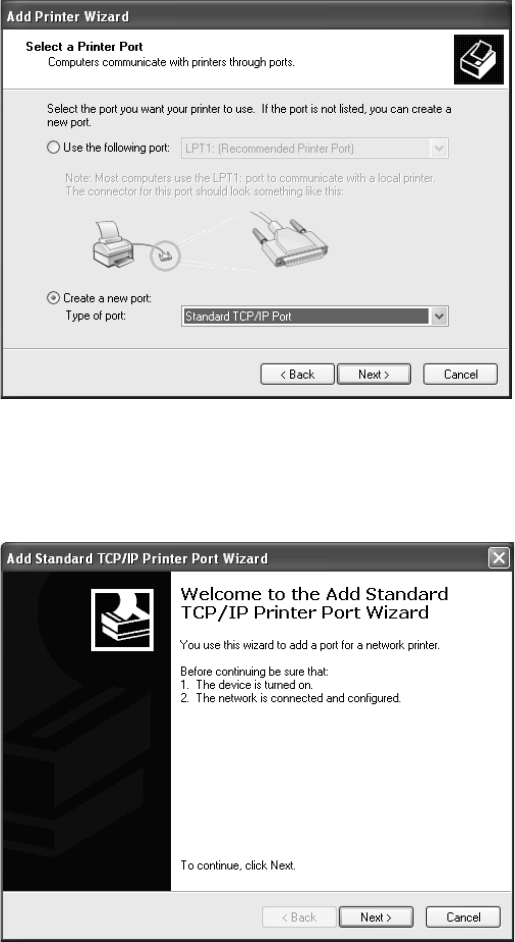
156
Using the USB port
Gigaset SX686 WiMAX / en / A31008-N919-R101-2x-7619 / printer.fm / 15.10.2008
Schablone 2005_07_27
ìClick the Create a new port option button.
ìThen select Standard TCP/IP Port from the selection menu in the field next to this
option.
ìClick Next.
ìIn the wizard for setting up a standard TCPI/IP port, click Next.
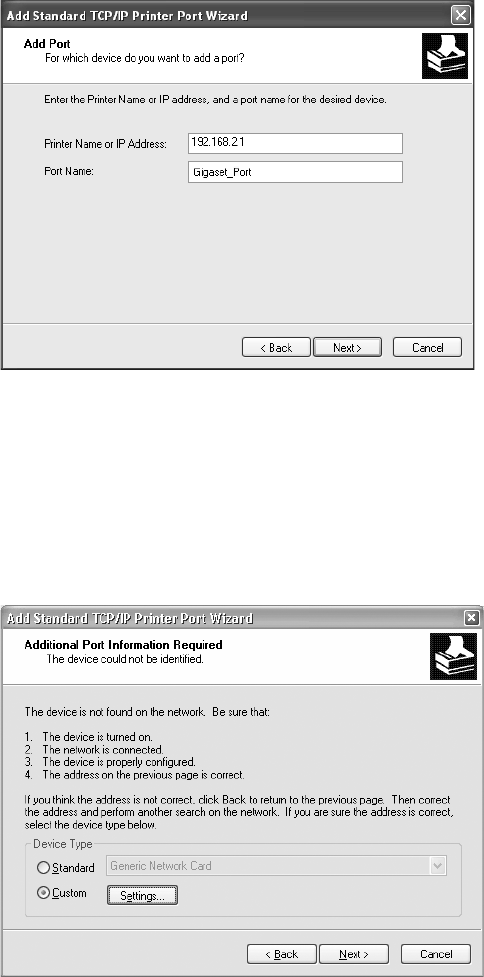
157
Using the USB port
Gigaset SX686 WiMAX / en / A31008-N919-R101-2x-7619 / printer.fm / 15.10.2008
Schablone 2005_07_27
ìIn the Printer Name or IP Address input field, enter the IP address of the print server
(Gigaset SX686 WiMAX): e.g. 192.168.2.1.
A copy of your entry is displayed in the second field.
ìDouble-click in the Port Name field and enter a name. This name will appear in the
list of printer ports. Name this port, for example, Gigaset_port.
ìClick Next.
As Windows XP usually first looks for a network card when a printer port is installed,
the Additional Port Information Required window is displayed.
ìChoose the option Custom and click Settings.
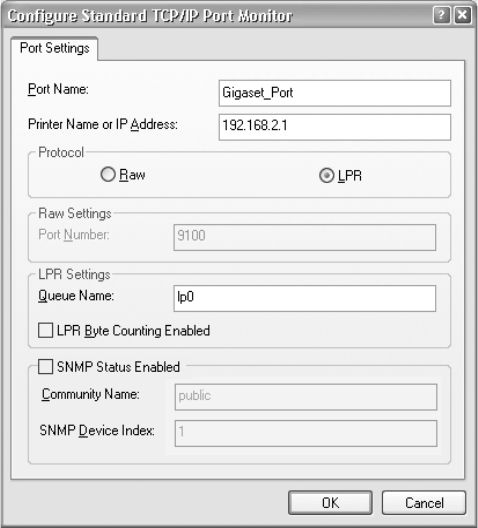
158
Using the USB port
Gigaset SX686 WiMAX / en / A31008-N919-R101-2x-7619 / printer.fm / 15.10.2008
Schablone 2005_07_27
ìEnter the following data in the relevant fields:
–Printer name or IP address: Enter the IP address of the print server.
–Protocol Choose the option LPR.
–Queue name: lp0 (lower case: lima, papa, number 0)
–LPR Byte Counting Enabled should not be selected.
ìClick OK
ìClick Next.
The window for finishing the wizard is opened and shows you all the settings you
have made.
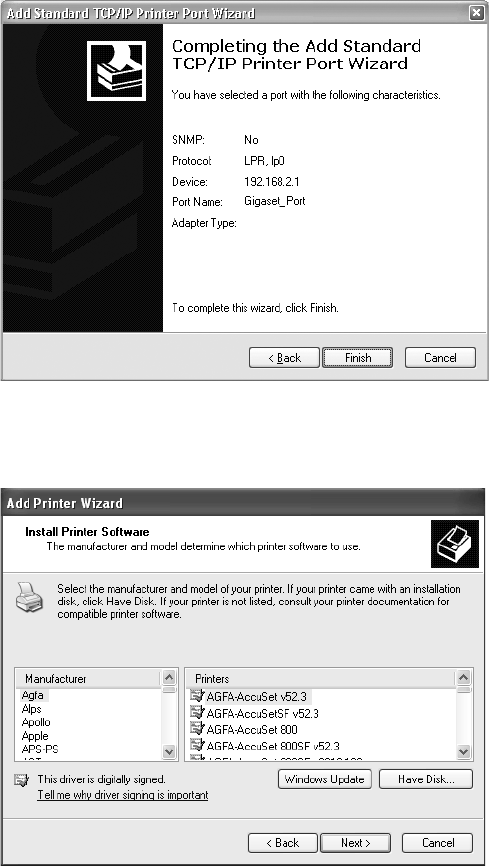
159
Using the USB port
Gigaset SX686 WiMAX / en / A31008-N919-R101-2x-7619 / printer.fm / 15.10.2008
Schablone 2005_07_27
ìClick Finish.
Once the wizard for installing the printer port is finished, the Add Printer Wizard is
opened.
ìIf you wish to install a printer for this port immediately, click Next and follow the
instructions of the Add Printer Wizard.
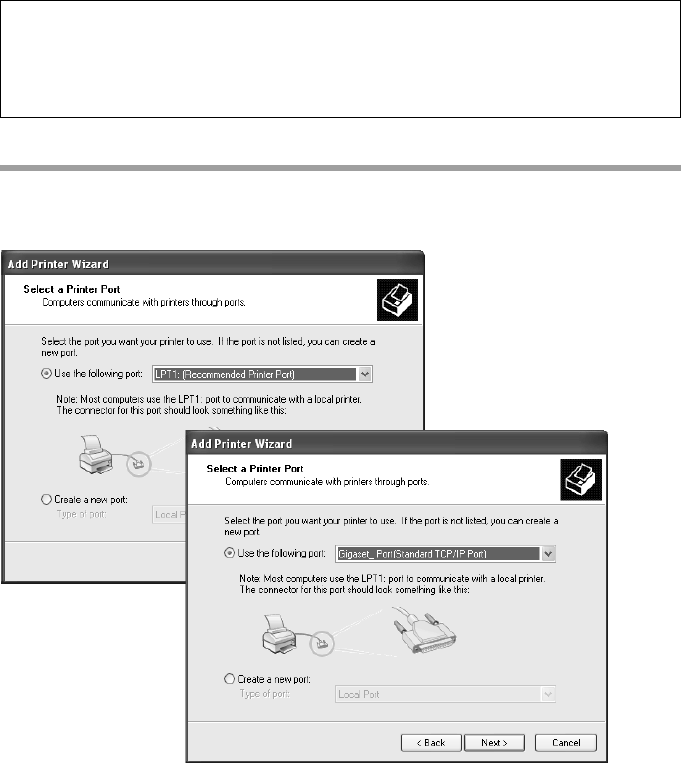
160
Using the USB port
Gigaset SX686 WiMAX / en / A31008-N919-R101-2x-7619 / printer.fm / 15.10.2008
Schablone 2005_07_27
ìIf you do not wish to install a printer until later, click Cancel.
Installing a printer on the TCP/IP port retrospectively
If you connect a printer to this port at a later stage, start the installation procedure for
the printer port as above.
ìIn this case, however, you should click the selection menu in the Select a Printer
Port window.
ìFrom the list, select the connection you have set up:
e.g. Gigaset_port (Standard TCP/IP port).
ìClick Next and finish installing the printer driver as instructed in the windows that
follow.
Note:
The printer server of the Gigaset SX686 WiMAX does not work bi-directionally. It does
not evaluate any of the printer's response messages. For this reason please make sure
that your printer is also only configured uni-directionally. You can configure the rele-
vant settings for your printer by choosing Start – Settings – Printers.

161
Using the USB port
Gigaset SX686 WiMAX / en / A31008-N919-R101-2x-7619 / printer.fm / 15.10.2008
Schablone 2005_07_27
Instructions for setting up a printer on the PC
Once you have installed the printer port you still cannot start printing. The printer port
is nothing more than an additional interface on your PC, comparable with the USB port.
It means that any printer you install on this port is also regarded as a local printer even
though it is located in the network and possibly not directly near you.
You still need to connect the printer to this port and configure it.
ìConnect the printer to the USB port on your Gigaset SX686 WiMAX.
The printer is installed in the same way as any other printer:
ìGo through Start – Settings – Printers and click Add Printer.
ìIn the window that opens click Next.
ìProceed as instructed by the Add Printer Wizard. Please note:
In the window in which you are prompted to specify the location of the printer you
should select Local printer (usually the default setting).
ìThen click Next.
ìContinue to install the printer. Select your printer and click Next.
ìWhen the window in which you are prompted to enter the type of connection
appears, double-click the port name Gigaset_port.
ìThen continue to install the printer and finish the installation.
Note:
The printer server of the Gigaset SX686 WiMAX does not work bi-directionally. It does
not evaluate any of the printer's response messages. For this reason please make sure
that your printer is also only configured uni-directionally.

162
Using the USB port
Gigaset SX686 WiMAX / en / A31008-N919-R101-2x-7619 / printer.fm / 15.10.2008
Schablone 2005_07_27
Using the data on a USB mass storage device
To view directories and files which are shared via the Gigaset SX686 WiMAX file server
on the USB port within the Windows network, some parameters on your PC must be set
correctly.
For most PCs these settings are already defined correctly on delivery, i.e. you usually do
not have to do anything. The following sections give some diagnosis information in case
problems do occur.
The following description is based on the Windows Vista operating system. The proce-
dure is similar for the other Windows systems. You will find a detailed description of the
network configuration for the different Windows systems on the CD-ROM delivered with
the device.
Checking network services
The following services/protocols must be activated for the network connection used:
uInternet protocol (TCP/IP)
uFile and Printer Sharing for Microsoft networks
You can check it via the Properties of the network connection.
ìClick on the network symbol in the taskbar .
ìOpen the Network and Sharing Center.
ìClick View status next to the network connection used to connect your PC to the
Gigaset SX686 WiMAX.
ìClick Properties.
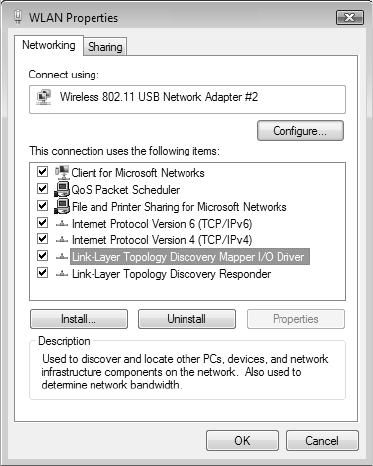
163
Using the USB port
Gigaset SX686 WiMAX / en / A31008-N919-R101-2x-7619 / printer.fm / 15.10.2008
Schablone 2005_07_27
The check boxes next to the entries
uInternet Protocol Version 4 (TCP/IPv4)
and
uFile and Printer Sharing for Microsoft Networks
must be marked.
ìIf one of these components is not installed it will have to be installed subsequently.
You may need your Windows installation CD.
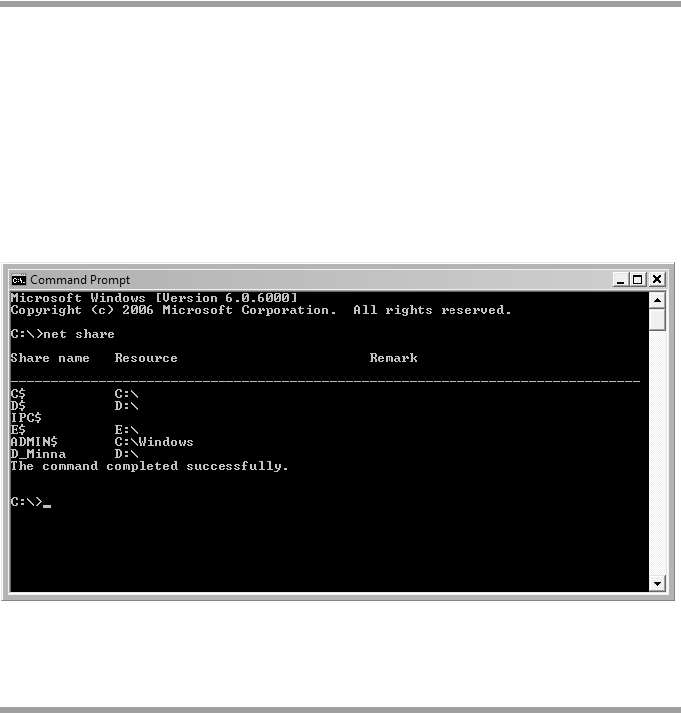
164
Using the USB port
Gigaset SX686 WiMAX / en / A31008-N919-R101-2x-7619 / printer.fm / 15.10.2008
Schablone 2005_07_27
Share Inter Process Communication for the network
The Inter Process Communication (IPC) functions are used to interchange data between
processes on a computer or between multiple computers in a network. To be able to
share data on the USB mass storage device on the Gigaset SX686 WiMAX, the IPC must
be set to access resources shared in the network (network share).
You can check it as follows:
ìOpen the Windows command prompt. From the start menu of the Windows taskbar,
click Start – All Programs – Accessories – Command Prompt.
ìIn the Command Prompt window enter the net share command and press the
ENTER key.
ìCheck if an IPC$ entry exists.
ìIf there is no entry, enter the net share IPC$ command and press the ENTER key.
Starting the computer browser
To access resources in the network, the Windows service computerbrowser must be
started.
You can check it as follows:
ìOpen the Control Panel by selecting Control Panel from the start menu of the Win-
dows taskbar.
ìOpen System and Maintenance, then Administrative Tools and click on Services.
Note: On Windows XP and 2000 systems right-click on the Workplace symbol and
choose Administrative Tools. Double-click on Services and Applications and then on
Services.
ìCheck if the status for the Computerbrowser entry is Started.
ìIf Computerbrowser is not started, double-click on the entry.
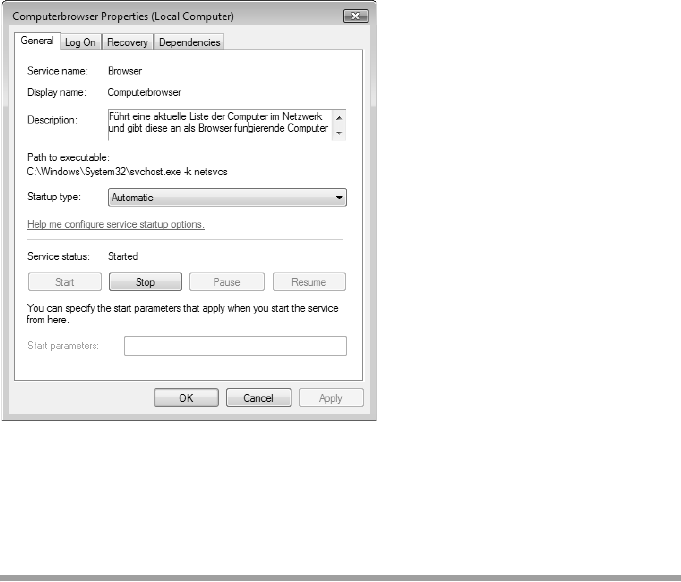
165
Using the USB port
Gigaset SX686 WiMAX / en / A31008-N919-R101-2x-7619 / printer.fm / 15.10.2008
Schablone 2005_07_27
ìClick on Start.
If an error message appears with a content like "..has been started and then stopped
again..", you still have to allow file and printer sharing in the Windows firewall (see next
section).
Enabling file and printer sharing in the Windows firewall
The Windows firewall must be set to allow file and printer sharing.
You can check it as follows:
ìOpen the Control Panel. For that purpose choose Control Panel from the start menu
of the Windows taskbar.
ìClick on Security – Windows Firewall and then Starting and Stopping the
Windows Firewall.
Note: On Windows XP systems in the Control Panel choose the Windows Firewall
entry.
ìOpen the Exceptions tab.
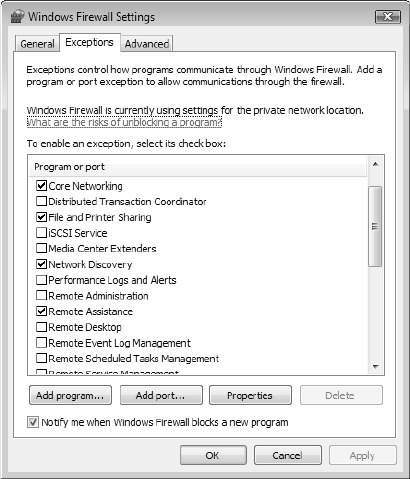
166
Using the USB port
Gigaset SX686 WiMAX / en / A31008-N919-R101-2x-7619 / printer.fm / 15.10.2008
Schablone 2005_07_27
The File and Printer Sharing entry must be marked.
Now your Windows system should be able to access the shared data on the Gigaset
SX686 WiMAX.

167
Appendix
Gigaset SX686 WiMAX / en / A31008-N919-R101-2x-7619 / appendix.fm / 15.10.2008
Schablone 2005_07_27
Appendix
Troubleshooting
This section describes common problems and their solution. Any problems can be iden-
tified from the different LED displays. If you cannot solve the connection problem after
checking the LED displays, consult of the following table. Further information is availa-
ble on the Internet at
http://www.gigaset.com/customercare.
This user guide is based on the software release 7.0.
Make sure the firmware on your device is up-to-date. The latest version can be found on
the Internet on the product page www.gigaset.com/gigasetsx686wimax.
Symptom Possible cause and solutions
Power LED does not light
up.
No power supply.
ìCheck whether the mains adapter is connected to
the Gigaset SX686 WiMAX and a power outlet.
ìCheck whether the power outlet and the mains
adapter are working properly. If the mains adapter
is not working properly, contact your supplier serv-
ice.
Status LED does not light
up.
No registration to a WiMAX network.
ìCheck if the antenna has been moved out of posi-
tion or the device's alignment has been changed. In
this case, restore the original alignment.
ìRegister your Gigaset SX686 WiMAX with the help
of the connection wizard; see page 47.
Status LED flashing green A connection is being established. This is not a fault.
ìPlease wait until the connection is established. The
LED will then light up permanently.
Status LED is red The Gigaset SX686 WiMAX is not ready for use.
The device may be too hot. In this case, the integrated
overheating protector prevents the Gigaset SX686
WiMAX from being damaged. If the temperature rises,
the Gigaset SX686 WiMAX automatically reduces data
transfer to a minimum. When the temperature exceeds
the critical value, the Gigaset SX686 WiMAX switches
itself off.
ìWait until the Gigaset SX686 WiMAX has cooled
down.

168
Appendix
Gigaset SX686 WiMAX / en / A31008-N919-R101-2x-7619 / appendix.fm / 15.10.2008
Schablone 2005_07_27
Status LED is permanently
lit red; overheating of the
device can be excluded
The Gigaset SX686 WiMAX may be faulty.
ìRestart the Gigaset SX686 WiMAX. If the Status
LED remains red after the device has been restarted
and does not extinguish, please contact your sup-
plier service.
Only a few LEDs have lit up
to display the signal
strength (RSSI) and the
Status LED is green
If you are using the antenna integrated in the Gigaset
SX686 WiMAX,
ìturn the Gigaset SX686 WiMAX until more LEDs
light up. Try to place the device even closer to the
window and check the signal strength bar in the
BAsic Setup wizard for the configuration program.
Additional information on possible errors during WiMAX operation can be found on
the Status screen Alarms. Please refer to the section "Alarms" on page 150.
The LAN LED on a con-
nected device does not light
up.
No LAN connection
ìMake sure the connected device is turned on.
ìCheck whether the Ethernet cable is plugged in.
ìCheck that you are using the right cable type
(CAT5) and that the cable is not too long (<100m).
ìCheck that the network card on the connected
device and the cables are not defective. If neces-
sary, replace a defective network card or cable.
ìUse the Windows device manager (My Computer –
Properties) to check whether the network card is
functioning. If you see a red cross or a question
mark, the driver may not have been installed or
there is a resource conflict. Follow the Windows
instructions to remedy the problem.
Symptom Possible cause and solutions

169
Appendix
Gigaset SX686 WiMAX / en / A31008-N919-R101-2x-7619 / appendix.fm / 15.10.2008
Schablone 2005_07_27
You cannot connect to the
Internet.
ìCheck whether your device is connected to the
WiMAX network by checking the Status LED.
ìCheck whether the data entered for your Internet
connection matches what your Internet service
provider has specified.
ìCheck whether the Connect manually option is
activated. If it is, connections cannot be opened
automatically.
ìSelect Connect on demand or Always on.
Remember that this setting may lead to higher
costs if you are billed on the time used.
ìThe connection may have been terminated manu-
ally with the Connect on demand option selected.
– Restore the connection again manually using the
Connect button or
– Restart the Gigaset SX686 WiMAX.
In both cases, the Connect on demand setting will
be active again.
After a WPS registration
attempt, the WLAN LED
continues to flash for some
time and the required client
was not registered.
uMore than one client has tried to register.
ìRepeat registration after a short interval.
uMAC access control is activated, but the desired cli-
ent is not in the MAC address list.
ìAdd the client to the MAC address list (see
page 71).
If the MAC address filter is enabled a WPS registration
attempt can not be detected by the device. In this case
LED signalling is not possible.
After a WPS registration the
WLAN LED shows successful
registration but the desired
client was not registered.
Maybe an external device has registered with your net-
work.
ìChange the WPA PSK key manually as soon as
possible (see page 104) and perform the WPS
registration via PIN (see page 101).
Symptom Possible cause and solutions

170
Appendix
Gigaset SX686 WiMAX / en / A31008-N919-R101-2x-7619 / appendix.fm / 15.10.2008
Schablone 2005_07_27
You cannot open a connec-
tion to the Gigaset SX686
WiMAX from a wireless
device.
uYou attempted to perform WPS registration on the
network adapter but the registration button was
not activated on the Gigaset SX686 WiMAX.
ìActivate the WPS registration on the Gigaset
SX686 WiMAX and activate WPS within the two-
minutes interval on the network adapter.
uYou defined a PIN for WPS registration but the net-
work adapter does not use a PIN or uses a different
one.
ìCheck the wireless network encryption settings and
determine the PIN used by the Gigaset SX686
WiMAX. Enter this PIN on the network adapter.
uYou defined a PIN for WPS registration at the net-
work adapter but you didn’t enter this PIN at the
Gigaset SX686 WiMAX PIN or not the right one.
ìFind out the PIN that is used by the network
adapter. Enter this PIN on the Gigaset SX686
WiMAX.
uThe wireless network adapter is not using the cor-
rect SSID.
ìChange the SSID on the network adapter or use the
WPS function.
You cannot open a connec-
tion to the Gigaset SX686
WiMAX from a wireless
device.
uEither encryption has been activated on the Gigaset
SX686 WiMAX but not on the wireless network
adapter, or an incorrect key is in use.
ìActivate the required encryption (WPA-PSK or WEP)
on the network adapter with the correct key.
If you do not know the key, repeat key entry
(page 101) via a PC connected via cable to the
Gigaset SX686 WiMAX and enter the new key on
the network adapter.
Otherwise, you can use the WPS function.
Alternatively, you can reset the Gigaset SX686
WiMAX (page 19) and then reconfigure encryp-
tion.
Warning: Please bear in mind that this will reset
the entire configuration to the factory settings.
uMAC access control is activated, but the PC is not
included in the MAC address list.
ìEnter the PC in the MAC address list.
Symptom Possible cause and solutions

171
Appendix
Gigaset SX686 WiMAX / en / A31008-N919-R101-2x-7619 / appendix.fm / 15.10.2008
Schablone 2005_07_27
The Gigaset SX686 WiMAX
or other PCs cannot be
reached by a PC in the con-
nected LAN using a ping
command.
ìMake sure that TCP/IP has been installed and con-
figured on all the PCs in the local network.
ìCheck that the IP addresses have been correctly
configured. In most cases you can use the DHCP
function of the Gigaset SX686 WiMAX to assign
dynamic addresses to the PCs in the LAN. In this
case, you have to configure the TCP/IP settings of all
the PCs so that they obtain the IP address automat-
ically.
If you configure IP addresses in the LAN manually,
remember to use the same subnet mask for all PCs
in the LAN. This means that the masked part of the
IP address on each PC and on the Gigaset SX686
WiMAX has to be identical.
No connection to the config-
uration environment of the
Gigaset SX686 WiMAX.
ìUse the ping command to check whether you can
establish a network connection to the Gigaset
SX686 WiMAX.
ìCheck the network cable between the PC you want
to use to administer the device and the Gigaset
SX686 WiMAX.
ìIf the PC you want to use for administering the
device is in the router's local network, make sure
that you are using the correct IP address range
(see above).
ìIf the PC you want to use for administering the
device is not in the router's local area network, this
PC must be authorised for remote management.
You cannot conduct VoIP tel-
ephone calls.
ìThe access data for your VoIP phones is not entered
correctly. Check the access data (see page 117).
ìYou have not assigned the VoIP phone numbers to
the telephone port. Check the configuration of the
telephone ports and the extensions (see
page 121).
ìYour VoIP configuration is not set up with the cor-
rect Codecs. Contact your VoIP provider and assign
the correct Codecs (see page 117).
Password forgotten or lost. ìReset the Gigaset SX686 WiMAX (page 19).
Warning: Please bear in mind that this will return all
the configuration settings to the factory settings.
Symptom Possible cause and solutions

172
Appendix
Gigaset SX686 WiMAX / en / A31008-N919-R101-2x-7619 / appendix.fm / 15.10.2008
Schablone 2005_07_27
Gigaset SX686 WiMAX functions and their interdependency
The following table shows which functions of your device are possible in which
combination. In the case of error, check that the following conditions are fulfilled:
You cannot access a
resource (drive or printer)
on a different PC.
ìMake sure that TCP/IP has been installed and con-
figured on all the PCs in the local network and that
the PCs all belong to the same workgroup.
ìCheck whether the resource has been released on
the PC in question and whether you have the nec-
essary access rights.
ìPrinting: Check whether the printer has been set up
as a network printer.
Function Possible in combination with Not possible in combina-
tion with
WPS
WPA2-PSK/WPA-PSK
encryption
no encryption
WPA2/WPA authentication
WEP encryption
WDS WEP encryption
no encryption
WPA2-PSK/WPA-PSK or WPA2/
WPA authentication
Operating information:
uUSB port
If connecting a device without its own power supply directly to the USB port,
please note that the power consumption must not exceed 500 mA. If this value is
exceeded, you will have to use a separate power supply unit for your USB device
or connect a USB hub with a separate power supply. A USB hard drive and a USB
printer can be operated simultaneously on a USB hub.
uLAN ports
The LAN ports may only be used for in-house networks. The ports are destroyed
externally if there is a power surge.
uTelephone ports
The phone ports are only suitable for connecting in-house phones/phone systems.
The ports are destroyed externally if there is a power surge.
Symptom Possible cause and solutions

173
Appendix
Gigaset SX686 WiMAX / en / A31008-N919-R101-2x-7619 / appendix.fm / 15.10.2008
Schablone 2005_07_27
Deactivating HTTP proxy and configuring a pop-up blocker
Before you can start the configuration program of the Gigaset SX686 WiMAX, you might
need to adjust the settings described below for your Web browser.
Deactivating the HTTP proxy
Make sure that the HTTP proxy in your web browser is deactivated. This function must
be deactivated so that your web browser can access your Gigaset SX686 WiMAX's
configuration pages.
The following section describes the procedure for Internet Explorer and Mozilla Firefox.
First decide which browser you wish to use, and then follow the appropriate steps.
uInternet Explorer
ìOpen Internet Explorer and from the Tools menu, select Internet Options.
ìIn the Internet Options window, click the Connections tab.
ìClick LAN Settings.
ìDeactivate all options in the LAN Settings window.
ìClick OK and then OK again to close the Internet Options window.
uMozilla Firefox
ìOpen Mozilla Firefox. Click Tools and then Settings.
ìIn the Settings window, click Connection Settings...
ìIn the Connection Settings window, select the option Direct connection to the
Internet.
ìClick OK to finish.
Configuring the pop-up blocker
You must allow pop-ups for the configuration program in order to start it.
uInternet Explorer
If working with Windows XP Service Pack 2, pop-ups are blocked by default. If the con-
figuration program is blocked carry out the following steps:
ìRight-click on the browser information bar. It is displayed if a page is blocked.
ìSelect Allow popups from this screen.
ìConfirm the dialogue window by clicking OK.
The configuration screens for the Gigaset SX686 WiMAX are now allowed as pop-ups.
You can make additional settings for pop-ups within Internet Explorer via the Tools –
Popup Manager menu item or via Tools – Internet Options on the Privacy tab.

174
Appendix
Gigaset SX686 WiMAX / en / A31008-N919-R101-2x-7619 / appendix.fm / 15.10.2008
Schablone 2005_07_27
uMozilla Firefox
Pop-ups are blocked by default. Carry out the following steps:
ìOpen Mozilla Firefox. Click Tools and then Settings.
ìClick on the Content icon.
ìDeactivate the Block Popup window option.
ìClick OK to finish.
Specifications
Please note:
Should you use a different pop-up blocker, you must configure this accordingly.
Interfaces
4 LAN RJ45, 10Base-T/100Base-TX, Auto-sensing
1 USB USB 2.0, for printer server or file server (max. 500 mA)
2 FXS RJ11, for connecting analogue terminals (phone, fax,
answering machine)
WLAN 802.11b/g, for wireless connection of up to 252 PCs
Mains adaptor Input 100-240 V AC, output 12 V DC / 2.0 A
WiMAX properties
Frequency 2.5–2.7 GHz or 3.4–3.6 GHz
Output power Max. 26 dBm at 2.5–2.7 GHz,
Max. 24 dBm at 3.4–3.6 GHz (Europe)
Power consumption 3–6 W, depending on operating state
Bandwidth Optional 5.0/7.0 or 10.0 MHz
Type of transmission TDD
Modulation technique SOFDMA 512/1024
Subcarrier modulation QPSK, 16/64 QAM
Encoding rate 1/2, 2/3, 3/4, 5/6
Antenna socket 50 Ohm reverse SMA
Antenna type 2 internal antennae (2xRX, 1xTX) for MIMO Matrix A & B;
Type DN1 (EN 302 326-3 V1.2.2)
Optional: outdoor antenna
Antenna gain 2,6 GHz: 7 dBi
3,5 GHz: 9 dBi (integrated antennae)
Antenna polarisation Send direction vertical,
Receive direction vertical and horizontal
Wireless properties (WLAN)
Frequency range 2400 to 2484 GHz ISM band (subject to local regulations)
175
Appendix
Gigaset SX686 WiMAX / en / A31008-N919-R101-2x-7619 / appendix.fm / 15.10.2008
Schablone 2005_07_27
Spreading Direct Sequence Spread Spectrum (DSSS)
Modulation CCK, OFDM
Number of channels IEEE 802.11b: 13 (Europe, ETSI)
IEEE 802.11g: 13 (Europe, ETSI)
Transfer rate IEEE 802.11b: 1, 2, 5.5, 11 Mbps
IEEE 802.11g: 1, 2, 5.5, 6, 9, 11, 12, 18, 24, 36, 48, 54 Mbps
Range Up to 300 m outdoors, up to 30 m indoors
Operating environment
Temperature Operating temperature 0 to 40 °C
Storage temperature –25 to 70°C
Humidity 5% to 90% (non-condensing)
LED displays Power (on/off)
Status (WiMAX, status, connection establishment)
RDDI (WiMAX, signal strength)
WLAN (activity, wireless)
LAN1... LAN4 (connection to PC, activity, wired)
USB (device connection)
VoIP (connection, activity, Internet telephony)
Phone1/Phone2 (FXS activity)
Compliance with security conditions and regulations
CE, EN60950
Software Browser-based configuration environment
NAT, PPPoE, PPPoA
DHCP server and client, DynDNS
NAT, virtual server, DMZ
Security setup
Firewall, prevention of hacker attacks
MAC address filtering
Log file
WEP encryption
WPA encryption
WPA2 encryption
WPS
IEEE 802.1x
Integrated SIP client
176
Appendix
Gigaset SX686 WiMAX / en / A31008-N919-R101-2x-7619 / appendix.fm / 15.10.2008
Schablone 2005_07_27
Specifications for outdoor antenna (optional)
Model outdoor antenna
Operating temperature –40°C to +70°C
Storage temperature –40°C to +70°C
Frequency 2.5–2.7 GHz or 3.4–3.6 GHz
Antenna socket 50 Ohm
Antenna gain 3,5 GHz: 18 dBi
3,5 GHz: 9 dBi
2,6 GHz: 9 dBi
2,6 GHz: 15 dBi
Antenna polarisation Vertical, horizontal

177
Appendix
Gigaset SX686 WiMAX / en / A31008-N919-R101-2x-7619 / appendix.fm / 15.10.2008
Schablone 2005_07_27
Guarantee Certificate United Kingdom
Without prejudice to any claim the user (customer) may have in relation to the dealer or
retailer, the customer shall be granted a manufacturer's Guarantee under the conditions
set out below:
uIn the case of new devices and their components exhibiting defects resulting from
manufacturing and/or material faults within 24 months of purchase, Gigaset Com-
munications GmbH shall, at its own option and free of charge, either replace the
device with another device reflecting the current state of the art, or repair the said
device. In respect of parts subject to wear and tear (including but not limited to, bat-
teries, keypads, casing), this warranty shall be valid for six months from the date of
purchase.
uThis Guarantee shall be invalid if the device defect is attributable to improper treat-
ment and/or failure to comply with information contained in the user guides.
uThis Guarantee shall not apply to or extend to services performed by the authorised
dealer or the customer themselves (e. g. installation, configuration, software down-
loads). User guides and any software supplied on a separate data medium shall be
excluded from the Guarantee.
uThe purchase receipt, together with the date of purchase, shall be required as evi-
dence for invoking the Guarantee. Claims under the Guarantee must be submitted
within two months of the Guarantee default becoming evident.
uOwnership of devices or components replaced by and returned to Gigaset Commu-
nications GmbH shall vest in Gigaset Communications GmbH.
uThis Guarantee shall apply to new devices purchased in the European Union. For
Products sold in the United Kingdom the Guarantee is issued by: Gigaset Communi-
cations GmbH, Schlavenhorst 66, D-46395 Bocholt, Germany.
uAny other claims resulting out of or in connection with the device shall be excluded
from this Guarantee. Nothing in this Guarantee shall attempt to limit or exclude a
Customers Statutory Rights, nor the manufacturer's liability for death or personal
injury resulting from its negligence.
uThe duration of the Guarantee shall not be extended by services rendered under the
terms of the Guarantee.
uInsofar as no Guarantee default exists, Gigaset Communications GmbH reserves the
right to charge the customer for replacement or repair.
uThe above provisions does not imply a change in the burden of proof to the detriment
of the customer.
To invoke this Guarantee, please contact the Gigaset Communications GmbH telephone
service. The relevant number is to be found in the accompanying user guide.
Guarantee certificate Ireland
Without prejudice to any claim the user (customer) may have in relation to the dealer or
retailer, the customer shall be granted a manufacturer’s Guarantee under the conditions
set out below:
178
Appendix
Gigaset SX686 WiMAX / en / A31008-N919-R101-2x-7619 / appendix.fm / 15.10.2008
Schablone 2005_07_27
uIn the case of new devices and their components exhibiting defects resulting from
manufacturing and/or material faults within 24 months of purchase, Gigaset Com-
munications GmbH shall, at its own option and free of charge, either replace the
device with another device reflecting the current state of the art, or repair the said
device. In respect of parts subject to wear and tear (including but not limited to, bat-
teries, keypads, casing), this warranty shall be valid for six months from the date of
purchase.
uThis Guarantee shall be invalid if the device defect is attributable to improper care or
use and/or failure to comply with information contained in the user manuals. In par-
ticular claims under the Guarantee cannot be made if:
uThe device is opened (this is classed as third party intervention)
uRepairs or other work done by persons not authorised by Gigaset Communications
GmbH.
uComponents on the printed circuit board are manipulated
uThe software is manipulated
uDefects or damage caused by dropping, breaking, lightning or ingress of moisture.
This also applies if defects or damage was caused by mechanical, chemical, radio
interference or thermal factors (e.g.: microwave, sauna etc.)
uDevices fitted with accessories not authorised by Gigaset Communications GmbH.
uThis Guarantee shall not apply to or extend to services performed by the authorised
dealer or the customer themselves (e.g. installation, configuration, software down-
loads). User manuals and any software supplied on a separate data medium shall be
excluded from the Guarantee.
uThe purchase receipt, together with the date of purchase, shall be required as evi-
dence for invoking the Guarantee. Claims under the Guarantee must be submitted
within two months of the Guarantee default becoming evident.
uOwnership of devices or components replaced by and returned to Gigaset Commu-
nications GmbH shall vest in Gigaset Communications GmbH.
uThis Guarantee shall apply to new devices purchased in the European Union. For
Products sold in the Republic of Ireland the Guarantee is issued by Gigaset Commu-
nications GmbH, Schlavenhorst 66, D-46395 Bocholt, Germany.
uAny other claims resulting out of or in connection with the device shall be excluded
from this Guarantee. Nothing in this Guarantee shall attempt to limit or exclude a
Customers Statutory Rights, nor the manufacturer’s liability for death or personal
injury resulting from its negligence.
uThe duration of the Guarantee shall not be extended by services rendered under the
terms of the Guarantee.
uInsofar as no Guarantee default exists, Gigaset Communications GmbH reserves the
right to charge the customer for replacement or repair.
uThe above provisions does not imply a change in the burden of proof to the detriment
of the customer.
To invoke this Guarantee, please contact the Gigaset Communications GmbH helpdesk
on 1850 777 277. This number is also to be found in the accompanying user guide.

179
Appendix
Gigaset SX686 WiMAX / en / A31008-N919-R101-2x-7619 / appendix.fm / 15.10.2008
Schablone 2005_07_27
Open Source Software used in the product
The product contains, among other things, embedded Open Source Software, licensed
under an Open Source Software License and developed by third parties. These embed-
ded Open Source Software files are protected by copyright. Your rights to use the Open
Source Software beyond the mere execution of the program of Gigaset Communica-
tions GmbH are governed by the relevant Open Source Software license conditions.
Your compliance with those license conditions will entitle you to use the Open Source
Software as foreseen in the relevant license. In the event of conflicts between Gigaset
Communications GmbH license conditions and the Open Source Software license con-
ditions, the Open Source Software conditions shall prevail with respect to the Open
Source Software portions of the software. A list of the Open Source Software programs
contained in this product and the Open Source Software licenses are available on the
product CD.
If programs contained in this product are licensed under GNU General Public License
(GPL), GNU Lesser General Public License (LGPL) or any other Open Source Software
license that requires that source code be made available, and if this software is not
already delivered in source code form together with the product, you can request the
corresponding source code from Gigaset Communications GmbH by paying a 10 Euro
fee for the physical act of transferring the copy. Please send your specific request,
together with a receipt indicating the date of purchase, within three years of your pur-
chase, together with the ID number (MAC ID) of the product and the software release
number to the following address (please consult the user manual on how to find out
these numbers):
Warranty regarding further use of the Open Source Software
Gigaset Communications GmbH provides no warranty for the Open Source Software
programs contained in this product, if such programs are used in any manner other than
the program execution intended by Gigaset Communications GmbH. The licenses listed
below define the warranty, if any, from the authors or licensors of the Open Source Soft-
ware. Gigaset Communications GmbH specifically disclaims any warranties for defects
caused by altering any Open Source Software program or the product´s configuration.
You have no warranty claims against Gigaset Communications GmbH in the event that
the Open Source Software infringes the intellectual property rights of a third party.
Technical support, if any, will only be provided for unmodified software.
Open Source Software Used
This product includes software developed by the University of California, Berkeley and
its contributors.
Kleinteileversand Com Bocholt
Email: kleinteileversand.com@gigaset.com
Fax: +49 (0)2871 / 91 30 29
180
Glossary
Gigaset SX686 WiMAX / en / A31008-N919-R101-2x-7619 / glossary.fm / 15.10.2008
Schablone 2005_07_27
Glossary
Access point
An access point, such as the Gigaset SX686 WiMAX, is the centre of a wireless local net-
work (WLAN). It handles the connection of the wireless linked network components and
regulates the data traffic in the wireless network. The access point also serves as an
interface to other networks, for example an existing Ethernet LAN or via a modem to the
Internet. The operating mode of wireless networks with an access point is called
Infrastructure mode.
Ad-hoc mode
Ad-hoc mode describes wireless local networks (WLANs), in which the network compo-
nents set up a spontaneous network without an Access point, for example several Note-
books in a conference. All the network components are peers. They must have a wire-
less Network adapter.
AES
Advanced Encryption Standard
AES is an encryption system, which was published as a standard in October 2000 by the
National Institute of Standards and Technology (NIST). It is used for WPA encryption. A
distinction is made between the three AES variants AES-128, AES-192 and AES-256 on
the basis of the key length.
Auto connect
Auto connect means that applications such as Web browser, Messenger and E-mail
automatically open an Internet connection when they are launched. This can lead to
high charges if you are not using Flat rate. To avoid this, you can select the manual con-
nect option on the Gigaset SX686 WiMAX.
Bridge
A bridge connects several network segments to form a joint network, for example to
make a TCP/IP network. The segments can have different physical characteristics, for
example different cabling as with Ethernet and wireless LANs. Linking individual seg-
ments via bridges allows local networks of practically unlimited size.
See also: Switch, Hub, Router, Gateway
Broadcast
A broadcast is a data packet not directed to a particular recipient but to all the network
components in the network. The Gigaset SX686 WiMAX does not pass on broadcast
packets; they always remain within the local network (LAN) it administers.
181
Glossary
Gigaset SX686 WiMAX / en / A31008-N919-R101-2x-7619 / glossary.fm / 15.10.2008
Schablone 2005_07_27
BSSID
Basic Service Set ID
BSSID permits unique differentiation of one wireless network (WLAN) from another. In
Infrastructure mode, the BSSID is the MAC address of the Access point. In wireless net-
works in Ad-hoc mode, the BSSID is the MAC address of any one of the participants.
Client
A client is an application that requests a service from a Server. For example, an HTTP
client on a PC in a local network requests data, i.e. Web pages from an HTTP server on
the Internet. Frequently the network component (e.g. the PC) on which the client appli-
cation is running is also called a client.
dB
Decibel (a tenth of a Bel)
Logarithmic unit of measurement for ratios between two currents, voltages, sound lev-
els or powers. In order to depict large value differences clearly and graphically, these are
given in dB; e.g. 60 dB corresponds to the factor 1000 relative to the voltage drops.
dBm
Decibel milliwatt
Power level in decibels relative to 1 milliwatt.
DHCP
Dynamic Host Configuration Protocol
DHCP handles the automatic assignment of IP addresses to network components. It was
developed because of the complexity involved in defining IP addresses in large networks
– especially the Internet – as participants frequently move, drop out or new ones join.
A DHCP server automatically assigns the connected network components (DHCP Cli-
ents) Dynamic IP addresses from a defined IP pool range thus saving a great deal of con-
figuration work. In addition, the address blocks can be used more effectively: Since not
all participants are on the network at the same time, the same IP address can be
assigned to different network components in succession as and when required.
The Gigaset SX686 WiMAX includes a DHCP server and uses it to assign automatic IP
addresses to PCs in the local network. You can specify that the IP addresses for certain
PCs are never changed.
DHCP server
The Gigaset SX686 WiMAX includes a DHCP server and uses it to assign automatic IP
addresses to PCs in the local network. You can specify that the IP addresses for certain
PCs are never changed.
DMZ
Demilitarised Zone
DMZ describes a part of a network that is outside the Firewall. A DMZ is set up, as it
were, between a network you want to protect (e.g. a LAN) and a non-secure network
182
Glossary
Gigaset SX686 WiMAX / en / A31008-N919-R101-2x-7619 / glossary.fm / 15.10.2008
Schablone 2005_07_27
(e.g. the Internet). A DMZ is useful if you want to offer Server services on the Internet
that are not to be run from behind the firewall for security reasons or if Internet appli-
cations do not work properly behind a firewall. A DMZ permits unrestricted access from
the Internet to only one or a few network components, while the other network com-
ponents remain secure behind the firewall.
DNS
Domain Name System
DNS permits the assignment of IP addresses to computers or Domain names that are
easier to remember. A DNS server must administer this information for each LAN with
an Internet connection. As soon as a page on the Internet is called up, the browser
obtains the corresponding IP address from the DNS server so that it can establish the
connection.
On the Internet, the assignment of domain names to IP addresses follows a hierarchical
system. A local PC only knows the address of the local name server. This in turn knows
all the addresses of the PCs in the local network and the superordinate name servers,
which again know addresses or the next superordinate name servers.
DNS server
See DNS
Domain name
The domain name is the reference to one or more Web servers on the Internet. The
domain name is mapped via the DNS service to the corresponding IP address.
DoS attack
Denial of Service
A DoS attack is a particular form of hacker attack directed at computers and networks
with a connection to the Internet. The aim is not so much to steal data but to paralyse
the computer or network so severely that the network resources are no longer available.
A typical hacker attack involves making a remote computer announce that it is acting for
the paralysed computer, for example, and receive the data intended for you.
Downlink
Files that your Gigaset SX686 WiMAX receives and forwards to your local network.
Dynamic IP address
A dynamic IP address is assigned to a network component automatically by DHCP. This
means that the IP address of a network component can change with every login or at
certain intervals.
See also: Static IP address
183
Glossary
Gigaset SX686 WiMAX / en / A31008-N919-R101-2x-7619 / glossary.fm / 15.10.2008
Schablone 2005_07_27
DynDNS
Dynamic DNS
The assignment of Domain names and IP addresses is handled by the Domain Name
Service (DNS). This service is now enhanced with so-called Dynamic DNS (DynDNS) for
Dynamic IP addresses. This enables the use of a network component with a dynamic IP
address as a Server on the Internet. DynDNS ensures that a service can always be
addressed on the Internet under the same domain name regardless of the current IP
address.
Encryption
Encryption protects confidential information against unauthorised access. With an
encryption system, data packets can be sent securely over a network. The Gigaset
SX686 WiMAX offers WEP encryption and WPA for secure data transfer over wireless net-
works.
Ethernet
Ethernet is a network technology for local networks (LANs) defined by the IEEE as stand-
ard IEEE 802.3. Ethernet uses a base-band cable with a transfer rate of 10 or 100 Mbps
or 1 Gbps.
File Server
See Server
Firewall
Firewalls are used by network operators as protection against unauthorised external
access. This involves a whole bundle of hardware and software actions and technologies
that monitor and control the data flow between the private network to be protected and
an unprotected network such as the Internet.
See also: NAT
Flat rate
Flat rate is a particular billing system for Internet connections. The Internet service pro-
vider charges a monthly fee regardless of the duration and number of logins.
FTP (File Transfer Protocol)
FTP is a protocol for exchanging files on the Internet. You can use it, for example, to offer
files for downloading or to receive files from other users.
Full duplex
Data transfer mode in which data can be sent and received at the same time.
See also: Half duplex
FXS
Foreign Exchange Station
Phone port to which an analogue terminal (phone, fax or answer machine) can be con-
nected.
184
Glossary
Gigaset SX686 WiMAX / en / A31008-N919-R101-2x-7619 / glossary.fm / 15.10.2008
Schablone 2005_07_27
Gateway
A gateway is a device for connecting networks with completely different architectures
(addressing, protocols, application interfaces etc.). Although it is not totally correct, the
term is also used as a synonym for Router.
Global IP address
See Public IP address
Half duplex
Operating mode for data transmission. Only one side can send and/or receive data at
the same time.
See also: Full duplex
HTTP
Hypertext Transfer Protocol
Network protocol for the transmission of data, which is mainly used for transmitting and
displaying Internet content.
HTTP proxy
An HTTP proxy is a Server that network components use for their Internet traffic. All
requests are sent via the proxy.
Hub
A hub connects several network components in a star-topology network by sending all
the data it receives from one network component to all the other network components.
See also: Switch, Bridge, Router, Gateway
IEEE
Institute of Electrical and Electronic Engineers
The IEEE is an international body for defining network standards, especially for stand-
ardising LAN technologies, transfer protocols, data transfer speeds and wiring.
IEEE 802.11
IEEE 802.11 is a standard for wireless LANs operating in the 2.4 GHz or 5 GHz band. In
so-called Infrastructure mode, terminals can be connected to a base station (Access
point) or they can connect with each other spontaneously (Ad-hoc mode).
185
Glossary
Gigaset SX686 WiMAX / en / A31008-N919-R101-2x-7619 / glossary.fm / 15.10.2008
Schablone 2005_07_27
IEEE 802.16
Standard defined by the IEEE for WiMAX. Similarly to other standards in the 802 series
(e.g. 802.3 Ethernet, 802.11 WLAN), the WiMAX standard is one of the standards for
networks. The standard has progressed in accordance with new developments; there
are currently two main versions:
uIEEE 802.16-2004: WiMAX, which specifies the secure location for connection part-
ners.
uIEEE 802.16e-2005: Mobile WiMAX, which enables wireless cells to be exchanged
during data transmission.
IGMP
Internet Group Management Protocol
IGMP is an Internet Protocol that enables an Internet computer to inform neighbouring
routers that it is a member of a multicast group. With multicasting, a computer can send
content on the Internet to several other computers that have registered an interest in
the first computer's content. Multicasting can, for example, be used for multimedia pro-
grams for media streaming to recipients that have set up multicast group membership.
Infrastructure mode
Infrastructure mode is a way of operating wireless local networks (WLANs) in which an
Access point handles the data traffic. Network components cannot establish a direct
connection with each other as is the case in Ad-hoc mode.
Internet
The Internet is a wide-area network (WAN) linking several million users around the
world. A number of Protocols have been created for exchanging data, and these are
known collectively as TCP/IP protocol stack. All participants on the Internet can be iden-
tified by an IP address. Servers are addressed by Domain names (e.g. gigaset.com).
Domain names are assigned to IP addresses by the Domain Name Service (DNS).
These are some of the main Internet services:
uElectronic mail (e-mail)
uThe World Wide Web (WWW)
uFile transfer (FTP)
uDiscussion forums (Usenet / Newsgroups)
Internet service provider
An Internet service provider offers access to the Internet for a fee.
Internet telephony
Transmission of voice via the Internet (Voice over IP).
186
Glossary
Gigaset SX686 WiMAX / en / A31008-N919-R101-2x-7619 / glossary.fm / 15.10.2008
Schablone 2005_07_27
IP
Internet protocol
The IP Protocol is one of the TCP/IP protocols. It is responsible for addressing parties in a
network using IP addresses and routes data from the sender to the recipient. It decides
the paths along which the data packets travel from the sender to the recipient in a com-
plex network (routing).
IP address
The IP address is the unique network-wide address of a network component in a net-
work based on the TCP/IP protocols (e.g. in a local area network (LAN) or on the Inter-
net). The IP address has four parts (each with up to three-position digit sequences) sep-
arated by full stops (e.g. 192.168.1.1). The IP address comprises the network number
and the computer number. Depending on the Subnet mask, one, two or three parts
form the network number; the remainder form the computer number. You can find out
the IP address of your PC using the ipconfig command.
IP addresses can be assigned manually (see Static IP address) or automatically (see
Dynamic IP address).
On the Internet Domain names are normally used instead of the IP addresses. The DNS
is used to assign domain names to IP addresses.
The Gigaset SX686 WiMAX has a Private IP address and a Public IP address.
IPTV
Internet Protocol Television
You receive your provider's television service via the WiMAX connection. To do this, you
require an IPTV-capable set-top box and the configuration data of your IPTV provider.
IPoA
IP over ATM
IP pool range
The Gigaset SX686 WiMAX's IP address pool defines a range of IP addresses that the
router's DHCP server can use to assign Dynamic IP addresses.
ISP
(Internet Service Provider)
Internet service provider
187
Glossary
Gigaset SX686 WiMAX / en / A31008-N919-R101-2x-7619 / glossary.fm / 15.10.2008
Schablone 2005_07_27
LAN
Local network
A local area network (or local network) links network components so that they can
exchange data and share resources. The physical range is restricted to a particular area
(a site). As a rule the users and operators are identical. A local network can be connected
to other local networks or to a wide-area network (WAN) such as the Internet.
With the Gigaset SX686 WiMAX you can set up a wired local Ethernet network and a
wireless IEEE 802.11g standard network (WLAN).
Local IP address
See Private IP address
MAC address
Media Access Control
The MAC address is used for the globally unique identification of a Network adapters. It
comprises six parts (hexadecimal numbers), e.g. 00-90-96-34-00-1A. The MAC address
is assigned by the network adapter manufacturer and should not be changed.
Mbps
Million bits per second
Specification of the transfer speed in a network.
MER
MAC Encapsulated Routing
MRU
Maximum Receive Unit
The MRU defines the maximum user data volume within a data packet.
MTU
Maximum Transmission Unit
The MTU defines the maximum length of a data packet that can be carried over the net-
work at any one time.
NAT
Network Address Translation
NAT is a method for converting IP addresses (Private IP addresses) within a network into
one or several Public IP addresses on the Internet. With NAT, several network compo-
nents in a LAN can share the router's public IP address to connect to the Internet. The
network components of the local network are hidden behind the router's IP address reg-
istered on the Internet. Because of this security function, NAT is frequently used as part
of the Firewall of a network. If you want to make services on a PC in the local network
available on the Internet despite NAT, you can configure the Gigaset SX686 WiMAX as a
Virtual server.
188
Glossary
Gigaset SX686 WiMAX / en / A31008-N919-R101-2x-7619 / glossary.fm / 15.10.2008
Schablone 2005_07_27
Network
A network is a group of devices connected in wired or wireless mode so that they can
share resources such as data and peripherals. A general distinction is made between
local networks (LANs) and wide-area networks (WANs).
Network adapter
The network adapter is the hardware device that creates the connection between a net-
work component and a local network. The connection can be wired or wireless. An Eth-
ernet network card is an example of a wired network adapter. The Gigaset PC Card 108
and the Gigaset USB Adapter 108 are examples of wireless network adapters.
A network adapter has a unique address, the MAC address.
Public IP address
The public IP address (also known as the global IP address) is a network component's
address on the Internet. It is assigned by the Internet service provider. Devices that cre-
ate a link from a LAN to the Internet, such as the Gigaset SX686 WiMAX, have a public
and a Private IP address.
PBX
Private Branch Exchange
PBX is the English acronym for a public branch exchange, which allows connection and
configuration of extensions and telephone functions.
Port
Data is exchanged between two applications in a network across a port. The port
number addresses an application within a network component. The combination of IP
address/port number uniquely identifies the recipient or sender of a data packet within
a network. Some applications (e.g. Internet services such as HTTP or FTP) work with
fixed port numbers; others are allocated a free port number whenever they need one.
Port forwarding
In port forwarding, the Gigaset SX686 WiMAX directs data packets from the Internet
that are addressed to a particular Port to the corresponding port of the appropriate net-
work component. This enables servers within the local network to offer services on the
Internet without them needing a Public IP address.
See also: Virtual server
PPPoA
Point-to-Point Protocol over ATM
PPPoA is a Protocol for connecting network components in a local Ethernet network to
the Internet via an ATM network.
PPPoE
Point-to-Point Protocol over Ethernet
189
Glossary
Gigaset SX686 WiMAX / en / A31008-N919-R101-2x-7619 / glossary.fm / 15.10.2008
Schablone 2005_07_27
PPPoE is a Protocol for connecting network components in a local Ethernet network to
the Internet via a modem.
Print server
See Server
Private IP address
The private IP address (also known as the local IP address) is a network component's
address within the local network (LAN). The network operator can assign any address
he or she wants. Devices that act as a link from a local network, such as the Gigaset
SX686 WiMAX, have a private and a Public IP address.
Protocol
A protocol describes the agreements for communicating in a network. It contains rules
for opening, administering and closing a connection, as well as in relation to data for-
mats, time frames and possibly troubleshooting. Communication between two applica-
tions requires different protocols at various levels, for example the TCP/IP protocols for
the Internet.
PVC
Permanent Virtual Circuit
A permanent virtual circuit is a logical connection in an ATM network.
QoS
Quality of Service
QoS allows network traffic to be sorted according to priorities. When this parameter is
activated, Internet telephony is given priority over other data traffic. This is a precondi-
tion for problem-free calls.
Radio network
See WLAN
Rekey interval
The rekey interval is the period after which new keys are automatically generated for
data encryption with WPA-PSK.
Remote management
Remote management refers to the ability to manage a network from a network compo-
nent that is actually outside the local network (LAN).
Repeater
A repeater extends the range of a wireless local network by relaying data from the
Access point to additional PCs or Network adapters.
190
Glossary
Gigaset SX686 WiMAX / en / A31008-N919-R101-2x-7619 / glossary.fm / 15.10.2008
Schablone 2005_07_27
Roaming
Roaming extends the range of a wireless LAN by using several Access points that use the
same SSID and the same radio channel and are linked via Ethernet. The PCs in the net-
work can switch dynamically between several access points without losing the existing
network connection.
Router
A router directs data packets from one local network (LAN) to another via the fastest
route. A router makes it possible to connect networks that have different network tech-
nologies. For example, it can link a local network with Ethernet or WLAN technology to
the Internet.
See also: Bridge, Switch, Hub, Gateway
Server
A server makes a service available to other network components (Clients). The term
"server" is often used to refer to a computer or PC. However, it can also mean an appli-
cation that provides a particular service such as DNS, Web server, file server or print
server.
SIP
Session Initiation Protocol
SIP is a standard for data transfer in Internet telephony (VoIP). It describes how a call is
carried over the data network and which components plus which transport and signal-
ling protocols are involved.
SIP proxy server
The SIP proxy server sets up the connection to the Internet for Internet telephony (VoIP)
for all connected SIP clients.
SIP client
A SIP client enables Internet telephony (VoIP). It can be installed as software on a PC and
thereby enable Internet telephony via the local network in wireless or wired mode. Wire-
less SIP phones (WLAN handsets) can likewise be used via the local network for Internet
telephony.
SMTP
Simple Mail Transfer Protocol
The SMTP Protocol is part of the TCP/IP protocol family. It governs the exchange of elec-
tronic mail on the Internet. Your Internet service provider provides you with access to an
SMTP server.
191
Glossary
Gigaset SX686 WiMAX / en / A31008-N919-R101-2x-7619 / glossary.fm / 15.10.2008
Schablone 2005_07_27
SNMP
Simple Network Management Protocol
The SNMP Protocol is part of the TCP/IP protocol family. It provides a simple procedure
for administering the network based on a system of shared information for manage-
ment data and network management messages (known as traps) and reports the occur-
rence of events within the monitored network (e.g. an alarm message or notification of
configuration changes).
SSID
Service Set Identifier
The SSID is used to identify the stations in a wireless network (WLAN). All wireless net-
work components with the same SSID form a common network. The SSID can be
assigned by the network operator.
Static IP address
A static IP address is assigned to a network component manually during network con-
figuration. Unlike the Dynamic IP address, a static (fixed) IP address never changes.
Subnet
A subnet divides a network into smaller units.
Subnet mask
The subnet mask determines how parts of IP addresses of a network represent the net-
work number and how many the computer number.
If the subnet mask is in a network that is administered by the Gigaset SX686 WiMAX, for
example 255.255.255.0, that means the first three parts of the IP address form the net-
work number and only the final part can be used for assigning host numbers. The first
three parts of the IP address of all network components are therefore always the same
in this case.
Super G
Super G is an extension of the IEEE 802.11g mode. Channel bundling can be used to
double the maximum transfer rate to 108 Mbps.
Switch
A switch, like a Hub, is an element used to link different network segments or compo-
nents. Unlike a hub however, the switch has its own intelligence that enables it to for-
ward packets to only the subnet or network component they are meant for.
See also: Bridge, Hub, Router, Gateway
192
Glossary
Gigaset SX686 WiMAX / en / A31008-N919-R101-2x-7619 / glossary.fm / 15.10.2008
Schablone 2005_07_27
TCP
Transmission Control Protocol
The TCP Protocol is part of the TCP/IP protocol family. TCP handles data transport
between communication partners (applications). TCP is a session-based transfer proto-
col, i.e. it sets up, monitors and terminates a connection for transferring data.
See also: UDP
TCP/IP
Protocol family on which the Internet is based. IP forms the basis for every computer-to-
computer connection. TCP provides applications with a reliable transmission link in the
form of a continuous data stream. TCP/IP is the basis on which services such as WWW,
Mail and News are built. There are other protocols as well.
UDP
User Datagram Protocol
UDP is a Protocol of the TCP/IP protocol family that handles data transport between two
communication partners (applications). Unlike TCP, UDP is a non-session based proto-
col. It does not establish a fixed connection. The recipient is responsible for making sure
the data is received. The sender is not notified about whether it is received or not.
UPnP
Universal Plug and Play
UPnP technology is used for the spontaneous linking of home or small office networks.
Devices that support UPnP carry out their network configuration automatically once
they are connected to a network. They also provide their own services or use services of
other devices in the network automatically.
URL
Universal Resource Locator
Globally unique address of a domain on the Internet.
Vanity
The term vanity comes from the United States. Alphanumeric keypads on phones and
other phone terminals allow you to represent phone numbers as words so that they can
be remembered more easily. Instead of a combination of digits, you select a combina-
tion of letters.
VCI
Virtual Channel Identifier
Part of an address in an ATM network.
193
Glossary
Gigaset SX686 WiMAX / en / A31008-N919-R101-2x-7619 / glossary.fm / 15.10.2008
Schablone 2005_07_27
Virtual server
A virtual Server provides a service on the Internet that runs not on itself, but on another
network component. The Gigaset SX686 WiMAX can be configured as a virtual server.
It will then direct incoming calls for a service via Port forwarding directly to the appro-
priate Port of the network component in question.
VLAN
Virtual Local Area Network
A VLAN is a virtual local network within a physical network. A widely disseminated tech-
nical implementation of VLANs is defined partially in the Standard IEEE 802.1Q. VLAN
allows preferred forwarding of voice data, for example. This functionality is important
for VoIP (IP telephony). This also means that phone calls can be made without interrup-
tion with a restricted bandwidth.
VoIP
Voice over IP
See Internet telephony
VPI
Virtual Path Identifier
Part of an address in an ATM network.
WAN
Wide Area Network
A WAN is a wide area network that is not restricted physically to a particular area, for
example the Internet. A WAN is run by one or more public providers to enable private
access. You access the Internet via an Internet service provider.
WDS
Wireless Distribution System
WDS describes the wireless connection between a number of access points.
Web server
See Server
WEP
Wired Equivalent Privacy
WEP is a security protocol defined in the IEEE 802.11 standard. It is used to protect wire-
less transmissions in a WLAN against unauthorised access through Encryption of the
data transmitted.
WiMAX
Worldwide Interoperability for Microwave Access
WiMAX is a modern wireless network technology that enables fast Internet connection
even in remote areas where no other connection possibility (e. g. DSL) is available.
194
Glossary
Gigaset SX686 WiMAX / en / A31008-N919-R101-2x-7619 / glossary.fm / 15.10.2008
Schablone 2005_07_27
WLAN
Wireless LAN
Wireless LANs enable network components to communicate with a network using radio
waves as the transport medium. A wireless LAN can be connected as an extension to a
wired LAN or it can form the basis for a new network. The basic element of a wireless
network is the cell. This is the area where the wireless communication takes place. A
WLAN can be operated in Ad-hoc mode or Infrastructure mode.
WLAN is currently specified in Standard IEEE 802.11. The Gigaset SX686 WiMAX com-
plies with Standard 802.11g.
WPA
WPA is a new standard-conformant solution for greater security in wireless networks.
WPA is meant to replace the existing WEP standard (Wired Equivalent Privacy) and offers
more reliable encryption and authentication methods.
WPA-PSK
WPA Pre-shared Key
Variant of WPA data encryption in which new keys are automatically generated at regu-
lar intervals by means of a keyword (pre-shared key). The key is updated after defined
periods (Rekey interval).
WPS
Wi-Fi Protected Setup
WPS simplifies the setup of wireless networks.
WPS automatically sets up secure wireless networks. Access points (or clients with
included registrar or external registrar) can automatically generate a network ID (SSID)
and WPA-PSK Encryption if this was not performed previously. Clients can be connected
either by entering a PIN or using special registration buttons on the access point and cli-
ent.
195
Index
Gigaset SX686 WiMAX / en / A31008-N919-R101-2x-7619 / SX68xSIX.fm / 15.10.2008
Schablone 2007_10_19
Index
Numerics
10/100 Mbps switch port. . . . . . . . . . 16
128-bit encryption. . . . . . . . . . . . . . . 99
128-bit key . . . . . . . . . . . . . . . . . 64, 98
64-bit key . . . . . . . . . . . . . . . . . . 64, 98
A
Access control . . . . . . . . . . . 66, 78, 101
local area network . . . . . . . . . . . . 101
Access point . . . . . . . . . . . . 21, 91, 180
Address block for
IP addresses . . . . . . . . . . . . . . . . 89
Ad-hoc mode. . . . . . . . . . . . . . . 21, 180
Ad-hoc network. . . . . . . . . . . . . . . . . 21
Advanced Settings
features . . . . . . . . . . . . . . . . . . . . . 69
Advanced setup. . . . . . . . . . . . . . . . . 43
AES . . . . . . . . . . . . . . . . . . . . . . 63, 180
Alarm display. . . . . . . . . . . . . . . . . . 144
Alarms. . . . . . . . . . . . . . . . . . . . . . . 143
functional . . . . . . . . . . . . . . . . . . 144
physical . . . . . . . . . . . . . . . . . . . . 146
reset. . . . . . . . . . . . . . . . . . . . . . . 144
Antenna . . . . . . . . . . . . . . . . . . . . . . 29
choose . . . . . . . . . . . . . . . . . . . . . . 47
integrated . . . . . . . . . . . . . . . . . . . 30
outdoor antenna . . . . . . . . . . . . . . 31
Anti-DoS firewall . . . . . . . . . . . . . . . . 77
Area code
Internet telephony . . . . . . . . . . . . 113
ASCII key . . . . . . . . . . . . . . . . . . . 65, 99
Attack detection . . . . . . . . . . . . . . . . 77
Authentication server . . . . . . . . . . . . 96
Auto connect. . . . . . . . . . . . . . . . . . 180
B
Backing up configuration data . . . . . 133
Backup . . . . . . . . . . . . . . . . . . . . . . 133
Bandwidth for VoIP . . . . . . . . . . . . . 106
Base station see Access point
Baseline. . . . . . . . . . . . . . . . . . . 12, 167
Basic settings. . . . . . . . . . . . . . . . . . . 43
configuration . . . . . . . . . . . . . . . . . 46
summary . . . . . . . . . . . . . . . . . . . . 58
Bridge . . . . . . . . . . . . . . . . . . . . . . . 180
Broadcast . . . . . . . . . . . . . . . . . . 92, 180
Browser . . . . . . . . . . . . . . . . . . . . . . . 41
BSSID . . . . . . . . . . . . . . . . . . . . . . . . 181
Buttons . . . . . . . . . . . . . . . . . . . . . . . 45
C
Call forwarding . . . . . . . . . . . . . . . . 112
Call waiting . . . . . . . . . . . . . . . . . . . 112
Calling line identification restriction . 112
Care . . . . . . . . . . . . . . . . . . . . . . . . . . . 7
Cleaning . . . . . . . . . . . . . . . . . . . . . . . 7
Client . . . . . . . . . . . . . . . . . . . . . . . . 181
CLIR . . . . . . . . . . . . . . . . . . . . . . . . . 112
Command
net share . . . . . . . . . . . . . . . . . . . 164
Computerbrowser . . . . . . . . . . . . . . 164
Configuration
resetting to factory setting . . . . . . 134
restoring . . . . . . . . . . . . . . . . . . . . 134
security. . . . . . . . . . . . . . . . . . . . . . 59
Configuration file. . . . . . . . . . . . . . . 133
Configuring popup blocker. . . . . . . . 173
Confirmation tone
negative . . . . . . . . . . . . . . . . . . . . 129
positive. . . . . . . . . . . . . . . . . . . . . 129
Connecting
outdoor antenna. . . . . . . . . . . . . . . 33
Connection mode. . . . . . . . . . . . . . . . 73
Connection on request . . . . . . . . . . . . 73
Connection service
priority . . . . . . . . . . . . . . . . . . . . . . 71
VLAN tag . . . . . . . . . . . . . . . . . 71, 73
Connectors. . . . . . . . . . . . . . . . . . . . . 16
Country settings. . . . . . . . . . . . . . . . 130
D
Data encryption . . . . . . . . . . . . . . . . . 98
dBm . . . . . . . . . . . . . . . . . . . . . . . . . 181
Deactivating the HTTP proxy. . . . . . . 173
DHCP . . . . . . . . . . . . . . . . . . . . . . . . 181
DHCP server . . . . . . . . . . . . . . . . 89, 181
Dialling plans . . . . . . . . . . . . . . . . . . 113
Displaying the operating state . . . 14, 39
196
Index
Gigaset SX686 WiMAX / en / A31008-N919-R101-2x-7619 / SX68xSIX.fm / 15.10.2008
Schablone 2007_10_19
Disposal. . . . . . . . . . . . . . . . . . . . . . . . 8
Disposal (Switzerland) . . . . . . . . . . . . . 7
DMZ . . . . . . . . . . . . . . . . . . . . . 18, 181
DNS. . . . . . . . . . . . . . . . . . . . . . . . . 182
DNS server . . . . . . . . . . . . . . . . . . . 182
defining . . . . . . . . . . . . . . . . . . . . . 75
Domain name . . . . . . . . . . . . . . . . . 182
Domain Name Service see DNS
DoS attack. . . . . . . . . . . . . . . . . 77, 182
Downlink. . . . . . . . . . . . . . . . . . . . . 182
Dynamic DNS see DynDNS
Dynamic Host Configuration Protocol,
see DHCP
Dynamic IP address . . . . . . . . . . . . . 182
DynDNS. . . . . . . . . . . . . . . . . . . 85, 183
DynDNS service, see DynDNS
DynDNS.org. . . . . . . . . . . . . . . . . 85, 86
E
ECO . . . . . . . . . . . . . . . . . . . . . . . . . . 12
Encryption. . . . . . . . . . . . . . 94, 98, 183
WEP . . . . . . . . . . . . . . . . . . . . . . . . 64
WPA . . . . . . . . . . . . . . . . . . . . . . . . 63
Ethernet . . . . . . . . . . . . 17, 20, 21, 183
transmission speed. . . . . . . . . . . . . 17
Ethernet network
linking with a wireless network . . . 23
Exposed host. . . . . . . . . . . . . . . . . . . 84
Extending wireless coverage . . . . . . . 24
Extensions. . . . . . . . . . . . . . . . . . . . 109
F
Features . . . . . . . . . . . . . . . . . . . . . . 17
File and Printer Sharing . . . . . . . . . . 162
File server . . . . . . . . . . . . . . . . . . . . 117
partition list . . . . . . . . . . . . . . . . . 118
sharing directories . . . . . . . . . . . . 118
Firewall . . . . . . . . . . . . . . . . . . . 18, 183
activating/deactivating . . . . . . . . . . 76
attack detection . . . . . . . . . . . . . . . 77
configuring . . . . . . . . . . . . . . . . . . 76
security level . . . . . . . . . . . . . . . . . 77
Windows . . . . . . . . . . . . . . . . . . . 165
Flat rate. . . . . . . . . . . . . . . . . . . . . . 183
Full duplex. . . . . . . . . . . . . . . . . . . . 183
Functional Alarms . . . . . . . . . . . . . . 144
FXS . . . . . . . . . . . . . . . . . . . . . . . . . 183
G
Games on the Internet . . . . . . . . . . . . 81
Gateway. . . . . . . . . . . . . . . . . . . . . . 184
Gigaset SX68x WiMAX
configuring. . . . . . . . . . . . . . . . . . . 41
connectors . . . . . . . . . . . . . . . . . . . 16
default settings. . . . . . . . . . . . . . . . 32
Ethernet network setup . . . . . . . . . 20
installation . . . . . . . . . . . . . . . . . . . 32
IP address . . . . . . . . . . . . . . . . . . . . 41
password protected. . . . . . . . . . . . . 60
possibilities for network setup. . . . . 19
setting up . . . . . . . . . . . . . . . . . . . . 29
Global IP address see Public IP address
GNU General Public License . . . . . . . 179
GNU Lesser General Public License . . 179
GPL . . . . . . . . . . . . . . . . . . . . . . . . . 179
Guarantee Certificate . . . . . . . . 177, 178
H
Hacker attack . . . . . . . . . . . . . . . . . . . 18
Hacker attacks . . . . . . . . . . . . . . . . . 182
Hacker protection. . . . . . . . . . . . . . . . 77
Half duplex . . . . . . . . . . . . . . . . . . . 184
Help. . . . . . . . . . . . . . . . . . . . . . . . . . 45
Hexadecimal key . . . . . . . . . . . . . 65, 99
HTTP . . . . . . . . . . . . . . . . . . . . . . . . 184
HTTP proxy. . . . . . . . . . . . . . . . . . . . 184
Hub . . . . . . . . . . . . . . . . . . . . . . . . . 184
I
Idle time. . . . . . . . . . . . . . . . . . . . . . 132
IEEE . . . . . . . . . . . . . . . . . . . . . . . . . 184
IEEE 802.1 Q . . . . . . . . . . . . . . . . 71, 73
IEEE 802.11 . . . . . . . . . . . . . . . . . . . 184
IEEE 802.16 . . . . . . . . . . . . . . . . . . . 185
Infrastructure mode . . . . . . . . . . 21, 185
Installation. . . . . . . . . . . . . . . . . . . . . 32
Installing printer driver
Windows XP/2000. . . . . . . . . . . . . 160
Institute of Electrical and Electronic
Engineers see IEEE
Inter Process Communication see IPC
Internet . . . . . . . . . . . . . . . 70, 185, 186
connection mode . . . . . . . . . . . . . . 73
connection on request . . . . . . . . . . 73
manual connection. . . . . . . . . . . . . 73
197
Index
Gigaset SX686 WiMAX / en / A31008-N919-R101-2x-7619 / SX68xSIX.fm / 15.10.2008
Schablone 2007_10_19
menu . . . . . . . . . . . . . . . . . . . . . . . 70
service provider . . . . . . . . . . . . . . . 72
setting up access control . . . . . . . . 78
setting up multiple connection
services . . . . . . . . . . . . . . . . . . . 71
Internet access . . . . . . . . . . . . . . . . . 12
Internet connection
changing configuration . . . . . . . . . 72
closing manually . . . . . . . . . . . . . . 44
disconnecting automatically. . . . . . 73
opening manually . . . . . . . . . . . . . 44
setting up. . . . . . . . . . . . . . . . . . . . 72
Internet Explorer . . . . . . . . . . . . . 28, 41
Internet protocol . . . . . . . . . . . . . . . 162
Internet protocol see IP protocol
Internet service provider . . 72, 185, 186
Internet telephony. . . . . . . . . . . . 12, 25
analogue phone . . . . . . . . . . . . . . 105
dialling plans . . . . . . . . . . . . . . . . 113
quick dial . . . . . . . . . . . . . . . . . . . 115
setting up. . . . . . . . . . . . . . . . . . . 105
VoIP settings . . . . . . . . . . . . . . . . 106
Internet time . . . . . . . . . . . . . . . . . . 131
IP address . . . . . . . . . . . . . . . . . 88, 186
address block . . . . . . . . . . . . . . . . . 89
assigning automatically . . . . . . . . . 88
assigning static . . . . . . . . . . . . 89, 90
dynamic . . . . . . . . . . . . . . . . . . . . 182
Gigaset SX68x WiMAX . . . . . . . . . . 41
private . . . . . . . . . . . . . . . . . . . . . 189
public. . . . . . . . . . . . . . . . . . . . . . 188
static . . . . . . . . . . . . . . . . . . . . . . 191
IP address block for DHCP . . . . . . . . . 89
IP address pool . . . . . . . . . . . . . . . . 186
IP protocol . . . . . . . . . . . . . . . . . . . . 186
IPC. . . . . . . . . . . . . . . . . . . . . . . . . . 164
IPoA. . . . . . . . . . . . . . . . . . . . . . . . . 186
IPTV. . . . . . . . . . . . . . . . . . . . . . . . . 186
ISP see Internet service provider
K
Key length . . . . . . . . . . . . . . . . . . . . . 64
128 bit (ASCII) . . . . . . . . . . . . . 65, 99
64 bit (ASCII) . . . . . . . . . . . . . . 65, 99
64 bit (hexadecimal) . . . . . . . . 65, 99
Key type . . . . . . . . . . . . . . . . . . . . . . 65
L
LAN . . . . . . . . . . . . . . . . . . . . . . 23, 187
configuration . . . . . . . . . . . . . . . . . 88
LAN port . . . . . . . . . . . . . . . . . . . . . . 16
Lease time . . . . . . . . . . . . . . . . . . . . . 89
LED
behaviour after initial connection . . 39
WPS registration . . . . . . . . . . . . . . . 37
LED displays . . . . . . . . . . . . . . . . . . . . 39
LGPL. . . . . . . . . . . . . . . . . . . . . . . . . 179
Local area network see LAN
Local IP address see
Private IP address
Login screen. . . . . . . . . . . . . . . . . . . . 41
M
MAC access control list . . . . . . . . 66, 101
MAC address . . . . . . . . . . . . . . . . . . 187
MAC address filter . . . . . . . . . . . . . . . 66
MAC Encapsulated Routing
see MER
MAC table . . . . . . . . . . . . . . . . . . . . . 66
Mains adapter
port . . . . . . . . . . . . . . . . . . . . . . . . 16
Manual connection . . . . . . . . . . . . . . 73
Maximum Receive Unit see MRU
Maximum Transmission Unit see MTU
Mbps . . . . . . . . . . . . . . . . . . . . . . . . 187
MER . . . . . . . . . . . . . . . . . . . . . . . . . 187
Mobile network . . . . . . . . . . . . . . . . . 21
Mozilla Firefox . . . . . . . . . . . . . . . 28, 41
MRU. . . . . . . . . . . . . . . . . . . . . . . . . 187
MTU. . . . . . . . . . . . . . . . . . . . . . . . . 187
N
NAT . . . . . . . . . . . . . . . . . . . . . . 80, 187
port forwarding . . . . . . . . . . . . . . . 80
port triggering . . . . . . . . . . . . . . . . 80
Negative confirmation tone . . . . . . . 129
Network. . . . . . . . . . . . . . . . . . . . . . 188
ad-hoc . . . . . . . . . . . . . . . . . . . . . . 21
infrastructure . . . . . . . . . . . . . . . . . 21
wired . . . . . . . . . . . . . . . . . . . . . . . 20
wireless . . . . . . . . . . . . . . . . . . . . . 21
Network adapter . . . . . . . . . . . . . . . 188
Ethernet . . . . . . . . . . . . . . . . . . . . . 20
wireless . . . . . . . . . . . . . . . . . . . . . 21
198
Index
Gigaset SX686 WiMAX / en / A31008-N919-R101-2x-7619 / SX68xSIX.fm / 15.10.2008
Schablone 2007_10_19
Network Address Translation . . . 80, 187
Network component
mobile . . . . . . . . . . . . . . . . . . . . . . 21
Network printer . . . . . . . . . . . . . . . . 147
network share . . . . . . . . . . . . . . . . . 164
New encryption. . . . . . . . . . . . . . . . . 95
O
Open Source Software. . . . . . . . . . . 179
outdoor antenna . . . . . . . . . . . . . . . . 31
P
Passphrase . . . . . . . . . . . . . . . . . . . . 65
Password . . . . . . . . . . . . . . . . . . . 41, 60
assigning . . . . . . . . . . . . . . . . . . . . 60
changing . . . . . . . . . . . . . . . . . . . . 60
forgotten . . . . . . . . . . . . . . . . . . . . 60
Permanent Virtual Circuit see PVC
Phone
analogue . . . . . . . . . . . . . . . . 25, 105
Phone port . . . . . . . . . . . . . . . . . . . . 16
splitter . . . . . . . . . . . . . . . . . . . . . . 16
Phonewords . . . . . . . . . . . . . . . . . . 115
Physical alarms . . . . . . . . . . . . . . . . 146
Picking up call . . . . . . . . . . . . . . . . . 112
PIN . . . . . . . . . . . . . . . . . . . . . . . . . . 27
Point-to-Point Protocol over ATM
see PPPoA
Point-to-Point Protocol over Ethernet
see PPPoE
Popup blocker . . . . . . . . . . . . . . . . . 173
Port . . . . . . . . . . . . . . . . . . . . . . . . . 188
for mains adapter . . . . . . . . . . . . . . 16
LAN . . . . . . . . . . . . . . . . . . . . . . . . 16
public port . . . . . . . . . . . . . . . . 80, 82
trigger port . . . . . . . . . . . . . . . 80, 82
Port forwarding . . . . . . . . . . . . . 80, 188
setting up. . . . . . . . . . . . . . . . . . . . 83
Port number . . . . . . . . . . . . . . . 84, 188
illustration . . . . . . . . . . . . . . . . . . . 83
Port triggering . . . . . . . . . . . . . . . 80, 81
setting up. . . . . . . . . . . . . . . . . . . . 82
Positive confirmation tone. . . . . . . . 129
PPPoE . . . . . . . . . . . . . . . . . . . . . . . 189
PPPoE pass-through . . . . . . . . . . . 55, 73
Print server . . . . . . . . . . . . . . . . . . . 123
Printer
connecting . . . . . . . . . . . . . . . . . . 161
on the USB port . . . . . . . . . . . . . . 116
Printer interface
configuring. . . . . . . . . . . . . . . . . . 147
Printer port (TCP/IP), installing
later installation . . . . . . . . . . . . . . 160
Printer port installing
Windows Vista . . . . . . . . . . . . . . . 148
Windows XP/2000. . . . . . . . . . . . . 154
Printer wizard. . . . . . . . . . . . . . 149, 155
Private IP address . . . . . . . . . . . . . . . 189
Problem solving . . . . . . . . . . . . . . . . 167
Protocol . . . . . . . . . . . . . . . . . . . . . . 189
Public IP address. . . . . . . . . . . . . . . . 188
PVC . . . . . . . . . . . . . . . . . . . . . . . . . 189
Q
Quality of service (QoS) . . . . . . . . . . 189
Quick dial. . . . . . . . . . . . . . . . . . . . . 115
Quick dial numbers . . . . . . . . . . . . . 115
R
Radio network . . . . . . . . . . . . . . . . . 194
infrastructure mode . . . . . . . . . . . . 21
Radio settings . . . . . . . . . . . . . . . . . . 91
Radio status . . . . . . . . . . . . . . . . . . . 138
RADIUS server . . . . . . . . . . . . . . . . . . 96
Reboot . . . . . . . . . . . . . . . . . . . . 16, 134
Reboot function . . . . . . . . . . . . . . . . . 16
Regional settings . . . . . . . . . . . . . . . . 53
Rekeying . . . . . . . . . . . . . . . . . . . . . . 63
Remote management. . . . . . . . 133, 189
Removing hardware safely . . . . . . . . 117
Repeater . . . . . . . . . . . . . . . . . . 24, 103
Reset button . . . . . . . . . . . . . . . . . . . 16
Reset function . . . . . . . . . . . . . . . . . . 16
Resetting . . . . . . . . . . . . . . . . . . . . . 134
Roaming . . . . . . . . . . . . . . . . . . . . . 190
Router . . . . . . . . . . . . . . . . . . . . . . . 190
dynamic IP address . . . . . . . . . . . . . 85
IP address . . . . . . . . . . . . . . . . . . . . 88
setting up a local area network . . . . 19
S
Safety. . . . . . . . . . . . . . . . . . . . . . . . . . 7
disposal (Switzerland). . . . . . . . . . . . 7
199
Index
Gigaset SX686 WiMAX / en / A31008-N919-R101-2x-7619 / SX68xSIX.fm / 15.10.2008
Schablone 2007_10_19
Safety precautions . . . . . . . . . . . . . . . . 7
Security
disposal . . . . . . . . . . . . . . . . . . . . . . 8
safety precautions . . . . . . . . . . . . . . 7
Security architecture, WEP . . . . . . . . . 98
Security functions . . . . . . . . . . . . . . . 26
Security measures . . . . . . . . . . . . . . . 18
Security settings . . . . . . . . . . . . . 43, 59
saving . . . . . . . . . . . . . . . . . . . . . . 68
Server . . . . . . . . . . . . . . . . . . . . . . . 190
virtual . . . . . . . . . . . . . . . . . . . . . 193
Service Set Identifier see SSID
Session Initiation Protocol see SIP
Setting up . . . . . . . . . . . . . . . . . . . . . 29
Signal strength
WiMAX. . . . . . . . . . . . . . . . . . . . . . 52
Simple Mail Transfer Protocol see SMTP
Simple Network Management Protocol
see SNMP
SIP. . . . . . . . . . . . . . . . . . . . . . . . . . 190
SIP client . . . . . . . . . . . . . . . . . . . . . 110
SIP proxy server . . . . . . . . . . . . . . . . 110
SIP user accounts. . . . . . . . . . . . . . . 111
SMTP . . . . . . . . . . . . . . . . . . . . . . . . 190
SNMP . . . . . . . . . . . . . . . . . . . . . . . 191
Software release . . . . . . . . . . . . 12, 167
Specifications . . . . . . . . . . . . . . . . . 174
SPI (Stateful Packet Inspection),
see SPI
SSID. . . . . . . . . . . . . . . . 26, 37, 61, 191
changing . . . . . . . . . . . . . . . . . . . . 61
concealed . . . . . . . . . . . . . . . . . . . 92
visible . . . . . . . . . . . . . . . . . . . 61, 92
SSID broadcast. . . . . . . . . . . . . . . 61, 92
Start screen . . . . . . . . . . . . . . . . . . . . 42
Static IP address. . . . . . . . . . . . . . . . 191
Status
Alarms . . . . . . . . . . . . . . . . . . . . . 143
device . . . . . . . . . . . . . . . . . . . . . 142
local area network . . . . . . . . . . . . 140
overview . . . . . . . . . . . . . . . . . . . 136
radio . . . . . . . . . . . . . . . . . . . . . . 138
security . . . . . . . . . . . . . . . . . . . . 137
telephony. . . . . . . . . . . . . . . . . . . 142
wireless network . . . . . . . . . . . . . 141
Status information. . . . . . . . . . . . . . 136
Subnet. . . . . . . . . . . . . . . . . . . . . . . 191
Subnet mask . . . . . . . . . . . . . . . . . . 191
Super G . . . . . . . . . . . . . . . . . . . . . . 191
Switch . . . . . . . . . . . . . . . . . . . . . . . 191
System log . . . . . . . . . . . . . . . . . . . . 135
System password
assigning . . . . . . . . . . . . . . . . . . . 131
changing . . . . . . . . . . . . . . . . . . . 131
System requirements . . . . . . . . . . . . . 28
System time . . . . . . . . . . . . . . . . . . . 131
T
TCP . . . . . . . . . . . . . . . . . . . . . . . . . 192
TCP/IP. . . . . . . . . . . . . . . . . . . . . . . . 192
TCP/IP port for printer . . . . . . . . . . . . 160
Telephone ports . . . . . . . . . . . . . . . . 110
Telephony
basic settings . . . . . . . . . . . . . . . . . 56
call answering and forwarding . . . 126
call forwarding . . . . . . . . . . . . . . . 112
call waiting . . . . . . . . . . . . . . . . . . 125
calling line identification
restriction . . . . . . . . . . . . . 112, 125
conference call . . . . . . . . . . . . . . . 126
consultation . . . . . . . . . . . . . . . . . 125
exchange settings . . . . . . . . . . . . . 128
extensions . . . . . . . . . . . . . . . . . . 109
function keys . . . . . . . . . . . . . . . . 124
important information . . . . . . . . . 105
internal call. . . . . . . . . . . . . . . . . . 124
internal phone number. . . . . . . . . 111
toggling . . . . . . . . . . . . . . . . . . . . 125
VoIP account. . . . . . . . . . . . . . . . . . 56
Time server . . . . . . . . . . . . . . . . . . . 131
Trademarks . . . . . . . . . . . . . . . . . . . . . 7
Transmission Control Protocol see TCP
Transmission mode . . . . . . . . . . . . . . 92
Transmission rate
upstream . . . . . . . . . . . . . . . . . . . 106
Transmission speed . . . . . . . . . . . . . 187
in the Ethernet LAN . . . . . . . . . . . . 17
in wireless LAN . . . . . . . . . . . . . . . . 17
Trigger port . . . . . . . . . . . . . . . . . . . . 80
Troubleshooting . . . . . . . . . . . . . . . . 167
U
UDP . . . . . . . . . . . . . . . . . . . . . . . . . 192
Universal Plug and Play see UPnP
200
Index
Gigaset SX686 WiMAX / en / A31008-N919-R101-2x-7619 / SX68xSIX.fm / 15.10.2008
Schablone 2007_10_19
Universal Resource Locator see URL
UPnP . . . . . . . . . . . . . . . . . . 55, 74, 192
enabling. . . . . . . . . . . . . . . . . . . . . 74
URL . . . . . . . . . . . . . . . . . . . . . . . . . 192
USB . . . . . . . . . . . . . . . . . . . . . . . . . 116
file server. . . . . . . . . . . . . . . . . . . 117
print server . . . . . . . . . . . . . . . . . 123
Web server . . . . . . . . . . . . . . . . . . 120
USB data carrier. . . . . . . . . . . . . . . . 116
USB port . . . . . . . . . . . . . . . . . . . . . 116
User Datagram Protocol see UDP
User interface
buttons . . . . . . . . . . . . . . . . . . . . . 45
elements . . . . . . . . . . . . . . . . . . . . 45
Help . . . . . . . . . . . . . . . . . . . . . . . . 45
idle time. . . . . . . . . . . . . . . . . . . . 132
logout . . . . . . . . . . . . . . . . . . . . . . 45
starting . . . . . . . . . . . . . . . . . . . . . 41
V
Vanity . . . . . . . . . . . . . . . . . . . . . . . 115
VCI . . . . . . . . . . . . . . . . . . . . . . . . . 192
Virtual Channel Identifier see VCI
Virtual Path Identifier see VPI
Virtual server. . . . . . . . . . . . 18, 81, 193
VLAN tag . . . . . . . . . . . . . . . . . . . 71, 73
Voice over IP see Internet telephony
VoIP account . . . . . . . . . . . . . . . . . . . 56
VoIP bandwidth . . . . . . . . . . . . . . . . 106
VoIP see Internet telephony
Volume, change for telephone calls . 107
VPI. . . . . . . . . . . . . . . . . . . . . . . . . . 193
W
WAN . . . . . . . . . . . . . . . . . . . . . . . . 193
WDS . . . . . . . . . . . . . . . . . . . . . . . . 103
Web server . . . . . . . . . . . . . . . . . . . 120
FTP. . . . . . . . . . . . . . . . . . . . . . . . 122
HTTP service . . . . . . . . . . . . . . . . 121
WEP. . . . . . . . . . 62, 64, 94, 95, 98, 193
encryption mode . . . . . . . . . . . . . . 99
hexadecimal. . . . . . . . . . . . . . . . . . 65
key length . . . . . . . . . . . . . . . . 64, 99
passphrase . . . . . . . . . . . . . . . . . . . 65
Wide Area Network see WAN
Wi-Fi Protected Setup see WPS
WiMAX. . . . . . . . . . . . . . . . . . . . . . . 193
WiMAX antenna
align . . . . . . . . . . . . . . . . . . . . . . . . 48
choose . . . . . . . . . . . . . . . . . . . . . . 47
fine tuning . . . . . . . . . . . . . . . . . . . 52
WiMAX interface . . . . . . . . . . . . . . . . 22
WiMAX network
search. . . . . . . . . . . . . . . . . . . . . . . 49
Windows firewall . . . . . . . . . . . . . . . 165
Wired Equivalent Privacy see WEP
Wired network . . . . . . . . . . . . . . . . . . 20
Wireless cell . . . . . . . . . . . . . . . . . . . 194
Wireless LAN see WLAN
Wireless network
access control . . . . . . . . . . . . . . . . . 66
ad-hoc mode . . . . . . . . . . . . . . . . . 21
name . . . . . . . . . . . . . . . . . . . . . . . 26
WLAN. . . . . . . . . . . . . . . . . . 21, 23, 194
external antenna. . . . . . . . . . . . . . . 16
operating modes . . . . . . . . . . . . . . 21
Switch off . . . . . . . . . . . . . . . . . . . . 16
Switch on . . . . . . . . . . . . . . . . . . . . 16
transmission speed . . . . . . . . . . . . . 17
WLAN adapter . . . . . . . . . . . . . . . . . . 21
WPA . . . . . . . . . . . . . . . . . . . . . . 63, 194
AES. . . . . . . . . . . . . . . . . . . . . . . . . 63
pre-installed key
pre-shared key . . . . . . . . . . . . . . . 194
WPA2-PSK . . . . . . . . . . . . . . . . . . 62, 96
WPA-PSK . . . . . . . . . . . . . . . . . . . 63, 96
WPA-PSK, see WPA, pre-installed key
WPS . . . . . . . . . . . . . . . . . 26, 57, 59, 93
LED display during registration . . . . 37
registration . . . . . . . . . . . . . . . . . . . 93
registration via button . . . . . . . . . . 26
registration with PIN . . . . . . . . . . . . 27
WPS registration
via own PIN. . . . . . . . . . . . . . . . . . . 94
via PIN of the partner device . . . . . . 94
via push button. . . . . . . . . . . . . . . . 93
Gigaset SX686 WiMAX / en / A31008-N919-R101-2x-7619 / cover_back.fm / 15.10.2008
Issued by
Gigaset Communications GmbH
Schlavenhorst 66, D-46395 Bocholt
Gigaset Communications GmbH is a trademark licensee of Siemens AG.
© Gigaset Communications GmbH 2008
All rights reserved. Subject to availability.
Rights of modification reserved.
www.gigaset.com
A31008-N919-R101-3x-7619
Schablone 2007_10_19
v 2.0
10.2008